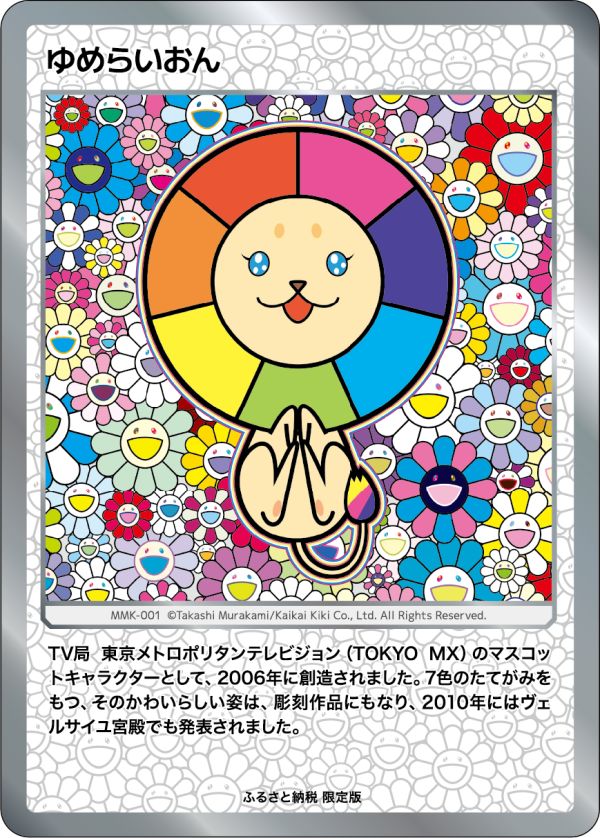

TV局 東京メトロポリタンテレビジョン(TOKYO MX)のマスコットキャラクターとして、2006年に創造されました。7色のたてがみをもつ、そのかわいらしい姿は、彫刻作品にもなり、2010年にはヴェルサイユ宮殿でも発表されました。
TV局 東京メトロポリタンテレビジョン(TOKYO MX)のマスコットキャラクターとして、2006年に創造されました。7色のたてがみをもつ、そのかわいらしい姿は、彫刻作品にもなり、2010年にはヴェルサイユ宮殿でも発表されました。


江戸時代の画家、彭城百川の『天台岳中石橋図旧慈門院襖絵』から着想した作品です。中国の南宗画に由来する日本的解釈で描かれた作品を元に、村上版ではメインキャラクターのライオンが新規に描き直され、さらに石橋を桜に変化させ、子獅子を加え、諸行無常と再生を象徴する絵として再解釈しています。画面の中には、DOB君や、カイカイ、キキなどもいます。
江戸時代の画家、彭城百川の『天台岳中石橋図旧慈門院襖絵』から着想した作品です。中国の南宗画に由来する日本的解釈で描かれた作品を元に、村上版ではメインキャラクターのライオンが新規に描き直され、さらに石橋を桜に変化させ、子獅子を加え、諸行無常と再生を象徴する絵として再解釈しています。画面の中には、DOB君や、カイカイ、キキなどもいます。
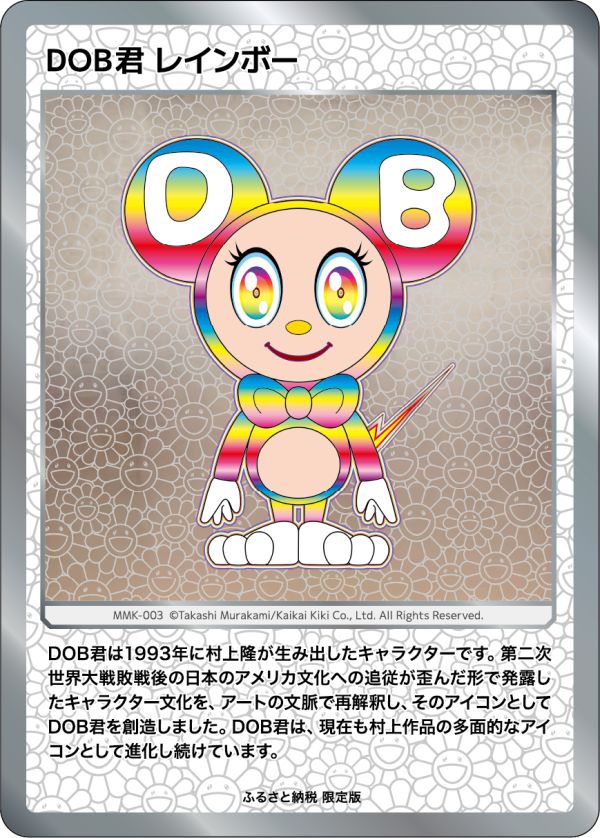

DOB君は1993年に村上隆が生み出したキャラクターです。第二次世界大戦敗戦後の日本のアメリカ文化への追従が歪んだ形で発露したキャラクター文化を、アートの文脈で再解釈し、そのアイコンとしてDOB君を創造しました。DOB君は、現在も村上作品の多面的なアイコンとして進化し続けています。
DOB君は1993年に村上隆が生み出したキャラクターです。第二次世界大戦敗戦後の日本のアメリカ文化への追従が歪んだ形で発露したキャラクター文化を、アートの文脈で再解釈し、そのアイコンとしてDOB君を創造しました。DOB君は、現在も村上作品の多面的なアイコンとして進化し続けています。


村上隆はTOKYO FMにおいて、2002年11月から2014年3月までの11年4ヶ月間「エフエム芸術道場」という深夜ラジオ番組のパーソナリティーをやっていました。その流れで、いーことちゃん、わるいことくんは2005年の年末年始、年またぎの特番時に制作されたキャラクター達です。
村上隆はTOKYO FMにおいて、2002年11月から2014年3月までの11年4ヶ月間「エフエム芸術道場」という深夜ラジオ番組のパーソナリティーをやっていました。その流れで、いーことちゃん、わるいことくんは2005年の年末年始、年またぎの特番時に制作されたキャラクター達です。
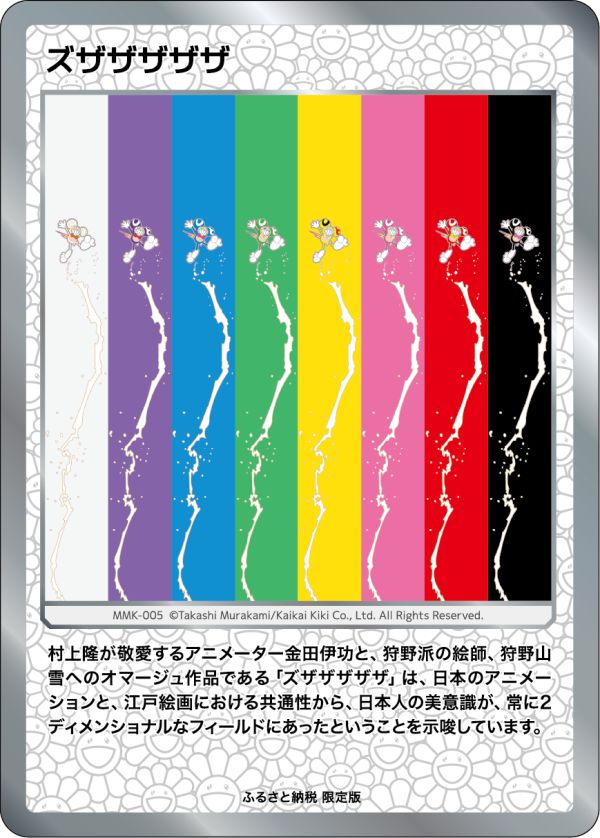

村上隆が敬愛するアニメーター金田伊功と、狩野派の絵師、狩野山雪へのオマージュ作品である「ズザザザザザ」は、日本のアニメーションと、江戸絵画における共通性から、日本人の美意識が、常に2ディメンショナルなフィールドにあったということを示唆しています。
村上隆が敬愛するアニメーター金田伊功と、狩野派の絵師、狩野山雪へのオマージュ作品である「ズザザザザザ」は、日本のアニメーションと、江戸絵画における共通性から、日本人の美意識が、常に2ディメンショナルなフィールドにあったということを示唆しています。


江戸時代を代表する画家、尾形光琳は琳派の象徴とも言われ、尾形乾山との協業なども有名で、純粋芸術と工芸品の結合を特徴とし、「スーパーフラット」を構築する際の概念の元となってもいます。
江戸時代を代表する画家、尾形光琳は琳派の象徴とも言われ、尾形乾山との協業なども有名で、純粋芸術と工芸品の結合を特徴とし、「スーパーフラット」を構築する際の概念の元となってもいます。
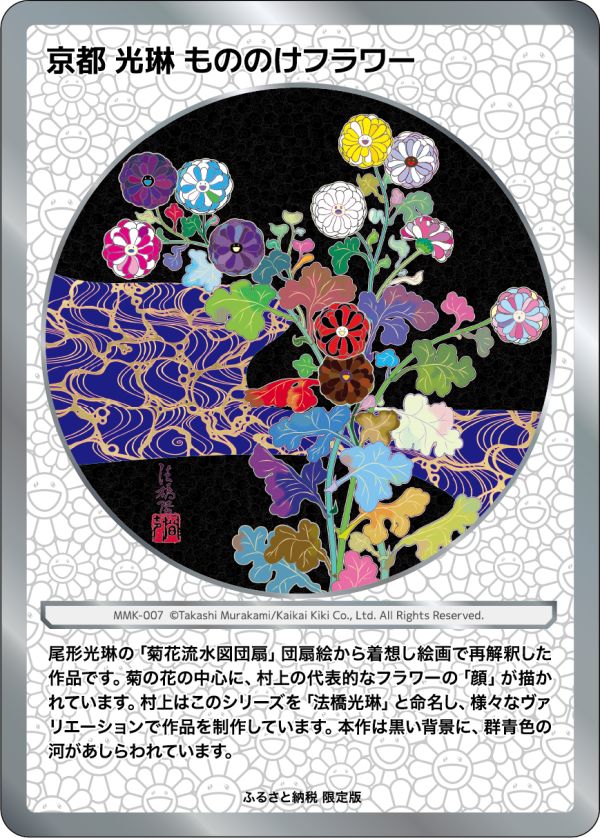

尾形光琳の「菊花流水図団扇」団扇絵から着想し絵画で再解釈した作品です。菊の花の中心に、村上の代表的なフラワーの「顔」が描かれています。村上はこのシリーズを「法橋光琳」と命名し、様々なヴァリエーションで作品を制作しています。本作は黒い背景に、群青色の河があしらわれています。
尾形光琳の「菊花流水図団扇」団扇絵から着想し絵画で再解釈した作品です。菊の花の中心に、村上の代表的なフラワーの「顔」が描かれています。村上はこのシリーズを「法橋光琳」と命名し、様々なヴァリエーションで作品を制作しています。本作は黒い背景に、群青色の河があしらわれています。
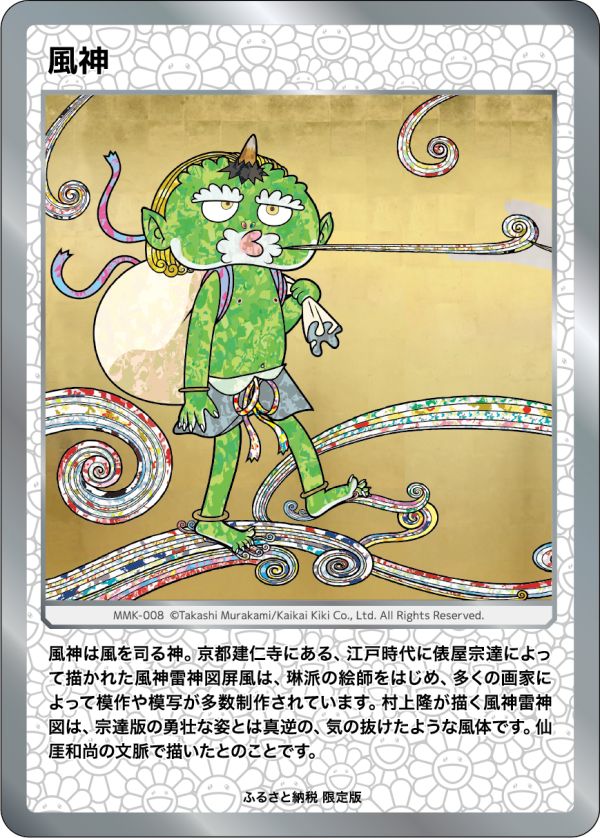

風神は風を司る神。京都建仁寺にある、江戸時代に俵屋宗達によって描かれた風神雷神図屏風は、琳派の絵師をはじめ、多くの画家によって模作や模写が多数制作されています。村上隆が描く風神雷神図は、宗達版の勇壮な姿とは真逆の、気の抜けたような風体です。仙厓和尚の文脈で描いたとのことです。
風神は風を司る神。京都建仁寺にある、江戸時代に俵屋宗達によって描かれた風神雷神図屏風は、琳派の絵師をはじめ、多くの画家によって模作や模写が多数制作されています。村上隆が描く風神雷神図は、宗達版の勇壮な姿とは真逆の、気の抜けたような風体です。仙厓和尚の文脈で描いたとのことです。
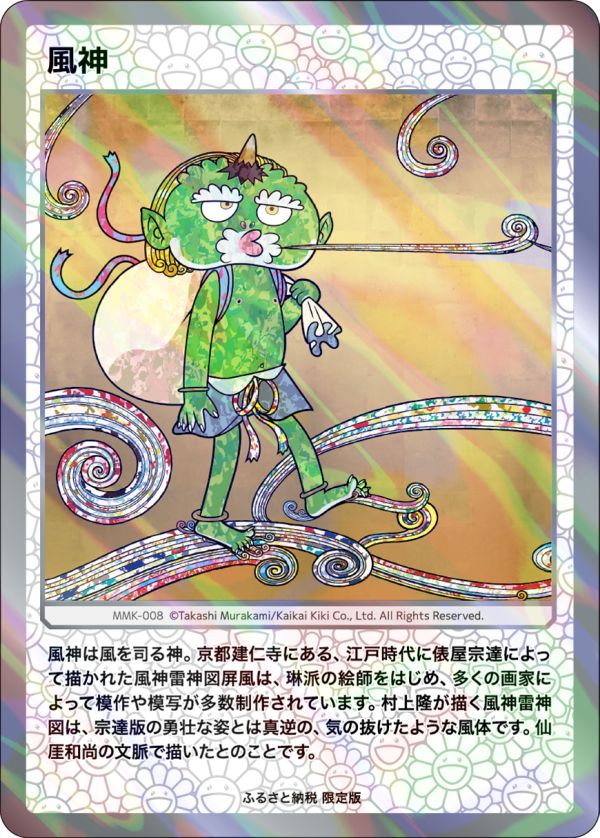

風神は風を司る神。京都建仁寺にある、江戸時代に俵屋宗達によって描かれた風神雷神図屏風は、琳派の絵師をはじめ、多くの画家によって模作や模写が多数制作されています。村上隆が描く風神雷神図は、宗達版の勇壮な姿とは真逆の、気の抜けたような風体です。仙厓和尚の文脈で描いたとのことです。
風神は風を司る神。京都建仁寺にある、江戸時代に俵屋宗達によって描かれた風神雷神図屏風は、琳派の絵師をはじめ、多くの画家によって模作や模写が多数制作されています。村上隆が描く風神雷神図は、宗達版の勇壮な姿とは真逆の、気の抜けたような風体です。仙厓和尚の文脈で描いたとのことです。
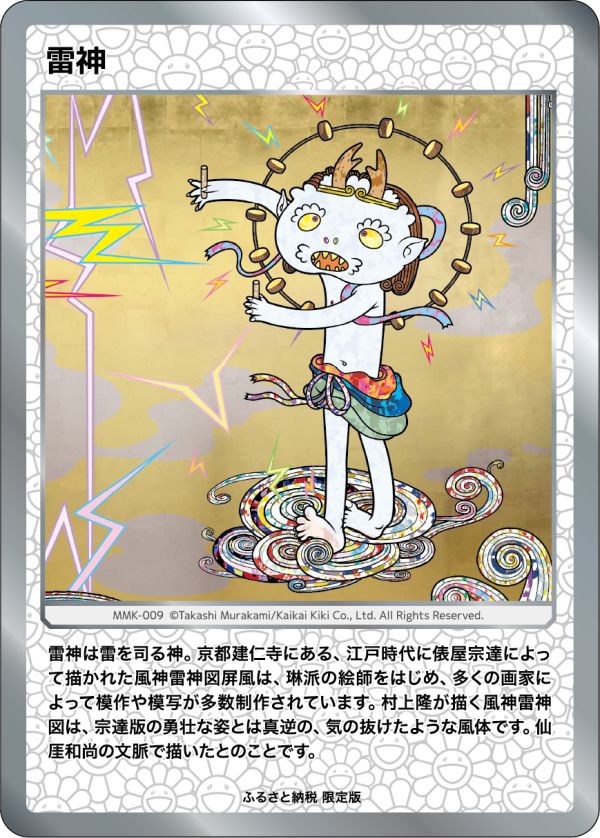

雷神は雷を司る神。京都建仁寺にある、江戸時代に俵屋宗達によって描かれた風神雷神図屏風は、琳派の絵師をはじめ、多くの画家によって模作や模写が多数制作されています。村上隆が描く風神雷神図は、宗達版の勇壮な姿とは真逆の、気の抜けたような風体です。仙厓和尚の文脈で描いたとのことです。
雷神は雷を司る神。京都建仁寺にある、江戸時代に俵屋宗達によって描かれた風神雷神図屏風は、琳派の絵師をはじめ、多くの画家によって模作や模写が多数制作されています。村上隆が描く風神雷神図は、宗達版の勇壮な姿とは真逆の、気の抜けたような風体です。仙厓和尚の文脈で描いたとのことです。
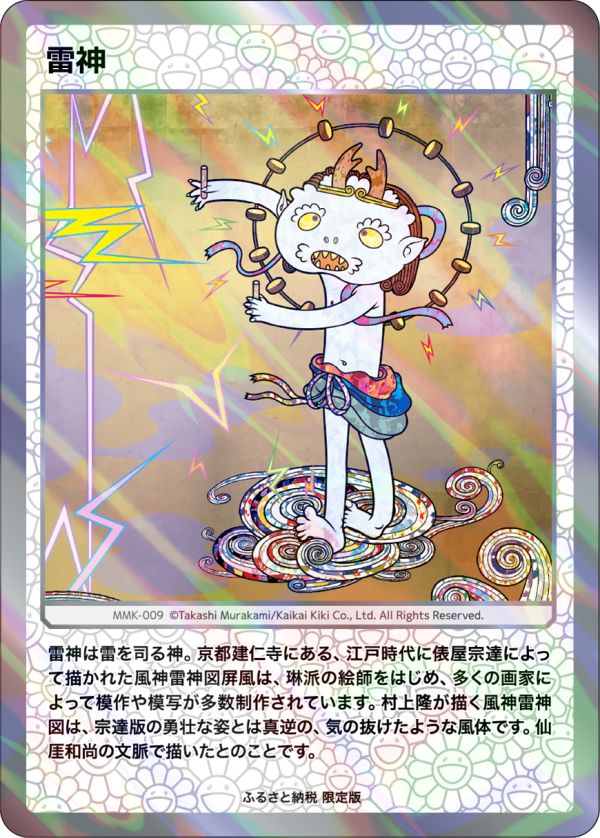

雷神は雷を司る神。京都建仁寺にある、江戸時代に俵屋宗達によって描かれた風神雷神図屏風は、琳派の絵師をはじめ、多くの画家によって模作や模写が多数制作されています。村上隆が描く風神雷神図は、宗達版の勇壮な姿とは真逆の、気の抜けたような風体です。仙厓和尚の文脈で描いたとのことです。
雷神は雷を司る神。京都建仁寺にある、江戸時代に俵屋宗達によって描かれた風神雷神図屏風は、琳派の絵師をはじめ、多くの画家によって模作や模写が多数制作されています。村上隆が描く風神雷神図は、宗達版の勇壮な姿とは真逆の、気の抜けたような風体です。仙厓和尚の文脈で描いたとのことです。


Superflatは2000年に村上隆が提唱した美術概念です。日本の伝統的な絵画表現とアニメや漫画、ゲームに代表される大衆文化を結びつけただけでなく、戦前から戦後の日本人の感性、経済、や政治、宗教など社会全体の有様をもフラットに捉え直して、美の解釈の基盤とした概念を表す言葉です。
Superflatは2000年に村上隆が提唱した美術概念です。日本の伝統的な絵画表現とアニメや漫画、ゲームに代表される大衆文化を結びつけただけでなく、戦前から戦後の日本人の感性、経済、や政治、宗教など社会全体の有様をもフラットに捉え直して、美の解釈の基盤とした概念を表す言葉です。
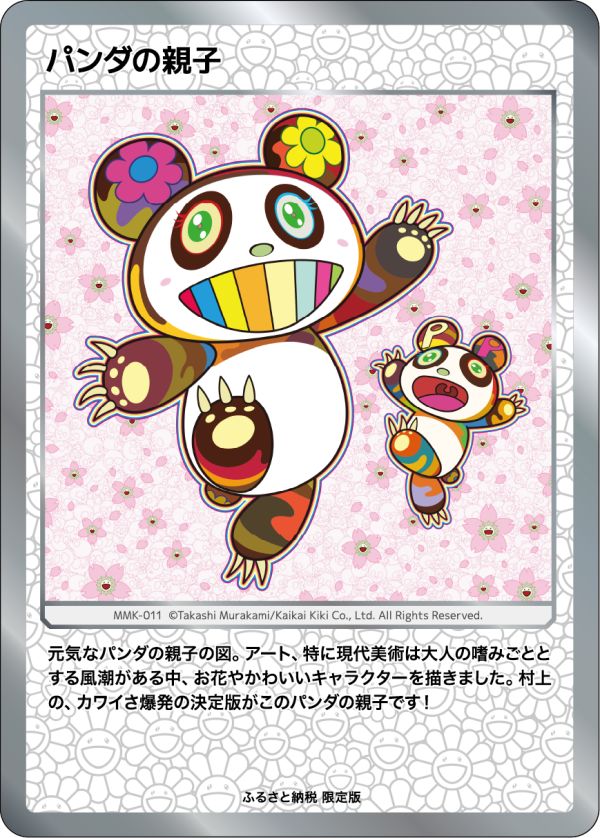

元気なパンダの親子の図。アート、特に現代美術は大人の嗜みごととする風潮がある中、お花やかわいいキャラクターを描きました。村上の、カワイさ爆発の決定版がこのパンダの親子です!
元気なパンダの親子の図。アート、特に現代美術は大人の嗜みごととする風潮がある中、お花やかわいいキャラクターを描きました。村上の、カワイさ爆発の決定版がこのパンダの親子です!
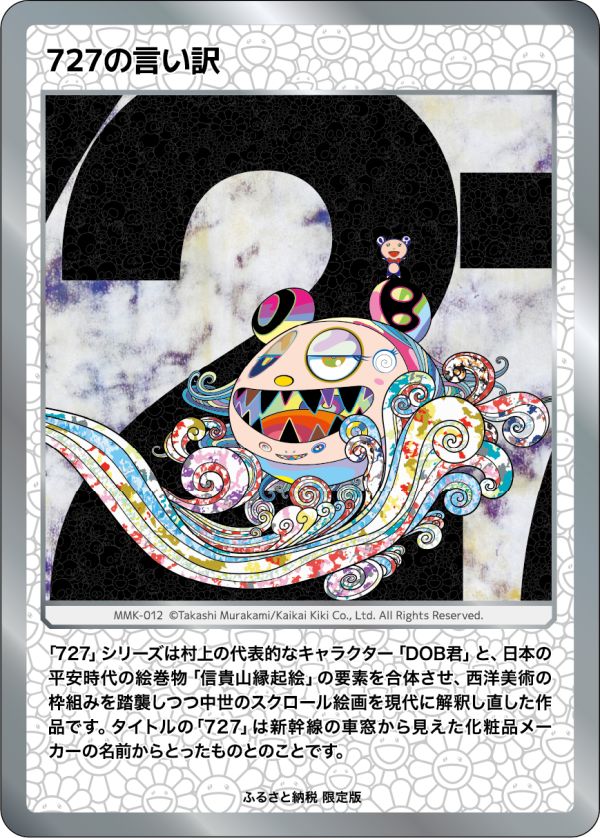

「727」シリーズは村上の代表的なキャラクター「DOB君」と、日本の平安時代の絵巻物「信貴山縁起絵」の要素を合体させ、西洋美術の枠組みを踏襲しつつ中世のスクロール絵画を現代に解釈し直した作品です。タイトルの「727」は新幹線の車窓から見えた化粧品メーカーの名前からとったものとのことです。
「727」シリーズは村上の代表的なキャラクター「DOB君」と、日本の平安時代の絵巻物「信貴山縁起絵」の要素を合体させ、西洋美術の枠組みを踏襲しつつ中世のスクロール絵画を現代に解釈し直した作品です。タイトルの「727」は新幹線の車窓から見えた化粧品メーカーの名前からとったものとのことです。
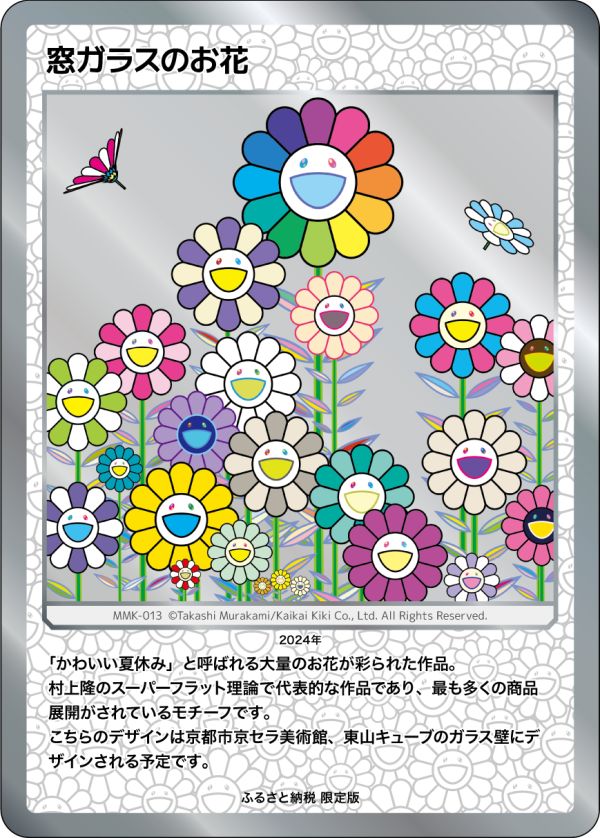

This work, called "Kawaii! Vacances d’été!", features a large number of flowers. It is one of the works representative of Takashi Murakami's Superflat theory, and is the motif that has been most widely used in product development. This design will be applied on the glass wall of the Kyoto City KYOCERA Museum of Art’s Higashiyama Cube.
「かわいい夏休み」と呼ばれる大量のお花が彩られた作品。 村上隆のスーパーフラット理論で代表的な作品であり、最も多くの商品展開がされているモチーフです。 こちらのデザインは京都市京セラ美術館、東山キューブのガラス壁にデザインされる予定です。
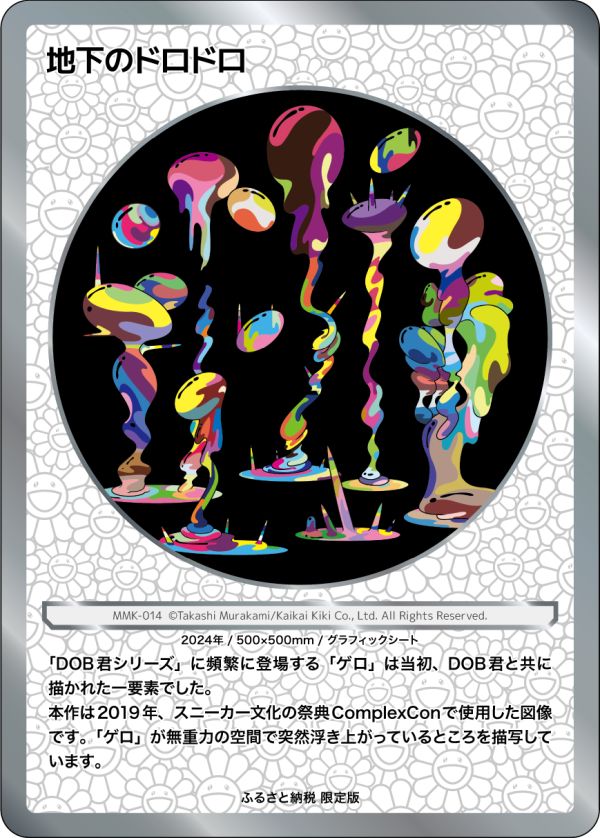

The “gero (vomit)” motif that frequently appears in the Mr. DOB series was initially a mere element depicted with Mr. DOB. This work is based on an image used in 2019 for ComplexCon, a festival of sneaker culture. It depicts “gero” suddenly afloat in weightless space.
「DOB君シリーズ」に頻繁に登場する「ゲロ」は当初、DOB君と共に描かれた一要素でした。本作は2019年、スニーカー文化の祭典ComplexConで使用した図像です。「ゲロ」が無重力の空間で突然浮き上がっているところを描写しています。
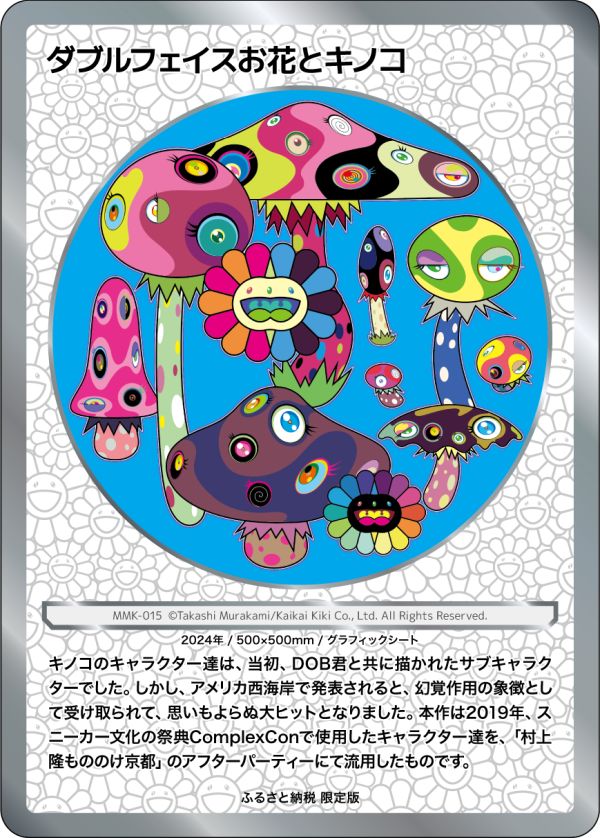

The mushroom characters were initially sub-characters depicted alongside Mr. DOB. When presented in the West Coast of the United States, however, they were received as symbols of hallucinogenic effects and became an unexpected hit. This work shows the characters used in 2019 for ComplexCon, a festival of sneaker culture, adapted for the after-party of “Takashi Murakami Mononoke Kyoto” exhibition.
キノコのキャラクター達は、当初、DOB君と共に描かれたサブキャラクターでした。しかし、アメリカ西海岸で発表されると、幻覚作用の象徴として受け取られて、思いもよらぬ大ヒットとなりました。本作は2019年、スニーカー文化の祭典ComplexConで使用したキャラクター達を、「村上隆もののけ京都」のアフターパーティーにて流用したものです。
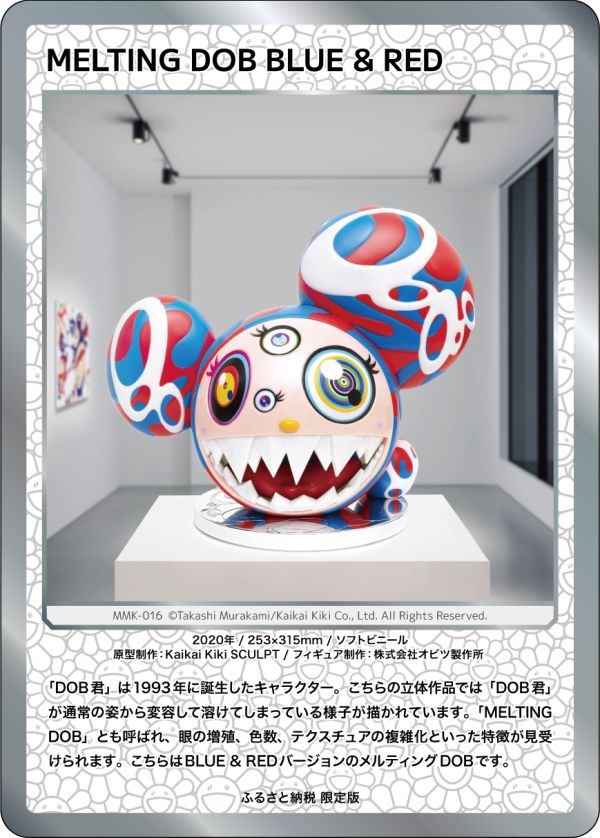

Mr. DOB is a character created in 1993. This three-dimensional work depicts Mr. DOB transformed from his normal state and melting. Also called “Melting DOB”, the figure is characterized by the proliferation of eyes, the number of colors, and the increased complexity of the textures. This is the BLUE & RED version of “Melting DOB”.
「DOB君」は1993年に誕生したキャラクター。こちらの立体作品では「DOB君」が通常の姿から変容して溶けてしまっている様子が描かれています。「MELTING DOB」とも呼ばれ、眼の増殖、色数、テクスチュアの複雑化といった特徴が見受けられます。こちらはBLUE & REDバージョンのメルティングDOBです。
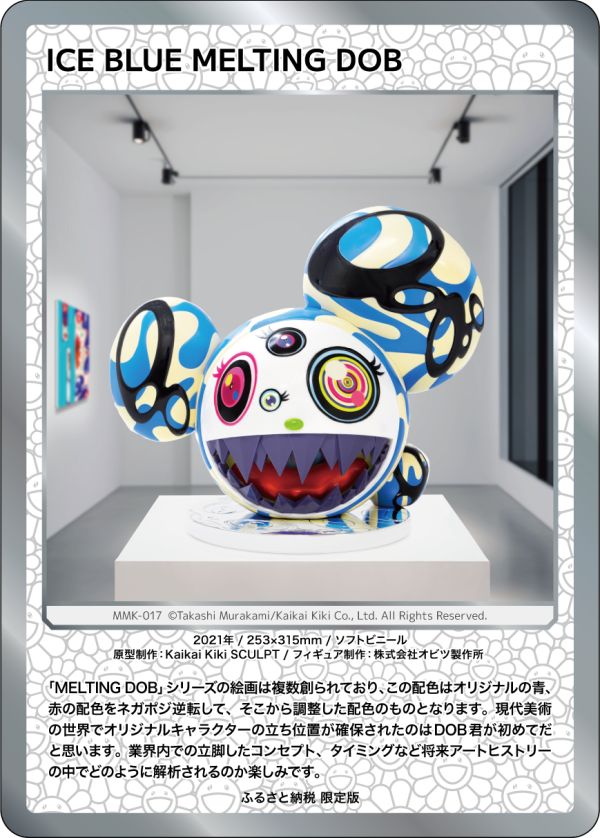

Multiple works have been created in the “Melting DOB” painting series, and this color scheme started with a negative-positive reversal of the original blue and red color scheme, from which the colors were further adjusted. I believe that Mr. DOB is the first case where the standing of an original character has been secured in the contemporary art world. I look forward to seeing how the concept and timing of its establishment within the industry will be analyzed in future art history.
「MELTING DOB」シリーズの絵画は複数創られており、この配色はオリジナルの青、赤の配色をネガポジ逆転して、そこから調整した配色のものとなります。現代美術の世界でオリジナルキャラクターの立ち位置が確保されたのはDOB君が初めてだと思います。業界内での立脚したコンセプト、タイミングなど将来アートヒストリーの中でどのように解析されるのか楽しみです。


This is a STRANGE PINKY version of “Melting DOB”. The impression of a work changes dramatically when the color scheme is changed. We paid special attention to the color scheme of the inside of the mouth. This is close to the final form in Mr. DOB's color scheme exploration.
「MELTING DOB」のSTRANGE PINKYバージョン。配色が変わると印象が随分と変化していきます。口の中の配色に特に注力しました。 DOB君配色における最終形態に近いものです。
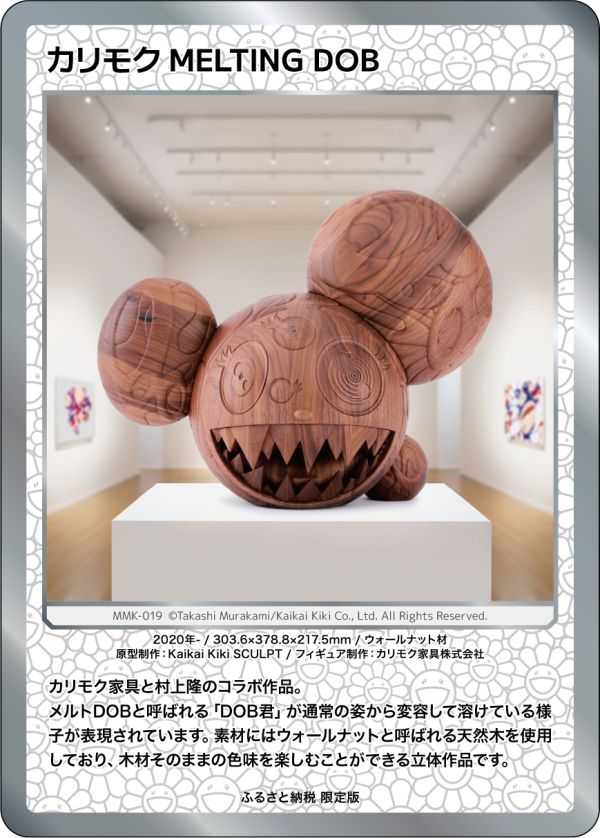

This is a collaborative work by Karimoku Furniture and Takashi Murakami. It depicts “Melting DOB”, or Mr. DOB transforming from its normal state and melting. The material used for this three-dimensional work is walnut, natural wood, which allows the viewer to enjoy the color of the wood as it is.
カリモク家具と村上隆のコラボ作品。 メルトDOBと呼ばれる「DOB君」が通常の姿から変容して溶けている様子が表現されています。素材にはウォールナットと呼ばれる天然木を使用しており、木材そのままの色味を楽しむことができる立体作品です。


Little People are characters with mysterious faces and bodies. There are 24 of them. This work is part of the cherry blossom wallpaper in the main hall of the Kyoto City KYOCERA Museum of Art.
「小さき人々」という摩訶不思議な顔つきと体をしたキャラクター達。その数24体。こちらは京都市京セラ美術館メインホールの桜壁紙にあしらわれました。
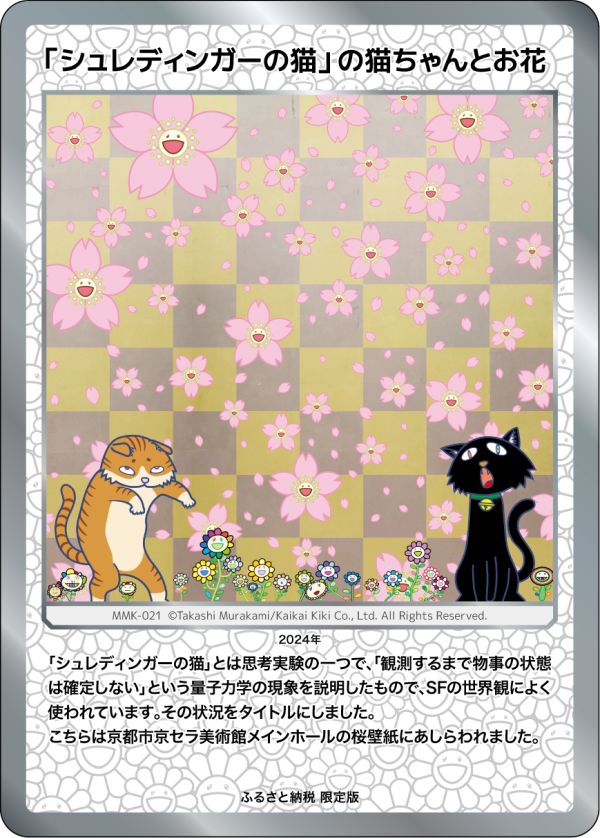

“Schrödinger's Cat" is a thought experiment that demonstrates a quantum mechanics phenomenon in which the state of things is not determined until it is observed, and is often used in science fiction worldviews. The title of this work is based on this situation. This work was part of the cherry blossom wallpaper in the main hall of the Kyoto City KYOCERA Museum of Art.
「シュレディンガーの猫」とは思考実験の一つで、「観測するまで物事の状態は確定しない」という量子力学の現象を説明したもので、SFの世界観によく使われています。その状況をタイトルにしました。 こちらは京都市京セラ美術館メインホールの桜壁紙にあしらわれました。
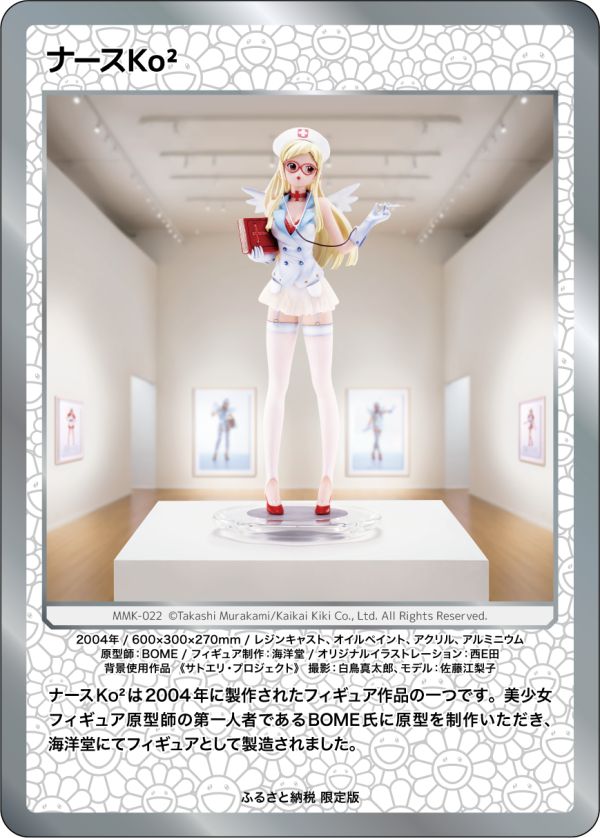

Nurse Ko² is one of the figure works produced in 2004. The prototype was made by BOME, a leading bishōjo (beautiful girl) figure model maker, and manufactured as a figure by Kaiyodo.
ナースKo²は2004年に製作されたフィギュア作品の一つです。美少女フィギュア原型師の第一人者であるBOME氏に原型を制作いただき、海洋堂にてフィギュアとして製造されました。
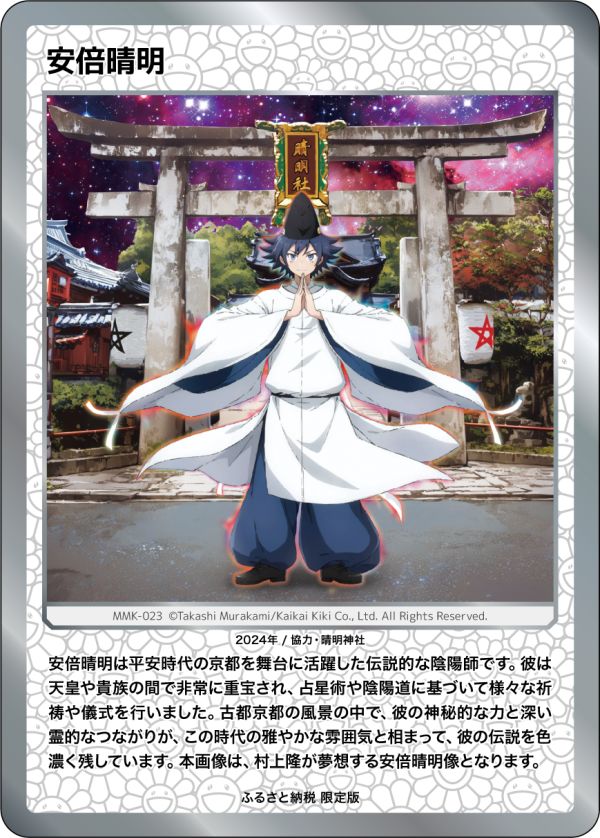

Abe no Seimei was a legendary onmyōji, or yin-yang master, active in Kyoto during the Heian period (eighth through twelfth centuries). He was highly valued by the emperor and the nobility, and performed various prayers and rituals based on astrology and onmyōdō. His mystical powers and deep spiritual connections, coupled with the elegant atmosphere of the period, keep his legend very much alive in the landscape of Kyoto, the ancient capital of Japan. This image is the representation of Abe no Seimei as dreamed up by Takashi Murakami.
安倍晴明は平安時代の京都を舞台に活躍した伝説的な陰陽師です。彼は天皇や貴族の間で非常に重宝され、占星術や陰陽道に基づいて様々な祈祷や儀式を行いました。古都京都の風景の中で、彼の神秘的な力と深い霊的なつながりが、この時代の雅やかな雰囲気と相まって、彼の伝説を色濃く残しています。本画像は、村上隆が夢想する安倍晴明像となります。
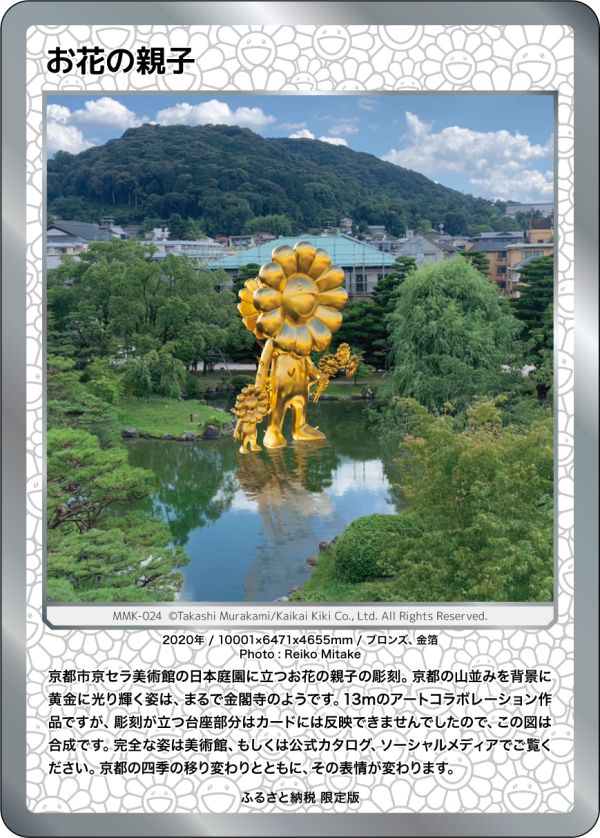

This sculpture of “Flower Parent and Child stands” in the Japanese garden of the Kyoto City KYOCERA Museum of Art. The golden glow of the sculpture against the backdrop of the Kyoto mountains evokes the famed Golden Pavilion. The installation is an art collaboration that stands 13-meter tall, but its pedestal could not be included in the card, so this image is a composite. For a complete view, please visit the museum in person or refer to the official catalog or social media. The appearance of the sculpture shifts with the changing seasons of Kyoto.
京都市京セラ美術館の日本庭園に立つお花の親子の彫刻。京都の山並みを背景に黄金に光り輝く姿は、まるで金閣寺のようです。13mのアートコラボレーション作品ですが、彫刻が立つ台座部分はカードには反映できませんでしたので、この図は合成です。完全な姿は美術館、もしくは公式カタログ、ソーシャルメディアでご覧ください。京都の四季の移り変わりとともに、その表情が変わります。
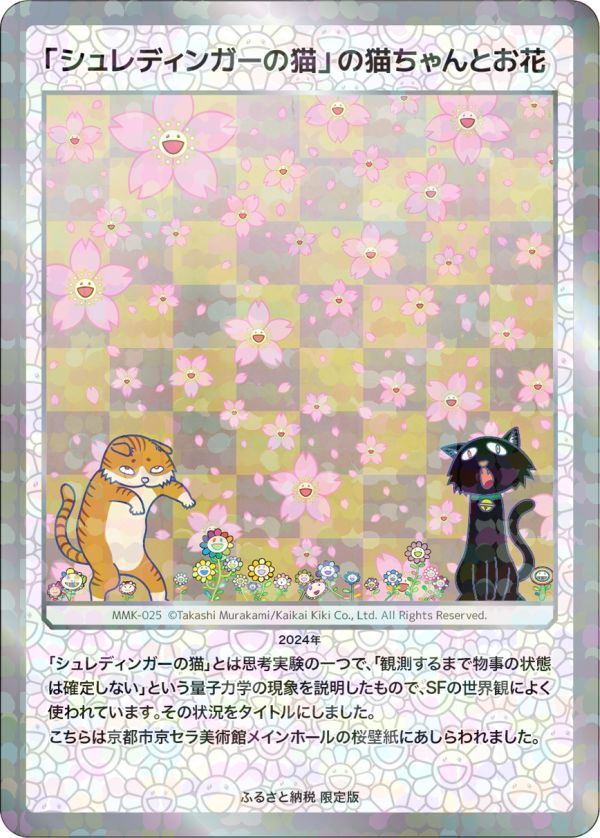

“Schrödinger's Cat" is a thought experiment that demonstrates a quantum mechanics phenomenon in which the state of things is not determined until it is observed, and is often used in science fiction worldviews. The title of this work is based on this situation. This work was part of the cherry blossom wallpaper in the main hall of the Kyoto City KYOCERA Museum of Art.
「シュレディンガーの猫」とは思考実験の一つで、「観測するまで物事の状態は確定しない」という量子力学の現象を説明したもので、SFの世界観によく使われています。その状況をタイトルにしました。 こちらは京都市京セラ美術館メインホールの桜壁紙にあしらわれました。
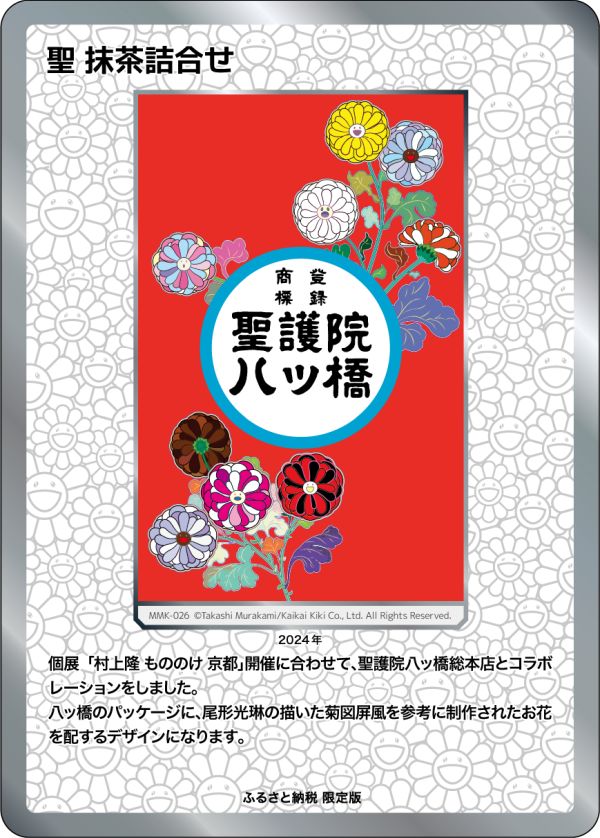

On the occasion of the Takashi Murakami Mononoke Kyoto exhibition, we collaborated with Shogoin Yatsuhashi Co., Ltd.. The package of Yatsuhashi is adorned with flowers created in reference to the chrysanthemum folding screen painted by Ogata Kōrin.
個展「村上隆 もののけ 京都」開催に合わせて、聖護院八ッ橋総本店とコラボレーションをしました。 八ッ橋のパッケージに、尾形光琳の描いた菊図屏風を参考に制作されたお花を拝するデザインになります。
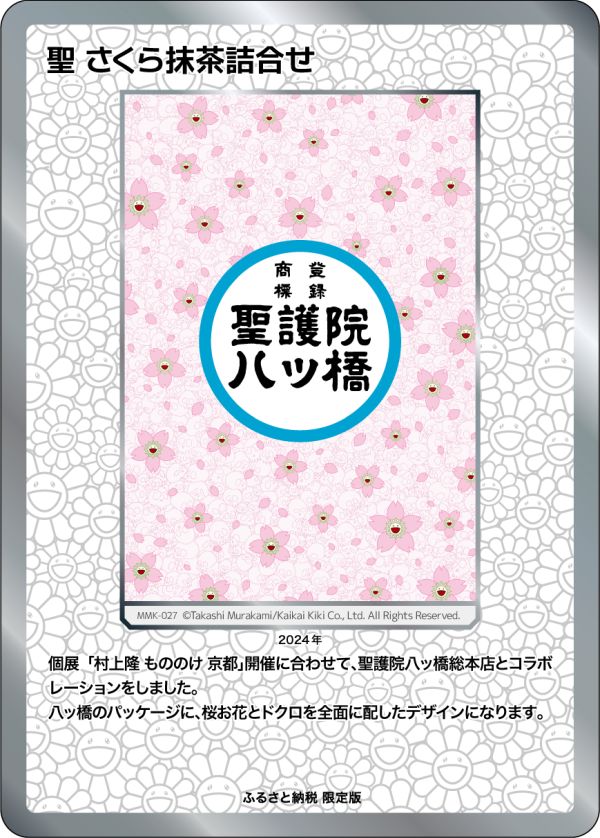

On the occasion of the Takashi Murakami Mononoke Kyoto exhibition, we collaborated with Shogoin Yatsuhashi Co., Ltd.. The package of Yatsuhashi is covered with cherry blossom and skull characters.
個展「村上隆 もののけ 京都」開催に合わせて、聖護院八ッ橋総本店とコラボレーションをしました。 八ッ橋のパッケージに、桜お花とドクロを全面に拝したデザインになります。
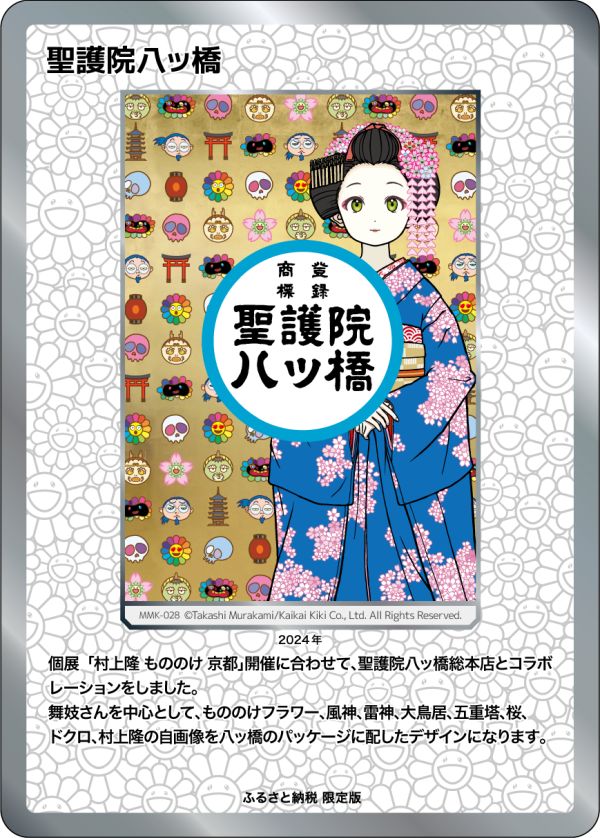

On the occasion of the Takashi Murakami Mononoke Kyoto exhibition, we collaborated with Shogoin Yatsuhashi Co., Ltd.. The Yatsuhashi package design features a Maiko character, along with Mononoke Flower, Wind God, Thunder God, Ōtorii gate, five-story pagoda, cherry blossom, skull, and Takashi Murakami’s self-portrait.
個展「村上隆 もののけ 京都」開催に合わせて、聖護院八ッ橋総本店とコラボレーションをしました。 舞妓さんを中心として、もののけフラワー、風神、雷神、大鳥居、五重塔、さくら、ドクロ、村上隆の自画像を八ッ橋のパッケージに拝したデザインになります。
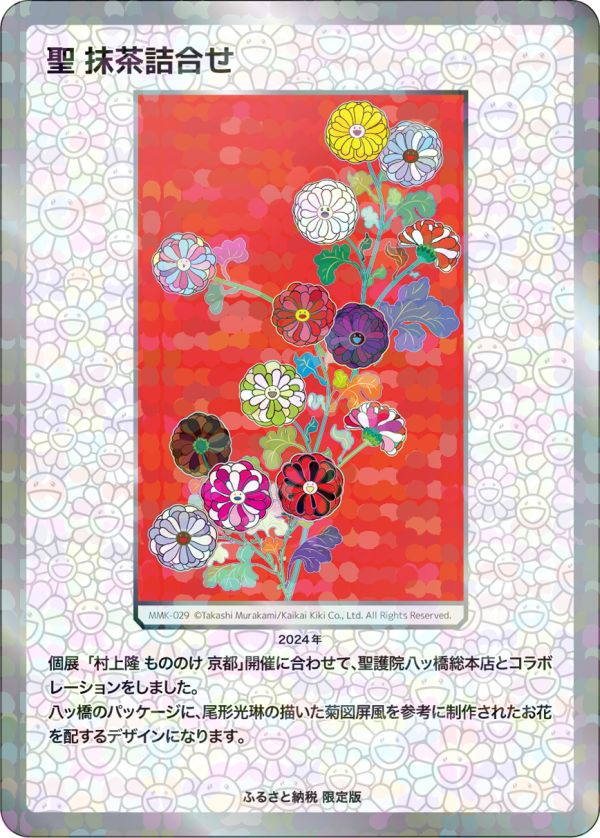

On the occasion of the Takashi Murakami Mononoke Kyoto exhibition, we collaborated with Shogoin Yatsuhashi Co., Ltd.. The package of Yatsuhashi is adorned with flowers created in reference to the chrysanthemum folding screen painted by Ogata Kōrin.
個展「村上隆 もののけ 京都」開催に合わせて、聖護院八ッ橋総本店とコラボレーションをしました。 八ッ橋のパッケージに、尾形光琳の描いた菊図屏風を参考に制作されたお花を拝するデザインになります。
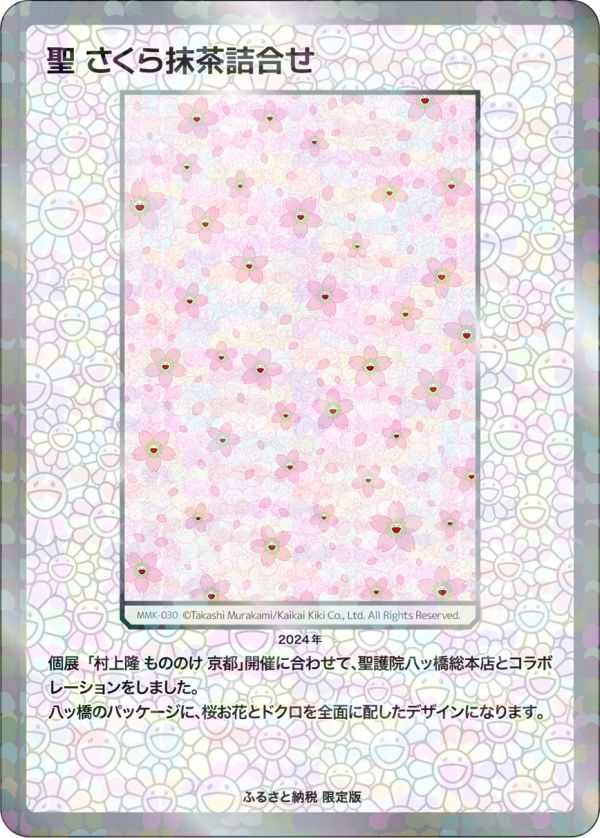

On the occasion of the Takashi Murakami Mononoke Kyoto exhibition, we collaborated with Shogoin Yatsuhashi Co., Ltd.. The package of Yatsuhashi is covered with cherry blossom and skull characters.
個展「村上隆 もののけ 京都」開催に合わせて、聖護院八ッ橋総本店とコラボレーションをしました。 八ッ橋のパッケージに、桜お花とドクロを全面に拝したデザインになります。
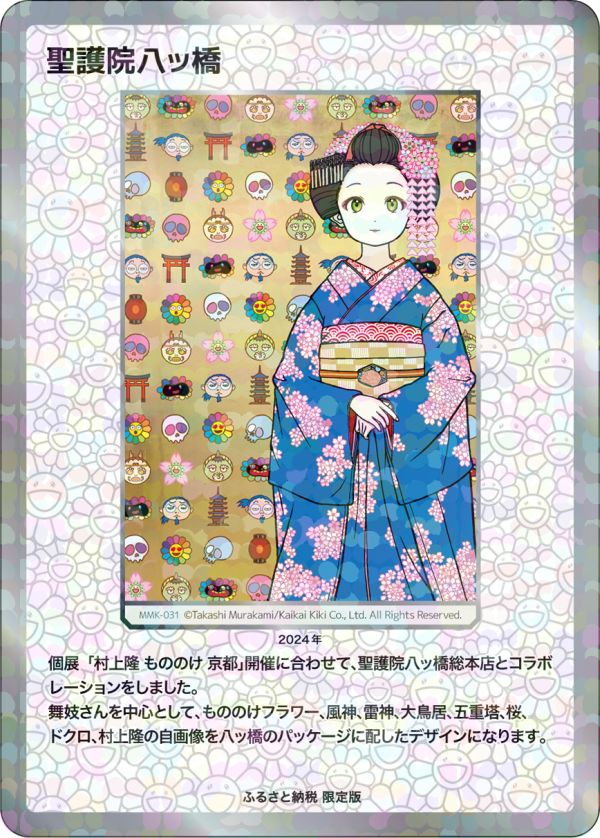

On the occasion of the Takashi Murakami Mononoke Kyoto exhibition, we collaborated with Shogoin Yatsuhashi Co., Ltd.. The Yatsuhashi package design features a Maiko character, along with Mononoke Flower, Wind God, Thunder God, Ōtorii gate, five-story pagoda, cherry blossom, skull, and Takashi Murakami’s self-portrait.
個展「村上隆 もののけ 京都」開催に合わせて、聖護院八ッ橋総本店とコラボレーションをしました。 舞妓さんを中心として、もののけフラワー、風神、雷神、大鳥居、五重塔、さくら、ドクロ、村上隆の自画像を八ッ橋のパッケージに拝したデザインになります。
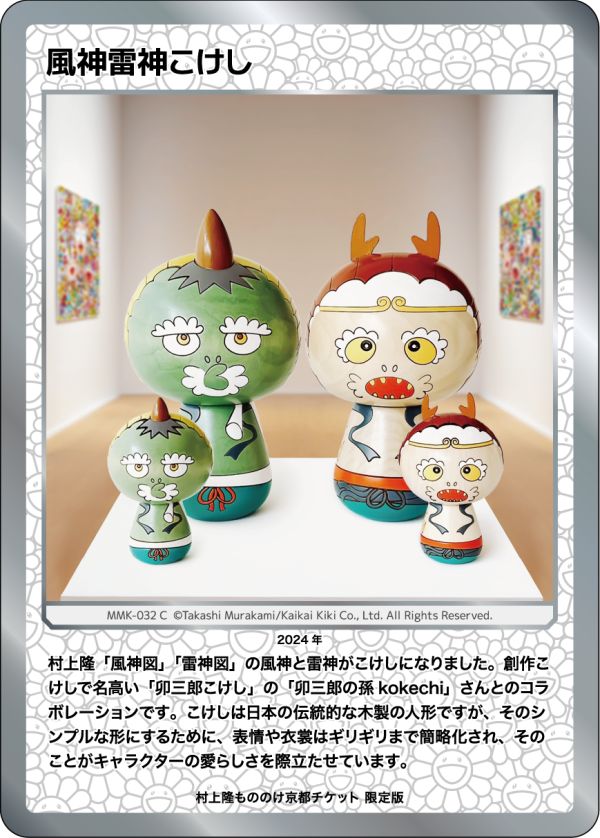

The Wind God and the Thunder God from Takashi Murakami's paintings “Wind God” and “Thunder God” have been made into kokeshi dolls. This is a collaboration with kokechi, a grandchild of Usaburo of Usaaburo Kokeshi, a well-known creative kokeshi doll maker. Kokeshi dolls are traditional Japanese wooden dolls: In order to achieve their simple forms, the dolls’ facial expressions and costumes are simplified to the limits, which in turn accentuates the charm of the characters.
2024
村上隆「風神図」「雷神図」の風神と雷神がこけしになりました。創作こけしで名高い「卯三郎こけし」の「卯三郎の孫kokechi」さんとのコラボレーションです。こけしは日本の伝統的な木製の人形ですが、そのシンプルな形にするために、表情や衣裳はギリギリまで簡略化され、そのことがキャラクターの愛らしさを際立たせています。
2024年
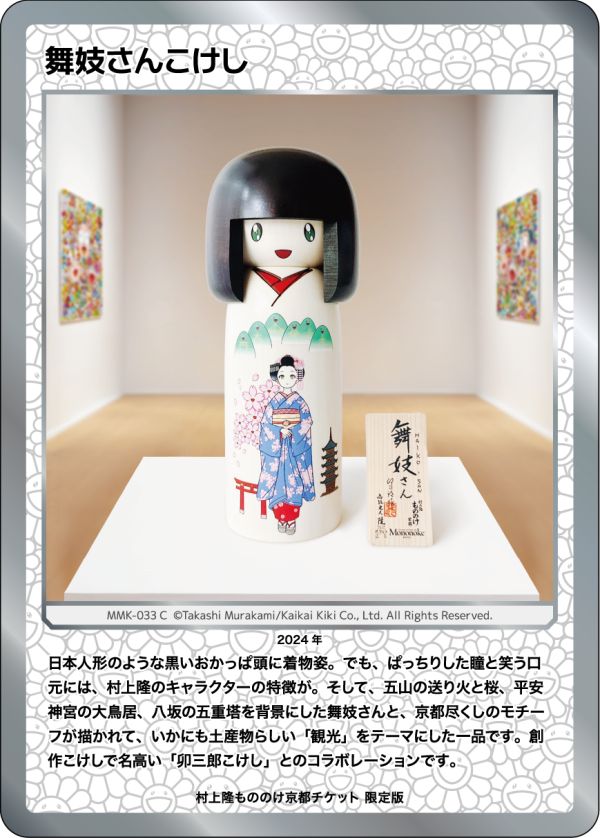

Dressed in a kimono with black, bobbed hair like a traditional Japanese doll, this kokeshi’s wide-open eyes and smiling mouth are the hallmark of Takashi Murakami's characters. The kokeshi is decorated with motifs of Kyoto, such as Gozan Okuribi, cherry blossoms, the Ōtorii gate of Heian Shrine, and the five-story pagoda of Yasaka, all of which are typical of souvenirs with a tourism theme. This work is Murakami’s collaboration with Usaburo Kokeshi, a well-known creative kokeshi doll maker.
2024
日本人形のような黒いおかっぱ頭に着物姿。でも、ぱっちりした瞳と笑う口元には、村上隆のキャラクターの特徴が。そして、五山の送り火と桜、平安神宮の大鳥居、八坂の五重塔を背景にした舞妓さんと、京都尽くしのモチーフが描かれて、いかにも土産物らしい「観光」をテーマにした一品です。創作こけしで名高い「卯三郎こけし」とのコラボレーションです。
2024年
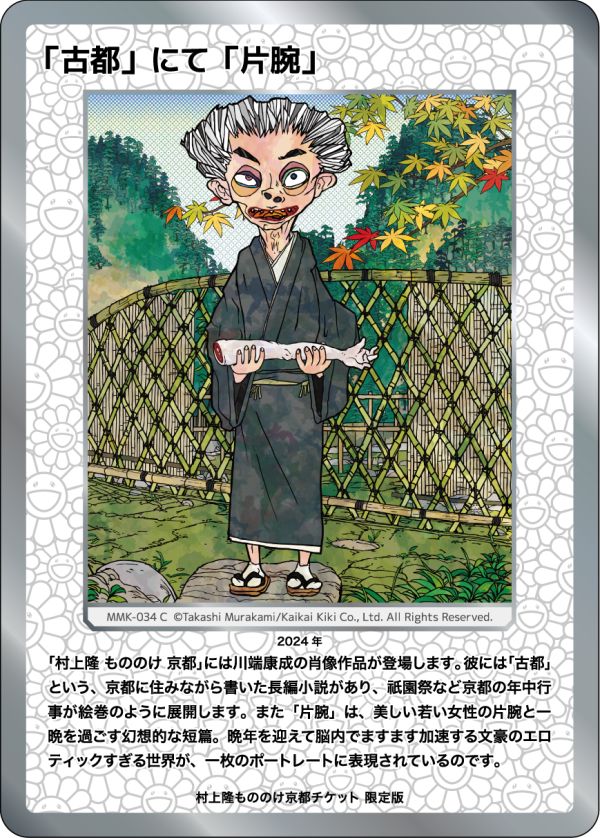

A portrait of writer Yasunari Kawabata appears in Takashi Murakami Mononoke Kyoto. Kawabata wrote a novel titled The Old Capital while living in Kyoto, in which annual events in the city including the Gion Festival unfold as if in a picture scroll. “One Arm” is his fantastical short story in which the protagonist spends a night with an arm of a beautiful young woman. The exceedingly erotic world of the great writer, which accelerated in his brain in his later years, is expressed here in a single portrait.
2024
「村上隆 もののけ 京都」には川端康成の肖像作品が登場します。彼には「古都」という、京都に住みながら書いた長編小説があり、祇園祭など京都の年中行事が絵巻のように展開します。また「片腕」は、美しい若い女性の片腕と一晩を過ごす幻想的な短篇。晩年を迎えて脳内でますます加速する文豪のエロティックすぎる世界が、一枚のポートレートに表現されているのです。
2024年
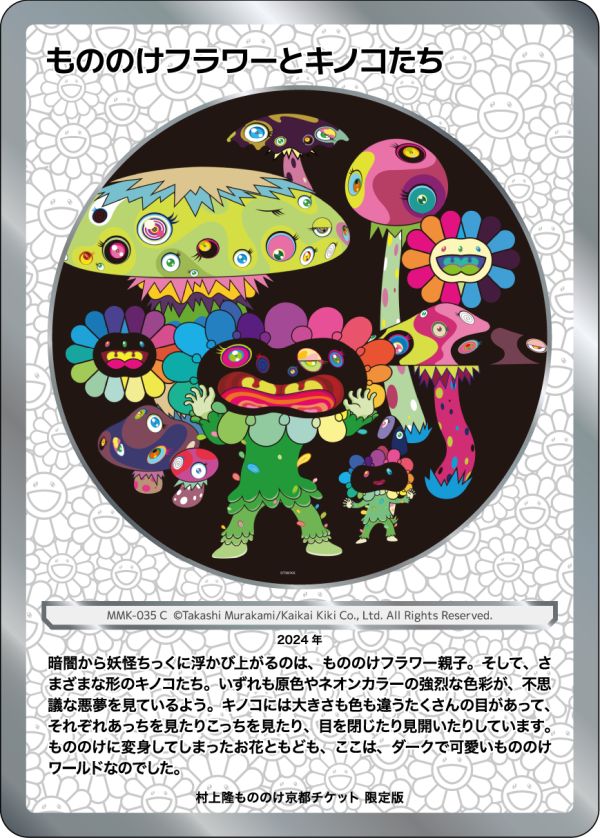

Emerging from the darkness like yōkai are the Mononoke Flower Parent and Child and, with them, mushrooms of various shapes. Their intense primary and neon colors make them all seem like something out of a mysterious nightmare. The mushrooms have many eyes of different sizes and colors, each looking this way or that, closed or open. This is a dark and cute world of mononoke in which such creatures, along with the Flowers transformed into mononoke, thrive.
2024
暗闇から妖怪ちっくに浮かび上がるのは、もののけフラワー親子。そして、さまざまな形のキノコたち。いずれも原色やネオンカラーの強烈な色彩が、不思議な悪夢を見ているよう。キノコには大きさも色も違うたくさんの目があって、それぞれあっちを見たりこっちを見たり、目を閉じたり見開いたりしています。もののけに変身してしまったお花ともども、ここは、ダークで可愛いもののけワールドなのでした。
2024年
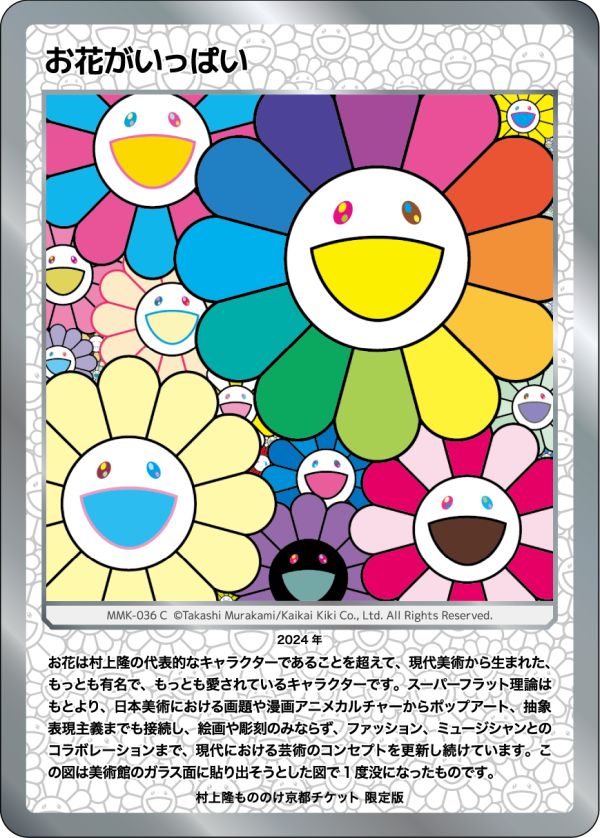

Flowers aren’t merely Takashi Murakami's signature characters; they have now become the most famous and beloved characters to emerge out of contemporary art. They not only embody the Superflat theory, but also incorporate everything from subject matters of Japanese art, manga and anime culture, to Pop Art and Abstract Expressionism; they continue to update the concept of art in our time, appearing in paintings and sculptures, as well as in fashion and music collaborations. This image was intended for the museum's glass wall, though it was once rejected.
2024
お花は村上隆の代表的なキャラクターであることを超えて、現代美術から生まれた、もっとも有名で、もっとも愛されているキャラクターです。スーパーフラット理論はもとより、日本美術における画題や漫画アニメカルチャーからポップアート、抽象表現主義までも接続し、絵画や彫刻のみならず、ファッション、ミュージシャンとのコラボレーションまで、現代における芸術のコンセプトを更新し続けています。この図は美術館のガラス面に貼り出そうとした図で1度没になったものです。
2024年
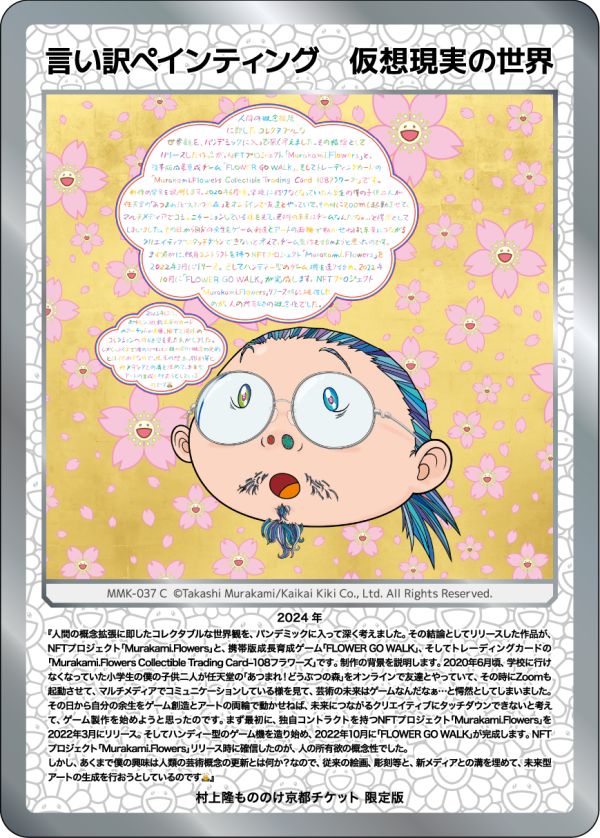

“After we entered the pandemic, I thought deeply about a worldview on collectibles that is in line with conceptual expansions of the human mind. The works I released as my conclusions are: the NFT project, Murakami.Flowers; the mobile growth-and-nurture gaming device, FLOWER GO WALK; and the trading cards, "Murakami.Flowers Collectible Trading Card: 108F lowers".
Let me explain the background that led to the production of these works.
Around June 2020, my two elementary school children, unable to go to school, were playing Nintendo's Animal Crossing: New Horizons online with their friends, and when I saw them communicating over multiple media, activating Zoom in addition to the game, I was astounded to realize that the future of art is in gaming.
Starting that day, I decided to make games, convinced that I would not be able to make a creative touchdown that would last into the future unless I could mobilize the rest of my life on the dual wheels of game creation and art.
First of all, I released Murakami.Flowers, an NFT project with its own smart contract, in March 2022. Then I started building a handheld gaming device, and completed FLOWER GO WALK in October 2022.
When I released my NFT project, Murakami.Flowers, I became convinced of the conceptual nature of people's desire to own. In 2023, the market for trading cards such as Pokemon, Yu-Gi-Oh, among others. skyrocketed, and I thought I saw the same kind of desire for collection there as I had seen with NFT.
My sole interest, however, is in exploring what the renewal of mankind's concept of art might look like. I am therefore trying to bridge the gap between traditional painting, sculpture, etc. and new media to generate futuristic art. 🙇🏻”
2024
『人間の概念拡張に即したコレクタブルな世界観を、パンデミックに入って深く考えました。
その結論としてリリースした作品が、NFTプロジェクト「Murakami.Flowers」と、携帯版成長育成ゲーム「FLOWER GO WALK」、そしてトレーディングカードの「Murakami.Flowers Collectible Trading Card–108フラワーズ」です。
制作の背景を説明します。
2020年6月頃、学校に行けなくなっていた小学生の僕の子供二人が任天堂の「あつまれ!どうぶつの森」をオンラインで友達とやっていて、その時にZoomも起動させて、マルチメディアでコミュニケーションしている様を見て、芸術の未来はゲームなんだなぁ…と愕然としてしまいました。
その日から自分の余生をゲーム創造とアートの両輪で動かせねば、未来につながるクリエイティブにタッチダウンできないと考えて、ゲーム製作を始めようと思ったのです。
まず最初に、独自コントラクトを持つNFTプロジェクト「Murakami.Flowers」を2022年3月にリリース。
そしてハンディー型のゲーム機を造り始め、2022年10月に「FLOWER GO WALK」が完成します。
NFTプロジェクト「Murakami.Flowers」リリース時に確信したのが、人の所有欲の概念性でした。
2023年には、ポケモン、遊戯王等のカードのマーケットが暴騰。NFTと同様のコレクションへの欲望を見た気がしました。
しかし、あくまで僕の興味は人類の芸術概念の更新とは何か?なので、従来の絵画、彫刻等と、新メディアとの溝を埋めて、未来型アートの生成を行おうとしているのです🙇🏻』
2024年
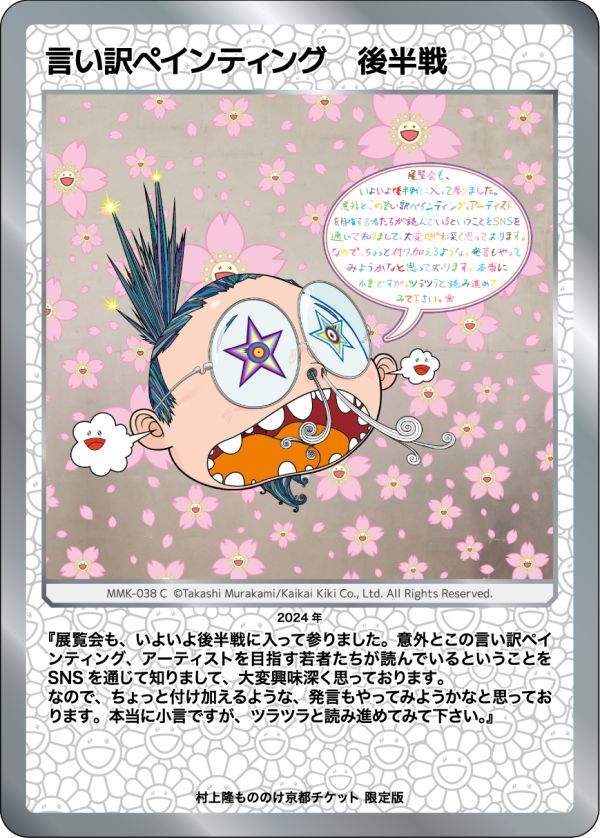

“We are now in the second half of the run of the exhibition. I was pleasantly surprised to find out through social media that many young people aspiring to become artists are reading these excuse paintings, and I am quite intrigued. So I am thinking about making a few additional commentaries. They will really just be minor utterings, but please read on at your leisure.”
2024
『展覧会も、いよいよ後半戦に入って参りました。意外とこの言い訳ペインティング、アーティストを目指す若者たちが読んでいるということをSNSを通じて知りまして、大変興味深く思っております。
なので、ちょっと付け加えるような、発言もやってみようかなと思っております。本当に小言ですが、ツラツラと読み進めてみて下さい。』
2024年
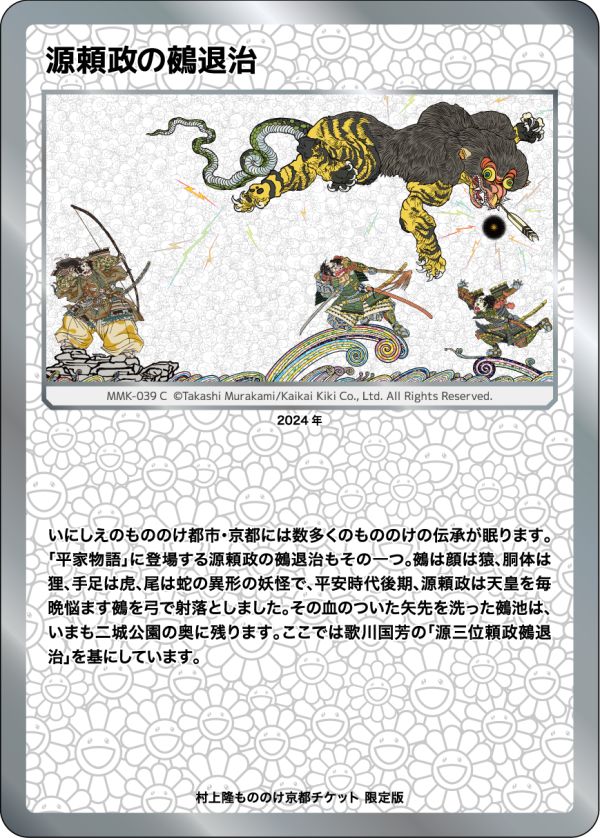

Kyoto, the ancient city of monsters, has many legends of mononoke. One of them is Minamoto no Yorimasa killing a Nue, which appears in The Tale of the Heike. In the late Heian period, Minamoto no Yorimasa is said to have shot with his arrow the grotesque monster with a face of a monkey, body of a raccoon, limbs of a tiger, and a snake as its tail, that haunted the Emperor every night. The Nue Pond, where he washed his bloody arrowhead, still remains deep in the Nijō Park. The image here is based on Utagawa Kuniyoshi's "Gensanmi yorimasa nue taiji".
2024
いにしえのもののけ都市・京都には数多くのもののけの伝承が眠ります。「平家物語」に登場する源頼政の鵺退治もその一つ。鵺は顔は猿、胴体は狸、手足は虎、尾は蛇の異形の妖怪で、平安時代後期、源頼政は天皇を毎晩悩ます鵺を弓で射落としました。その血のついた矢先を洗った鵺池は、いまも二城公園の奥に残ります。ここでは歌川国芳の「源三位頼政鵺退治」を基にしています。
2024年
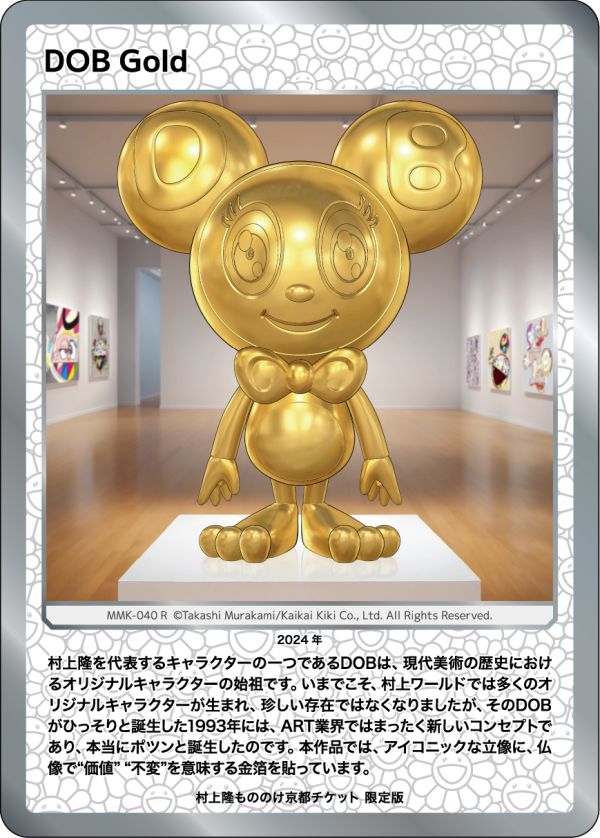

DOB, one of Takashi Murakami's representative characters, is the progenitor of original characters in the history of contemporary art. Today, many original characters have been created in the Murakami world, and they are no longer rare, but when DOB quietly came into being in 1993, it was a completely new concept in the art world; his really was a quiet, lonely birth. In this image, the iconic standing sculpture is covered with gold leaf, which signifies “value” and “constancy” in Buddhist iconography.
2024
村上隆を代表するキャラクターの一つであるDOBは、現代美術の歴史におけるオリジナルキャラクターの始祖です。いまでこそ、村上ワールドでは多くのオリジナルキャラクターが生まれ、珍しい存在ではなくなりましたが、そのDOBがひっそりと誕生した1993年には、ART業界ではまったく新しいコンセンプトであり、本当にポツンと誕生したのです。本作品では、アイコニックな立像に、仏像で“価値” “不変”を意味する金箔を貼っています。
2024年


DOB, one of Takashi Murakami's representative characters, is the progenitor of original characters in the history of contemporary art. Today, many original characters have been created in the Murakami world, and they are no longer rare, but when DOB quietly came into being in 1993, it was a completely new concept in the art world; his really was a quiet, lonely birth. In this image, the character is rendered into an iconic standing sculpture finished with gleaming platinum leaf.
2024
村上隆を代表するキャラクターの一つであるDOBは、現代美術の歴史におけるオリジナルキャラクターの始祖です。いまでこそ、村上ワールドでは多くのオリジナルキャラクターが生まれ、珍しい存在ではなくなりましたが、そのDOBがひっそりと誕生した1993年には、ART業界ではまったく新しいコンセンプトであり、本当にポツンと誕生したのです。本作品は、その姿がアイコニックな立像に造形され、輝くプラチナ箔で仕上げられています。
2024年
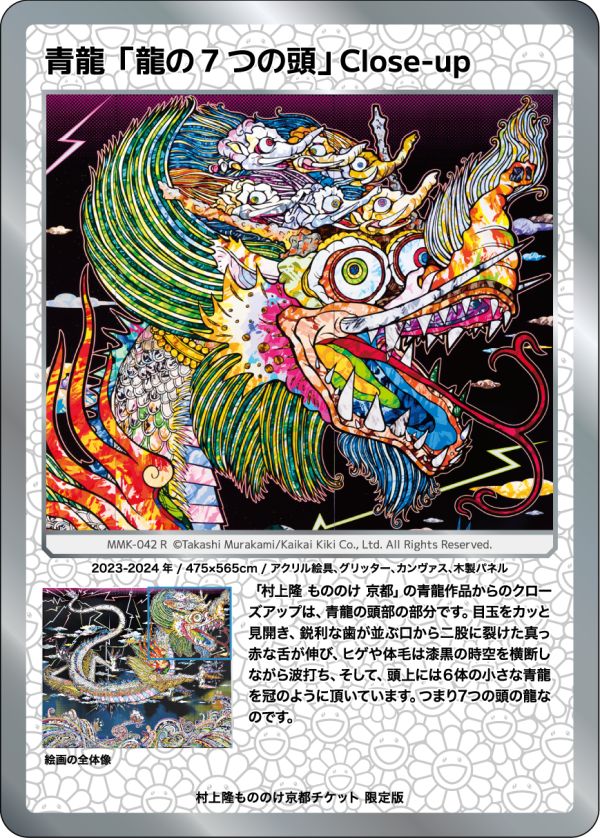

This is a detail from the Blue Dragon painting in Takashi Murakami Mononoke Kyoto, closing in on the head of the dragon. Its eyes are glared open, mouth is lined with sharp teeth, and a bright red tongue split in two extends out of it, while its whiskers and body hair ripple across the jet-black space-time. Its head is crowned with six small blue dragons: In other words, this is a seven-headed dragon.
2024
「村上隆 もののけ 京都」の青龍作品からのクローズアップは、青龍の頭部の部分です。目玉をカッと見開き、鋭利な歯が並ぶ口から二股に裂けた真っ赤な舌が伸び、ヒゲや体毛は漆黒の時空を横断しながら波打ち、そして、頭上には6体の小さな青龍を冠のように頂いています。つまり7つの頭の龍なのです。
2024年
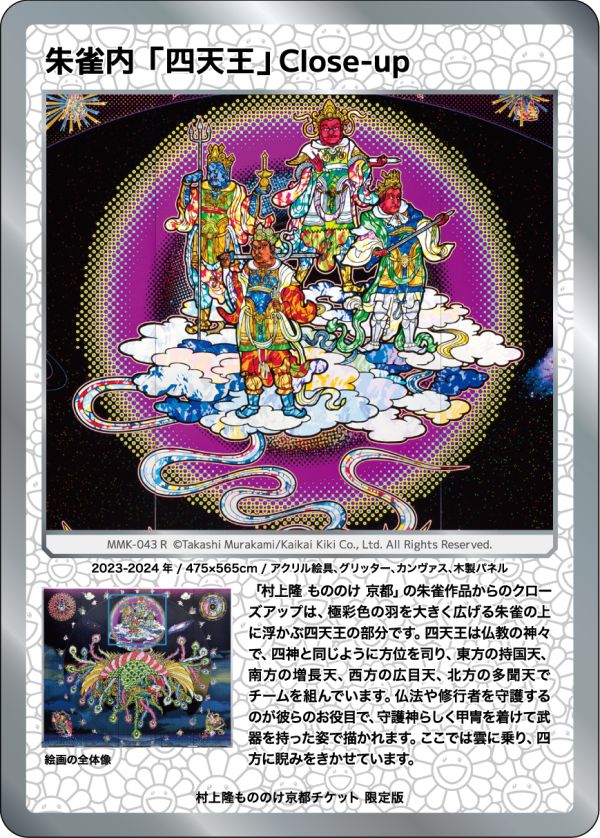

This is a detail from the Vermillion Bird painting in Takashi Murakami Mononoke Kyoto, closing in on the Four Heavenly Kings floating above the Vermillion Bird, whose wings in extreme colors are spread wide. The Four Heavenly Kings are Buddhist deities who, like the Four Symbols, govern the cardinal directions; their team consists of Jikoku-ten in the east, Zōchō-ten in the south, Kōmoku-ten in the west, and Tamon-ten in the north. Their role is to protect the Buddha Dharma and practitioners, and they are customarily depicted wearing armor and carrying weapons as guardian deities. Here, they are riding on clouds and glaring in all directions.
2024
「村上隆 もののけ 京都」の朱雀作品からのクローズアップは、極彩色の羽を大きく広げる朱雀の上に浮かぶ四天王の部分です。四天王は仏教の神々で、四神と同じように方位を司り、東方の持国天、南方の増長天、西方の広目天、北方の多聞天でチームを組んでいます。仏法や修行者を守護するのが彼らのお役目で、守護神らしく甲冑を着けて武器を持った姿で描かれます。ここでは雲に乗り、四方に睨みをきかせています。
2024年
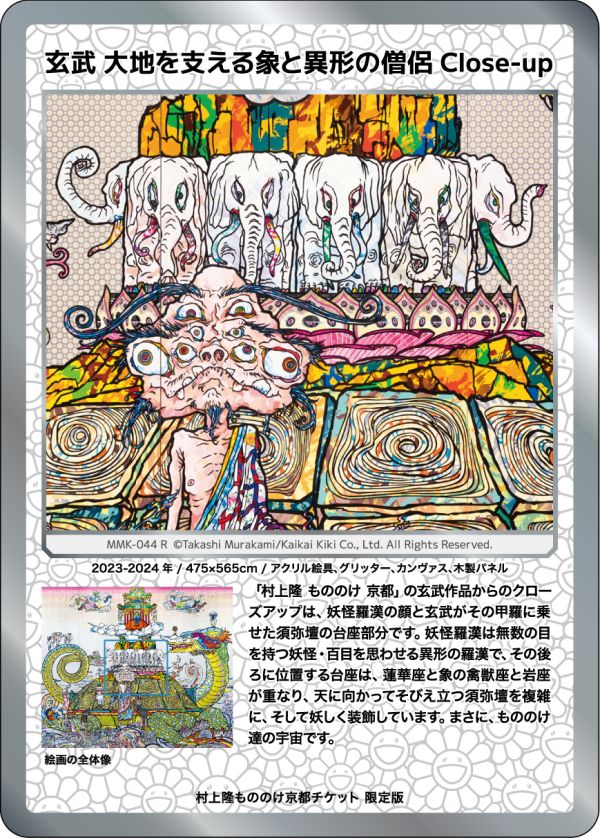

This is a detail from the Black Tortoise painting in Takashi Murakami Mononoke Kyoto, closing in on the face of Yōkai Arhat and the pedestal portion of the shumidan alter on Black Tortoise’s carapace. Yōkai Arhat is a grotesque arhat reminiscent of a yōkai with countless eyes called Hyakume, and the pedestal behind him consists of multiple layers—lotus, animals, and rocks—intricately and bewitchingly decorating the shumidan alter that soars to the heavens. It is truly a universe of mononoke.
2024
「村上隆 もののけ 京都」の玄武作品からのクローズアップは、妖怪羅漢の顔と玄武がその甲羅に乗せた須弥壇の台座部分です。妖怪羅漢は無数の目を持つ妖怪・百目を思わせる異形の羅漢で、その後ろに位置する台座は、蓮華座と象の禽獣座と岩座が重なり、天に向かってそびえ立つ須弥壇を複雑に、そして妖しく装飾しています。まさに、もののけ達の宇宙です。
2024年
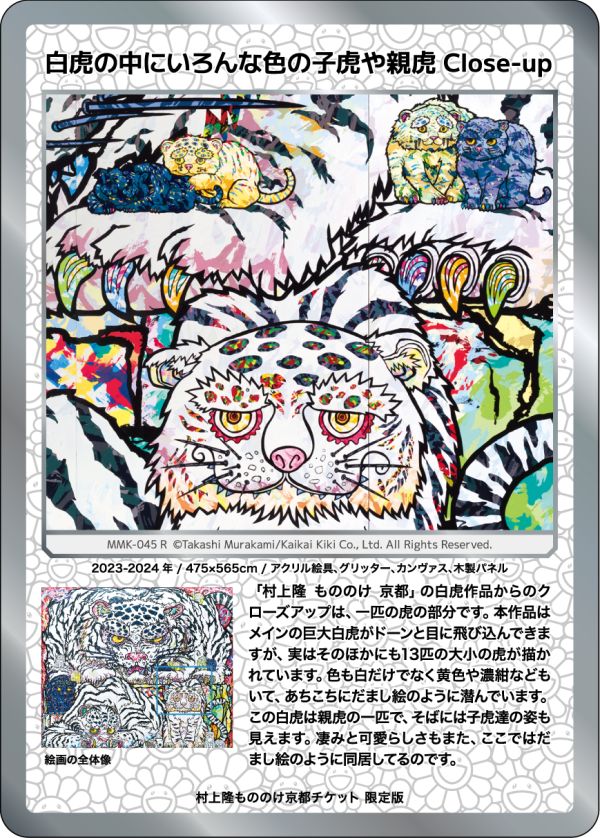

This is a detail from the White Tiger painting in Takashi Murakami Mononoke Kyoto, closing in on a single tiger. In this work, the main giant white tiger jumps out at you with such an impact, but there are actually thirteen other tigers of varying sizes in the painting. They are not just in white, but also in other colors including yellow and dark blue, and they lurk here and there like pictures hiding in a picture. This white tiger is one of the parent tigers, and you can see its cubs nearby. Both menace and cuteness also coexist here in the manner of hidden pictures.
2024
「村上隆 もののけ 京都」の白虎作品からのクローズアップは、一匹の虎の部分です。本作品はメインの巨大白虎がドーンと目に飛び込んできますが、実はそのほかにも13匹の大小の虎が描かれています。色も白だけでなく黄色や濃紺などもいて、あちこちにだまし絵のように潜んでいます。この白虎は親虎の一匹で、そばには子虎達の姿も見えます。凄みを可愛らしさもまた、ここではだまし絵のように同居してるのです。
2024年
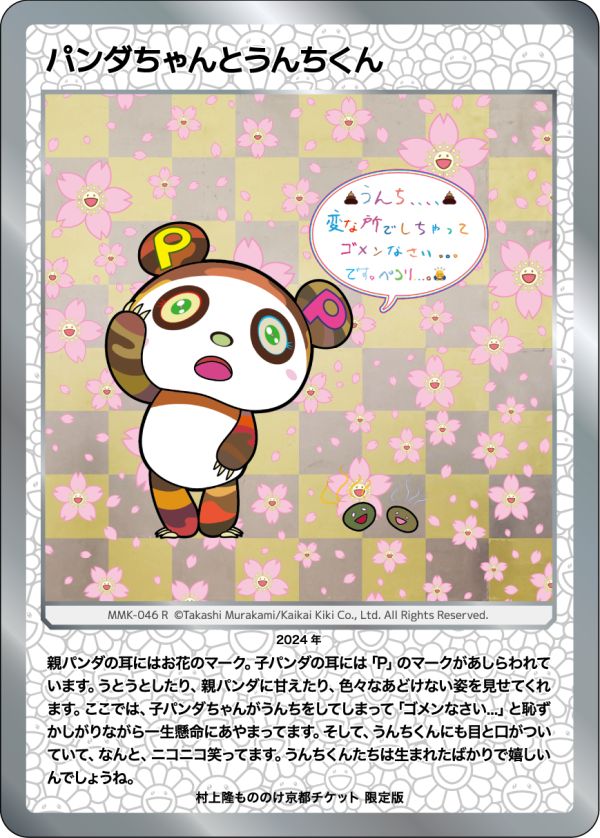

Pandas are popular characters in Murakami’s work. There are parent pandas and panda cubs, and the panda cubs display various innocent behaviors, playing, dozing off, and seeking parent pandas’ attention. Here, a panda cub looks adorable being embarrassed while trying its best to apologize for having pooped accidentally. And of course the poops themselves have eyes and mouths, making them characters in their own right.
2024
親パンダの耳にはお花のマーク。子パンダの耳には「P」のマークがあしらわれています。うとうとしたり、親パンダに甘えたり、色々なあどけない姿を見せてくれます。ここでは、子パンダちゃんがうんちをしてしまって「ゴメンなさい...」と恥ずかしがりながら一生懸命にあやまってます。そして、うんちくんにも目と口がついていて、なんと、ニコニコ笑ってます。うんちくんたちは生まれたばかりで嬉しいんでしょうね。
2024年
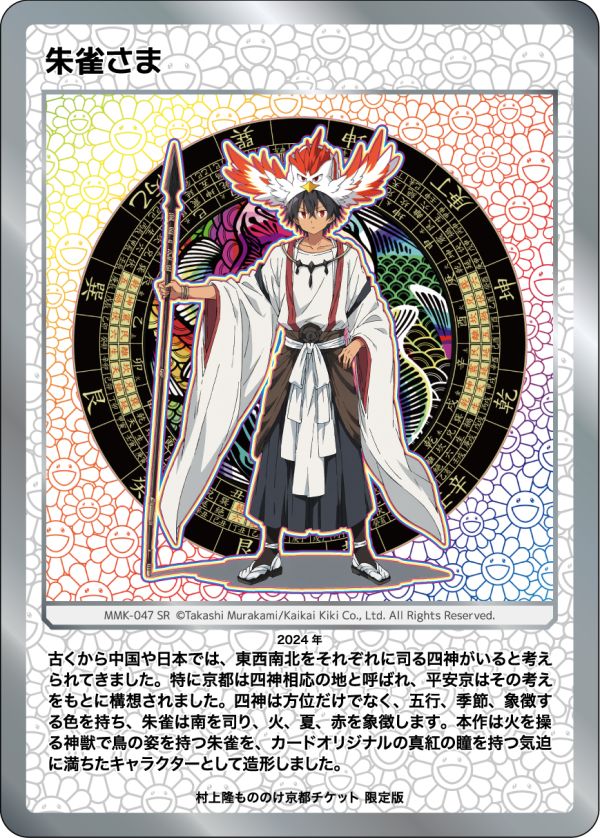

Since ancient times, it has been believed in China and Japan, among other places, that there are four deities, or Four Symbols, that each presides over one of the four cardinal directions of east, west, south, and north. Kyoto in particular is called the land of the Four Symbols, and the ancient capital Heian-kyo was conceived based on this belief. The Four Symbols not only preside over the directions, but also have attributes such as the five elements, seasons, and symbolic colors. Vermillion Bird represents south and symbolizes fire, summer, and red. This image is an original creation for the card: Vermillion Bird, a divine beast that controls fire and has the appearance of a bird, is rendered into a character full of spirit with crimson eyes.
2024
古くから中国や日本では、東西南北をそれぞれに司る四神がいると考えられてきました。特に京都は四神相応の地と呼ばれ、平安京はその考えをもとに構想されました。四神は方位だけでなく、五行、季節、象徴する色を持ち、朱雀は南を司り、火、夏、赤を象徴します。本作は火を操る神獣で鳥の姿を持つ朱雀を、カードオリジナルの真紅の瞳を持つ気迫に満ちたキャラクターとして造形しました。
2024年
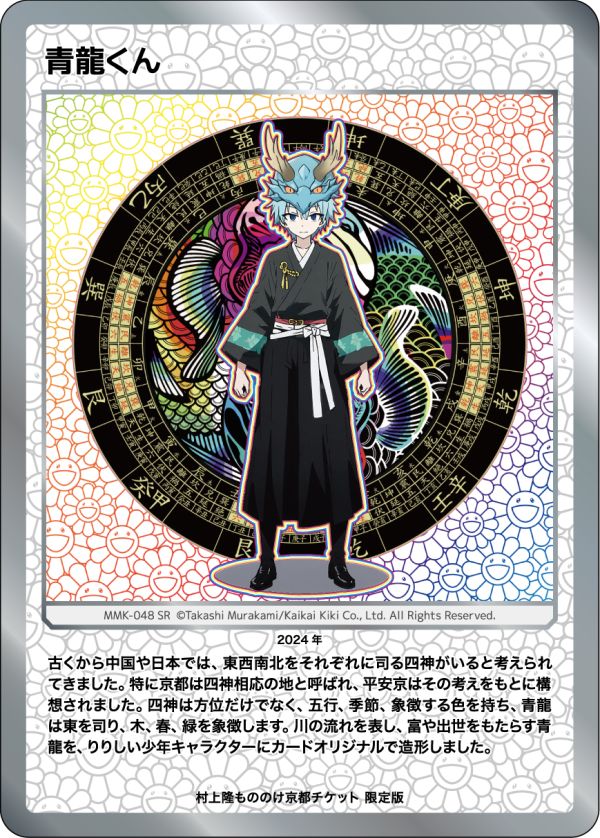

Since ancient times, it has been believed in China and Japan, among other places, that there are four deities, or Four Symbols, that each presides over one of the four cardinal directions of east, west, south, and north. Kyoto in particular is called the land of the Four Symbols, and the ancient capital Heian-kyo was conceived based on this belief. The Four Symbols not only preside over the directions, but also have attributes such as the five elements, seasons, and symbolic colors. Blue Dragon represents east and symbolizes trees, spring, and green. This image is an original creation for the card: Blue Dragon, which represents the flow of rivers and is believed to bring wealth and success in life, is rendered into a gallant boy character.
2024
古くから中国や日本では、東西南北をそれぞれに司る四神がいると考えられてきました。特に京都は四神相応の地と呼ばれ、平安京はその考えをもとに構想されました。四神は方位だけでなく、五行、季節、象徴する色を持ち、青龍は東を司り、木、春、緑を象徴します。川の流れを表し、富や出世をもたらす青龍を、りりしい少年キャラクターにカードオリジナルで造形しました。
2024年
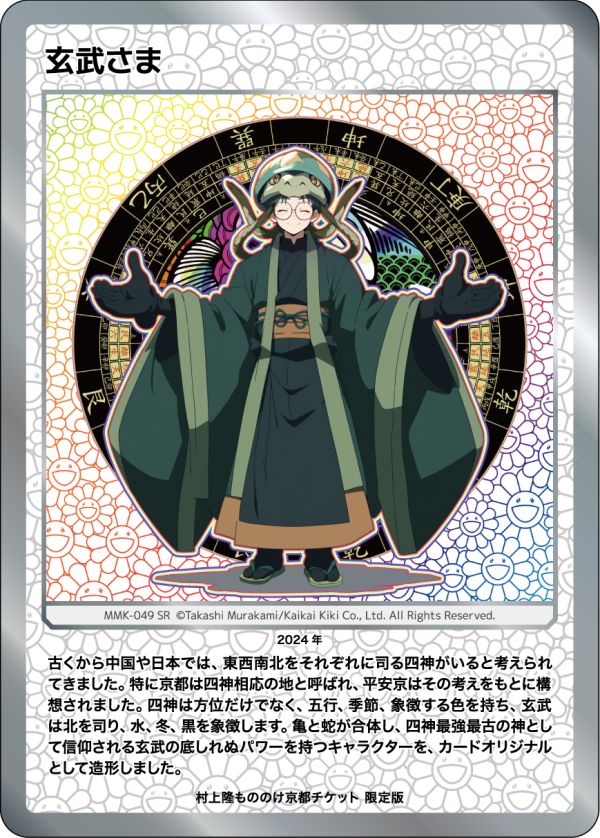

Since ancient times, it has been believed in China and Japan, among other places, that there are four deities, or Four Symbols, that each presides over one of the four cardinal directions of east, west, south, and north. Kyoto in particular is called the land of the Four Symbols, and the ancient capital Heian-kyo was conceived based on this belief. The Four Symbols not only preside over the directions, but also have attributes such as the five elements, seasons, and symbolic colors. Black Tortoise represents north and symbolizes water, winter, and black. This image is an original creation for the card: Black Tortoise, a deity that combines a turtle and a snake and is believed to be the most powerful and oldest of the Four Symbols, is rendered into a character with unfathomable power.
2024
古くから中国や日本では、東西南北をそれぞれに司る四神がいると考えられてきました。特に京都は四神相応の地と呼ばれ、平安京はその考えをもとに構想されました。四神は方位だけでなく、五行、季節、象徴する色を持ち、玄武は北を司り、水、冬、黒を象徴します。亀と蛇が合体し、四神最強最古の神として信仰される玄武の底しれぬパワーを持つキャラクターを、カードオリジナルとして造形しました。
2024年
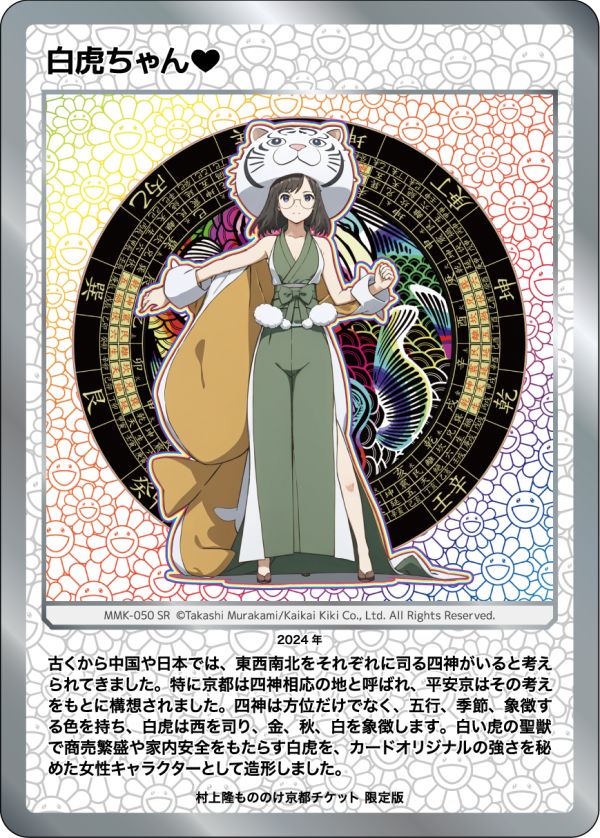

Since ancient times, it has been believed in China and Japan, among other places, that there are four deities, or Four Symbols, that each presides over one of the four cardinal directions of east, west, south, and north. Kyoto in particular is called the land of the Four Symbols, and the ancient capital Heian-kyo was conceived based on this belief. The Four Symbols not only preside over the directions, but also have attributes such as the five elements, seasons, and symbolic colors. White Tiger represents west and symbolizes gold, autumn, and white. This image is an original creation for the card: White Tiger, a sacred beast that brings business prosperity and domestic safety, is rendered into a strong female character.
2024
古くから中国や日本では、東西南北をそれぞれに司る四神がいると考えられてきました。特に京都は四神相応の地と呼ばれ、平安京はその考えをもとに構想されました。四神は方位だけでなく、五行、季節、象徴する色を持ち、白虎は西を司り、金、秋、白を象徴します。白い虎の聖獣で商売繁盛や家内安全をもたらす白虎を、カードオリジナルの強さを秘めた女性キャラクターとして造形しました。
2024年
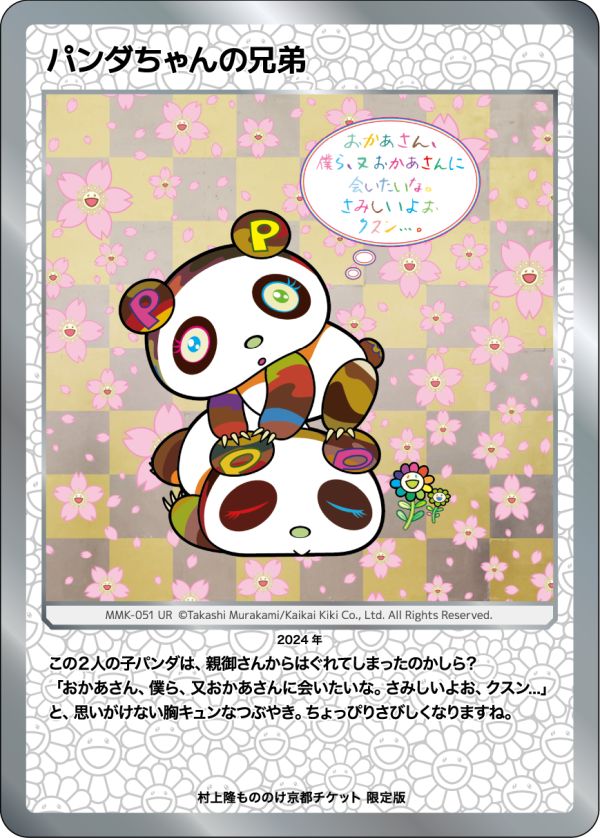

Did these two panda cubs get separated from their parents? "Mommy, we want to see you again. We miss you, sob..." Their unexpected, heartache-inducing mumble makes us feel a little sad.
2024
この2人の子パンダは、親御さんからはぐれてしまったのかしら?
「おかあさん、僕ら、又おかあさんに会いたいな。さみしいよお、クスン...」と、思いがけない胸キュンなつぶやき。ちょっぴりさびしくなりますね。
2024年
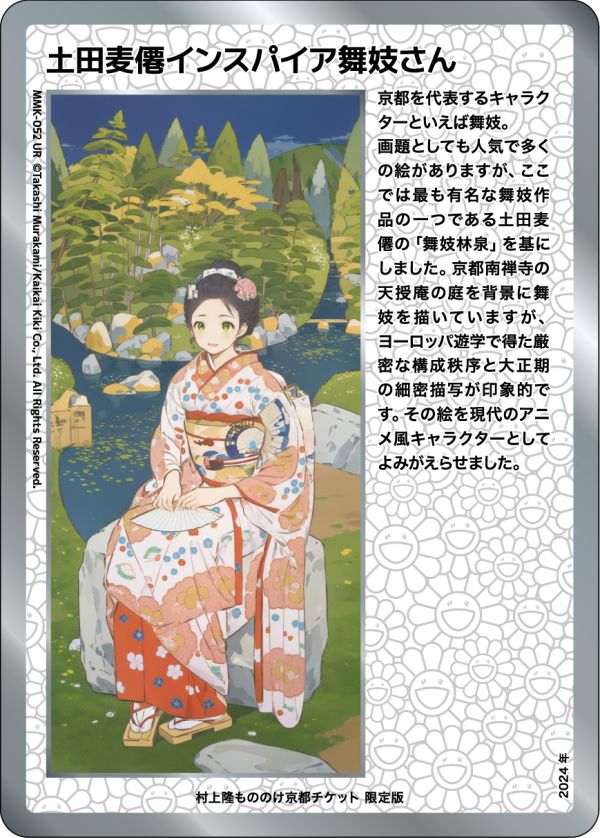

Maiko is one of the quintessential characters that symbolize Kyoto. They are also popular as a subject of art and many paintings with Maiko motif exist, but this image is based on one of the most famous maiko paintings, “Maiko in a Garden” by Tsuchida Bakusen. The painting depicts a maiko with the garden of Tenju-an in Nanzenji Temple, Kyoto, in the background. The strict compositional order, which the artist mastered during a study tour of Europe, as well as the meticulous depiction of the maiko, in the manner typical of Taisho era, are impressive. The painting has been revived here as a modern anime-style character.
2024
京都を代表するキャラクターといえば舞妓。
画題としても人気で多くの絵がありますが、ここでは最も有名な舞妓作品の一つである土田麦僊の「舞妓林泉」を基にしました。京都南禅寺の天授庵の庭を背景に舞妓を描いていますが、ヨーロッパ遊学で得た厳密な構成秩序と大正期の細密描写が印象的です。その絵を現代のアニメ風キャラクターとしてよみがえらせました。
2024年


A lone monkey sits on a kashiwa oak branch and stretches its fingertips toward the water surface. Although the creature is said to be a round-faced Chinese monkey, its cute eyes and nose that are rendered like symbols, as well as its mischievous smiling mouth, seem to anticipate character culture of our times. The gesture of the monkey reaching out with its hand while keeping balance is depicted simply yet realistically. “Monkey”, the basis of this image, is a painting by Kanō Sansetsu, the second-generation master of the Kyō Kanō school, a branch of Kanō school that remained in Kyoto after the establishment of the Tokugawa shogunate.
2024
柏の枝に腰掛けて、水面に指先を伸ばす一匹の猿。丸顔の中国猿だというけれど、現代のキャラクターを先取りしたような、記号化された可愛らしい目鼻に悪戯っぽく微笑む口元、シンプルに描かれているのに、バランスを取りながら手を伸ばす仕草がリアルに伝わってきます。この「猿猴図」の作者は、徳川幕府成立後も京都に残った狩野派である“京狩野”2代目の狩野山雪です。
2024年


An owl resembling a strawberry sits perched on a pine tree. The way its eyes gaze up is very cute; it looks as though it is having multitudinous thoughts, just like a human being, and the charm of this character comes through vividly. “Owl on the pine and chicken on the bamboo”, the basis of this image, is a painting by Kanō Sansetsu, the second-generation master of the Kyō Kanō school, a branch of Kanō school that remained in Kyoto after the establishment of the Tokugawa shogunate. He is also one of the “painters of eccentrics” who were reevaluated by the Japanese art historian Nobuo Tsuji.
2024
松の木にちょこんと乗ったイチゴのようなフクロウ。上目遣いがとても可愛い。まるで人間のように、いろいろな考えをめぐらしているようにも見えて、このキャラクターの魅力がイキイキと伝わってきます。この「松梟竹鶏図」の作者は、徳川幕府成立後も京都に残った狩野派である“京狩野”2代目の狩野山雪。日本美術史家・辻惟雄によって再評価された“奇想の画家”の一人でもあります。
2024年
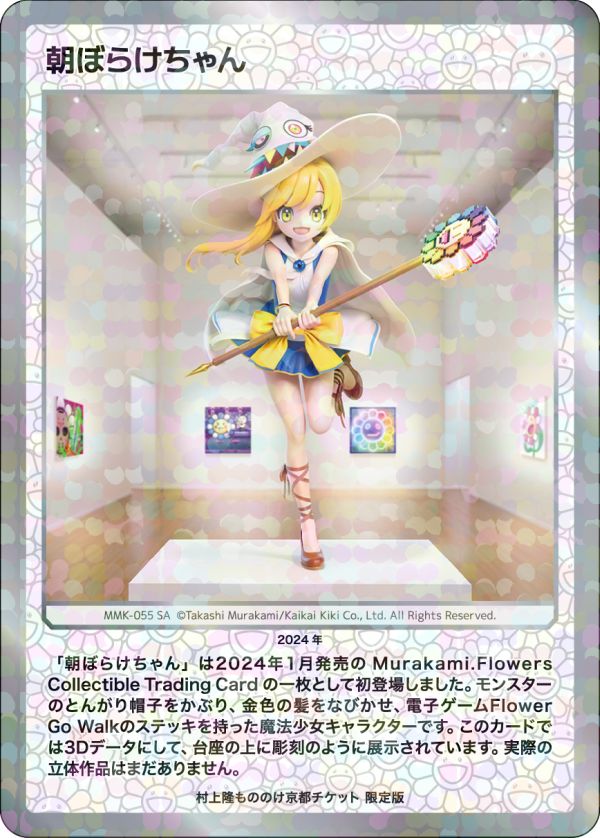

ASA_BORAKE-chang first appeared in the Murakami.Flowers Collectible Trading Cards, released in January 2024. She is a magical girl character with a monster pointy hat and wavy golden hair holding a wand made of the gaming device FLOWER GO WALK. On this card, the character is rendered into 3D data and displayed like a sculpture on a pedestal. The actual sculpture does not exist yet.
2024
「あさぼらけちゃん」は2024年1月発売のMurakami.Flowers Collectible Trading Card の一枚として初登場しました。モンスターのとんがり帽子をかぶり、金色の髪をなびかせ、電子ゲームFlower Go Walkのステッキを持った魔法少女キャラクターです。このカードでは3Dデータにして、台座の上に彫刻のように展示されています。実際の立体作品はまだありません。
2024年
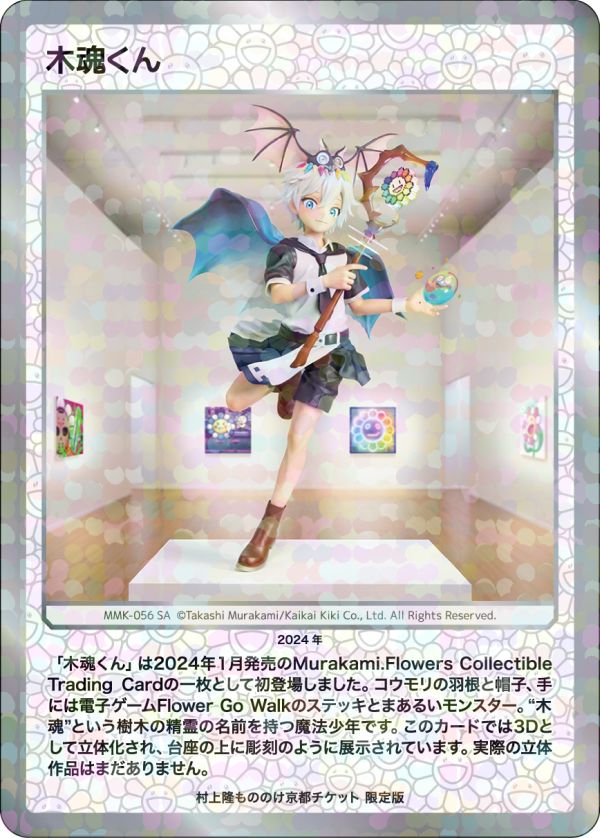

Kodama-kun first appeared in the Murakami.Flowers Collectible Trading Cards, released in January 2024. He has bat wings and wears a bat hat, and in his hands are a wand made of the gaming device FLOWER GO WALK and a round monster. He is a magical boy named after the spirit of a tree called "Kodama". On this card, the character is rendered into 3D data and displayed like a sculpture on a pedestal. The actual sculpture does not exist yet.
2024
「木魂くん」は2024年1月発売のMurakami.Flowers Collectible Trading Cardの一枚として初登場しました。コウモリの羽根と帽子、手には電子ゲームFlower Go Walkのステッキとまあるいモンスター。“木魂”という樹木の精霊の名前を持つ魔法少年です。このカードでは3Dとして立体化され、台座の上に彫刻のように展示されています。実際の立体作品はまだありません。
2024年
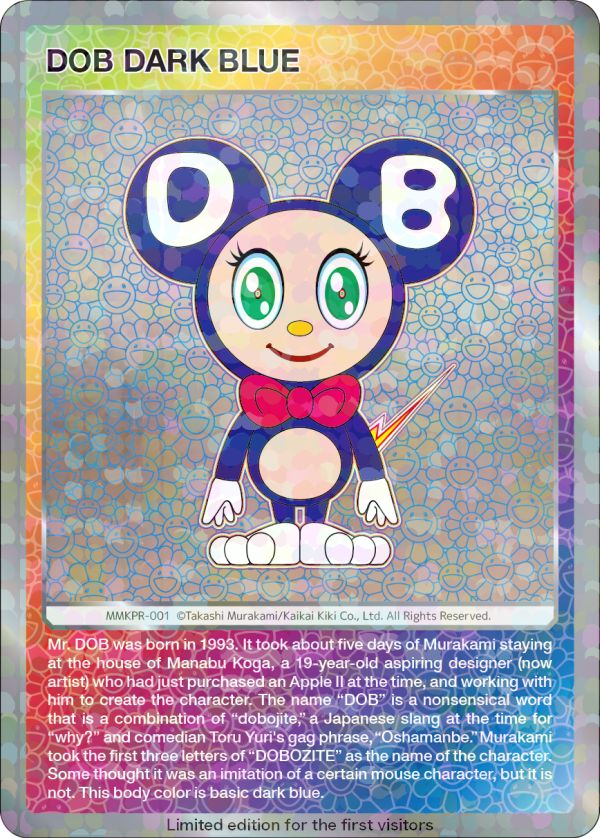

Mr. DOB was born in 1993. It took about five days of Murakami staying at the house of Manabu Koga, a 19-year-old aspiring designer (now artist) who had just purchased an Apple II at the time, and working with him to create the character. The name "DOB" is a nonsensical word that is a combination of “dobojite,” a Japanese slang at the time for "why?” and comedian Toru Yuri's gag phrase, "Oshamanbe." Murakami took the first three letters of "DOBOZITE" as the name of the character. Some thought it was an imitation of a certain mouse character, but it is not. This body color is basic Dark Blue.
DOB君は1993年に誕生し、当時19歳でAppleⅡを購入したてのデザイナー志望の専門学校生(現・アーチスト)の古賀学君の家に泊まり込み、彼との共同作業で、5日間程かけて出来たキャラクター。「DOB」という名前は、1970年台の有名な日本のギャグ漫画、川崎のぼる作『いなかっぺ大将』に出てくる「何故?」を意味する日本語のスラング「ドボジテ」と、由利徹の「オシャマンベ」のギャグフレーズを合体させた、無意味なワード。 「DOBOZITE」の頭の「DOB」をキャラクターの名前としました。某ネズミのキャラクターの模倣とも言われたけれど、それは違います。この体色は基本のダークブルーです。
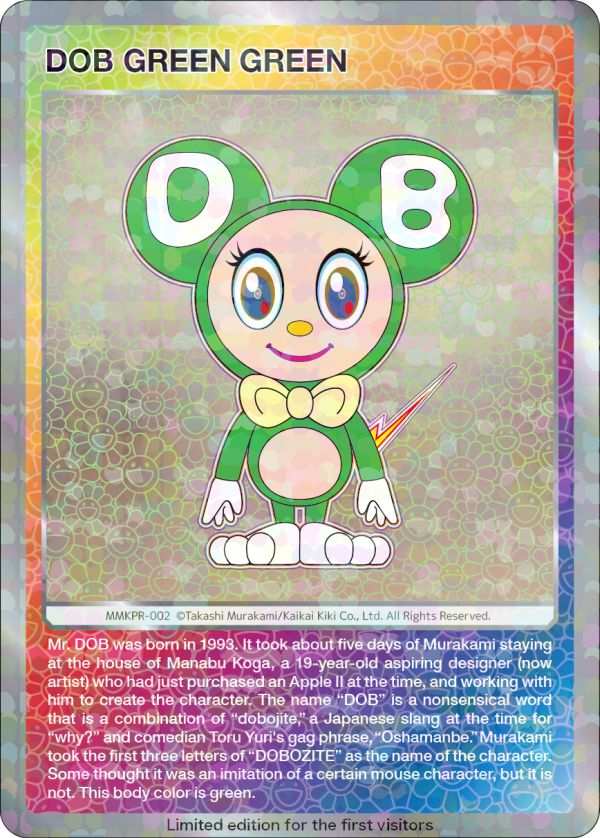

Mr. DOB was born in 1993. It took about five days of Murakami staying at the house of Manabu Koga, a 19-year-old aspiring designer (now artist) who had just purchased an Apple II at the time, and working with him to create the character. The name "DOB" is a nonsensical word that is a combination of “dobojite,” a Japanese slang at the time for "why?” and comedian Toru Yuri's gag phrase, "Oshamanbe." Murakami took the first three letters of "DOBOZITE" as the name of the character. Some thought it was an imitation of a certain mouse character, but it is not. This body color is Green Green.
DOB君は1993年に誕生し、当時19歳でAppleⅡを購入したてのデザイナー志望の専門学校生(現・アーチスト)の古賀学君の家に泊まり込み、彼との共同作業で、5日間程かけて出来たキャラクター。「DOB」という名前は、1970年台の有名な日本のギャグ漫画、川崎のぼる作『いなかっぺ大将』に出てくる「何故?」を意味する日本語のスラング「ドボジテ」と、由利徹の「オシャマンベ」のギャグフレーズを合体させた、無意味なワード。 「DOBOZITE」の頭の「DOB」をキャラクターの名前としました。某ネズミのキャラクターの模倣とも言われたけれど、それは違います。この体色はグリーングリーンです。
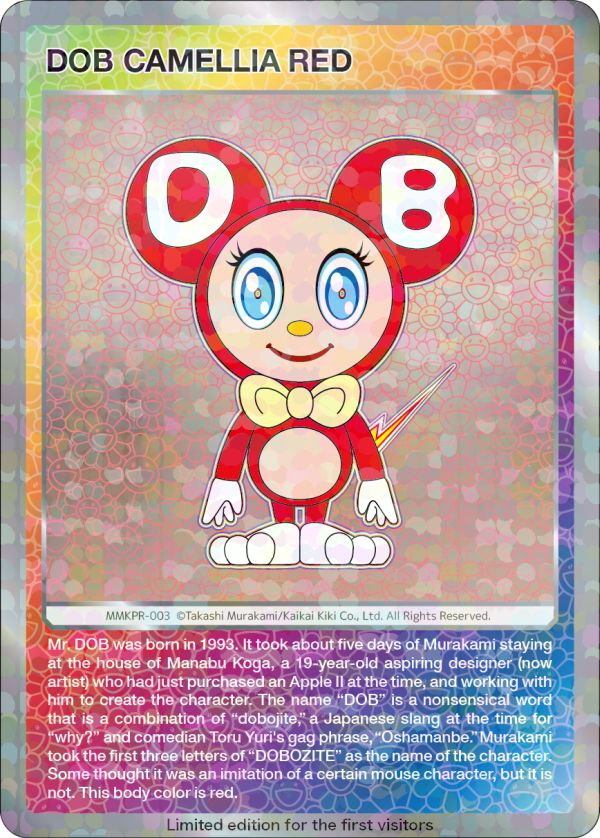

Mr. DOB was born in 1993. It took about five days of Murakami staying at the house of Manabu Koga, a 19-year-old aspiring designer (now artist) who had just purchased an Apple II at the time, and working with him to create the character. The name "DOB" is a nonsensical word that is a combination of “dobojite,” a Japanese slang at the time for "why?” and comedian Toru Yuri's gag phrase, "Oshamanbe." Murakami took the first three letters of "DOBOZITE" as the name of the character. Some thought it was an imitation of a certain mouse character, but it is not. This body color is Camellia Red.
DOB君は1993年に誕生し、当時19歳でAppleⅡを購入したてのデザイナー志望の専門学校生(現・アーチスト)の古賀学君の家に泊まり込み、彼との共同作業で、5日間程かけて出来たキャラクター。「DOB」という名前は、1970年台の有名な日本のギャグ漫画、川崎のぼる作『いなかっぺ大将』に出てくる「何故?」を意味する日本語のスラング「ドボジテ」と、由利徹の「オシャマンベ」のギャグフレーズを合体させた、無意味なワード。 「DOBOZITE」の頭の「DOB」をキャラクターの名前としました。某ネズミのキャラクターの模倣とも言われたけれど、それは違います。この体色はカメリアレッドです。


Mr. DOB was born in 1993. It took about five days of Murakami staying at the house of Manabu Koga, a 19-year-old aspiring designer (now artist) who had just purchased an Apple II at the time, and working with him to create the character. The name "DOB" is a nonsensical word that is a combination of “dobojite,” a Japanese slang at the time for "why?” and comedian Toru Yuri's gag phrase, "Oshamanbe." Murakami took the first three letters of "DOBOZITE" as the name of the character. Some thought it was an imitation of a certain mouse character, but it is not. This body color is Yellow.
DOB君は1993年に誕生し、当時19歳でAppleⅡを購入したてのデザイナー志望の専門学校生(現・アーチスト)の古賀学君の家に泊まり込み、彼との共同作業で、5日間程かけて出来たキャラクター。「DOB」という名前は、1970年台の有名な日本のギャグ漫画、川崎のぼる作『いなかっぺ大将』に出てくる「何故?」を意味する日本語のスラング「ドボジテ」と、由利徹の「オシャマンベ」のギャグフレーズを合体させた、無意味なワード。 「DOBOZITE」の頭の「DOB」をキャラクターの名前としました。某ネズミのキャラクターの模倣とも言われたけれど、それは違います。この体色はイエローです。
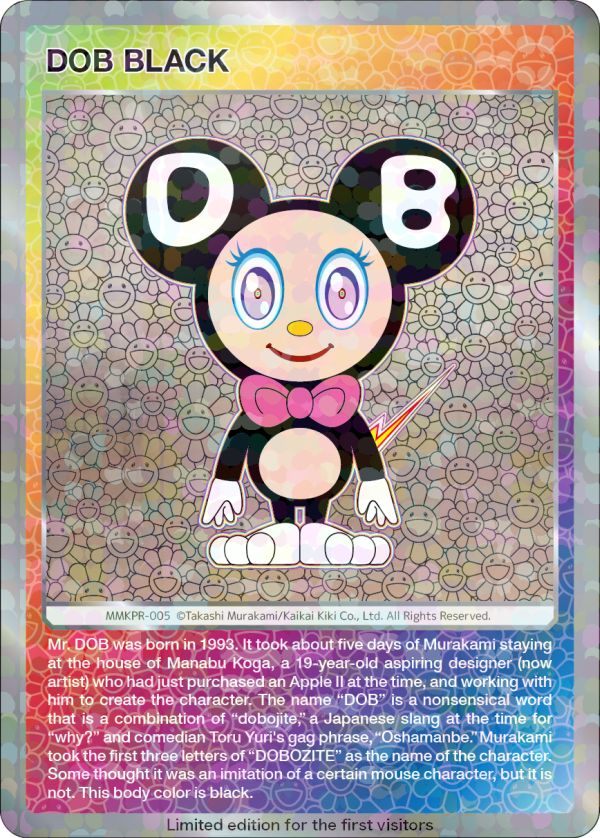

Mr. DOB was born in 1993. It took about five days of Murakami staying at the house of Manabu Koga, a 19-year-old aspiring designer (now artist) who had just purchased an Apple II at the time, and working with him to create the character. The name "DOB" is a nonsensical word that is a combination of “dobojite,” a Japanese slang at the time for "why?” and comedian Toru Yuri's gag phrase, "Oshamanbe." Murakami took the first three letters of "DOBOZITE" as the name of the character. Some thought it was an imitation of a certain mouse character, but it is not. This body color is Black.
DOB君は1993年に誕生し、当時19歳でAppleⅡを購入したてのデザイナー志望の専門学校生(現・アーチスト)の古賀学君の家に泊まり込み、彼との共同作業で、5日間程かけて出来たキャラクター。「DOB」という名前は、1970年台の有名な日本のギャグ漫画、川崎のぼる作『いなかっぺ大将』に出てくる「何故?」を意味する日本語のスラング「ドボジテ」と、由利徹の「オシャマンベ」のギャグフレーズを合体させた、無意味なワード。 「DOBOZITE」の頭の「DOB」をキャラクターの名前としました。某ネズミのキャラクターの模倣とも言われたけれど、それは違います。この体色はブラックです。
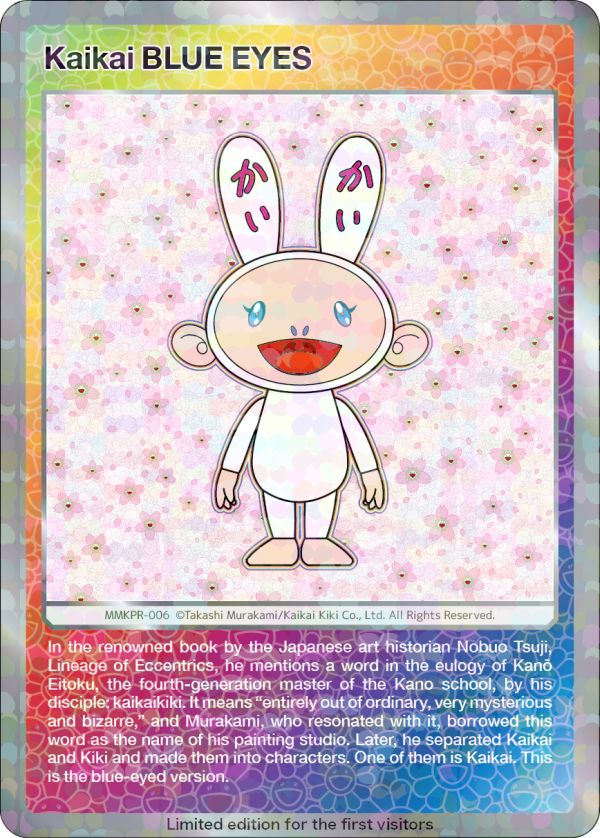

In the renowned book by the Japanese art historian Nobuo Tsuji, Lineage of Eccentrics, he mentions a word in the eulogy of Kanō Eitoku, the fourth-generation master of the Kano school, by his disciple: kaikaikiki. It means "entirely out of ordinary, very mysterious and bizarre," and Murakami, who resonated with it, borrowed this word as the name of his painting studio. Later, he separated Kaikai and Kiki and made them into characters. One of them is Kaikai. This is the blue-eyed version.
日本美術史家 辻惟雄先生の名著『奇想の系譜』内に書かれている一文に、狩野派の四代目永徳をその弟子が讃えた賛辞の句に「恠恠奇奇(かいかいきき)」という「普通では考えられないような、非常に不思議で怪しいさま」と言う意味の言葉があり、それに意を得た村上が絵画工房の名前としてこの言葉を拝借。その後カイカイとキキを分離させ、キャラクターに仕立てた。その1つがカイカイである。その青目版。
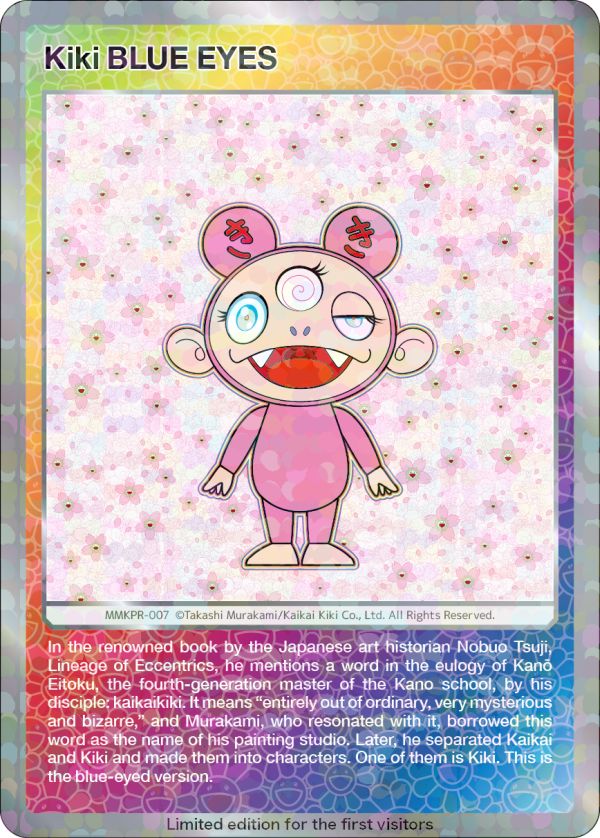

In the renowned book by the Japanese art historian Nobuo Tsuji, Lineage of Eccentrics, he mentions a word in the eulogy of Kanō Eitoku, the fourth-generation master of the Kano school, by his disciple: kaikaikiki. It means "entirely out of ordinary, very mysterious and bizarre," and Murakami, who resonated with it, borrowed this word as the name of his painting studio. Later, he separated Kaikai and Kiki and made them into characters. One of them is Kiki. This is the blue-eyed version.
日本美術史家 辻惟雄先生の名著『奇想の系譜』内に書かれている一文に、狩野派の四代目永徳をその弟子が讃えた賛辞の句に「恠恠奇奇(かいかいきき)」という「普通では考えられないような、非常に不思議で怪しいさま」と言う意味の言葉があり、それに意を得た村上が絵画工房の名前としてこの言葉を拝借。その後カイカイとキキを分離させ、キャラクターに仕立てた。その1つがキキである。その青目版。
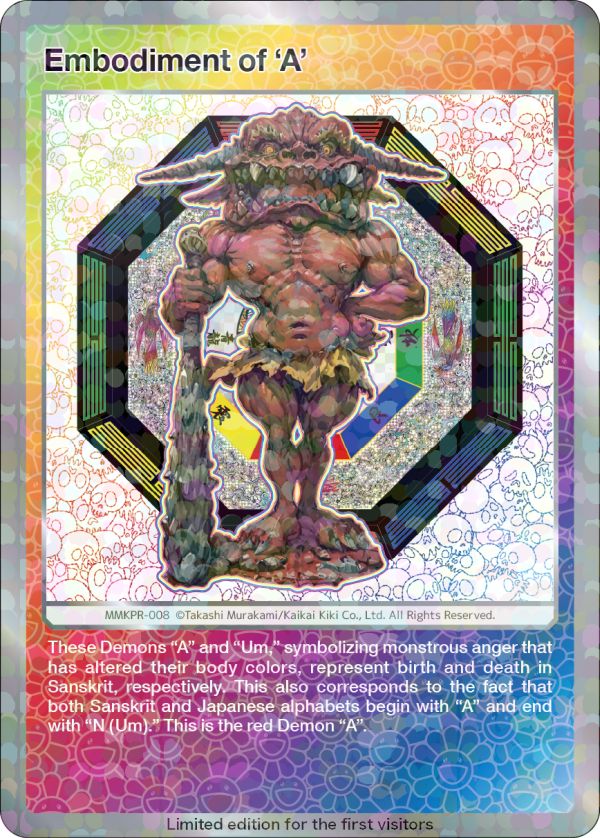

These Demons “A” and “Um,” symbolizing monstrous anger that has altered their body colors, represent birth and death in Sanskrit, respectively. This also corresponds to the fact that both Sanskrit and Japanese alphabets begin with "A" and end with "N (Um).” This is the red Demon "A".
異形の怒りの象徴として体色が変化している「鬼」。 阿吽とは、サンスクリット語で誕生と死を表している。これは「あ・いうえお〜ん」の始まりと終わりが、それぞれ「ア」「ン」と発音されることにも対応している。 赤の「阿」。


These Demons “A” and “Um,” symbolizing monstrous anger that has altered their body colors, represent birth and death in Sanskrit, respectively. This also corresponds to the fact that both Sanskrit and Japanese alphabets begin with "A" and end with "N (Um).” This is the Blue Demon "Um".
異形の怒りの象徴として体色が変化している「鬼」。 阿吽とは、サンスクリット語で誕生と死を表している。これは「あ・いうえお〜ん」の始まりと終わりが、それぞれ「ア」「ン」と発音されることにも対応している。 青の「吽」。
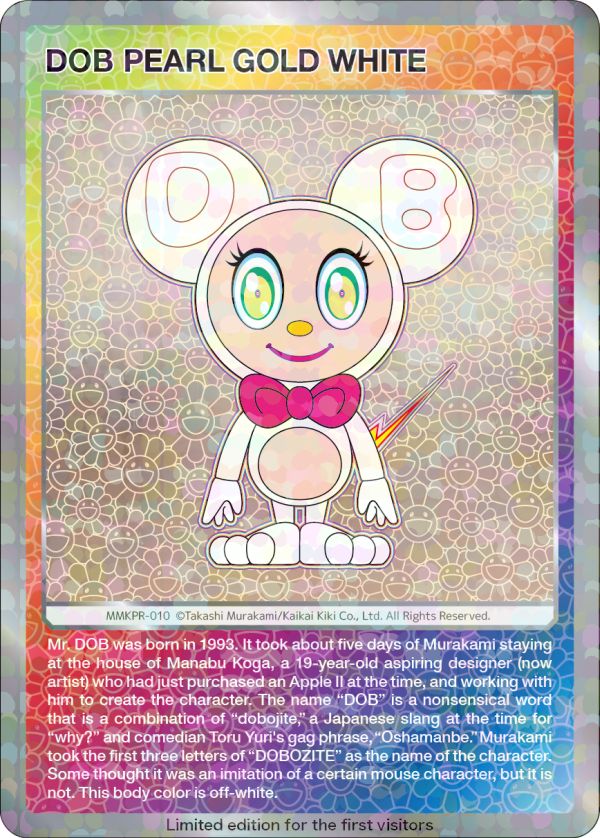

Mr. DOB was born in 1993. It took about five days of Murakami staying at the house of Manabu Koga, a 19-year-old aspiring designer (now artist) who had just purchased an Apple II at the time, and working with him to create the character. The name "DOB" is a nonsensical word that is a combination of “dobojite,” a Japanese slang at the time for "why?” and comedian Toru Yuri's gag phrase, "Oshamanbe." Murakami took the first three letters of "DOBOZITE" as the name of the character. Some thought it was an imitation of a certain mouse character, but it is not. This body color is Pearl Gold White.
DOB君は1993年に誕生し、当時19歳でAppleⅡを購入したてのデザイナー志望の専門学校生(現・アーチスト)の古賀学君の家に泊まり込み、彼との共同作業で、5日間程かけて出来たキャラクター。「DOB」という名前は、1970年台の有名な日本のギャグ漫画、川崎のぼる作『いなかっぺ大将』に出てくる「何故?」を意味する日本語のスラング「ドボジテ」と、由利徹の「オシャマンベ」のギャグフレーズを合体させた、無意味なワード。 「DOBOZITE」の頭の「DOB」をキャラクターの名前としました。某ネズミのキャラクターの模倣とも言われたけれど、それは違います。この体色はパールゴールドホワイトです。
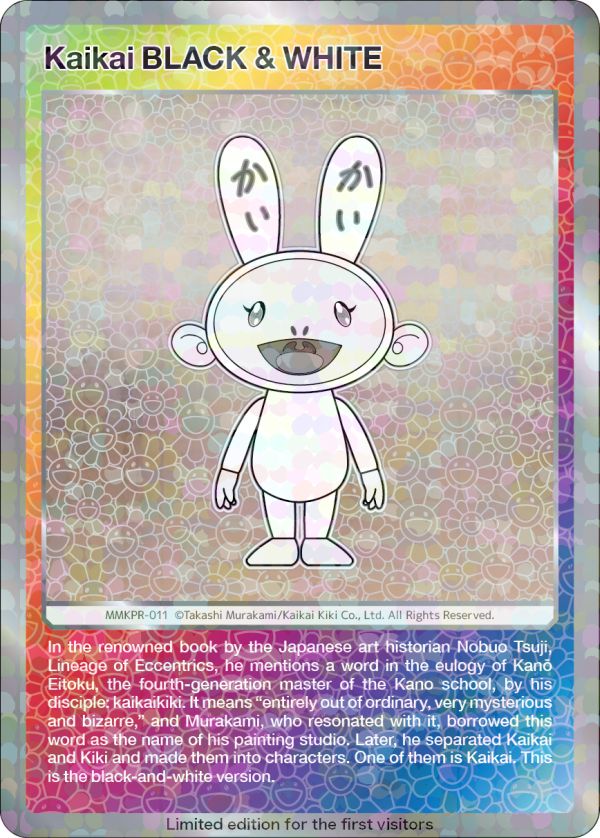

In the renowned book by the Japanese art historian Nobuo Tsuji, Lineage of Eccentrics, he mentions a word in the eulogy of Kanō Eitoku, the fourth-generation master of the Kano school, by his disciple: kaikaikiki. It means "entirely out of ordinary, very mysterious and bizarre," and Murakami, who resonated with it, borrowed this word as the name of his painting studio. Later, he separated Kaikai and Kiki and made them into characters. One of them is Kaikai. This is the black-and-white version.
日本美術史家 辻惟雄先生の名著『奇想の系譜』内に書かれている一文に、狩野派の四代目永徳をその弟子が讃えた賛辞の句に「恠恠奇奇(かいかいきき)」という「普通では考えられないような、非常に不思議で怪しいさま」と言う意味の言葉があり、それに意を得た村上が絵画工房の名前としてこの言葉を拝借。その後カイカイとキキを分離させ、キャラクターに仕立てた。その1つがカイカイである。その白黒版。


In the renowned book by the Japanese art historian Nobuo Tsuji, Lineage of Eccentrics, he mentions a word in the eulogy of Kanō Eitoku, the fourth-generation master of the Kano school, by his disciple: kaikaikiki. It means "entirely out of ordinary, very mysterious and bizarre," and Murakami, who resonated with it, borrowed this word as the name of his painting studio. Later, he separated Kaikai and Kiki and made them into characters. One of them is Kiki. This is the black-and-white version.
日本美術史家 辻惟雄先生の名著『奇想の系譜』内に書かれている一文に、狩野派の四代目永徳をその弟子が讃えた賛辞の句に「恠恠奇奇(かいかいきき)」という「普通では考えられないような、非常に不思議で怪しいさま」と言う意味の言葉があり、それに意を得た村上が絵画工房の名前としてこの言葉を拝借。その後カイカイとキキを分離させ、キャラクターに仕立てた。その1つがキキである。その白黒版。
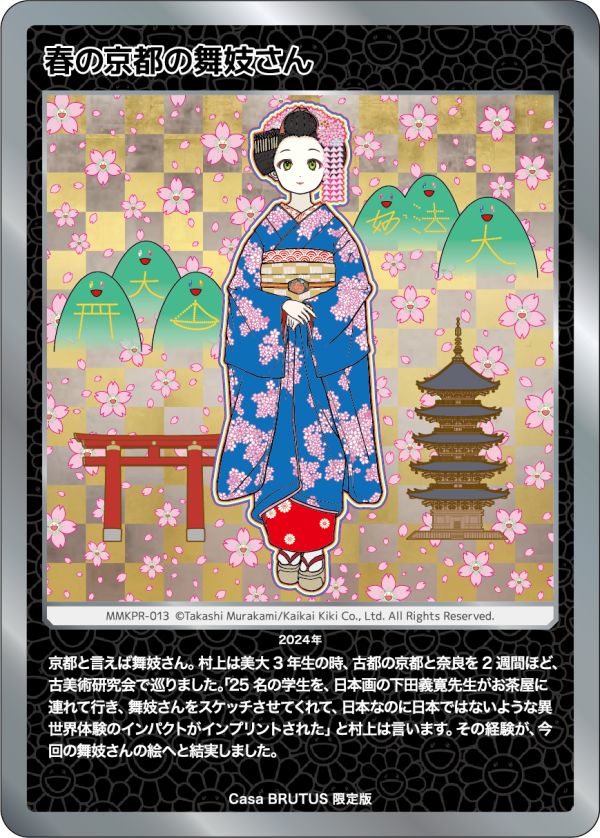

京都と言えば舞妓さん。村上は美大3年生の時、古都の京都と奈良を2週間ほど、古美術研究会で巡りました。「25名の学生を、日本画の下田義寛先生がお茶屋に連れて行き、舞妓さんをスケッチさせてくれて、日本なのに日本ではないような異世界体験のインパクトがインプリントされた」と村上は言います。その経験が、今回の舞妓さんの絵へと結実しました。
京都と言えば舞妓さん。村上は美大3年生の時、古都の京都と奈良を2週間ほど、古美術研究会で巡りました。「25名の学生を、日本画の下田義寛先生がお茶屋に連れて行き、舞妓さんをスケッチさせてくれて、日本なのに日本ではないような異世界体験のインパクトがインプリントされた」と村上は言います。その経験が、今回の舞妓さんの絵へと結実しました。
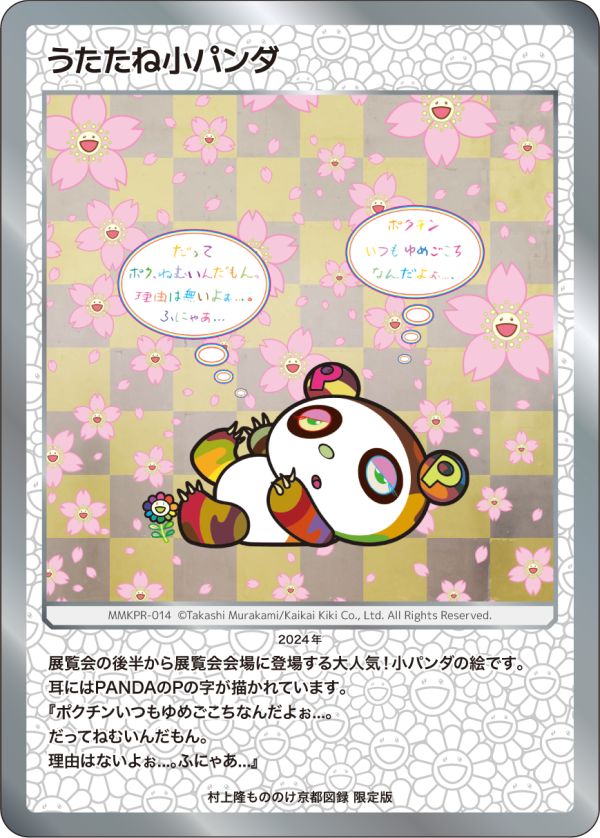

This is a painting of a very popular character, Little Panda, which will make its_appearance in the museum gallery during the second half of the exhibition run.
The letter “P” of PANDA is on each of his ears.
“I'm always dreamy…
Because I'm sleepy…
For no particular reason… mumble mumble…”
2024
展覧会の後半から展覧会会場に登場する大人気!小パンダの絵です。
耳にはPANDAのPの字が描かれています。
『ポクチンいつもゆめごこちなんだよぉ...。
だってねむいんだもん。
理由はないよぉ...。ふにゃあ...』
2024年


“I think, therefore I am” is a famous philosophical principle from Descartes's treatise, Discourse on the Method. Because we are alive, we eat. And things that need to come out would come out. Little Panda is thinking about the meaning of life while farting atop the flower ball... or not... lol....
“I think, therefore I am… Oops, I farted!”
Little Panda’s philosophy has achieved a true state of nothingness.
2024
「我思う、故に我あり」デカルトの「方法序説」で説いた有名な哲学用語です。生きているがゆえに食べる。そして出るモノは出る。小パンダちゃんはお花ボールに乗っかってオナラをしながら生きる意味を考えて…いるのかいないのか…苦笑。
『我、思う。ゆえに我あり、、、なーんつってね!! おならしてしもた。』 小パンダの哲学は、まさに「無」の境地です。
2024年
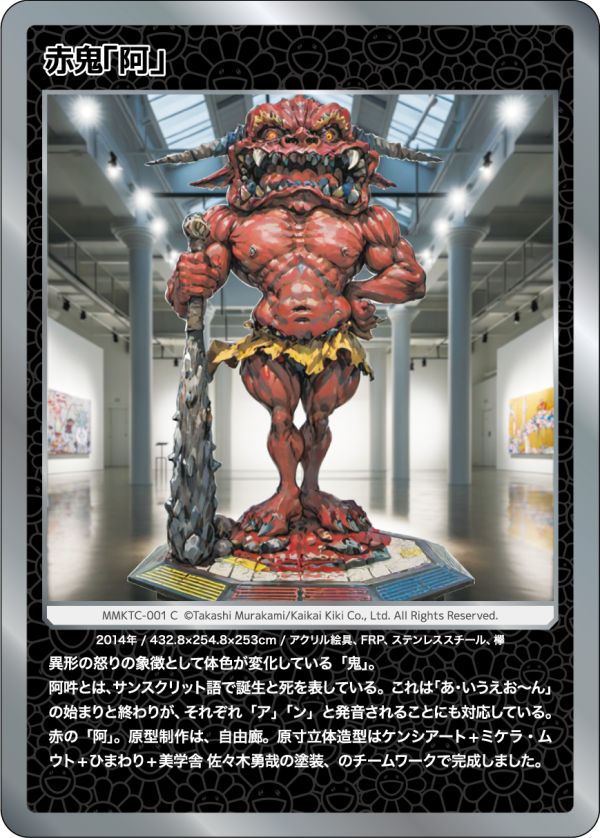

These Demons “A” and “Um,” symbolizing monstrous anger that has altered their body colors, represent birth and death in Sanskrit, respectively. This also corresponds to the fact that both Sanskrit and Japanese alphabets begin with "A" and end with "N (Um).”
This is the red Demon "A". Original modeling by JIYURO. Full-scale modeling was completed through a teamwork between Kenshi Art, Michela Mouto, and HIMAWARI, with painting by Bigakusha’s Yuya Sasaki.
2014 / 430 x 262.4 x 253 cm / FRP, stainless steel, zelkova wood, and acrylic
異形の怒りの象徴として体色が変化している「鬼」。
阿吽とは、サンスクリット語で誕生と死を表している。これは「あ・いうえお〜ん」の始まりと終わりが、それぞれ「ア」「ン」と発音されることにも対応している。
赤の「阿」。原型制作は、自由廊。原寸立体造型はケンシアート+ミケラ・ムウト+ひまわり+美学舎 佐々木勇哉の塗装、のチームワークで完成しました。
2014年 / 430×262.4×253cm / アクリル絵具、FRP、ステンレススチール、欅
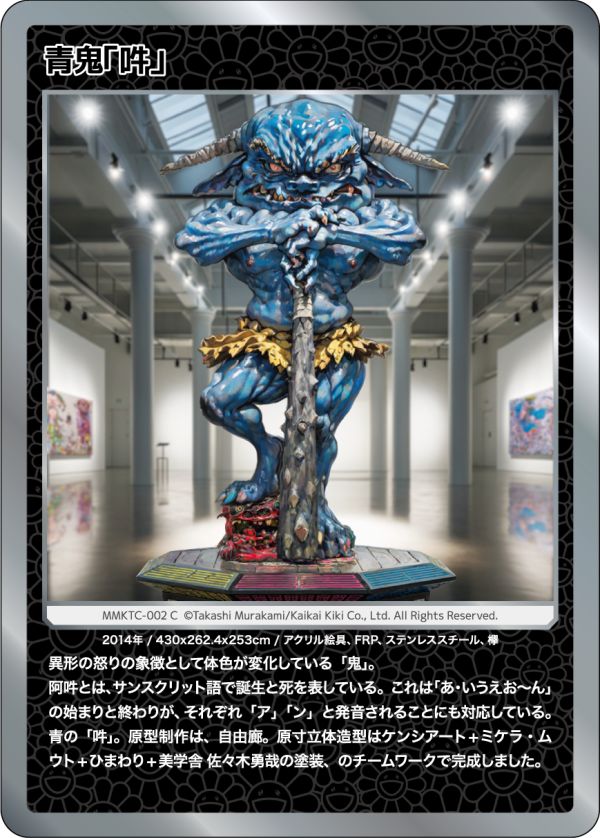

These Demons “A” and “Um,” symbolizing monstrous anger that has altered their body colors, represent birth and death in Sanskrit, respectively. This also corresponds to the fact that both Sanskrit and Japanese alphabets begin with "A" and end with "N (Um).”
This is the Blue Demon " Un ". Original modeling by JIYURO. Full-scale modeling was completed through a teamwork between Kenshi Art, Michela Mouto, and HIMAWARI, with painting by Bigakusha’s Yuya Sasaki.
2014 / 432.8 x 254.8 x 253 cm / FRP, stainless steel, zelkova wood, and acrylic
異形の怒りの象徴として体色が変化している「鬼」。
阿吽とは、サンスクリット語で誕生と死を表している。これは「あ・いうえお〜ん」の始まりと終わりが、それぞれ「ア」「ン」と発音されることにも対応している。
青の「吽」。原型制作は、自由廊。原寸立体造型はケンシアート+ミケラ・ムウト+ひまわり+美学舎 佐々木勇哉の塗装、のチームワークで完成しました。
2014年 / 432.8×254.8×253cm / アクリル絵具、FRP、ステンレススチール、欅


Cherry blossom wallpaper covers an entire wall of the central hall of the Kyoto City KYOCERA Museum of Art for the Takashi Murakami Mononoke Kyoto exhibition. A checkered pattern representing gold and platinum leaf shines in the background, rendering the entire hall a glamorous and festive space. If you look carefully at the wall, you would find Murakami's Flower characters, cats, and mysterious characters called Unfamiliar People.
As this is a horizontally long wallpaper, it is divided into two cards. This card shows the left side of the wallpaper.
2023-2024 / 932 x 2250 cm / Silver vinyl chloride film output, matte laminate
「村上隆 もののけ 京都」にて、京都市京セラ美術館中央ホールの壁一面に描かれた桜の壁紙。背景には金箔とプラチナ箔を表現した格子模様が輝き、ホール一面が華やかな部屋となっていました。壁をよくよく探してみると、村上のお花ちゃんキャラや猫ちゃん、「見たことのない人々」と言われる不思議なキャラクターたちが描かれています。
横長の壁紙であるため、2枚のカードに分割されています。
このカードの図は左の位置にあたります。
2023-2024年 / 932×2250cm / シルバー塩ビフィルム出力、マットラミネート加工


Cherry blossom wallpaper covers an entire wall of the central hall of the Kyoto City KYOCERA Museum of Art for the Takashi Murakami Mononoke Kyoto exhibition. A checkered pattern representing gold and platinum leaf shines in the background, rendering the entire hall a glamorous and festive space. If you look carefully at the wall, you would find Murakami's Flower characters, cats, and mysterious characters called Unfamiliar People.
As this is a horizontally long wallpaper, it is divided into three cards. This card shows the right side of the wallpaper.
2023-2024 / 932 x 2250 cm / Silver vinyl chloride film output, matte laminate
「村上隆 もののけ 京都」にて、京都市京セラ美術館中央ホールの壁一面に描かれた桜の壁紙。背景には金箔とプラチナ箔を表現した格子模様が輝き、ホール一面が華やかな部屋となっていました。壁をよくよく探してみると、村上のお花ちゃんキャラや猫ちゃん、「見たことのない人々」と言われる不思議なキャラクターたちが描かれています。
横長の壁紙であるため、2枚のカードに分割されています。
このカードの図は右の位置にあたります。
2023-2024年 / 932×2250cm / シルバー塩ビフィルム出力、マットラミネート加工
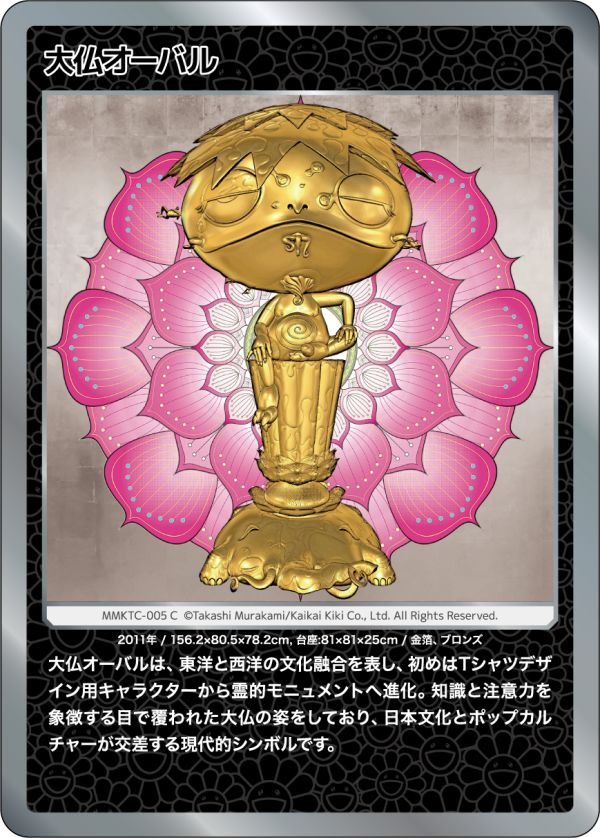

Oval Buddha represents the cultural fusion of East and West. Initially a character created for a T-shirt design, it evolved into a spiritual monument over time. With its appearance of the Great Buddha covered with eyes that symbolize knowledge and attention, it is a contemporary symbol of the intersection of Japanese culture and pop culture.
2011 / 156.2 x 80.5 x 78.2 cm (pedestal: 81 × 81x 25 cm) / Gold leaf on bronze
大仏オーバルは、東洋と西洋の文化融合を表し、初めはTシャツデザイン用キャラクターから霊的モニュメントへ進化。知識と注意力を象徴する目で覆われた大仏の姿をしており、日本文化とポップカルチャーが交差する現代的シンボルです。
2011年 / 156.2×80.5×78.2cm,
台座:81×81×25cm / 金箔、ブロンズ


Based on the 17th century screen painting "Rakuchū-rakugai-zu Byōbu (Funaki version)" by Iwasa Matabei, this is a contemporary version of "scenes in and around Kyoto" depicting the city (Rakuchū) and suburbs (Rakugai) of ancient Kyoto from a bird's eye view. It was produced in response to the museum's request, incorporating a taste of Murakami. The work reflects Murakami's studies at Tokyo University of the Arts and the influence of the mentor he reveres, Nobuo Tsuji. On this card, you can see the area around Nijō Street depicted on the left screen.
2023-2024 / Diptych, each 300 x 653.8 cm / Acrylic and gold leaf on canvas mounted on wood panel
This section is on the left screen.
17世紀の岩佐又兵衛による屏風絵《洛中洛外図(舟木本)》をもとに、京都の市街(洛中)と郊外(洛外)を俯瞰で描いた、現代版の洛中洛外図です。美術館側のリクエストに応じて村上のテイストを取り入れながら制作されました。村上の東京藝大での学びや尊敬する辻惟雄先生の影響が反映されており、このカードでは左隻の「二条通り」周辺が登場しています。
2023-2024年 / 二連画 各300×653.8cm / アクリル絵具、金箔、カンヴァス、木製パネル
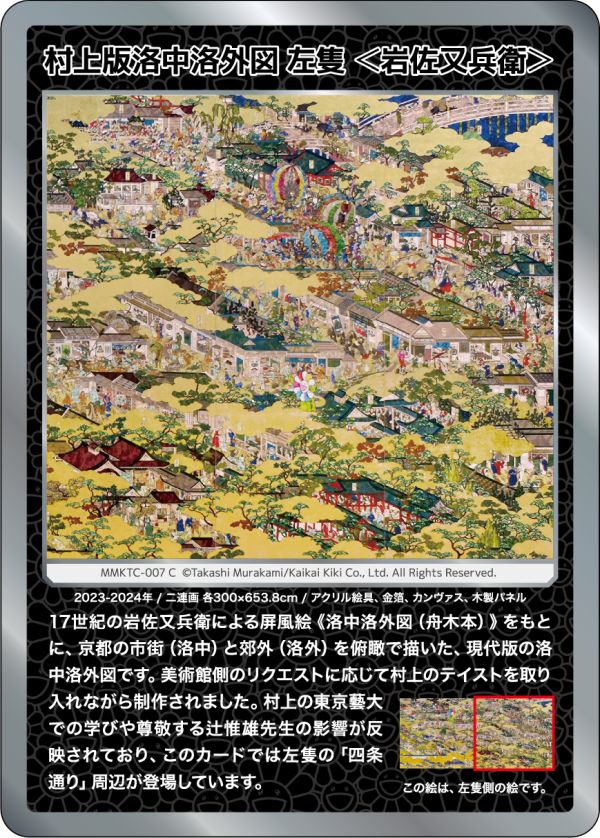

Based on the 17th century screen painting "Rakuchū-rakugai-zu Byōbu (Funaki version)" by Iwasa Matabei, this is a contemporary version of "scenes in and around Kyoto" depicting the city (Rakuchū) and suburbs (Rakugai) of ancient Kyoto from a bird's eye view. It was produced in response to the museum's request, incorporating a taste of Murakami. The work reflects Murakami's studies at Tokyo University of the Arts and the influence of the mentor he reveres, Nobuo Tsuji. On this card, you can see the area around Shijō Street depicted on the left screen.
2023-2024 / Diptych, each 300 x 653.8 cm / Acrylic and gold leaf on canvas mounted on wood pane
This section is on the left screen.l
17世紀の岩佐又兵衛による屏風絵《洛中洛外図(舟木本)》をもとに、京都の市街(洛中)と郊外(洛外)を俯瞰で描いた、現代版の洛中洛外図です。美術館側のリクエストに応じて村上のテイストを取り入れながら制作されました。村上の東京藝大での学びや尊敬する辻惟雄先生の影響が反映されており、このカードでは左隻の「四条通り」周辺が登場しています。
2023-2024年 / 二連画 各300×653.8cm / アクリル絵具、金箔、カンヴァス、木製パネル
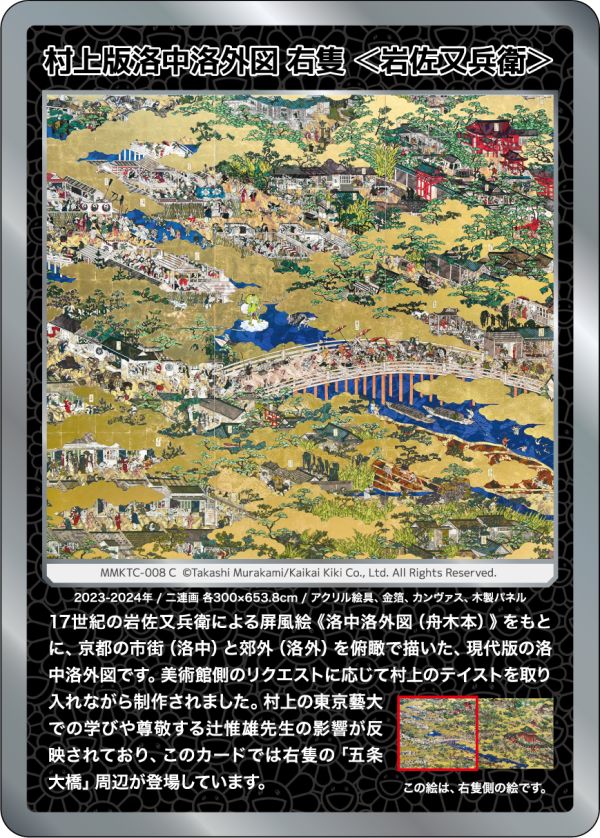

Based on the 17th century screen painting "Rakuchū-rakugai-zu Byōbu (Funaki version)" by Iwasa Matabei, this is a contemporary version of "scenes in and around Kyoto" depicting the city (Rakuchū) and suburbs (Rakugai) of ancient Kyoto from a bird's eye view. It was produced in response to the museum's request, incorporating a taste of Murakami. The work reflects Murakami's studies at Tokyo University of the Arts and the influence of the mentor he reveres, Nobuo Tsuji. On this card, you can see the area around Gojō Ōhashi Bridge depicted on the right screen.
2023-2024 / Diptych, each 300 x 653.8 cm / Acrylic and gold leaf on canvas mounted on wood panel
This section is on the right screen.
17世紀の岩佐又兵衛による屏風絵《洛中洛外図(舟木本)》をもとに、京都の市街(洛中)と郊外(洛外)を俯瞰で描いた、現代版の洛中洛外図です。美術館側のリクエストに応じて村上のテイストを取り入れながら制作されました。村上の東京藝大での学びや尊敬する辻惟雄先生の影響が反映されており、このカードでは右隻の「五条大橋」周辺が登場しています。
2023-2024年 / 二連画 各300×653.8cm / アクリル絵具、金箔、カンヴァス、木製パネル
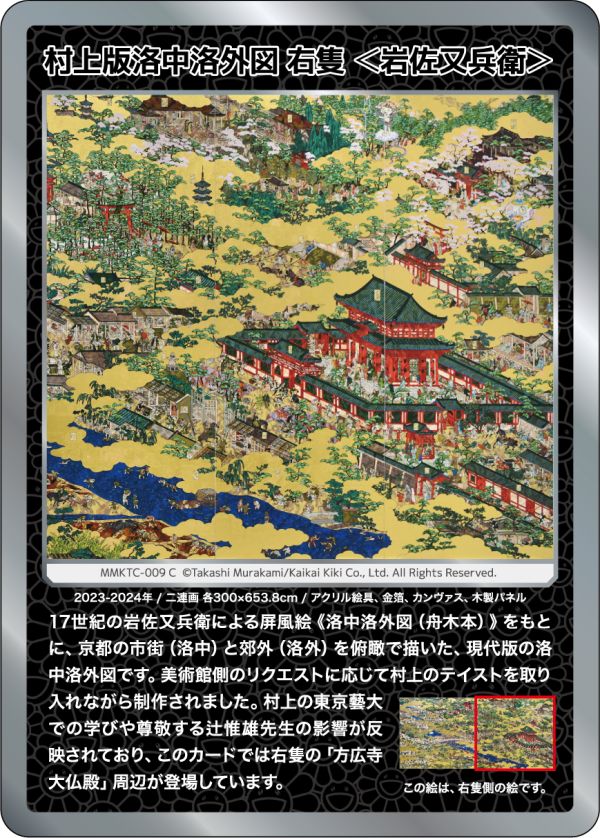

Based on the 17th century screen painting "Rakuchū-rakugai-zu Byōbu (Funaki version)" by Iwasa Matabei, this is a contemporary version of "scenes in and around Kyoto" depicting the city (Rakuchū) and suburbs (Rakugai) of ancient Kyoto from a bird's eye view. It was produced in response to the museum's request, incorporating a taste of Murakami. The work reflects Murakami's studies at Tokyo University of the Arts and the influence of the mentor he reveres, Nobuo Tsuji. On this card, you can see the area around the Great Buddha Hall of Hōkō-ji Temple depicted on the right screen.
2023-2024 / Diptych, each 300 x 653.8 cm / Acrylic and gold leaf on canvas mounted on wood panel
This section is on the right screen.
17世紀の岩佐又兵衛による屏風絵《洛中洛外図(舟木本)》をもとに、京都の市街(洛中)と郊外(洛外)を俯瞰で描いた、現代版の洛中洛外図です。美術館側のリクエストに応じて村上のテイストを取り入れながら制作されました。村上の東京藝大での学びや尊敬する辻惟雄先生の影響が反映されており、このカードでは右隻の「方広寺大仏殿」周辺が登場しています。
2023-2024年 / 二連画 各300×653.8cm / アクリル絵具、金箔、カンヴァス、木製パネル
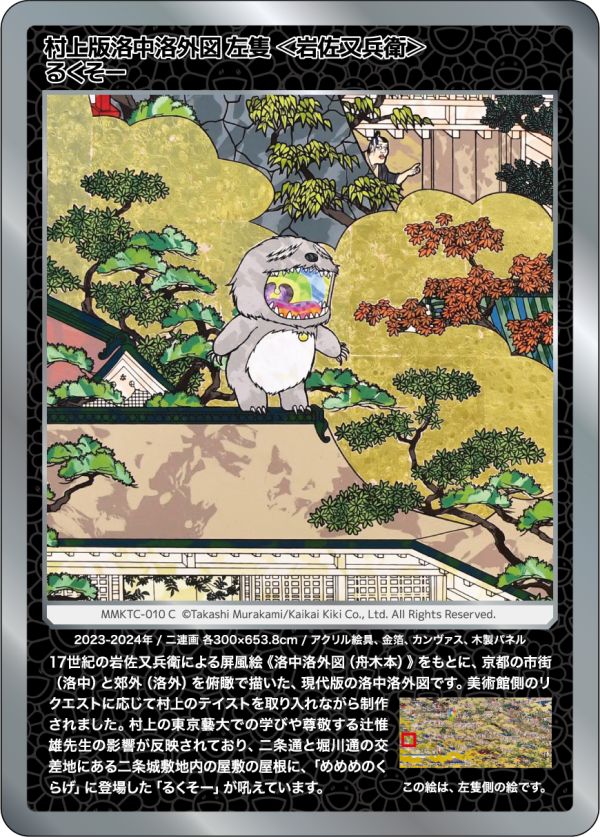

Based on the 17th century screen painting "Rakuchū-rakugai-zu Byōbu (Funaki version)" by Iwasa Matabei, this is a contemporary version of "scenes in and around Kyoto" depicting the city (Rakuchū) and suburbs (Rakugai) of ancient Kyoto from a bird's eye view. It was produced in response to the museum's request, incorporating a taste of Murakami. The work reflects Murakami's studies at Tokyo University of the Arts and the influence of the mentor he reveres, Nobuo Tsuji. Here, the character Luxor from the film Jellyfish Eyes is roaring on the roof of a house on the Nijō Castle grounds at the intersection of Nijō and Horikawa Streets.
2023-2024 / Diptych, each 300 x 653.8 cm / Acrylic and gold leaf on canvas mounted on wood panel
17世紀の岩佐又兵衛による屏風絵《洛中洛外図(舟木本)》をもとに、京都の市街(洛中)と郊外(洛外)を俯瞰で描いた、現代版の洛中洛外図です。美術館側のリクエストに応じて村上のテイストを取り入れながら制作されました。村上の東京藝大での学びや尊敬する辻惟雄先生の影響が反映されており、二条通と堀川通の交差地にある二条城敷地内の屋敷の屋根に、「めめめのくらげ」に登場した「るくそー」が吼えています。
2023-2024年 / 二連画 各300×653.8cm / アクリル絵具、金箔、カンヴァス、木製パネル
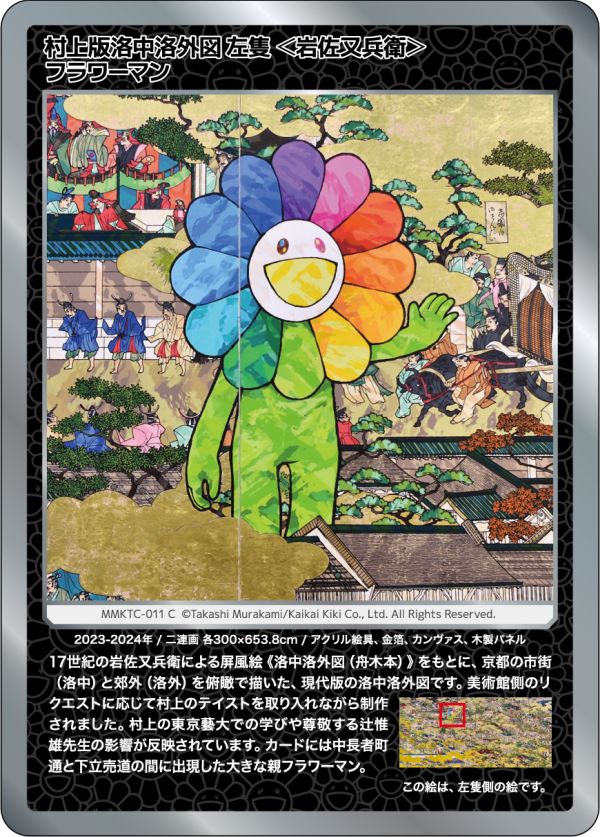

Based on the 17th century screen painting "Rakuchū-rakugai-zu Byōbu (Funaki version)" by Iwasa Matabei, this is a contemporary version of "scenes in and around Kyoto" depicting the city (Rakuchū) and suburbs (Rakugai) of ancient Kyoto from a bird's eye view. It was produced in response to the museum's request, incorporating a taste of Murakami. The work reflects Murakami's studies at Tokyo University of the Arts and the influence of the mentor he reveres, Nobuo Tsuji. On the card is a large parent Flowerman appearing between Nakachōja-machi and Shimodachiuri Streets.
2023-2024 / Diptych, each 300 x 653.8 cm / Acrylic and gold leaf on canvas mounted on wood panel
This section is on the left screen.
17世紀の岩佐又兵衛による屏風絵《洛中洛外図(舟木本)》をもとに、京都の市街(洛中)と郊外(洛外)を俯瞰で描いた、現代版の洛中洛外図です。美術館側のリクエストに応じて村上のテイストを取り入れながら制作されました。村上の東京藝大での学びや尊敬する辻惟雄先生の影響が反映されています。カードには中長者町通と下立売道の間に出現した大きな親フラワーマン。
2023-2024年 / 二連画 各300×653.8cm / アクリル絵具、金箔、カンヴァス、木製パネル
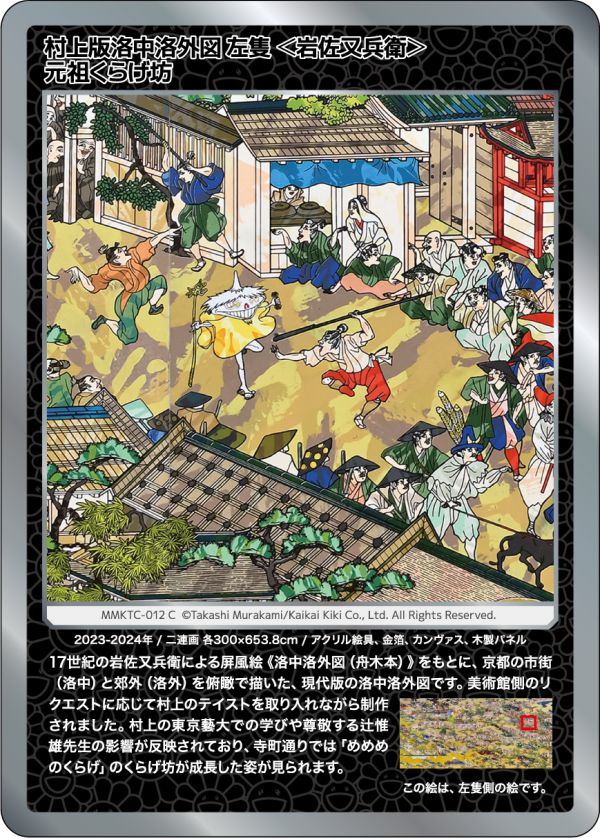

Based on the 17th century screen painting "Rakuchū-rakugai-zu Byōbu (Funaki version)" by Iwasa Matabei, this is a contemporary version of "scenes in and around Kyoto" depicting the city (Rakuchū) and suburbs (Rakugai) of ancient Kyoto from a bird's eye view. It was produced in response to the museum's request, incorporating a taste of Murakami. The work reflects Murakami's studies at Tokyo University of the Arts and the influence of the mentor he reveres, Nobuo Tsuji. The grown-up version of Kurage-bo from Jellyfish Eyes can be seen on Teramachi Street.
2023-2024 / Diptych, each 300 x 653.8 cm / Acrylic and gold leaf on canvas mounted on wood panel
This section is on the left screen.
17世紀の岩佐又兵衛による屏風絵《洛中洛外図(舟木本)》をもとに、京都の市街(洛中)と郊外(洛外)を俯瞰で描いた、現代版の洛中洛外図です。美術館側のリクエストに応じて村上のテイストを取り入れながら制作されました。村上の東京藝大での学びや尊敬する辻惟雄先生の影響が反映されており、寺町通りでは「めめめのくらげ」のくらげ坊が成長した姿が見られます。
2023-2024年 / 二連画 各300×653.8cm / アクリル絵具、金箔、カンヴァス、木製パネル
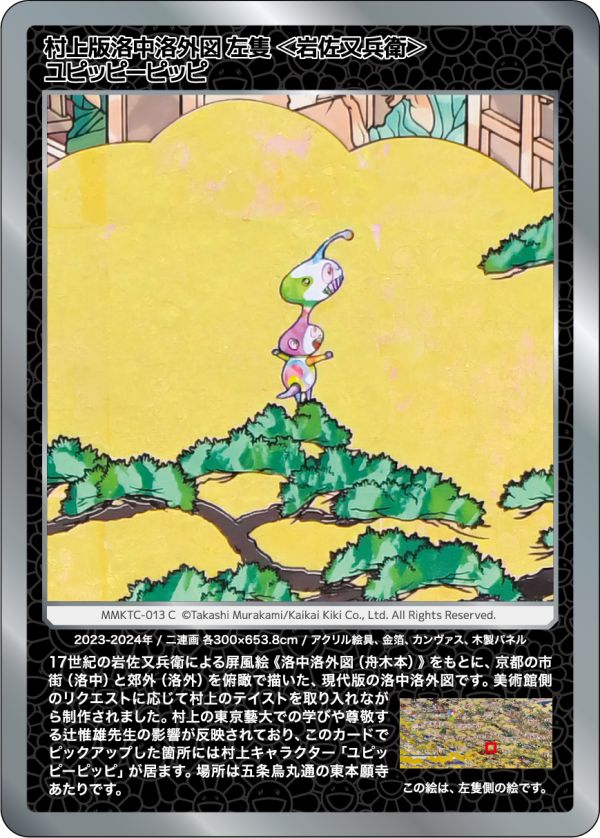

Based on the 17th century screen painting "Rakuchū-rakugai-zu Byōbu (Funaki version)" by Iwasa Matabei, this is a contemporary version of "scenes in and around Kyoto" depicting the city (Rakuchū) and suburbs (Rakugai) of ancient Kyoto from a bird's eye view. It was produced in response to the museum's request, incorporating a taste of Murakami. The work reflects Murakami's studies at Tokyo University of the Arts and the influence of the mentor he reveres, Nobuo Tsuji. In the section selected for this card, you can see a Murakami character Yupippy-pippi depicted around Higashi Honganji Temple on Gojō Karasuma Street.
2023-2024 / Diptych, each 300 x 653.8 cm / Acrylic and gold leaf on canvas mounted on wood panel
This section is on the right screen.
17世紀の岩佐又兵衛による屏風絵《洛中洛外図(舟木本)》をもとに、京都の市街(洛中)と郊外(洛外)を俯瞰で描いた、現代版の洛中洛外図です。美術館側のリクエストに応じて村上のテイストを取り入れながら制作されました。村上の東京藝大での学びや尊敬する辻惟雄先生の影響が反映されており、このカードでピックアップした箇所には村上キャラクター「ユピッピーピッピ」が居ます。場所は五条烏丸通の東本願寺あたりです。
2023-2024年 / 二連画 各300×653.8cm / アクリル絵具、金箔、カンヴァス、木製パネル
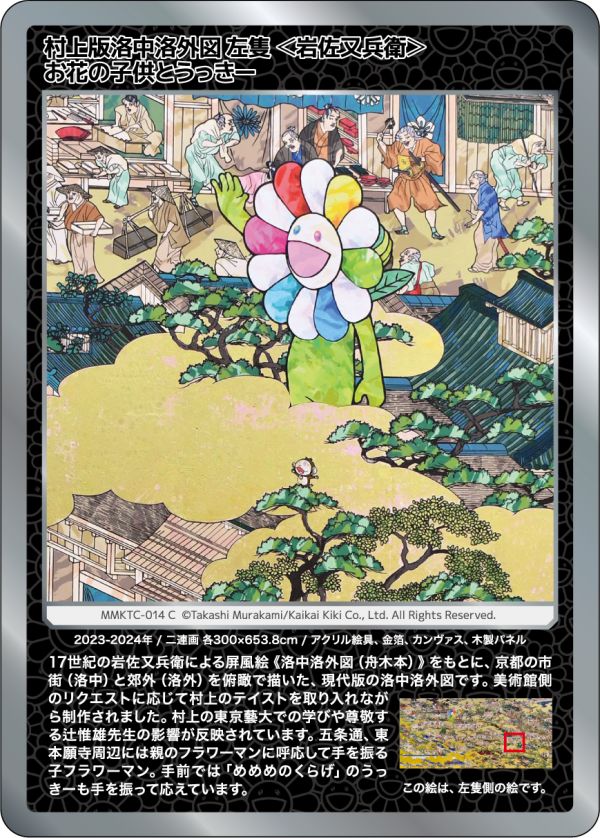

Based on the 17th century screen painting "Rakuchū-rakugai-zu Byōbu (Funaki version)" by Iwasa Matabei, this is a contemporary version of "scenes in and around Kyoto" depicting the city (Rakuchū) and suburbs (Rakugai) of ancient Kyoto from a bird's eye view. It was produced in response to the museum's request, incorporating a taste of Murakami. The work reflects Murakami's studies at Tokyo University of the Arts and the influence of the mentor he reveres, Nobuo Tsuji. Around Higashi Hongan-ji Temple on Gojō Street, Flower Child waves its hand in response to the Flower Parent. In the foreground, Ukki, a character from Jellyfish Eyes, is also waving in response.
2023-2024 / Diptych, each 300 x 653.8 cm / Acrylic and gold leaf on canvas mounted on wood panel
This section is on the left screen.
17世紀の岩佐又兵衛による屏風絵《洛中洛外図(舟木本)》をもとに、京都の市街(洛中)と郊外(洛外)を俯瞰で描いた、現代版の洛中洛外図です。美術館側のリクエストに応じて村上のテイストを取り入れながら制作されました。村上の東京藝大での学びや尊敬する辻惟雄先生の影響が反映されています。五条通、東本願寺周辺には親のフラワーマンに呼応して手を振る子フラワーマン。手前では「めめめのくらげ」のうっきーも手を振って応えています。
2023-2024年 / 二連画 各300×653.8cm / アクリル絵具、金箔、カンヴァス、木製パネル
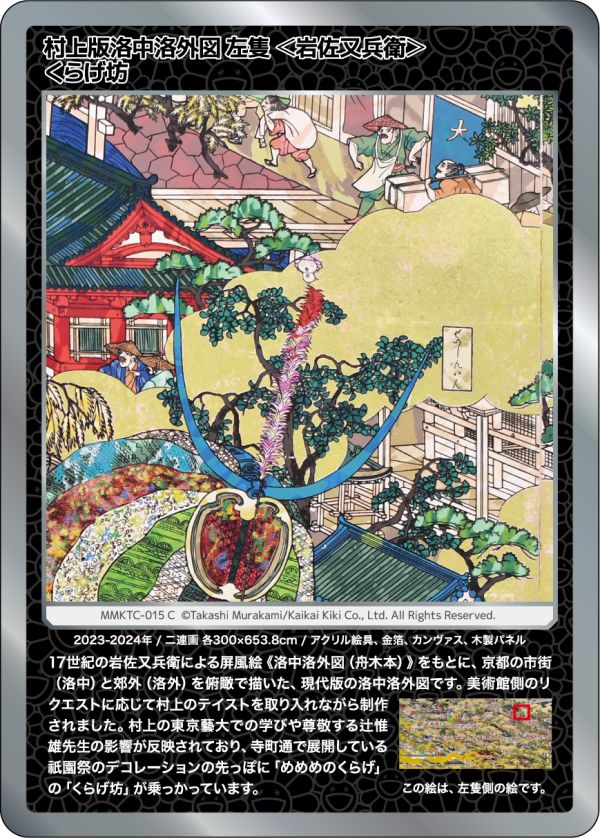

Based on the 17th century screen painting "Rakuchū-rakugai-zu Byōbu (Funaki version)" by Iwasa Matabei, this is a contemporary version of "scenes in and around Kyoto" depicting the city (Rakuchū) and suburbs (Rakugai) of ancient Kyoto from a bird's eye view. It was produced in response to the museum's request, incorporating a taste of Murakami. The work reflects Murakami's studies at Tokyo University of the Arts and the influence of the mentor he reveres, Nobuo Tsuji. Here, you can see the character Kurage-bo from the film Jellyfish Eyes perched on the very tip of the decoration of Gion Festival that is happening on Teramachi Street.
2023-2024 / Diptych, each 300 x 653.8 cm / Acrylic and gold leaf on canvas mounted on wood panel
This section is on the left screen.
17世紀の岩佐又兵衛による屏風絵《洛中洛外図(舟木本)》をもとに、京都の市街(洛中)と郊外(洛外)を俯瞰で描いた、現代版の洛中洛外図です。美術館側のリクエストに応じて村上のテイストを取り入れながら制作されました。村上の東京藝大での学びや尊敬する辻惟雄先生の影響が反映されており、寺町通で展開している祇園祭のデコレーションの先っぽに「めめめのくらげ」の「くらげ坊」が乗っかっています。
2023-2024年 / 二連画 各300×653.8cm / アクリル絵具、金箔、カンヴァス、木製パネル
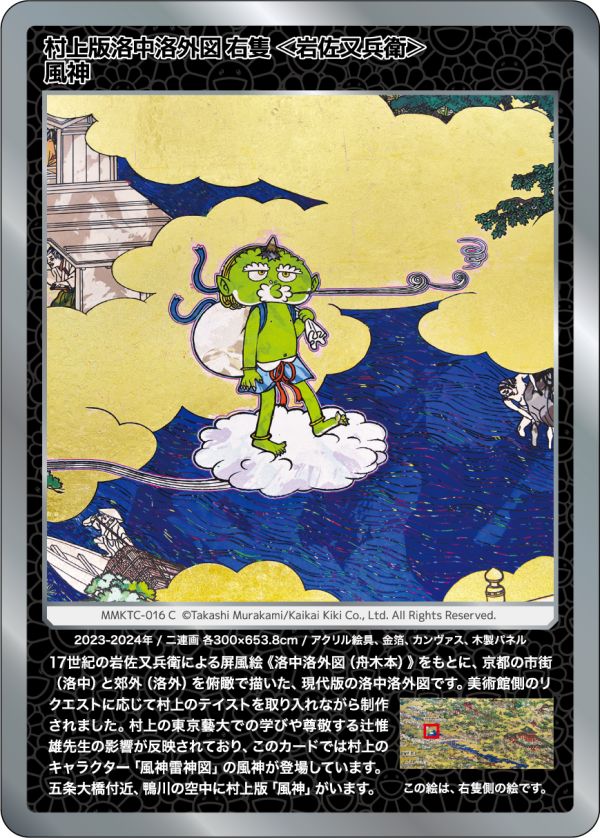

Based on the 17th century screen painting "Rakuchū-rakugai-zu Byōbu (Funaki version)" by Iwasa Matabei, this is a contemporary version of "scenes in and around Kyoto" depicting the city (Rakuchū) and suburbs (Rakugai) of ancient Kyoto from a bird's eye view. It was produced in response to the museum's request, incorporating a taste of Murakami. The work reflects Murakami's studies at Tokyo University of the Arts and the influence of the mentor he reveres, Nobuo Tsuji. In this card, Murakami's version of the Wind God, of the Wind and Thunder Gods, can be spotted in the air above the Kamo River near the Gojō Ōhashi Bridge.
2023-2024 / Diptych, each 300 x 653.8 cm / Acrylic, gold leaf, and platinum leaf on canvas mounted on wood panel
This section is on the right screen.
17世紀の岩佐又兵衛による屏風絵《洛中洛外図(舟木本)》をもとに、京都の市街(洛中)と郊外(洛外)を俯瞰で描いた、現代版の洛中洛外図です。美術館側のリクエストに応じて村上のテイストを取り入れながら制作されました。村上の東京藝大での学びや尊敬する辻惟雄先生の影響が反映されており、このカードでは村上のキャラクター「風神雷神図」の風神が登場しています。五条大橋付近、鴨川の空中に村上版「風神」がいます。
2023-2024年 / 二連画 各300×653.8cm / アクリル絵具、金箔、カンヴァス、木製パネル
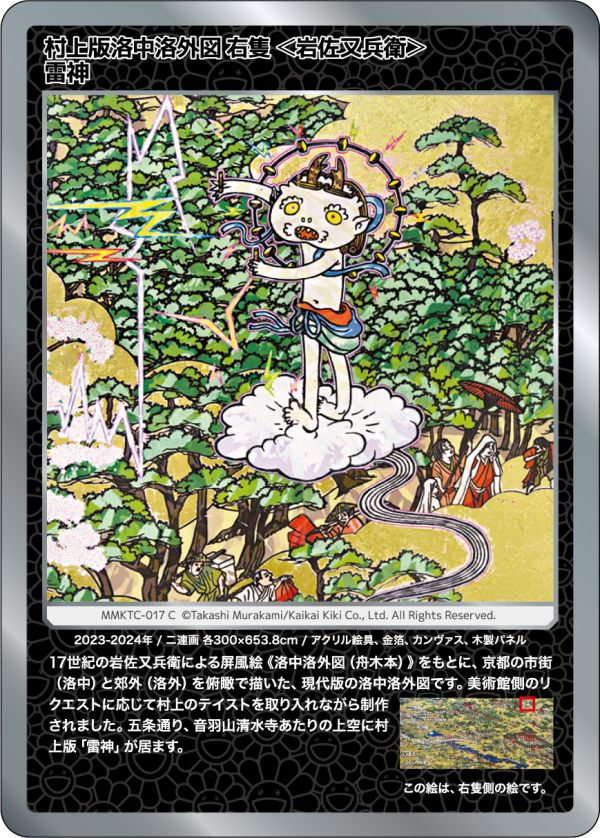

Based on the 17th century screen painting "Rakuchū-rakugai-zu Byōbu (Funaki version)" by Iwasa Matabei, this is a contemporary version of "scenes in and around Kyoto" depicting the city (Rakuchū) and suburbs (Rakugai) of ancient Kyoto from a bird's eye view. It was produced in response to the museum's request, incorporating a taste of Murakami. His version of the Thunder God can be spotted in the air above the Mt. Otowa Kiyomizu Temple on Gojō Street.
2023-2024 / Diptych, each 300 x 653.8 cm / Acrylic and gold leaf on canvas mounted on wood panel
This section is on the right screen.
17世紀の岩佐又兵衛による屏風絵《洛中洛外図(舟木本)》をもとに、京都の市街(洛中)と郊外(洛外)を俯瞰で描いた、現代版の洛中洛外図です。美術館側のリクエストに応じて村上のテイストを取り入れながら制作されました。五条通り、音羽山清水寺あたりの上空に村上版「雷神」が居ます。
2023-2024年 / 二連画 各300×653.8cm / アクリル絵具、金箔、カンヴァス、木製パネル
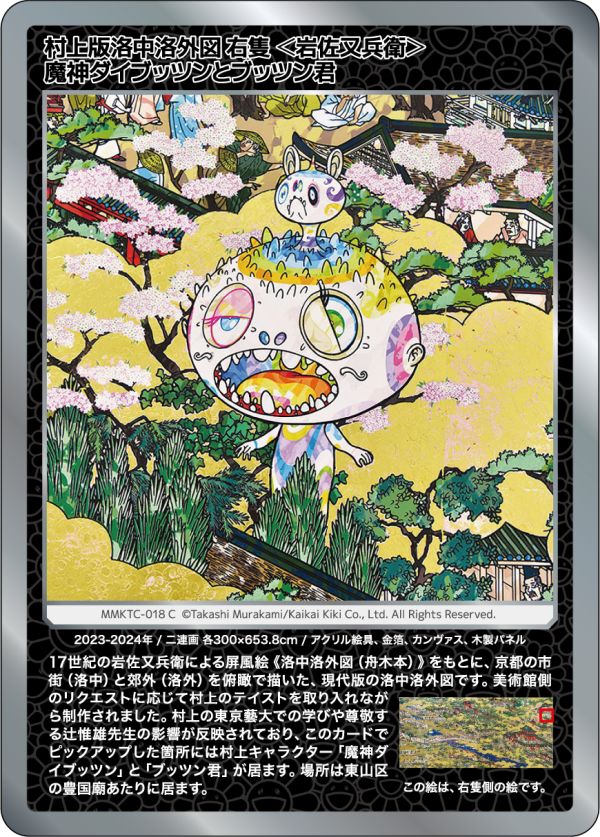

Based on the 17th century screen painting "Rakuchū-rakugai-zu Byōbu (Funaki version)" by Iwasa Matabei, this is a contemporary version of "scenes in and around Kyoto" depicting the city (Rakuchū) and suburbs (Rakugai) of ancient Kyoto from a bird's eye view. It was produced in response to the museum's request, incorporating a taste of Murakami. The work reflects Murakami's studies at Tokyo University of the Arts and the influence of the mentor he reveres, Nobuo Tsuji. In the section selected for this card, you can see Murakami characters Majin Daibuttsun and Mr. Buttsun depicted around Hōkokubyō in Higashiyama-ku.
2023-2024 / Diptych, each 300 x 653.8 cm / Acrylic and gold leaf on canvas mounted on wood panel
This section is on the right screen.
17世紀の岩佐又兵衛による屏風絵《洛中洛外図(舟木本)》をもとに、京都の市街(洛中)と郊外(洛外)を俯瞰で描いた、現代版の洛中洛外図です。美術館側のリクエストに応じて村上のテイストを取り入れながら制作されました。村上の東京藝大での学びや尊敬する辻惟雄先生の影響が反映されており、このカードでピックアップした箇所には村上キャラクター「魔神ダイブッツン」と「ブッツン君」が居ます。場所は東山区の豊国廟あたりに居ます。
2023-2024年 / 二連画 各300×653.8cm / アクリル絵具、金箔、カンヴァス、木製パネル
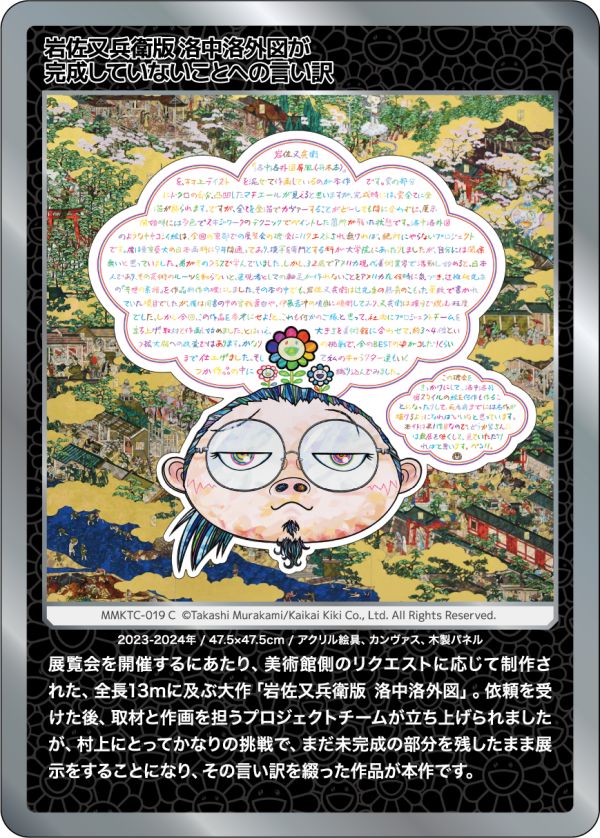

The 13-meter-long painting, "Rakuchū-Rakugai-zu Byōbu: Iwasa Matabei RIP", was created in response to a request from the museum for this exhibition. After receiving the request, Murakami set up a project team to research and design the work, but it was quite a challenge for the artist and he had to exhibit the work with some parts still unfinished. This work spells out his excuses for doing so.
2023-2024 / 47.5 x 47.5 cm / Acrylic on canvas mounted on wood panel
展覧会を開催するにあたり、美術館側のリクエストに応じて制作された、全長13mに及ぶ大作「岩佐又兵衛版 洛中洛外図」。依頼を受けた後、取材と作画を担うプロジェクトチームが立ち上げられましたが、村上にとってかなりの挑戦で、まだ未完成の部分を残したまま展示をすることになり、その言い訳を綴った作品が本作です。
2023-2024年 / 47.5×47.5cm / アクリル絵具、カンヴァス、木製パネル
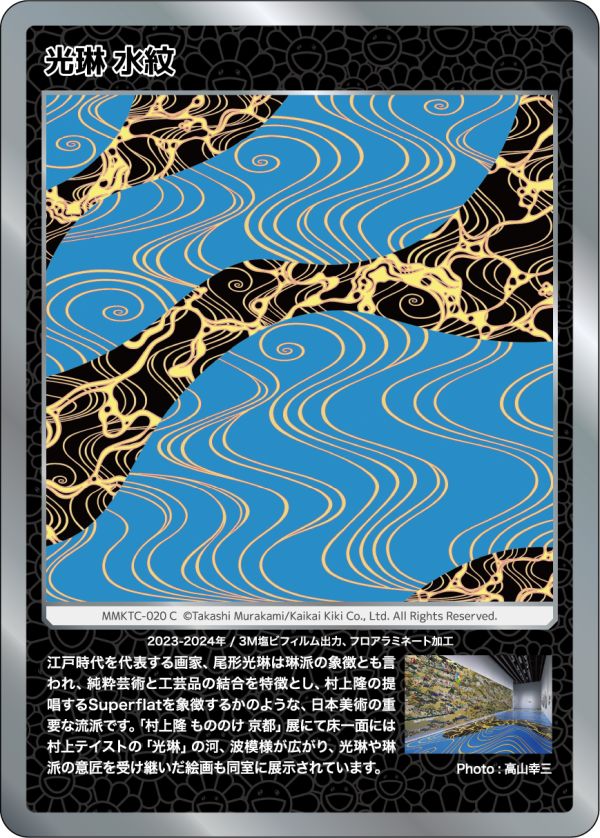

Ogata Kōrin, one of the foremost painters of the Edo period, is considered to be the symbol of the Rimpa school of Japanese art. This important school is characterized by its combination of pure art and craftsmanship, as though embodying the Superflat theory that Takashi Murakami has been advocating. At the Takashi Murakami Mononoke Kyoto exhibition, the floor of a room is covered with Kōrin river and wave patterns in Murakami flavor, and paintings drawing on Kōrin and the Rimpa school designs are also displayed in the same room.
2023-2024 / 3M vinyl chloride film printout, floor laminate
Photo : Kozo Takayama
江戸時代を代表する画家、尾形光琳は琳派の象徴とも言われ、純粋芸術と工芸品の結合を特徴とし、村上隆の提唱するSuperflatを象徴するかのような、日本美術の重要な流派です。「村上隆 もののけ 京都」展にて床一面には村上テイストの「光琳」の河、波模様が広がり、光琳や琳派の意匠を受け継いだ絵画も同室に展示されています。
2023-2024年 / 3M塩ビフィルム出力、フロアラミネート加工
Photo : 高山幸三
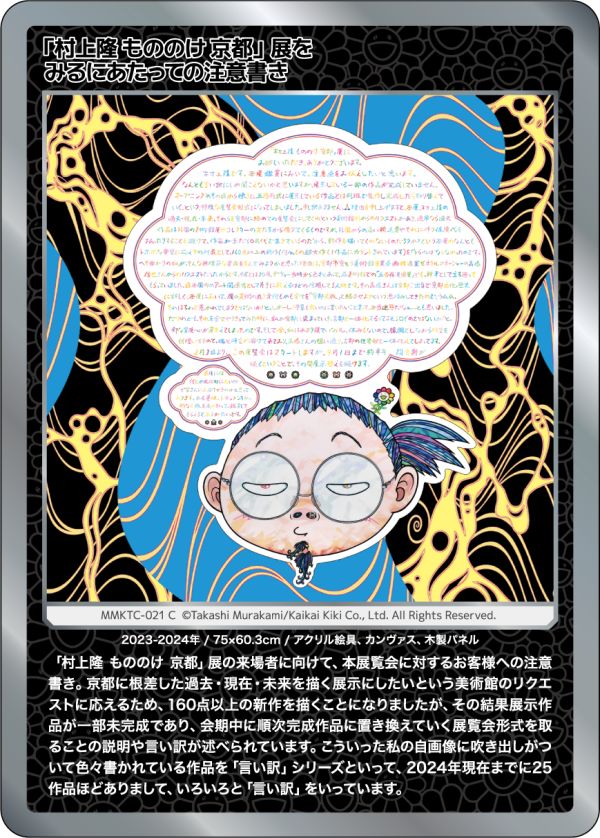

This is a note to visitors to the Takashi Murakami Mononoke Kyoto exhibition about the show they are about to see. In order to meet the museum's request for an exhibition that depicts the past, present, and future rooted in Kyoto, Murakami was asked to create more than 160 new works. As a result, some of the exhibited works are incomplete and, in this painting, the artist provides explanations and excuses for the exhibition format in which they will be replaced with completed works on a rolling basis during the exhibition period. These self-portrait paintings with speech bubbles on them are called the "Excuse Painting" series and, as of 2024, there are about 25 of them, in which Murakami has made various excuses.
2023-2024 / 75 x 60.3 cm /Acrylic on canvas mounted on wood panel
「村上隆 もののけ 京都」展の来場者に向けて、本展覧会に対するお客様への注意書き。京都に根差した過去・現在・未来を描く展示にしたいという美術館のリクエストに応えるため、160点以上の新作を描くことになりましたが、その結果展示作品が一部未完成であり、会期中に順次完成作品に置き換えていく展覧会形式を取ることの説明や言い訳が述べられています。こういった私の自画像に吹き出しがついて色々書かれている作品を「言い訳」シリーズといって、2024年現在までに25作品ほどありまして、いろいろと「言い訳」をいっています。
2023-2024年 / 75×60.3cm / アクリル絵具、カンヴァス、木製パネル
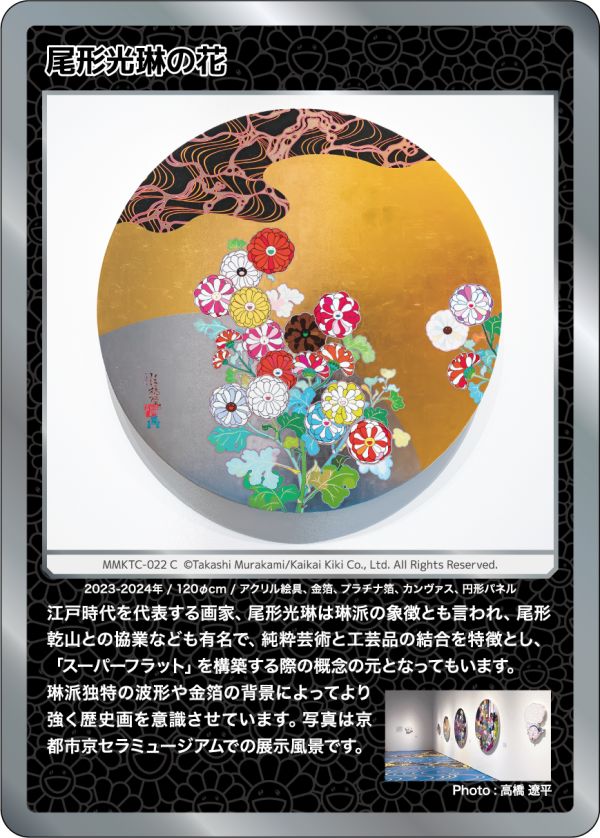

Ogata Kōrin, one of the best-known painters of the Edo period, is considered the emblem of the Rinpa school, and his collaborations with Ogata Kenzan are also well known. His work is characterized by its integration of pure art and craft, which served as the conceptual source for Murakami in constructing the Superflat theory.
With the use of the wave patterns and gilded background unique to the Rinpa style, Murakami manages to strongly evoke historical paintings in this work. The image is the installation shot from the Kyoo City KYOCERA Museum of Art.
2024 / φ120 cm / Acrylic, gold leaf, and platinum leaf on canvas mounted on wood panel
江戸時代を代表する画家、尾形光琳は琳派の象徴とも言われ、尾形乾山との協業なども有名で、純粋芸術と工芸品の結合を特徴とし、「スーパーフラット」を構築する際の概念の元となってもいます。
琳派独特の波形や金箔の背景によってより強く歴史画を意識させています。写真は京都市京セラミュージアムでの展示風景です。
2023-2024年 / 120φcm / アクリル絵具、金箔、プラチナ箔、カンヴァス、円形パネル
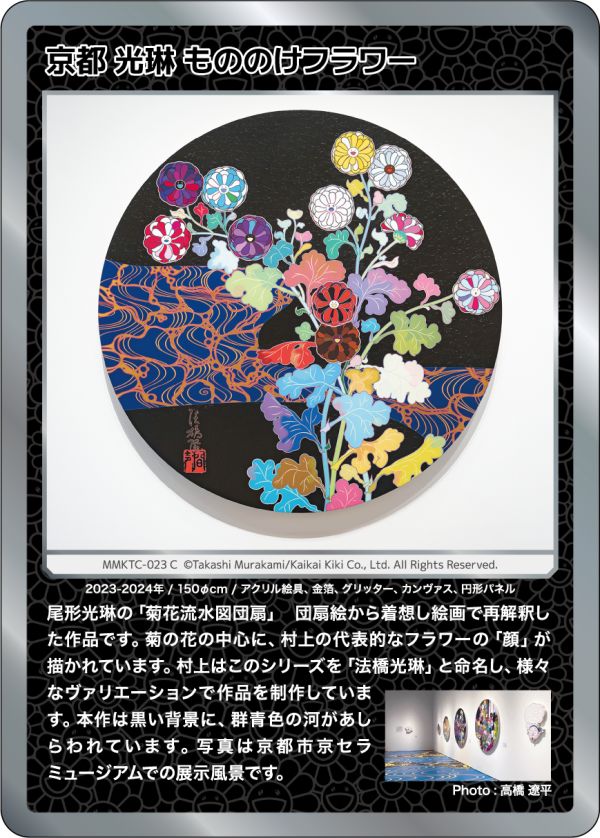

Inspired by Ogata Kōrin's "Chrysanthemum and Flowing Water" uchiwa fan, Murakami reinterpreted it as a painting. At the center, each chrysanthemum is adorned with Murakami's signature Flower face. Murakami named this series "Hokkyō Kōrin" and has been creating works in many variations. This work has a black background with an indigo river. The image is the installation shot from the Kyoo City KYOCERA Museum of Art.
2024 / φ150 cm / Acrylic, gold leaf, and glitter on canvas mounted on wood panel
尾形光琳の「菊花流水図団扇」 団扇絵から着想し絵画で再解釈した作品です。菊の花の中心に、村上の代表的なフラワーの「顔」が描かれています。村上はこのシリーズを「法橋光琳」と命名し、様々なヴァリエーションで作品を制作しています。本作は黒い背景に、群青色の河があしらわれています。写真は京都市京セラミュージアムでの展示風景です。
2023-2024年 / 150φcm / アクリル絵具、金箔、グリッター、カンヴァス、円形パネル
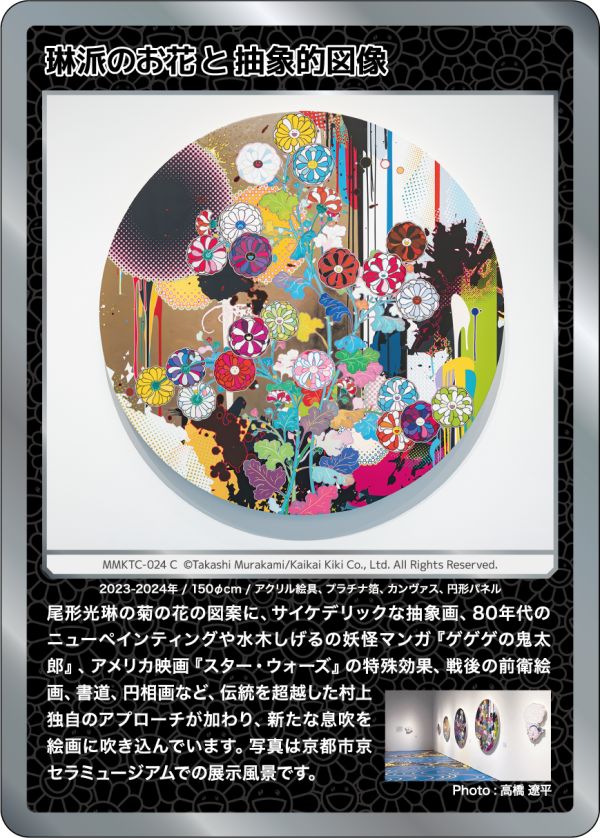

Murakami's unique approach transcends tradition and breathes new life into Ogata Kōrin's chrysanthemum design, with added elements from resources such as psychedelic abstraction, 1980s’ Neo-Expressionism, Shigeru Mizuki's yōkai manga Gegege no Kitarō, special effects of the American film Star Wars, postwar avant-garde painting, calligraphy, and ensō paintings. The image is the installation shot from the Kyoo City KYOCERA Museum of Art.
2024 / φ150 cm / Acrylic, and platinum leaf on canvas mounted on wood panel
尾形光琳の菊の花の図案に、サイケデリックな抽象画、80年代のニューペインティングや水木しげるの妖怪マンガ『ゲゲゲの鬼太郎』、アメリカ映画『スター・ウォーズ』の特殊効果、戦後の前衛絵画、書道、円相画など、伝統を超越した村上独自のアプローチが加わり、新たな息吹を絵画に吹き込んでいます。写真は京都市京セラミュージアムでの展示風景です。
2023-2024年 / 150φcm / アクリル絵具、プラチナ箔、カンヴァス、円形パネル
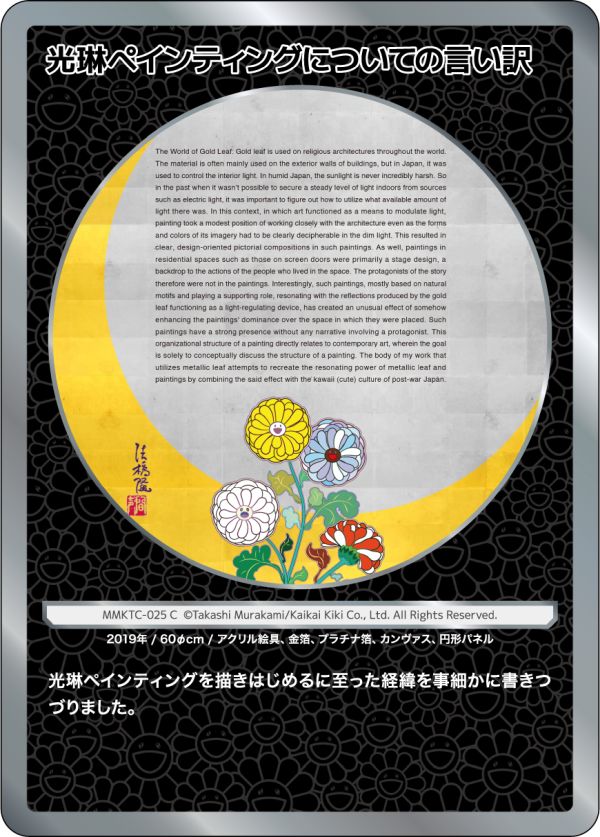

In this painting, Murakami explains in detail how he came to paint his Kōrin paintings.
2019 / φ 60 cm / Acrylic, gold leaf, and platinum leaf on canvas mounted on wood panel
光琳ペインティングを描きはじめるに至った経緯を事細かに書きつづりました。
2019年 / 60φcm / アクリル絵具、金箔、プラチナ箔、
カンヴァス、円形パネル
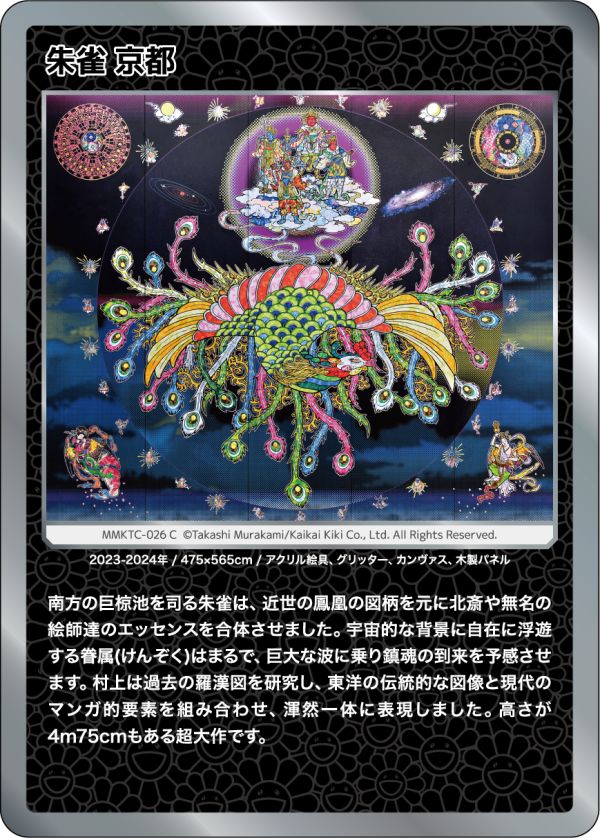

The painting of the Vermillion Bird, which presides over the Ogura Pond which used to exist south of Kyoto, combines the essence of works by Hokusai and other unknown painters with an early modern design of the phoenix as its basis. Floating freely on a cosmic background, the mystic bird seems to be riding a giant wave, foreshadowing the repose of the souls. Murakami has studied the Arhat images of the past and combined traditional Eastern iconography with contemporary manga elements to express a unified whole. It is a very large work measuring 4m 75cm in height.
2023-2024 / 475 x 565 cm / Acrylic and glitter on canvas mounted on wood panel
南方の巨椋池を司る朱雀は、近世の鳳凰の図柄を元に北斎や無名の絵師達のエッセンスを合体させました。宇宙的な背景に自在に浮遊する眷属(けんぞく)はまるで、巨大な波に乗り鎮魂の到来を予感させます。村上は過去の羅漢図を研究し、東洋の伝統的な図像と現代のマンガ的要素を組み合わせ、渾然一体に表現しました。高さが4m75cmもある超大作です。
2023-2024年 / 475×565cm / アクリル絵具、グリッター、カンヴァス、木製パネル
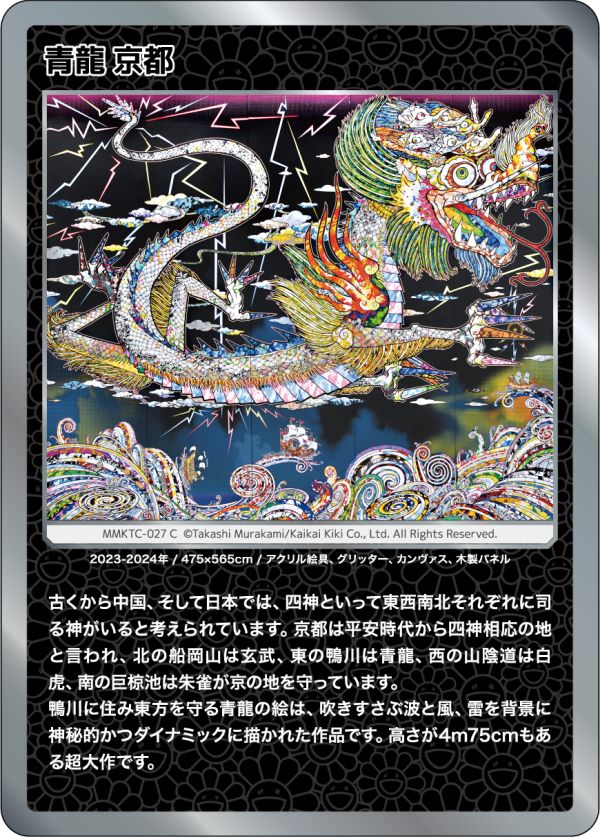

Since ancient times in China and subsequently in Japan, there has been a concept of Four Symbols, or four deities, each of whom presides over a cardinal direction. Kyoto has been considered geographically ideal for Four Symbols since the Heian period (794-1185), with Mt. Funaoka in the north as the Black Tortoise, the Kamo River in the east as the Blue Dragon, the San'in Road in the west as the White Tiger, and the Ogura Pond, which used to be in the south, as the Vermilion Bird guarding it.
The painting of the Blue Dragon, which lives in the Kamo River and protects the east, is a mysterious and dynamic work set against a background of raging waves, wind, and thunder. It is a very large work measuring 4m 75cm in height.
2023-2024 / 475 x 565 cm / Acrylic and glitter on canvas mounted on wood panel
古くから中国、そして日本では、四神といって東西南北それぞれに司る神がいると考えられています。京都は平安時代から四神相応の地と言われ、北の船岡山は玄武、東の鴨川は青龍、西の山陰道は白虎、南の巨椋池は朱雀が京の地を守っています。
鴨川に住み東方を守る青龍の絵は、吹きすさぶ波と風、雷を背景に神秘的かつダイナミックに描かれた作品です。高さが4m75cmもある超大作です。
2023-2024年 / 475×565cm / アクリル絵具、グリッター、カンヴァス、木製パネル
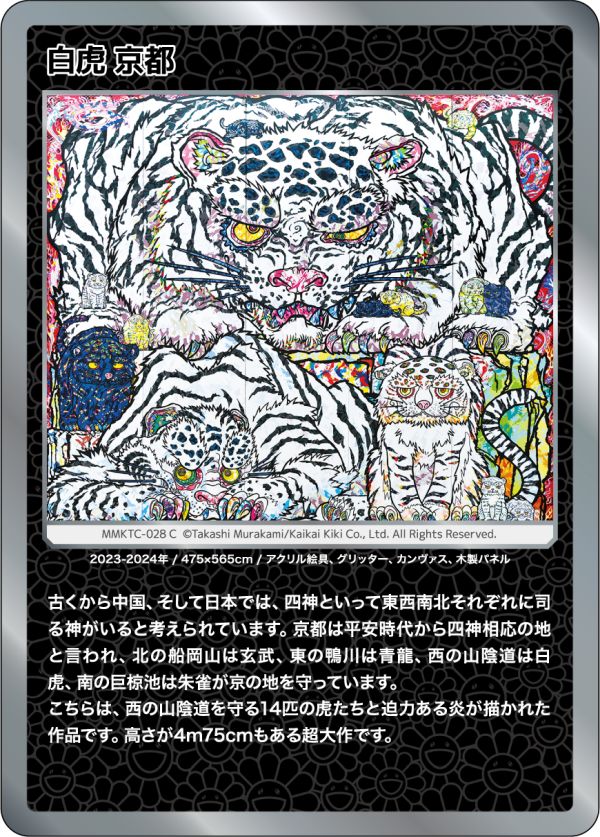

Since ancient times in China and subsequently in Japan, there has been a concept of Four Symbols, or four deities, each of whom presides over a cardinal direction. Kyoto has been considered geographically ideal for Four Symbols since the Heian period (794-1185), with Mt. Funaoka in the north as the Black Tortoise, the Kamo River in the east as the Blue Dragon, the San'in Road in the west as the White Tiger, and the Ogura Pond, which used to be in the south, as the Vermilion Bird guarding it.
This work depicts 14 tigers guarding the San'in Road in the west and a powerful flame. It is a very large work measuring 4m 75cm in height.
2023-2024 / 475 x 565 cm / Acrylic and glitter on canvas mounted on wood panel
古くから中国、そして日本では、四神といって東西南北それぞれに司る神がいると考えられています。京都は平安時代から四神相応の地と言われ、北の船岡山は玄武、東の鴨川は青龍、西の山陰道は白虎、南の巨椋池は朱雀が京の地を守っています。
こちらは、西の山陰道を守る14匹の虎たちと迫力ある炎が描かれた作品です。高さが4m75cmもある超大作です。
2023-2024年 / 475×565cm / アクリル絵具、グリッター、カンヴァス、木製パネル
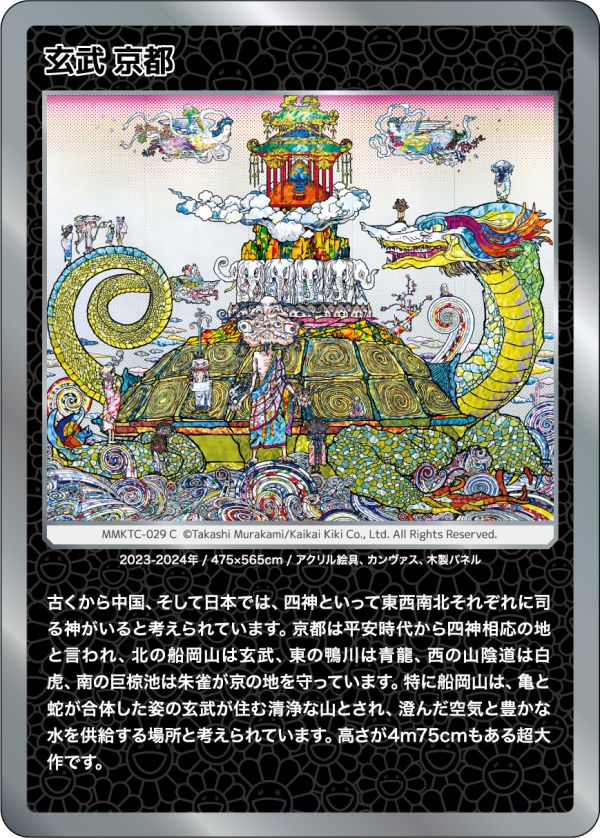

Since ancient times in China and subsequently in Japan, there has been a concept of Four Symbols, or four deities, each of whom presides over a cardinal direction. Kyoto has been considered geographically ideal for Four Symbols since the Heian period (794-1185), with Mt. Funaoka in the north as the Black Tortoise, the Kamo River in the east as the Blue Dragon, the San'in Road in the west as the White Tiger, and the Ogura Pond, which used to be in the south, as the Vermilion Bird guarding it.
In particular, Mt. Funaoka is considered to be a pure mountain where Genbu, which has the appearance of a turtle and snake combined, resides, supplying clean air and abundant water. It is a very large work measuring 4m 75cm in height.
2023-2024 / 475 x 565 cm / Acrylic on canvas mounted on wood panel
古くから中国、そして日本では、四神といって東西南北それぞれに司る神がいると考えられています。京都は平安時代から四神相応の地と言われ、北の船岡山は玄武、東の鴨川は青龍、西の山陰道は白虎、南の巨椋池は朱雀が京の地を守っています。特に船岡山は、亀と蛇が合体した姿の玄武が住む清浄な山とされ、澄んだ空気と豊かな水を供給する場所と考えられています。高さが4m75cmもある超大作です。
2023-2024年 / 475×565cm / アクリル絵具、カンヴァス、木製パネル


At the center of the exhibition's Four Symbols room is a delicate three-dimensional work, Hexagonal Double-Helix Tower, which symbolizes a temple complex. The actual Rokkakudo (Nakagyo-ku, Kyoto), known as the "navel of Kyoto," is also known as the birthplace of ikebana flower arrangement, and its bell tower is said to have served as a warning for earthquakes, typhoons, infectious diseases, and other abnormal events in Kyoto. This work combines the temple with the design of Sazae-do, another temple in Fukushima Prefecture.
2023-2024 / Height 495 cm, pillar φ 93.8 cm, roof φ 337.5 cm / Water-based paint, Styrofoam, and wood
展覧会の「四神の部屋」の中央には、伽藍を象徴する繊細な立体作品《六角螺旋堂(ろっかくらせんどう)》があります。「京都のへそ」と呼ばれる、実際の「六角堂」(京都市中京区)は生け花発祥の地としても知られ、その鐘楼は地震や大風、感染症など京都の異変を伝える機能を担ったともされています。そこに福島県にあるさざえ堂の意匠を合体させています。
2023-2024年 / 高さ495cm、柱93.8φcm、屋根337.5φcm / 水性塗料、発泡スチロール、木材
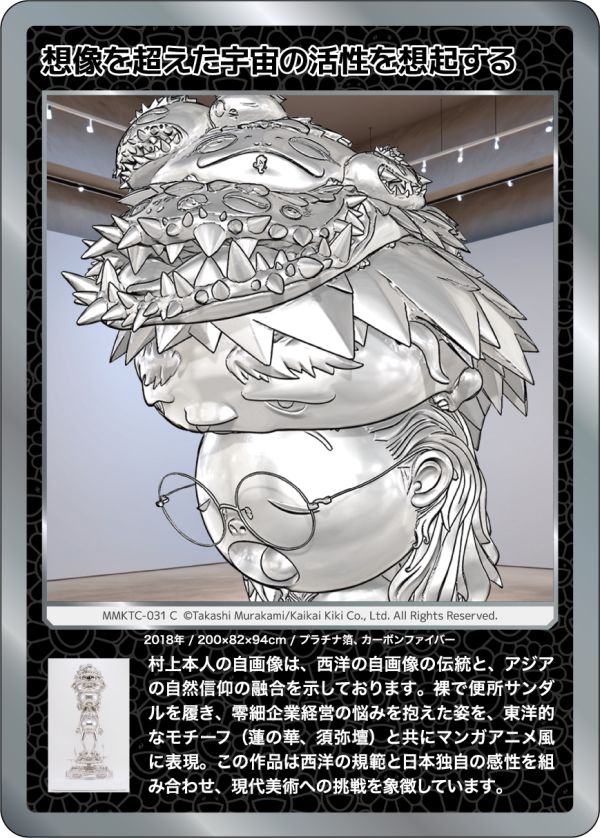

The self-portrait of Murakami shows a fusion of Western self-portrait traditions and Asian nature beliefs. Naked and wearing toilet sandals, the artist depicts himself burdened with the worries of running a small business in a manga-anime style, along with Eastern motifs (e.g. lotus flowers, shumidan alter). This work combines Western norms with a uniquely Japanese sensibility, symbolizing his challenge against contemporary art.
2018 / 200 x 82 x 94 cm / Platinum leaf on carbon fiber
村上本人の自画像は、西洋の自画像の伝統と、アジアの自然信仰の融合を示しております。裸で便所サンダルを履き、零細企業経営の悩みを抱えた姿を、東洋的なモチーフ(蓮の華、須弥壇)と共にマンガアニメ風に表現。この作品は西洋の規範と日本独自の感性を組み合わせ、現代美術への挑戦を象徴しています。
2018年 / 200 x 82 x 94cm / プラチナ箔、カーボンファイバー
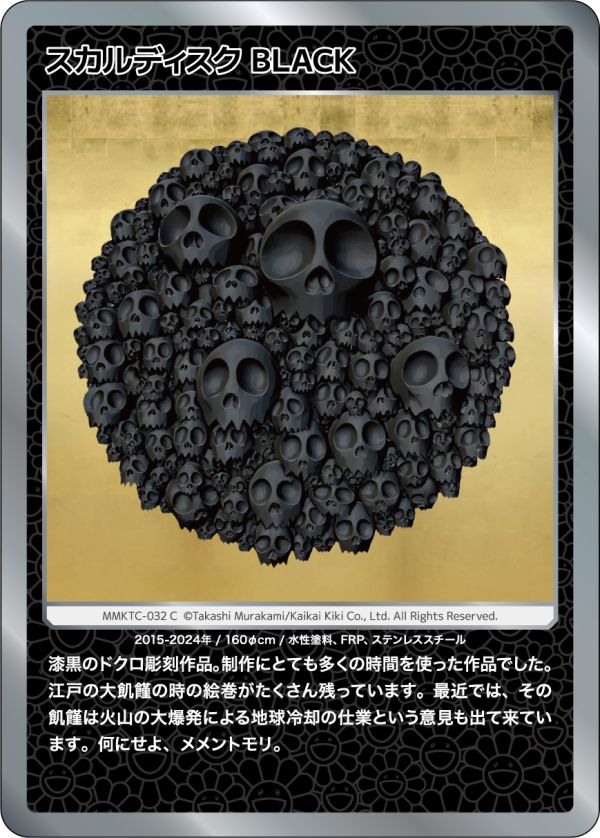

A jet-black sculpture of skulls, this is a work that took a great deal of time to produce.
There are many painting scrolls from the time of the great famine in Edo. Recently, there have been some opinions that the said famine had been the result of global cooling caused by a massive volcanic eruption. Whatever the case may have been, memento mori.
2015-2024 / 160φcm / Water-based paint, FRP, and stainless steel
漆黒のドクロ彫刻作品。制作にとても多くの時間を使った作品でした。
江戸の大飢饉の時の絵巻がたくさん残っています。最近では、その飢饉は火山の大爆発による地球冷却の仕業という意見も出て来ています。何にせよ、メメントモリ。
2015-2024年 / 160φcm / 水性塗料、FRP、ステンレススチール
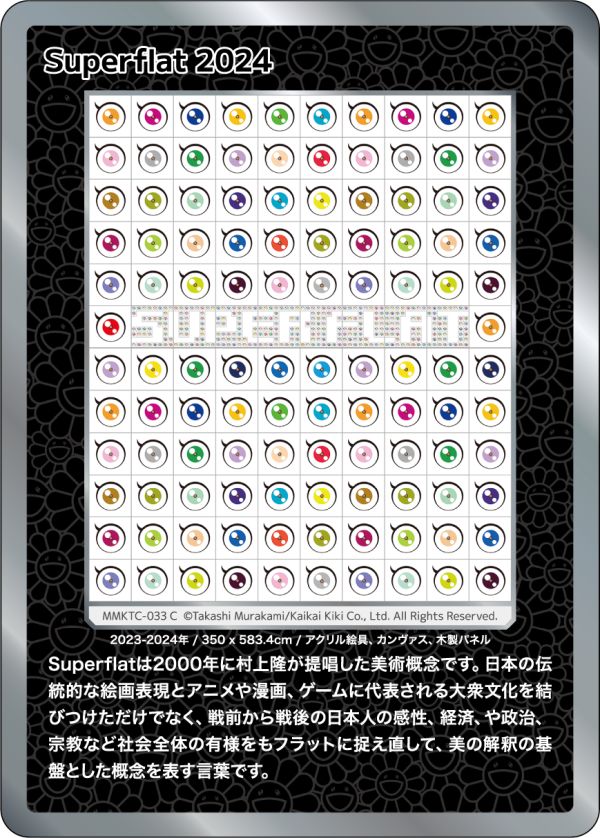

Superflat is a concept of art proposed by Takashi Murakami in 2000. The term expresses an idea that not only links traditional Japanese pictorial expression with popular culture as represented by anime, manga, and video games, but also flatly redefines the state of Japanese society as a whole, encompassing everything from pre-war and post-war Japanese sensibilities to its economy, politics and religion, forming the basis of an interpretation of beauty.
2023-2024 / 350 x 583.4cm / Acrylic on canvas mounted on wood panel
Superflatは2000年に村上隆が提唱した美術概念です。日本の伝統的な絵画表現とアニメや漫画、ゲームに代表される大衆文化を結びつけただけでなく、戦前から戦後の日本人の感性、経済、や政治、宗教など社会全体の有様をもフラットに捉え直して、美の解釈の基盤とした概念を表す言葉です。
2023-2024年 / 350 x 583.4cm / アクリル絵具、カンヴァス、木製パネル
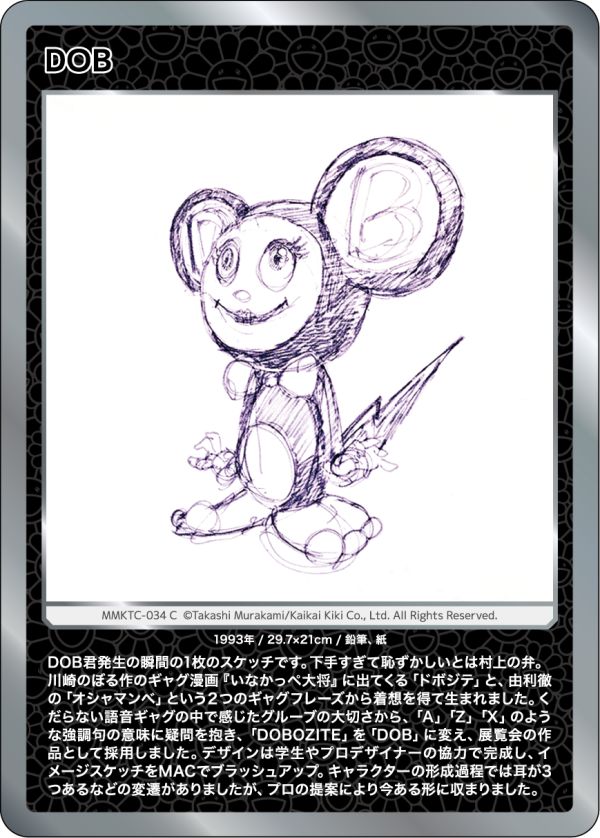

This is a sketch that embodies the moment of Mr. DOB’s birth. Murakami says it’s so bad he feels embarrassed.
The character’s name was inspired by two comedic phrases, "Dobojite" from the gag comic Inakappe Taishō by Noboru Kawasaki and “Oshamanbe” used by comedian Toru Yuri. In these silly pun-based gags, the groove seemed important, which led Murakami to question the meaning of emphatic letters like "A," "Z," and "X" affixed to titles and product names. To explore, he took "DOB" from “DOBOZITE” and adopted it as an artwork for his exhibition. The design of the character was completed with the help of students and professional designers, with a concept sketch brushed up on a Mac computer. In its formation process, the character went through some iterations, such as having three ears at one point, but at the suggestion of a professional, it settled into the form you see today.
1993 / 29.7 x 21 cm/ Pencil on paper
DOB君発生の瞬間の1枚のスケッチです。下手すぎて恥ずかしいとは村上の弁。
川崎のぼる作のギャグ漫画『いなかっぺ大将』に出てくる「ドボジテ」と、由利徹の「オシャマンベ」という2つのギャグフレーズから着想を得て生まれました。くだらない語音ギャグの中で感じたグルーブの大切さから、「A」「Z」「X」のような強調句の意味に疑問を抱き、「DOBOZITE」を「DOB」に変え、展覧会の作品として採用しました。デザインは学生やプロデザイナーの協力で完成し、イメージスケッチをMACでブラッシュアップ。キャラクターの形成過程では耳が3つあるなどの変遷がありましたが、プロの提案により今ある形に収まりました。
1993年 / 29.7×21cm/ 鉛筆、紙
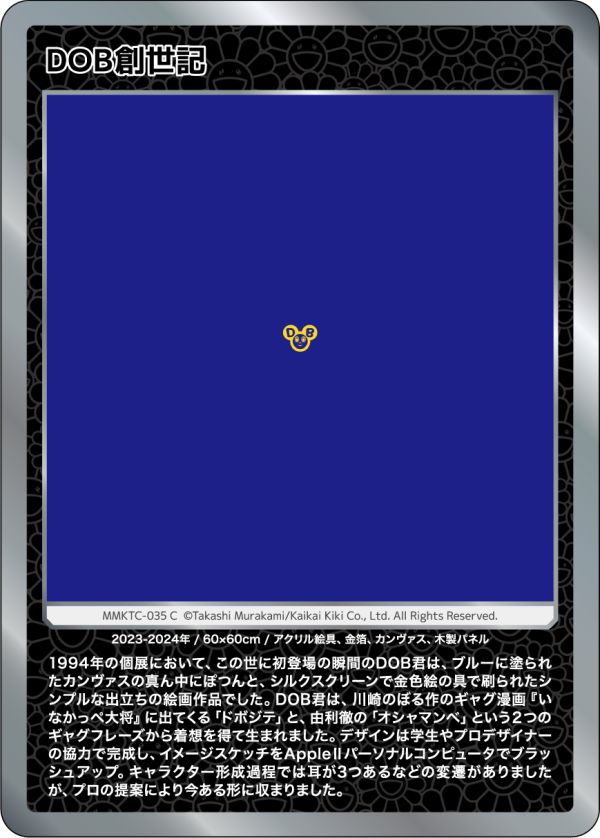

At the time of his first appearance in the world in Murakami’s 1994 solo exhibition, Mr. DOB was a simple painting, a lonely character silkscreened in gold paint in the middle of a blue canvas.
The name Mr. DOB was inspired by two comedic phrases, "Dobojite" from the gag comic Inakappe Taishō by Noboru Kawasaki and “Oshamanbe” used by comedian Toru Yuri. The design of the character was completed with the help of students and professional designers, with a concept sketch brushed up on an Apple II personal computer. In its formation process, the character went through some iterations, such as having three ears at one point, but at the suggestion of a professional, it settled into the form you see today.
2023-2024 / 60 x 60 cm /Acrylic and gold leaf on canvas mounted on wood panel
1994年の個展において、この世に初登場の瞬間のDOB君は、ブルーに塗られたカンヴァスの真ん中にぽつんと、シルクスクリーンで金色絵の具で刷られたシンプルな出立ちの絵画作品でした。
DOB君は、川崎のぼる作のギャグ漫画『いなかっぺ大将』に出てくる「ドボジテ」と、由利徹の「オシャマンベ」という2つのギャグフレーズから着想を得て生まれました。デザインは学生やプロデザイナーの協力で完成し、イメージスケッチをAppleⅡパーソナルコンピュータでブラッシュアップ。キャラクター形成過程では耳が3つあるなどの変遷がありましたが、プロの提案により今ある形に収まりました。
2023-2024年 / 60×60cm / アクリル絵具、金箔、カンヴァス、木製パネル


The “727” series combines elements of Murakami's signature character, Mr. DOB, and the Japanese Heian-period picture scroll, "Shigisan Engi-e”, to create a contemporary interpretation of medieval scroll painting while following the framework of Western art. The title "727" was taken from an advertisement seen from the window of a Shinkansen (bullet train). 727, incidentally, is also a prime number.
2015 / 300 x 450 cm / Acrylic and gold leaf on canvas mounted on wood panel
「727」シリーズは村上の代表的なキャラクター「DOB君」と、日本の平安時代の絵巻物 「信貴山縁起絵」の要素を合体させ、西洋美術の枠組みを踏襲しつつ中世のスクロール絵画を現代に解釈し直した作品です。タイトルの「727」は新幹線の車窓から見えた広告からとったものとのことです。「727」は素数でもあります。
2015年 / 300×450cm / アクリル絵具、金箔、カンヴァス、木製パネル
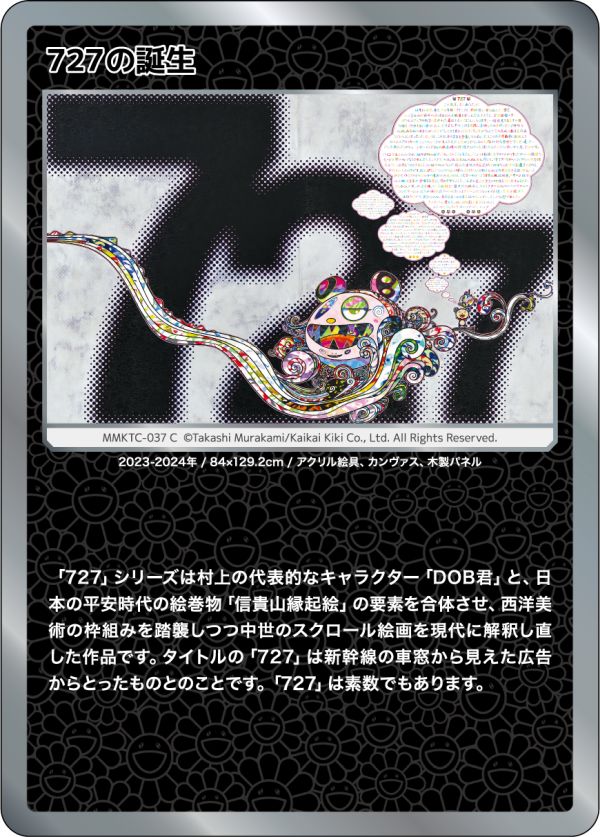

The “727” series combines elements of Murakami's signature character, Mr. DOB, and the Japanese Heian-period picture scroll, "Shigisan Engi-e”, to create a contemporary interpretation of medieval scroll painting while following the framework of Western art. The title "727" was taken from an advertisement seen from the window of a Shinkansen (bullet train). 727, incidentally, is also a prime number.
2023-2024 / 84 x 129.2 cm /Acrylic on canvas mounted on wood panel
「727」シリーズは村上の代表的なキャラクター「DOB君」と、日本の平安時代の絵巻物 「信貴山縁起絵」の要素を合体させ、西洋美術の枠組みを踏襲しつつ中世のスクロール絵画を現代に解釈し直した作品です。タイトルの「727」は新幹線の車窓から見えた広告からとったものとのことです。「727」は素数でもあります。
2023-2024年 / 84×129.2cm / アクリル絵具、カンヴァス、木製パネル
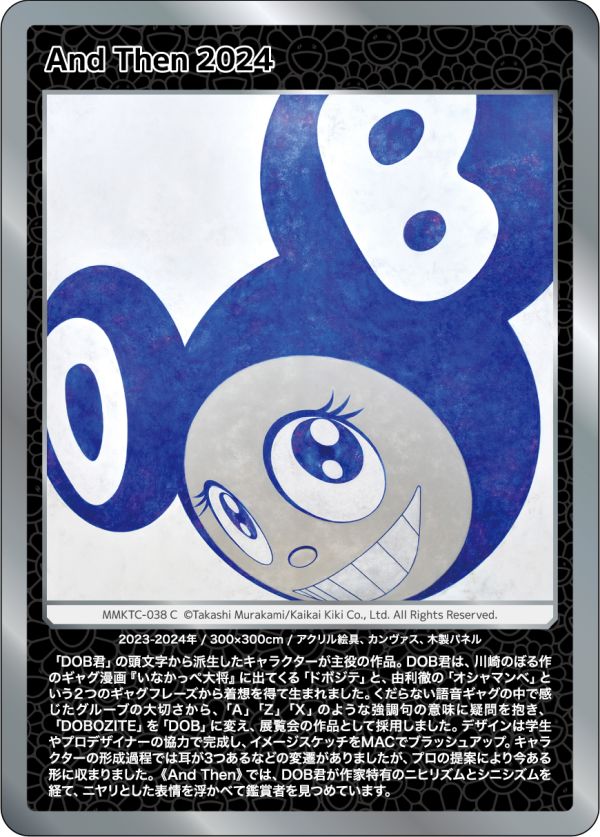

This work stars the character derived from the letters used in “Mr. DOB”.
Mr. DOB was inspired by two comedic phrases, "Dobojite" from the gag comic Inakappe Taishō by Noboru Kawasaki and “Oshamanbe” used by comedian Toru Yuri. In these silly pun-based gags, the groove seemed important, which led Murakami to question the meaning of emphatic letters like "A," "Z," and "X" affixed to titles and product names. To explore, he took "DOB" from “DOBOZITE” and adopted it as an artwork for his exhibition. The design of the character was completed with the help of students and professional designers, with a concept sketch brushed up on a Mac computer. In its formation process, the character went through some iterations, such as having three ears at one point, but at the suggestion of a professional, it settled into the form you see today.
In "And Then", Mr. DOB stares at the viewer with a grin on his face, rendered through the artist's characteristic nihilism and cynicism.
2023-2024 / 300 x 300 cm /Acrylic on canvas mounted on wood panel
「DOB君」の頭文字から派生したキャラクターが主役の作品。
DOB君は、川崎のぼる作のギャグ漫画『いなかっぺ大将』に出てくる「ドボジテ」と、由利徹の「オシャマンベ」という2つのギャグフレーズから着想を得て生まれました。くだらない語音ギャグの中で感じたグルーブの大切さから、「A」「Z」「X」のような強調句の意味に疑問を抱き、「DOBOZITE」を「DOB」に変え、展覧会の作品として採用しました。デザインは学生やプロデザイナーの協力で完成し、イメージスケッチをMACでブラッシュアップ。キャラクターの形成過程では耳が3つあるなどの変遷がありましたが、プロの提案により今ある形に収まりました。
《And Then》では、DOB君が作家特有のニヒリズムとシニシズムを経て、ニヤリとした表情を浮かべて鑑賞者を見つめています。
2023-2024年 / 300×300cm / アクリル絵具、カンヴァス、木製パネル
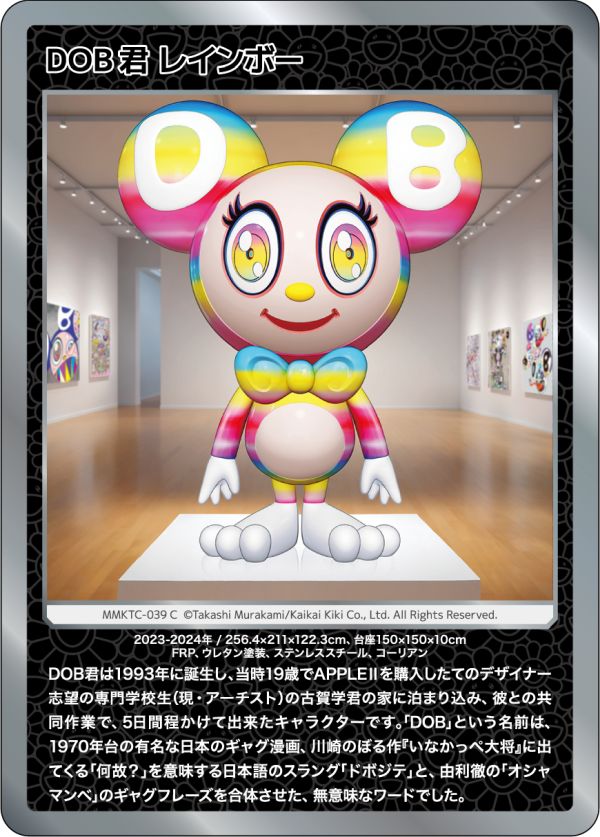

Mr. DOB was born in 1993. Murakami stayed at the house of Manabu Koga, an aspiring designer (now an artist) who was 19 years old at the time and had just purchased an Apple II computer, and they worked together to create the character in about five days. The name DOB is a nonsensical word made up by joining two comedic phrases, "Dobojite (why?)" from a well-known Japanese gag comic from the 1970s, Inakappe Taishō by Noboru Kawasaki, and “Oshamanbe” used by comedian Toru Yuri.
2023-2024/ 256.4 × 211 × 122.3 cm (pedestal: 150 × 150 × 10 cm) / FRP, urethane paint, stainless steel, and Corian
DOB君は1993年に誕生し、当時19歳でAPPLEⅡを購入したてのデザイナー志望の専門学校生(現・アーチスト)の古賀学君の家に泊まり込み、彼との共同作業で、5日間程かけて出来たキャラクターです。「DOB」という名前は、1970年台の有名な日本のギャグ漫画、川崎のぼる作『いなかっぺ大将』に出てくる「何故?」を意味する日本語のスラング「ドボジテ」と、由利徹の「オシャマンベ」のギャグフレーズを合体させた、無意味なワードでした。
2023-2024年 / 本体:256.4×211×122.3cm
台座:150×150×10cm / FRP、ウレタン塗装、ステンレススチール、コーリアン


“ZuZaZaZaZaZa”, Takashi Murakami's homage to the esteemed animator Yoshinori Kaneda and the Kanō school painter Kanō Sansetsu, suggests that the Japanese sense of beauty has always existed on a two-dimensional field by noting the commonality between Japanese animation and paintings of the Edo era.
Reinforcing this context is Murakami's character, Mr. DOB. This is a multi-colored version of the series created for his solo exhibition at the Kyoto City KYOCERA Museum of Art in 2024. The images is the installation shot from the exhibition.
2023-2024 / 120 × 120 cm / Acrylic on canvas mounted on wood panel
村上隆が敬愛するアニメーター金田伊功と、狩野派の絵師、狩野山雪へのオマージュ作品である「ズザザザザザ」は、日本のアニメーションと、江戸絵画における共通性から、日本人の美意識が、常に2ディメンショナルなフィールドにあったということを示唆しています。
その文脈を補強するのが村上のキャラクターDOB君です。2024年京都市立京セラ美術館個展用につくられたマルチカラーVer.が本作です。展覧会会場のインスタレーションPhotoです。
2023-2024年 / 120×120cm / アクリル絵具、カンヴァス、木製パネル
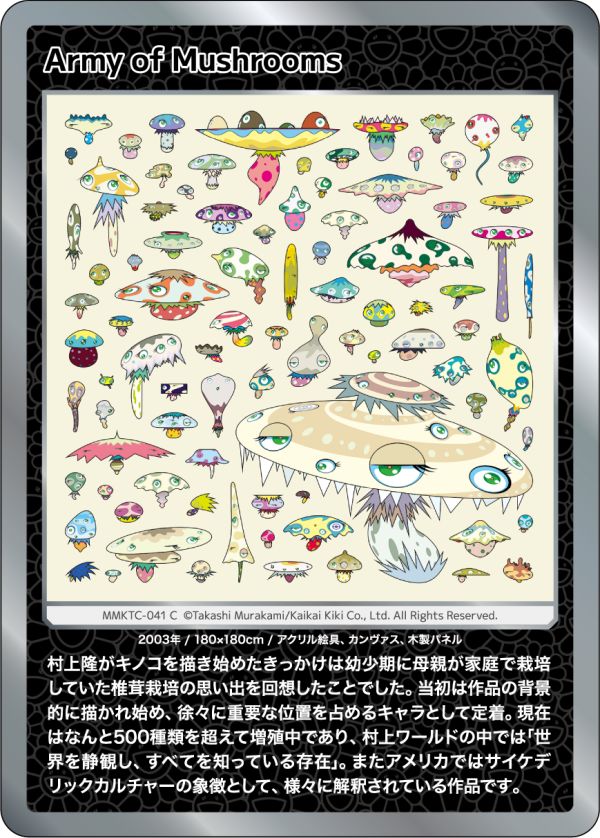

Takashi Murakami began exploring mushroom motifs when he recalled memories of how his mother used to cultivate shiitake mushrooms at home in his childhood. He started drawing mushrooms in the background of his paintings, and gradually established them as characters that occupy important positions in his work. Currently, there are more than whopping 500 varieties of mushrooms in the Murakami world, and they exist as the silent observes of the world who know everything. In the U.S., the work has been interpreted in various ways as a symbol of psychedelic culture.
2003 / 180 x 180 cm / Acrylic paint on canvas mounted on wooden panel
村上隆がキノコを描き始めたきっかけは幼少期に母親が家庭で栽培していた椎茸栽培の思い出を回想したことでした。当初は作品の背景的に描かれ始め、徐々に重要な位置を占めるキャラとして定着。現在はなんと500種類を超えて増殖中であり、村上ワールドの中では「世界を静観し、すべてを知っている存在」。またアメリカではサイケデリックカルチャーの象徴として、様々に解釈されている作品です。
2003年 / 180×180cm / アクリル絵具、カンヴァス、木製パネル
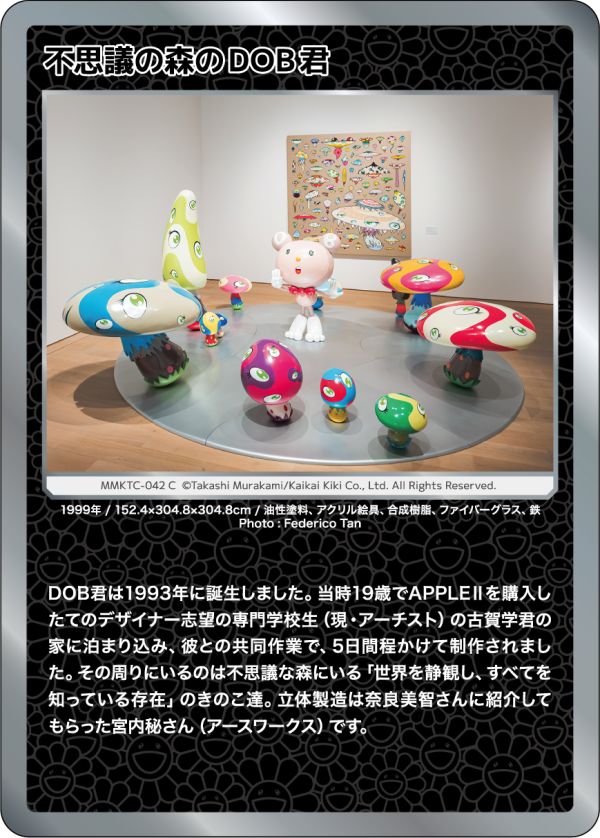

Mr. DOB was born in 1993. Murakami stayed at the house of Manabu Koga, an aspiring designer (now an artist) who was 19 years old at the time and had just purchased an Apple II computer, and they worked together to create the character in about five days. Surrounding them are mushrooms, "beings that observe the world in silence and know everything" in a strange forest. The sculpture was made by Hisoka Miyauchi (EARTHWORKS), who was introduced to the artist by Yoshitomo Nara.
1999 / 152.4 x 347 x 347 cm / Oil paint, acrylic paint, synthetic resin, fiberglass, iron
Photo : Federico Tan
DOB君は1993年に誕生しました。当時19歳でAPPLEⅡを購入したてのデザイナー志望の専門学校生(現・アーチスト)の古賀学君の家に泊まり込み、彼との共同作業で、5日間程かけて制作されました。その周りにいるのは不思議な森にいる「世界を静観し、すべてを知っている存在」のきのこ達。立体製造は奈良美智さんに紹介してもらった宮内秘さん(アースワークス)です。
1999年 / 152.4×347×347cm / 油性塗料、アクリル絵の具、合成樹脂、ファイバーグラス、鉄
Photo : Federico Tan


This is a painting of cheerful panda parent and child. While there is a tendency to regard art, especially contemporary art, as an adult pursuit, Murakami dared to paint images catered to children such as flowers and cute characters here. Murakami's definitive version of the kawaii explosion is this panda family. Note the letter “P” in the panda cub’s ears!
2024 / 105.6 × 93.4 cm / Acrylic on canvas mounted on wood panel
元気なパンダの親子の図。アート、特に現代美術は大人の嗜みごととする風潮がある中、お花やかわいいキャラクターという子供受けするイメージを描きました。村上の、カワイさ爆発の決定版がこのパンダの親子です! 小パンダの耳に「P」のスペルがあることに御注目‼︎
2024年
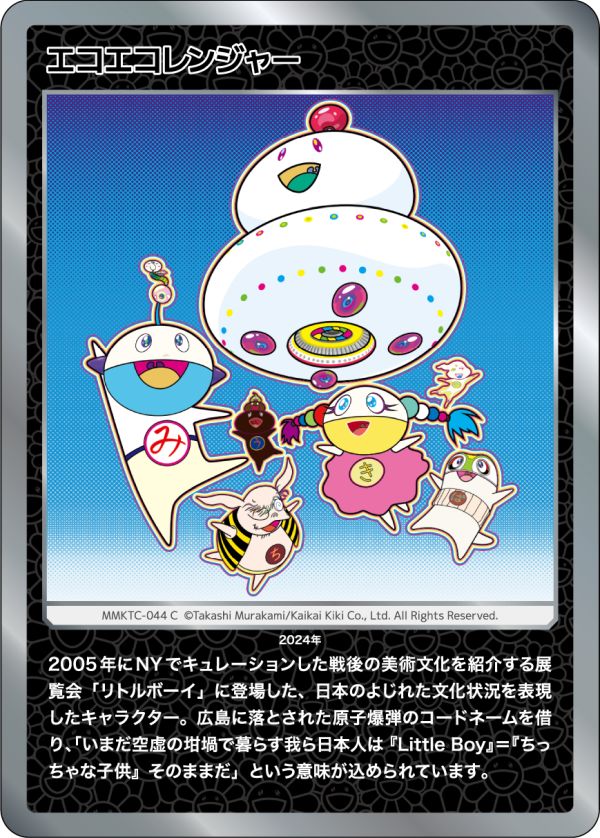

These characters were featured in Little Boy, an exhibition of Japanese postwar art and culture that Murakami curated in New York in 2005, and they embody the contorted state of Japanese culture. Borrowing the code name of the atomic bomb dropped on Hiroshima, the Little Boy character is imbued with the sense that "We Japanese, who still live in the crucible of emptiness, are just like a little child.”
2024
2005年にNYでキュレーションした戦後の美術文化を紹介する展覧会「リトルボーイ」に登場した、日本のよじれた文化状況を表現したキャラクター。広島に落とされた原子爆弾のコードネームを借り、「いまだ空虚の坩堝で暮らす我ら日本人は『Little Boy』=『ちっちゃな子供』そのままだ」という意味が込められています。
2024年


These are the characters called F.R.I.E.N.D.s and they appear in Takashi Murakami's film directorial debut, Jellyfish Eyes, released in April 2013.
“F.R.I.E.N.D." is an acronym(?) for "life-Form Resonance Inner Energy Negative emotion and Disaster prevention” and they are virtual creatures born when they resonate with the negative energy in children’s heart (...so goes the premise of the story).
Including these main characters such as Kurage-bo, Luxor, and Miss Ko2, there are currently 250 types of F.R.I.E.N.D.s in finalized forms.
2024
2013年4月に公開された、村上隆の初監督映画作品『めめめのくらげ』に登場する「ふれんど」と呼ばれるキャラクターたちです。
「ふれんど=F・R・I・E・N・D」は、“life-Form Resonance Inner Energy Negative emotion and Disaster prevention”の頭文字をとって名付けられた幽体生物で、こどもの心の中の「負」のエネルギーと共鳴することで生まれて来ます(…という物語の設定)。
くらげ坊、ルクソー、Ko² ちゃんなどのメインキャラクター含めて、現在250種のふれんどが、具体的な形状で存在しています。
2024年
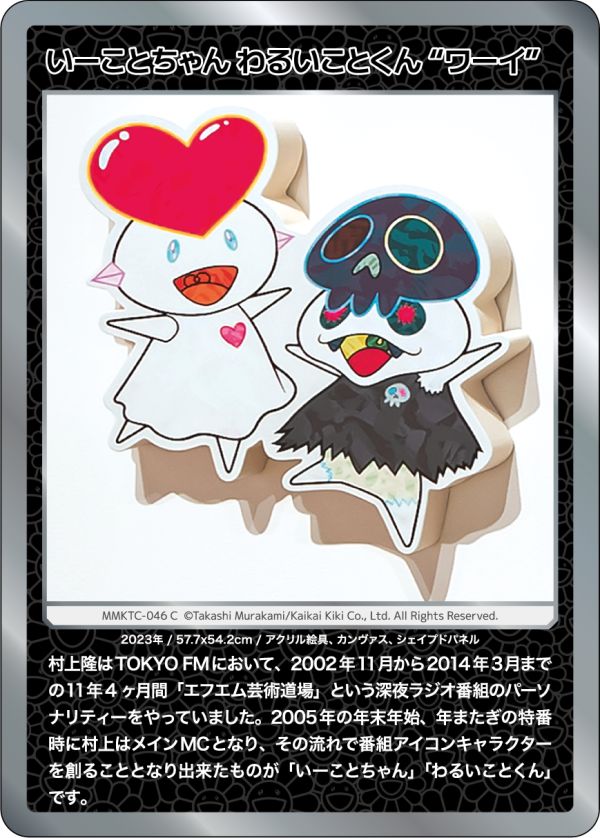

Takashi Murakami served as a late-night radio personality on TOKYO FM for 11 years and 4 months, from November 2002 to March 2014. On a special year-end program that ran from the end of 2005 to the New Year’s Day of 2006, he was the main MC. On that occasion, he created the characters that would become the program’s icons, Miss Good Thing and Mr. Bad Thing.
2023 / 57.7 x 54.2cm / Acrylic on canvas mounted on wood panel
村上隆はTOKYO FMにおいて、2002年11月から2014年3月までの11年4ヶ月間「エフエム芸術道場」という深夜ラジオ番組のパーソナリティーをやっていました。2005年の年末年始、年またぎの特番時に村上はメインMCとなり、その流れで番組アイコンキャラクターを創ることとなり出来たものが「いーことちゃん」「わるいことくん」 です。
2023年 / 57.7 x 54.2cm / アクリル絵具、カンヴァス、木製パネル
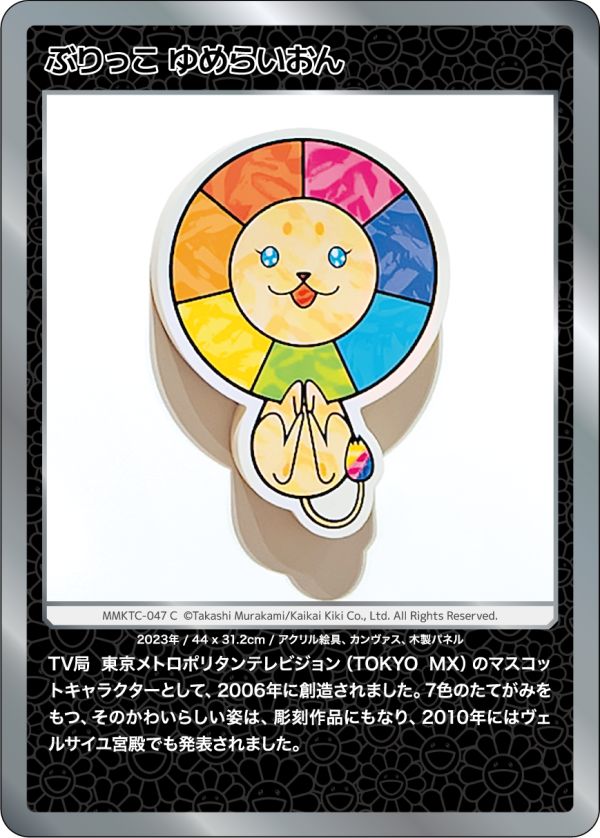

Created in 2006 as the mascot of the TV station Tokyo Metropolitan Television (TOKYO MX), this adorable character with its mane of seven colors has also been turned into a sculpture, which was unveiled at the Palace of Versailles in 2010.
2023 / 44 x 31.2cm Acrylic on canvas mounted on wood panel
TV局 東京メトロポリタンテレビジョン(TOKYO MX)のマスコットキャラクターとして、2006年に創造されました。7色のたてがみをもつ、そのかわいらしい姿は、彫刻作品にもなり、2010年にはヴェルサイユ宮殿でも発表されました。
2023年 / 44 x 31.2cm / アクリル絵具、カンヴァス、木製パネル


The original Double-faced Flower, a flower of the future that has supposedly undergone mutations due to today’s gene editing technology and exposure to chemicals, first appeared as the visuals for ComplexCon in 2019. In the 2024 exhibition, Takashi Murakami Mononoke Kyoto, at the Kyoto City KYOCERA Museum of art in Kyoto, Japan, it became the main character of the show as the Mononoke Flower.
2024
元となったダブルフェイスフラワーは、昨今の遺伝子編集や化学物質への露出などで突然変異を迎えた未来のお花として、2019年に開催されたComplexConのビジュアルで初めて登場しました。2024年京都市京セラミュージアムの展覧会「村上隆 もののけ 京都 」展では、「もののけフラワー」として、展覧会のメインキャラクターとなりました。
2024年
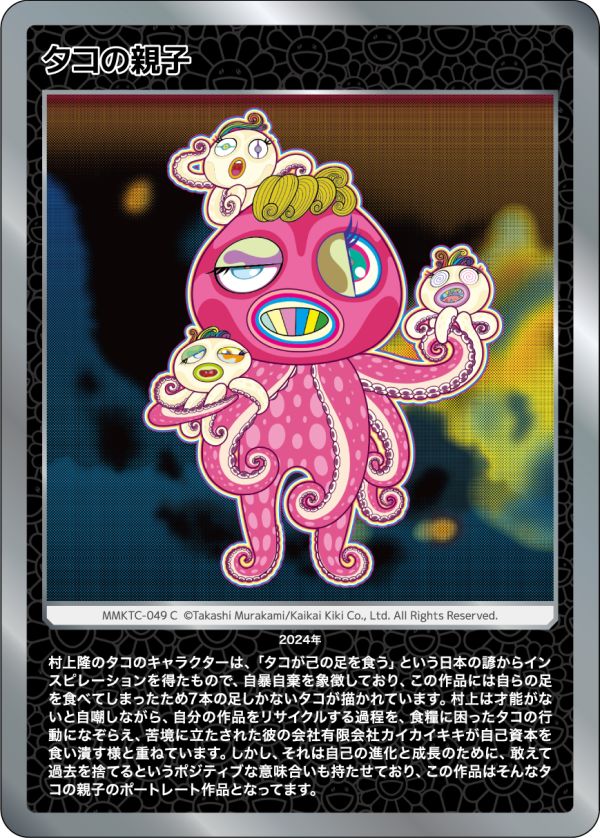

Takashi Murakami's Octopus character, inspired by the Japanese proverb, "an octopus eats its own leg," symbolizes desperation. This work depicts an octopus with only seven legs because it has eaten one of its own legs. Ridiculing himself for his lack of talent, Murakami likens this behavior of an octopus in need of food to his process of recycling his own work, as well as to his company, Kaikai Kiki, eating away at its own capital in dire straits. On the other hand, it also has a positive connotation of daring to abandon the past for the sake of one's own evolution and growth. This work is a portrait of an octopus family doing just that.
2024
村上隆のタコのキャラクターは、「タコが己の足を食う」という日本の諺からインスピレーションを得たもので、自暴自棄を象徴しており、この作品には自らの足を食べてしまったため7本の足しかないタコが描かれています。村上は才能がないと自嘲しながら、自分の作品をリサイクルする過程を、食糧に困ったタコの行動になぞらえ、苦境に立たされた彼の会社有限会社カイカイキキが自己資本を食い潰す様と重ねています。しかし、それは自己の進化と成長のために、敢えて過去を捨てるというポジティブな意味合いも持たせており、この作品はそんなタコの親子のポートレート作品となってます。
2024年
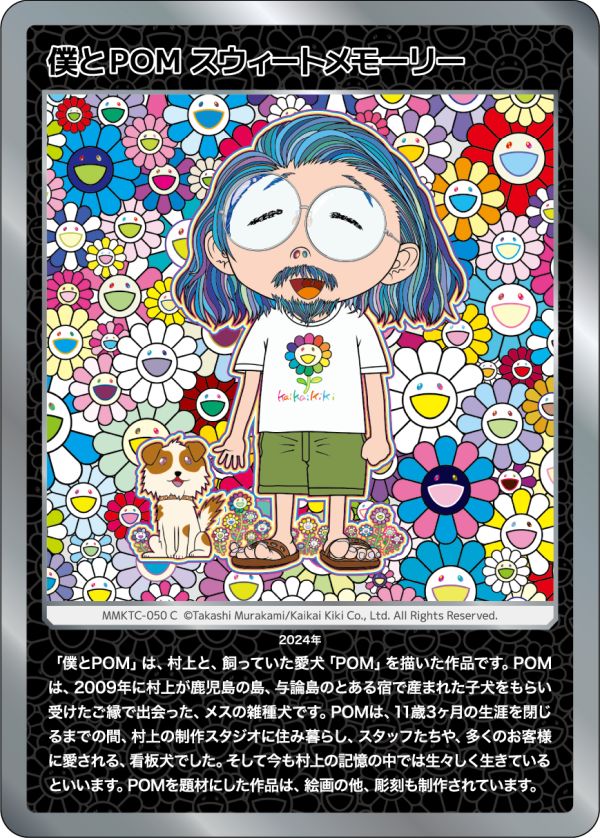

“POM & Me" is a painting of Murakami and his beloved late dog, POM.
POM was a female mutt Murakami met and adopted in 2009 when she was a puppy born at an inn on Yoron Island, one of the islands of Kagoshima.
POM lived in Murakami's production studio until the end of her life at the age of 11 years and 3 months and was the poster dog of the studio, loved by the staff and numerous visitors alike. Murakami says she vividly lives on in his memory to this day.
In addition to paintings, POM has been the motif of sculptures as well.
2024
「僕とPOM」は、村上と、飼っていた愛犬「POM」を描いた作品です。
POMは、2009年に村上が鹿児島の島、与論島のとある宿で産まれた子犬をもらい受けたご縁で出会った、メスの雑種犬です。
POMは、11歳3ヶ月の生涯を閉じるまでの間、村上の制作スタジオに住み暮らし、スタッフたちや、多くのお客様に愛される、看板犬でした。そして今も村上の記憶の中では生々しく生きているといいます。
POMを題材にした作品は、絵画の他、彫刻も制作されています。
2024年
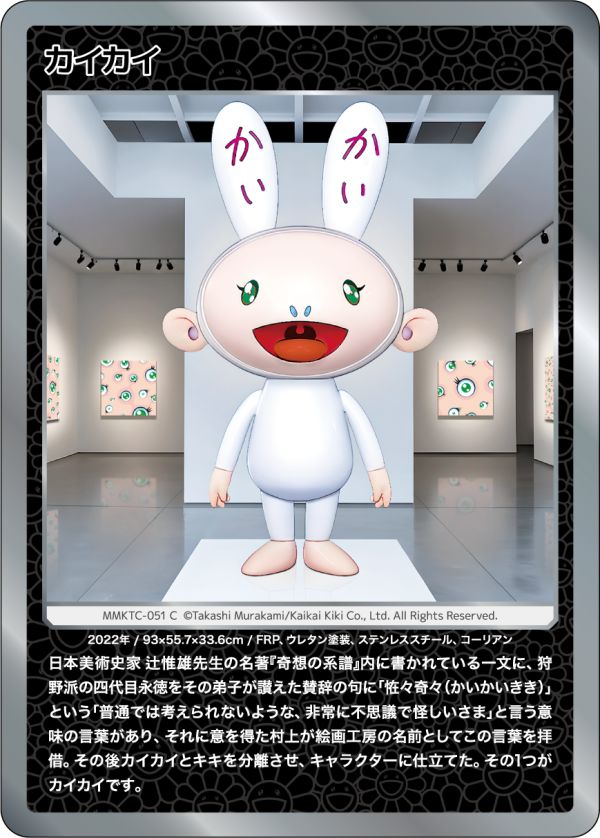

In the renowned book by the Japanese art historian Nobuo Tsuji, Lineage of Eccentrics, he mentions a word in the eulogy of Kanō Eitoku, the fourth-generation master of the Kanō school, by his disciple: kaikaikiki. It means "entirely out of ordinary, very mysterious and bizarre," and Murakami, who resonated with it, borrowed this word as the name of his painting studio. Later, he separated Kaikai and Kiki and made them into characters. One of them is Kaikai.
2022 / 93 × 55.7 × 33.6cm / Sculpture: FRP, urethane paint, stainless steel, and corian
日本美術史家 辻惟雄先生の名著『奇想の系譜』内に書かれている一文に、狩野派の四代目永徳をその弟子が讃えた賛辞の句に「恠恠奇奇(かいかいきき)」という「普通では考えられないような、非常に不思議で怪しいさま」と言う意味の言葉があり、それに意を得た村上が絵画工房の名前としてこの言葉を拝借。その後カイカイとキキを分離させ、キャラクターに仕立てた。その1つがカイカイです。
2022年 / 93×55.7×33.6cm / FRP、ウレタン塗装、ステンレススチール、コーリアン
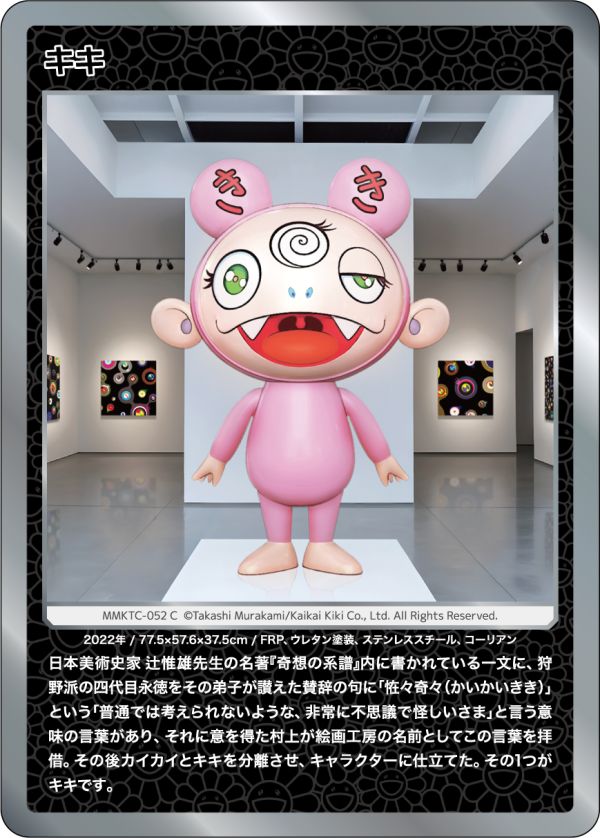

In the renowned book by the Japanese art historian Nobuo Tsuji, Lineage of Eccentrics, he mentions a word in the eulogy of Kanō Eitoku, the fourth-generation master of the Kanō school, by his disciple: kaikaikiki. It means "entirely out of ordinary, very mysterious and bizarre," and Murakami, who resonated with it, borrowed this word as the name of his painting studio. Later, he separated Kaikai and Kiki and made them into characters. One of them is Kiki.
2022 / 77.5 × 57.6 × 37.5 cm / Sculpture: FRP, urethane paint, stainless steel, and corian
日本美術史家 辻惟雄先生の名著『奇想の系譜』内に書かれている一文に、狩野派の四代目永徳をその弟子が讃えた賛辞の句に「恠恠奇奇(かいかいきき)」という「普通では考えられないような、非常に不思議で怪しいさま」と言う意味の言葉があり、それに意を得た村上が絵画工房の名前としてこの言葉を拝借。その後カイカイとキキを分離させ、キャラクターに仕立てた。その1つがキキです。
2022年 / 77.5×57.6×37.5cm / FRP、ウレタン塗装、ステンレススチール、コーリアン
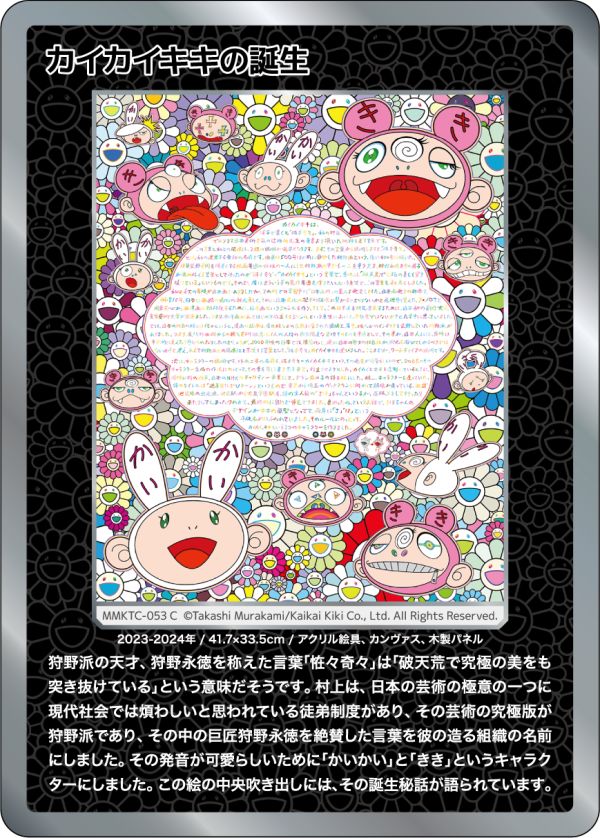

The word "kaikaikiki", which was used to eulogize Kanō Eitoku, the genius of the Kanō school, means "unprecedented and penetrates even the ultimate beauty.” Murakami believes that one of the maxims of Japanese art is the apprentice system, which is frowned upon in today’s society, and that the supreme embodiment of this art is the Kanō school. He named the organization he founded after the word that praised Kanō Eitoku, the master of this school. Kaikai and Kiki were made into characters because the word sounded cute when pronounced. The center speech bubble in this painting tells the story of their birth.
2023-2024 / 41.7 x 33.5 cm / Acrylic on canvas mounted on wood panel
狩野派の天才、狩野永徳を称えた言葉「恠々奇々」は「破天荒で究極の美をも突き抜けている」という意味だそうです。村上は、日本の芸術の極意の一つに現代社会では煩わしいと思われている徒弟制度があり、その芸術の究極版が狩野派であり、その中の巨匠狩野永徳を絶賛した言葉を彼の造る組織の名前にしました。その発音が可愛らしいために「かいかい」と「きき」というキャラクターにしました。この絵の中央吹き出しには、その誕生秘話が語られています。
2023-2024年 / 41.7×33.5cm / アクリル絵具、カンヴァス、木製パネル
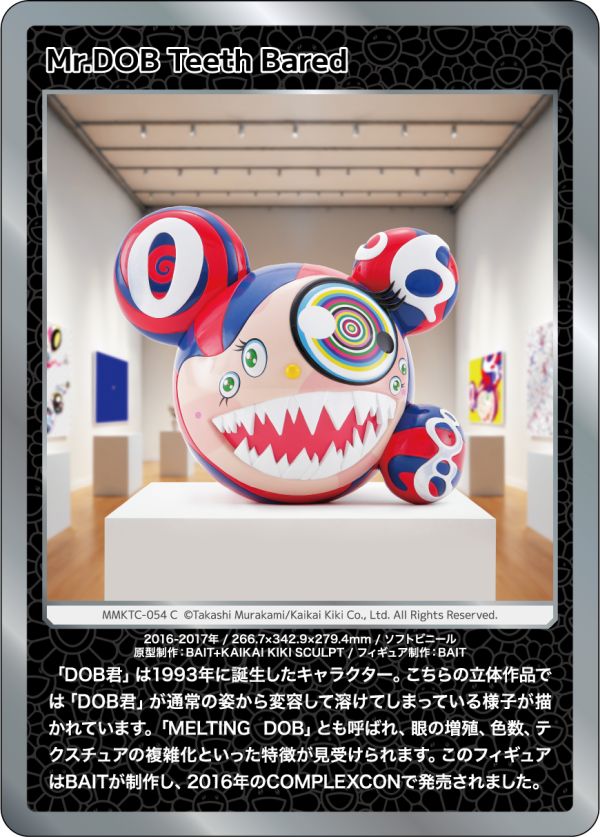

Mr. DOB is a character created in 1993. This three-dimensional work depicts Mr. DOB transformed from his normal form, melting down. Also known as "Melting DOB", the figure is characterized by the multiplying eyes, as well as the increased number of colors and complexity of textures. This figure was produced by BAIT and released at ComplexCon in 2016.
Original modeling: BAIT + Kaikai Kiki Sculpt / Figure production: BAIT
2016-2017 / 266.7 X 342.9 X 279.4 mm / Soft vinyl
「DOB君」は1993年に誕生したキャラクター。こちらの立体作品では「DOB君」が通常の姿から変容して溶けてしまっている様子が描かれています。「MELTING DOB」とも呼ばれ、眼の増殖、色数、テクスチュアの複雑化といった特徴が見受けられます。このフィギュアはBAITが制作し、2016年のCOMPLEXCONで発売されました。
原型制作:BAIT+KAIKAI KIKI SCULPT / フィギュア制作:BAIT /
2016-2017年 / 266.7 X 342.9 X 279.4 mm / ソフトビニール
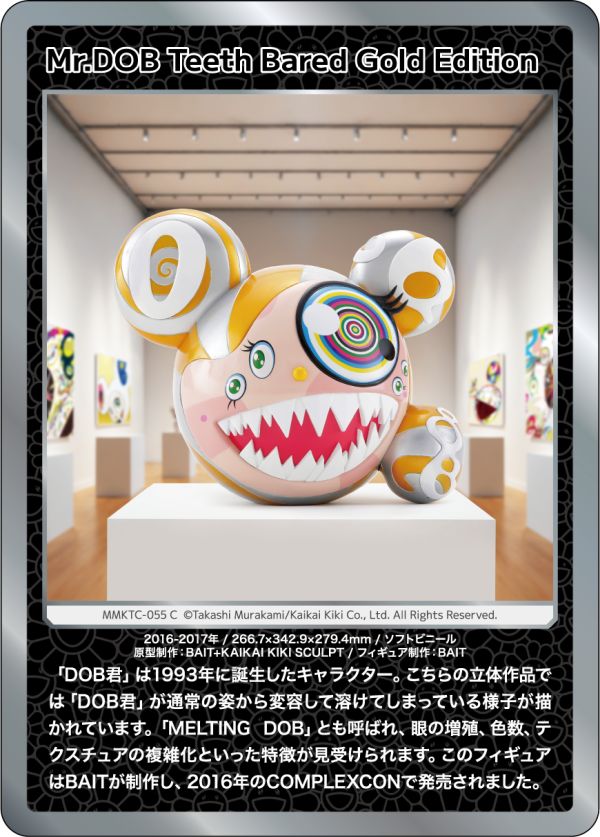

Mr. DOB is a character created in 1993. This three-dimensional work depicts Mr. DOB transformed from his normal form, melting down. Also known as "Melting DOB", the figure is characterized by the multiplying eyes, as well as the increased number of colors and complexity of textures. This figure was produced by BAIT and released as a special edition at ComplexCon in 2016.
Original modeling: BAIT + Kaikai Kiki Sculpt / Figure production: BAIT
2016-2017 / 266.7 X 342.9 X 279.4 mm / Soft vinyl
「DOB君」は1993年に誕生したキャラクター。こちらの立体作品では「DOB君」が通常の姿から変容して溶けてしまっている様子が描かれています。「MELTING DOB」とも呼ばれ、眼の増殖、色数、テクスチュアの複雑化といった特徴が見受けられます。このフィギュアはBAITが制作し、2016年のCOMPLEXCONで特別エディションとして発売されました。
原型制作:BAIT+KAIKAI KIKI SCULPT / フィギュア制作:BAIT /
2016-2017年 / 266.7 X 342.9 X 279.4 mm / ソフトビニール
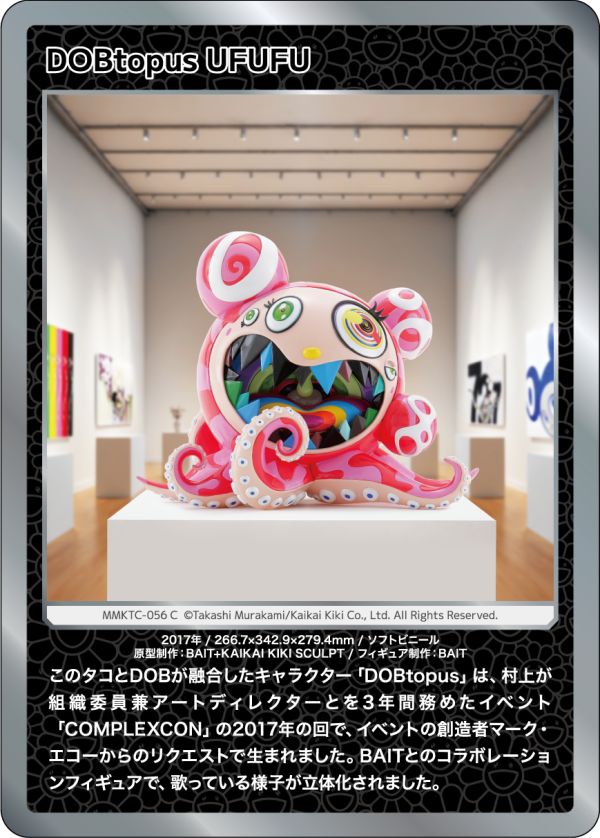

The character DOBtopus, a fusion of DOB and an octopus, was created for the 2017 edition of ComplexCon, an event for which Murakami served as a Host Committee member and Art Director for three years, at the request of the event’s founder Marc Ecko. The figure, made in collaboration with BAIT, depicts the character singing.
Original modeling: BAIT + Kaikai Kiki Sculpt / Figure production: BAIT
2017 / 266.7 x 342.9 x 279.4 mm / Soft vinyl
このタコとDOBが融合したキャラクター「DOBtopus」は、村上が組織委員兼アートディレクターとを3年間務めたイベント「COMPLEXCON」の2017年の回で、イベントの創造者マーク・エコーからのリクエストで生まれました。BAITとのコラボレーションフィギュアで、歌っている様子が立体化されました。
原型制作:BAIT+KAIKAI KIKI SCULPT / フィギュア制作:BAIT /
2017年 / 266.7 X 342.9 X 279.4 mm / ソフトビニール
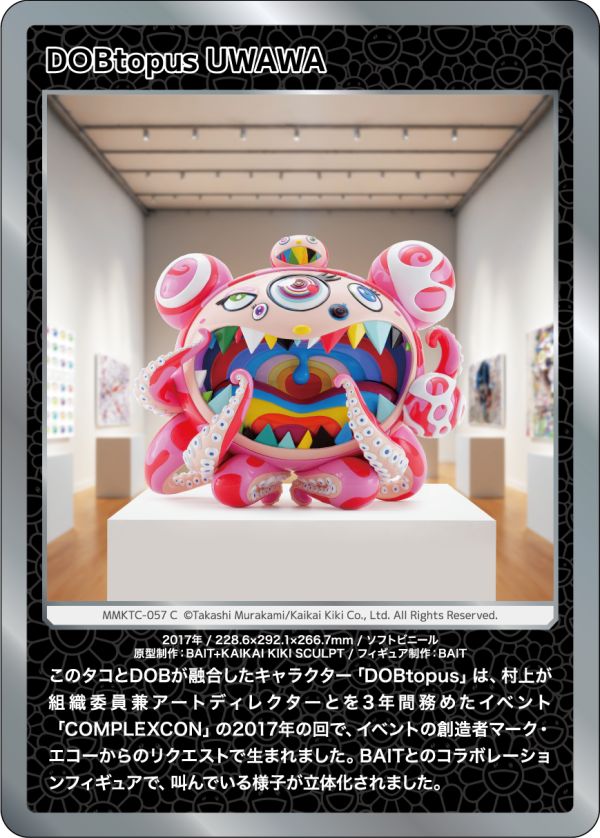

The character DOBtopus, a fusion of DOB and an octopus, was created for the 2017 edition of ComplexCon, an event for which Murakami served as a Host Committee member and Art Director for three years, at the request of the event’s founder Marc Ecko. The figure, made in collaboration with BAIT, depicts the character screaning.
Original modeling: BAIT + Kaikai Kiki Sculpt / Figure production: BAIT
2017 / 228.6 x 292.1 x 266.7 mm / Soft vinyl
このタコとDOBが融合したキャラクター「DOBtopus」は、村上が組織委員兼アートディレクターとを3年間務めたイベント「COMPLEXCON」の2017年の回で、イベントの創造者マーク・エコーからのリクエストで生まれました。BAITとのコラボレーションフィギュアで、叫んでいる様子が立体化されました。
原型制作:BAIT+KAIKAI KIKI SCULPT / フィギュア制作:BAIT /
2017年 / 228.6 X 292.1 X 266.7 mm / ソフトビニール
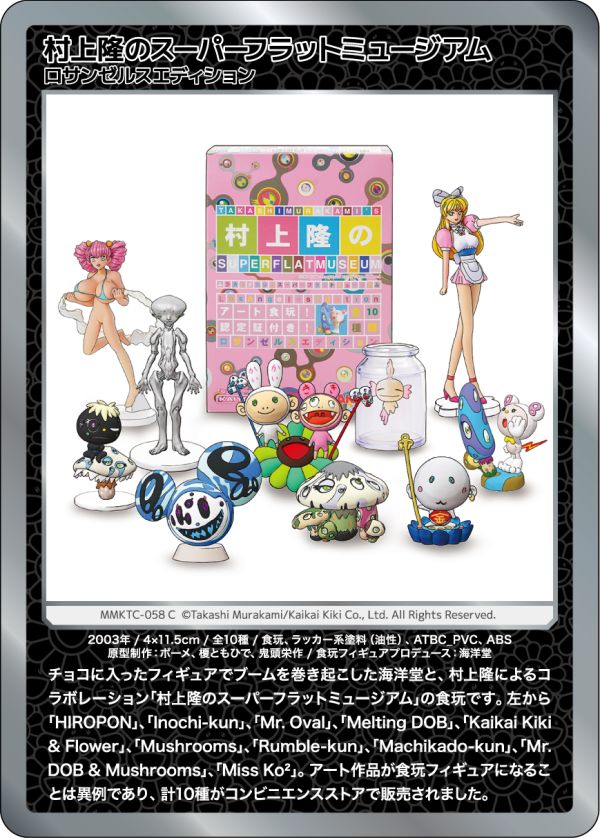

These are Shokugan collectible toys from "Takashi Murakami's Superfat Museum", a collaboration between Kaiyodo, which created a boom for bonus figurines that come with chocolates, and Takashi Murakami. From left to right: "HIROPON", "Inochi-kun", "Mr. Oval", "Melting DOB", "Kaikai Kiki & Flower", "Mushrooms", "Rumble-kun", "Machikado-kun", "Mr. DOB & Mushrooms", and " Miss Ko²". It is unusual for an artwork to be made into a Shokugan figure. A total of 10 types were sold at convenience stores.
Sculptors: Bome, Tomohide Enoki, Eisaku Kito
Shokugan figures produced by Kaiyodo
2003 / 4 x 11.5 cm / Total 10 types / Shokugan, lacquer-based paint (oil-based), ATBC_PVC, ABS
チョコに入ったフィギュアでブームを巻き起こした海洋堂と、村上隆によるコラボレーション「村上隆のスーパーフラットミュージアム」の食玩です。左から「HIROPON」、「Inochi-kun」、「Mr. Oval」、「Melting DOB」、「Kaikai Kiki & Flower」、「Mushrooms」、「Rumble-kun」、「Machikado-kun」、「Mr. DOB & Mushrooms」、「Miss Ko²」。アート作品が食玩フィギュアになることは異例であり、計10種がコンビニエンスストアで販売されました。
原型制作:ボーメ、榎ともひで、鬼頭栄作
食玩フィギュアプロデュース:海洋堂
2003年 / 4×11.5cm / 全10種 / 食玩、ラッカー系塗料(油性)、ATBC_PVC、ABS
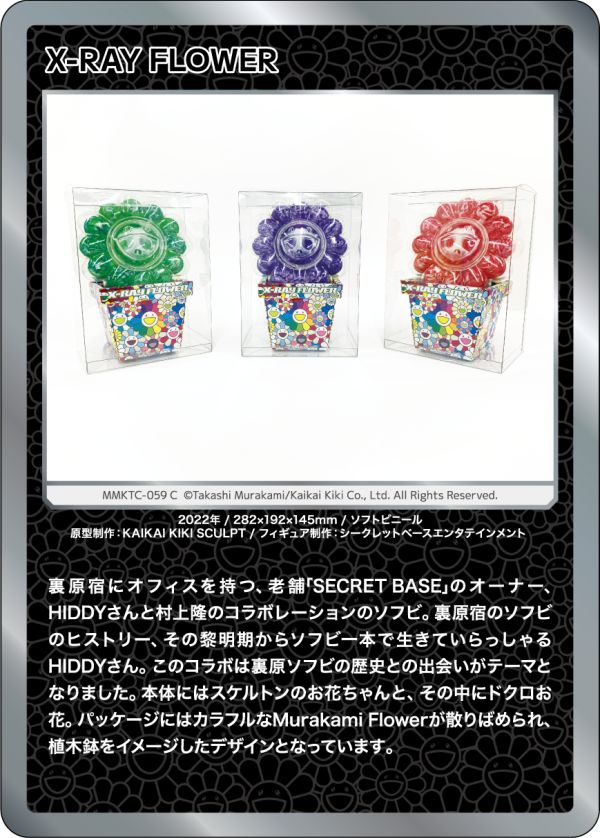

A soft vinyl collaboration between Takashi Murakami and HIDDY, the owner of the long-established SECRET BASE, which has an office in Uraharajuku. HIDDY has dedicated his life to soft vinyl since the dawn of the soft vinyl history in Uraharajuku. The theme of this collaboration was Murakami’s encounter with the history of Urahara soft vinyl. The main body features a skeleton Flower with a Skull Flower inside. The package is decorated with colorful Murakami Flowers and is designed to resemble a flowerpot.
Original modeling: KAIKAI KIKI SCULPT / Figure production: SECRET BASE ENTERTAINMENT
2022 / 282 x 192 x 145mm / Soft vinyl
裏原宿にオフィスを持つ、老舗「SECRET BASE」のオーナー、HIDDYさんと村上隆のコラボレーションのソフビ。裏原宿のソフビのヒストリー、その黎明期からソフビ一本で生きていらっしゃるHIDDYさん。このコラボは裏原ソフビの歴史との出会いがテーマとなりました。本体にはスケルトンのお花ちゃんと、その中にドクロお花。パッケージにはカラフルなMurakami Flowerが散りばめられ、植木鉢をイメージしたデザインとなっています。
原型制作:KAIKAI KIKI SCULPT / フィギュア制作:シークレットベースエンタテインメント
2022年 / 282 x 192 x 145mm / ソフトビニール
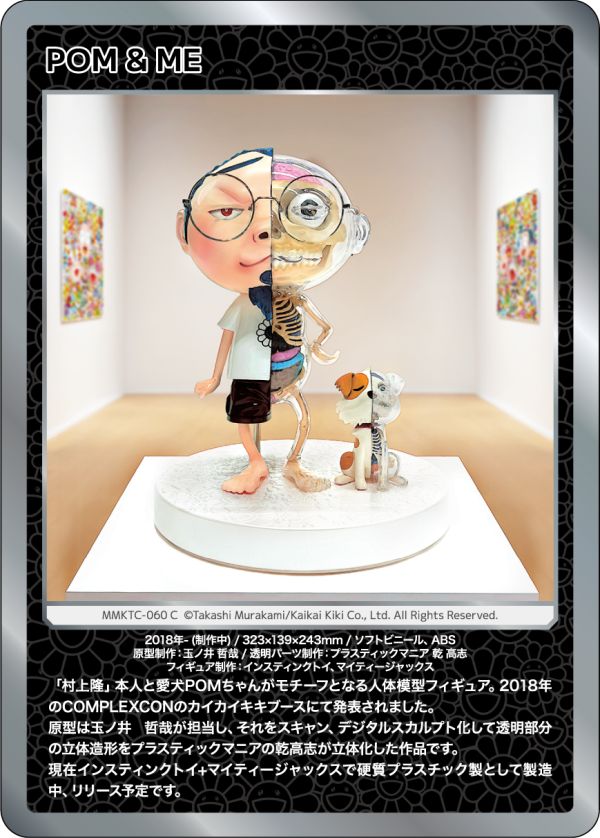

This figure of Takashi Murakami and his beloved late dog, POM, was unveiled at the Kaikai Kiki booth at ComplexCon in 2018.
Tetsuya Tamanoi was in charge of the original modeling, which was scanned and converted into digital sculpting. The transparent part was then sculpted into three-dimensional object by Takashi Inui of Plastic Mania.
It is currently being manufactured in hard plastic by Instinctoy and Mighty Jaxx and is scheduled to be released.
Original Modeling: Tetsuya Tamanoi / Transparent parts: Takashi Inui, Plastic Mania / Figure production: Instinctoy, Mighty Jaxx
2018- (in production) / 323 × 139 × 243 mm / Soft vinyl, ABS
「村上隆」本人と愛犬POMちゃんがモチーフとなる人体模型フィギュア。2018年のCOMPLEXCONのカイカイキキブースにて発表されました。
原型は玉ノ井 哲哉が担当し、それをスキャン、デジタルスカルプト化して透明部分の立体造形をプラスティックマニアの乾高志が立体化した作品です。
現在インスティンクトイ+マイティージャックスで硬質プラスチック製として製造中、リリース予定です。
原型制作:玉ノ井 哲哉 / 透明パーツ制作:プラスティックマニア 乾 高志 / フィギュア制作:インスティンクトイ、マイティージャックス
2018- (制作中) / 323 ×139 × 243 mm / ソフトビニール、ABS
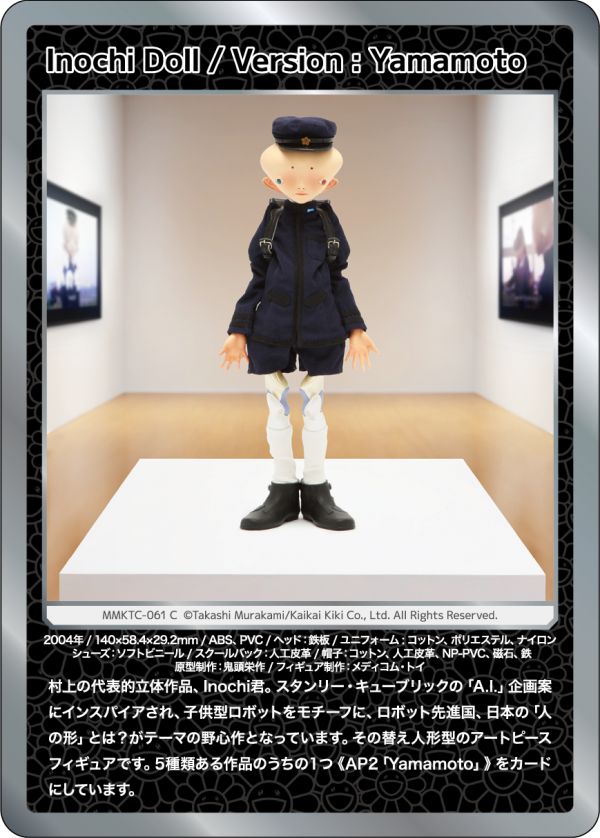

Inochi-kun is one of Murakami's representative sculptural works. Inspired by Stanley Kubrick's A.I. film project, the theme of this ambitious work with the child-like robot motif is the question: “What is ‘human form’ in Japan, a country with advanced robotics?” This is an art figure in the form of a dress-up doll based on this concept. Of the five different types in the series, this card features the "AP2 Yamamoto".
Original Modeling: Eisaku Kito
Figure Production: Medicom Toy
2004 / 140 x 58.4 x 29.2 mm / ABS, PVC / Head: steel plate / Uniform: cotton, polyester, nylon / Shoes: soft vinyl / School bag: artificial leather / Hat: cotton, artificial leather, NP-PVC, magnet, iron
村上の代表的立体作品、Inochi君。スタンリー・キューブリックの「A.I.」企画案にインスパイアされ、子供型ロボットをモチーフに、ロボット先進国、日本の「人の形」とは?がテーマの野心作となっています。その着せ替え人形型のアートピースフィギュアです。5種類ある作品のうちの1つ《AP2「Yamamoto」》をカードにしています。
原型制作:鬼頭栄作
フィギュア制作:メディコム・トイ
2004年 / 140×58.4×29.2mm / ABS、PVC / ヘッド:鉄板 / ユニフォーム: コットン、ポリエステル、ナイロン / シューズ:ソフトビニール / スクールバック:人工皮革 / 帽子:コットン、人工皮革、NP-PVC、磁石、鉄


Humans have a predilection for anthropomorphic humanoid robots and ape-men as self-portraits. In particular, there are many movies, documentaries, etc. about ape-men, and Murakami has created a monster in this context.
The original model was first created as digital data by Kaikai Kiki's Sculpting Studio, which was then completed by JIYURO.
The figure will be made into a sofubi figure by Kaikai KikiSoft Vinyl Factory.
Original modeling: JIYURO / Figure production: Kaikai Kiki
2020- (in production) / 380 x 255 x 125 mm / Soft vinyl
人間は自画像としての人型ロボットや猿人の擬人化を好みます。特に猿人の映画やドキュメンタリー等は多く、その文脈でのモンスターを作りました。
原型制作はカイカイキキの造形工房でデジタル素体をまず造り、仕上げを有限会社自由廊にお願いして完成しました。
カイカイキキソフビ工場によってソフビ化を予定しています。
原型制作:有限会社自由廊 / フィギュア制作:カイカイキキ
2020-(制作中) / 380 X 255 X 125 mm / ソフトビニール
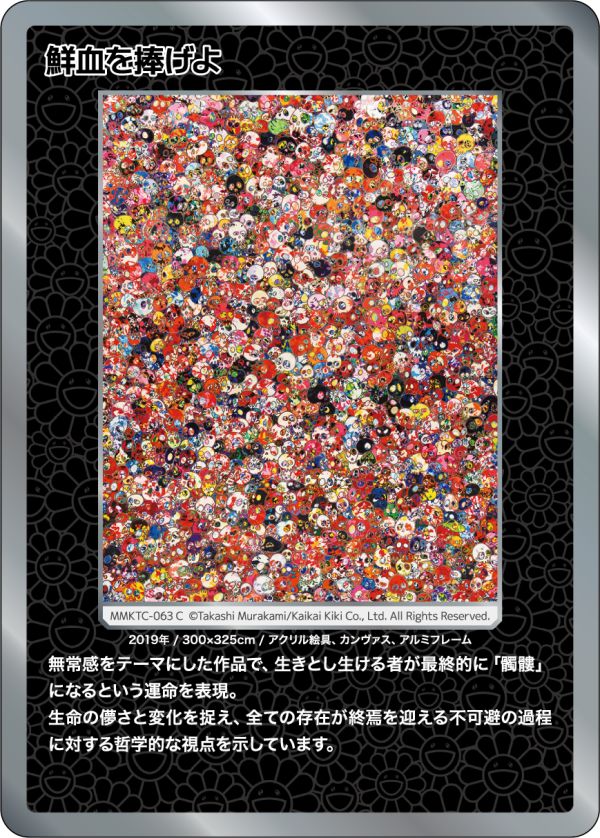

This is a painting with a sense of impermanence as its theme. It expresses the fate of all living beings, that we will all eventually end up becoming skulls. It captures the transience and transformation of life, presenting a philosophical perspective on the inevitable process by which all existence comes to an end.
2019 / 300 x 235cm / Acrylic on canvas mounted on aluminum frame
無常感をテーマにした作品で、生きとし生ける者が最終的に「髑髏」になるという運命を表現。生命の儚さと変化を捉え、全ての存在が終焉を迎える不可避の過程に対する哲学的な視点を示しています。
2019年 / 300 x 235cm / アクリル絵具、カンヴァス、アルミフレーム
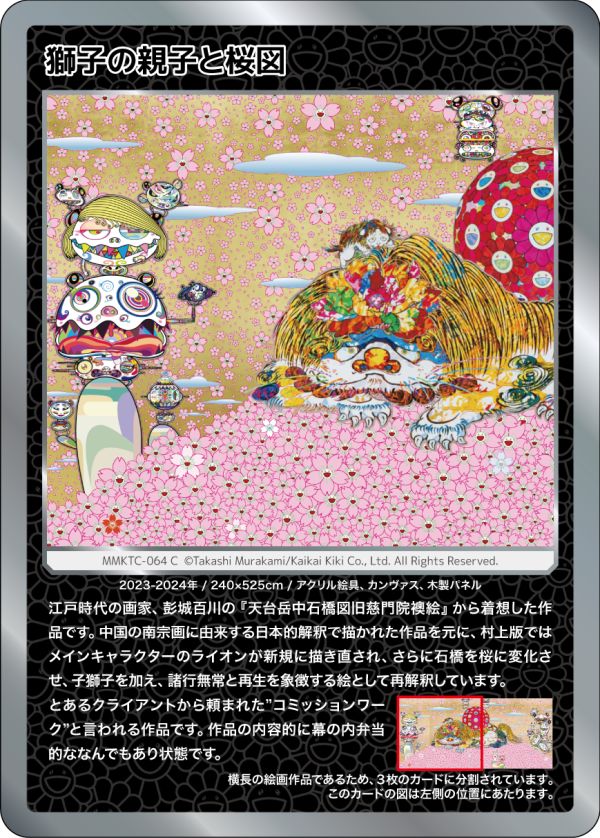

This work was inspired by the Edo-period painter Sakaki Hyakken’s “Shakkyo at Mt. Tendai”, a painting on fusuma door panels of the former Jimon-in Temple. Based on the work that is a Japanese interpretation of a motif derived from China’s Southern Song paintings, in this Murakami version the main character, a lion, is newly redesigned, the stone bridge has morphed into cherry blossoms, and lion cubs were added. Murakami has reinterpreted the painting as a symbol of impermanence and rebirth.
This is a so-called commissioned work for a client. As far as the content of the work goes, it is anything-goes, like a packed bento box.
2023-2024 / 240 x 525 cm / Acrylic on canvas mounted on wood panel
As this is a horizontally long painting, it is divided into three cards. This card shows the left end of the painting.
江戸時代の画家、彭城百川の『天台岳中石橋図旧慈門院襖絵』から着想した作品です。中国の南宗画に由来する日本的解釈で描かれた作品を元に、村上版ではメインキャラクターのライオンが新規に描き直され、さらに石橋を桜に変化させ、子獅子を加え、諸行無常と再生を象徴する絵として再解釈しています。
とあるクライアントから頼まれた”コミッションワーク”と言われる作品です。作品の内容的に幕の内弁当的ななんでもあり状態です。
2023-2024年 / 240×525cm / アクリル絵具、カンヴァス、木製パネル
横長の作品であるため、3枚のカードに分割されています。このカードの図は左側の位置にあたります。
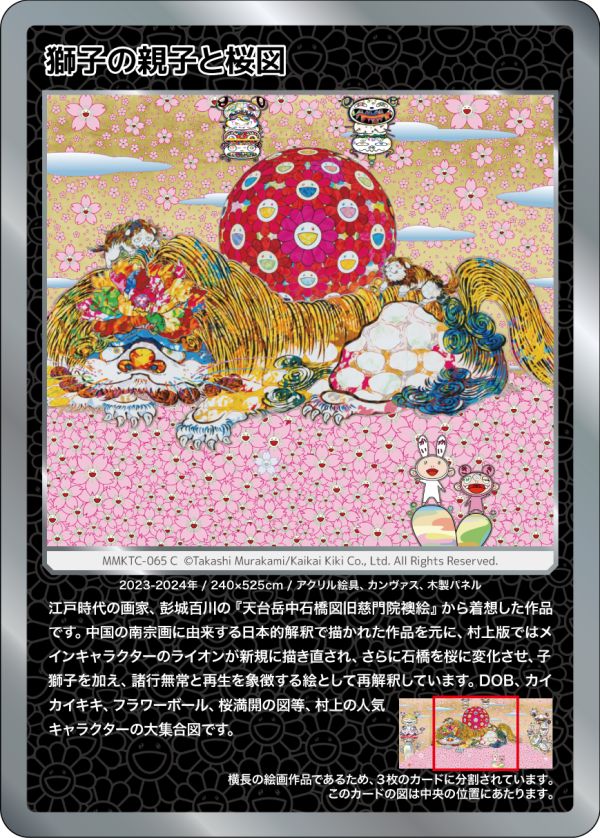

This work was inspired by the Edo-period painter Sakaki Hyakken’s “Shakkyo at Mt. Tendai”, a painting on fusuma door panels of the former Jimon-in Temple. Based on the work that is a Japanese interpretation of a motif derived from China’s Southern Song paintings, in this Murakami version the main character, a lion, is newly redesigned, the stone bridge has morphed into cherry blossoms, and lion cubs were added. Murakami has reinterpreted the painting as a symbol of impermanence and rebirth.
It's an all-star gathering of Murakami's popular characters, including DOB, Kaikai Kiki, Flowerball, and Cherry Blossoms in full bloom.
2023-2024 / 240 x 525 cm / Acrylic on canvas mounted on wood panel
As this is a horizontally long painting, it is divided into three cards. This card shows the center section of the painting.
江戸時代の画家、彭城百川の『天台岳中石橋図旧慈門院襖絵』から着想した作品です。中国の南宗画に由来する日本的解釈で描かれた作品を元に、村上版ではメインキャラクターのライオンが新規に描き直され、さらに石橋を桜に変化させ、子獅子を加え、諸行無常と再生を象徴する絵として再解釈しています。
DOB、カイカイキキ、フラワーボール、桜満開の図等、村上の人気キャラクターの大集合図です。
2023-2024年 / 240×525cm / アクリル絵具、カンヴァス、木製パネル
横長の作品であるため、3枚のカードに分割されています。このカードの図は中央の位置にあたります。
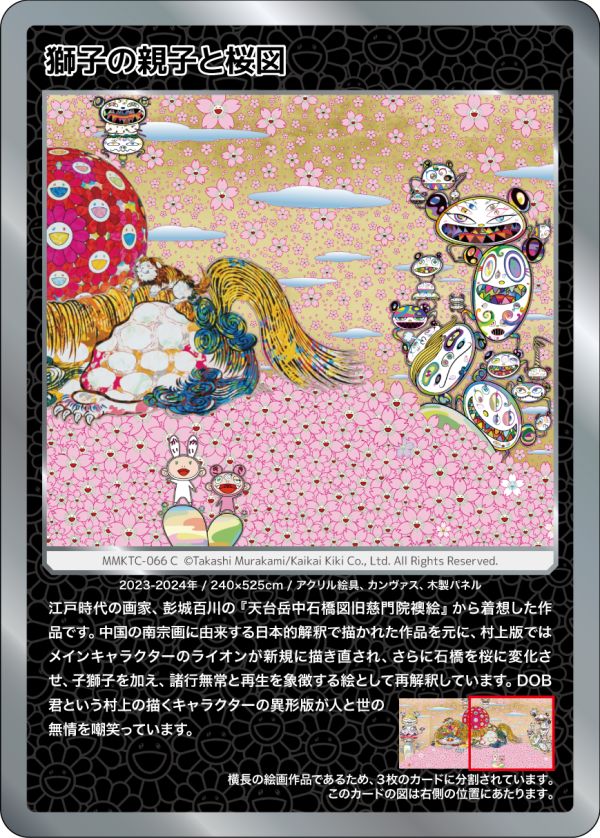

This work was inspired by the Edo-period painter Sakaki Hyakken’s “Shakkyo at Mt. Tendai”, a painting on fusuma door panels of the former Jimon-in Temple. Based on the work that is a Japanese interpretation of a motif derived from China’s Southern Song paintings, in this Murakami version the main character, a lion, is newly redesigned, the stone bridge has morphed into cherry blossoms, and lion cubs were added. Murakami has reinterpreted the painting as a symbol of impermanence and rebirth.
A heteromorphic version of Mr. DOB, a Murakami character, scoffs at the heartlessness of people and the world.
2023-2024 / 240 x 525 cm / Acrylic on canvas mounted on wood panel
As this is a horizontally long painting, it is divided into three cards. This card shows the right end of the painting.
江戸時代の画家、彭城百川の『天台岳中石橋図旧慈門院襖絵』から着想した作品です。中国の南宗画に由来する日本的解釈で描かれた作品を元に、村上版ではメインキャラクターのライオンが新規に描き直され、さらに石橋を桜に変化させ、子獅子を加え、諸行無常と再生を象徴する絵として再解釈しています。
DOB君という村上の描くキャラクターの異形版が人と世の無情を嘲笑っています。
2023-2024年 / 240×525cm / アクリル絵具、カンヴァス、木製パネル
横長の作品であるため、3枚のカードに分割されています。このカードの図は右側の位置にあたります。
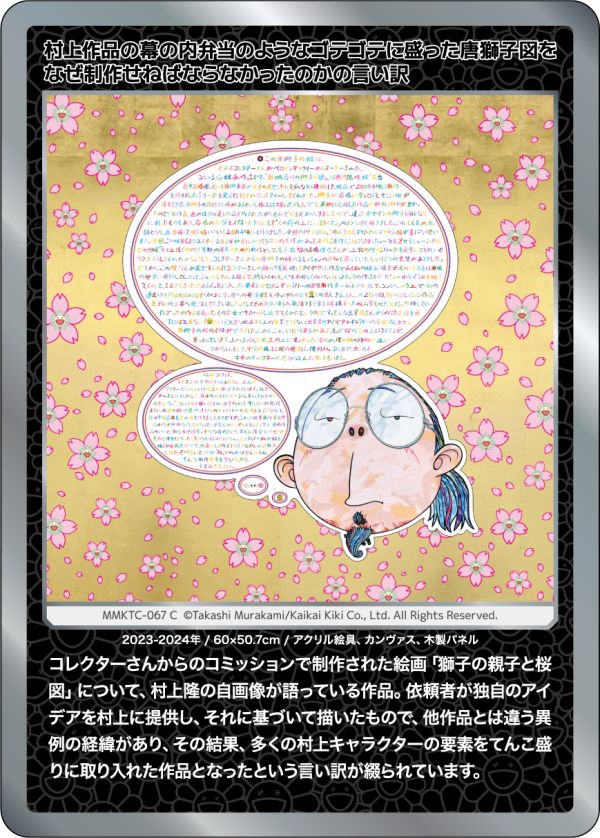

This self-portrait by Takashi Murakami tells the story of the painting "Lion Parent and Cubs with Cherry Blossoms ", which was commissioned by a collector. It spells out the excuse about how the client provided Murakami with his own original idea, based on which the painting was created, and how this was a very unusual process, which resulted in a work that was filled to the brim with elements of many Murakami characters.
2023-2024 / 60 x 50.7 cm / Acrylic on canvas mounted on wood panel
コレクターさんからのコミッションで制作された絵画「獅子の親子と桜図」について、村上隆の自画像が語っている作品。依頼者が独自のアイデアを村上に提供し、それに基づいて描いたもので、他作品とは違う異例の経緯があり、その結果、多くの村上キャラクターの要素をてんこ盛りに取り入れた作品となったという言い訳が綴られています。
2023-2024年 / 60 x 50.7cm / アクリル絵具、カンヴァス、木製パネル
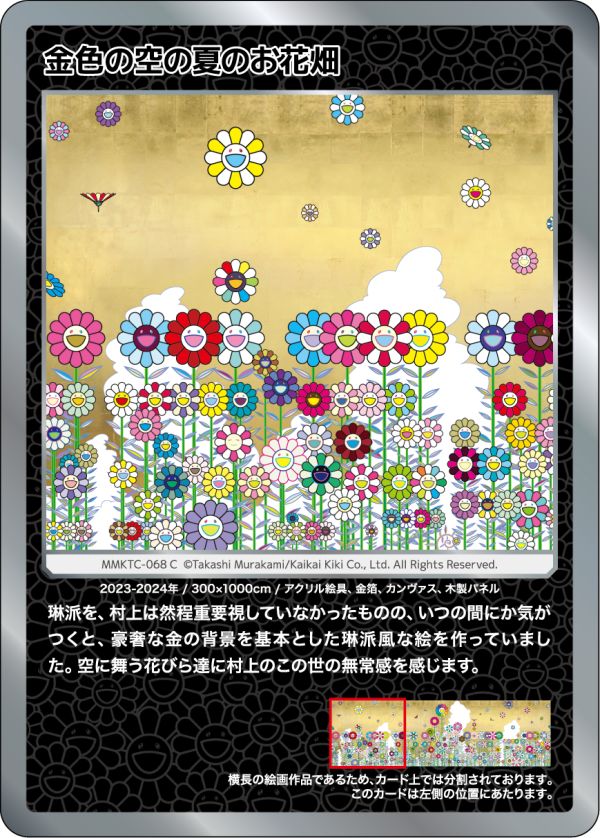

Although Murakami hadn’t considered the Rinpa school of painting to be very important, over time, he somehow found himself creating Rinpa-style paintings with opulent gold backgrounds. Murakami's sense of the impermanence of the world can be felt in the petals dancing in the sky.
As this is a horizontally long painting, it is divided into sections on the card. This card shows the left end of the painting.
2023-2024 / 300 x 1000 cm /Acrylic and gold leaf on canvas mounted on wood panel
琳派を、村上は然程重要視していなかったものの、いつの間にか気がつくと、豪奢な金の背景を基本とした琳派風な絵を作っていました。空に舞う花びら達に村上のこの世の無常感を感じます。
横長の絵画作品であるため、カード上では分割されております。このカードは左側の位置にあたります。
2023-2024年 / 300×1000cm / アクリル絵具、金箔、カンヴァス、木製パネル
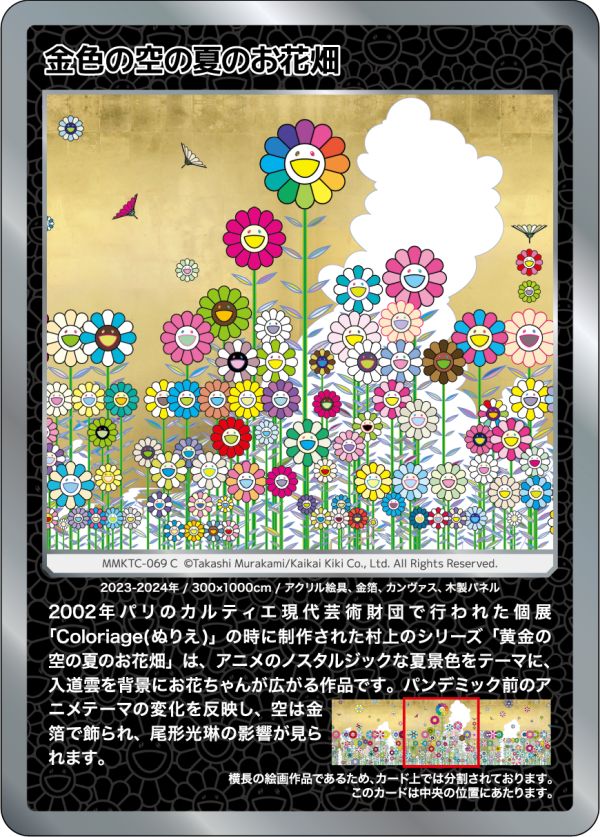

The series that includes "Summer Flower Garden in Golden Sky" was first created during Murakami’s solo exhibition, Coloriage, at the Fondation Cartier pour l'art contemporain in Paris in 2002. It is based on the theme of nostalgic summer scenes found in anime, with the Flower characters spread out against the background of cumulonimbus clouds. The sky is adorned with gold leaf, reflecting the shift in animation themes seen prior to the pandemic, shows the influence of Ogata Kōrin.
As this is a horizontally long painting, it is divided into sections on the card. This card shows the center section of the painting.
2023-2024 / 300 x 1000 cm / Acrylic and gold leaf on canvas mounted on wood panel
2002年パリのカルティエ現代芸術財団で行われた個展「Coloriage(ぬりえ)」の時に制作された村上のシリーズ「黄金の空の夏のお花畑」は、アニメのノスタルジックな夏景色をテーマに、入道雲を背景にお花ちゃんが広がる作品です。パンデミック前のアニメテーマの変化を反映し、空は金箔で飾られ、尾形光琳の影響が見られます。
横長の絵画作品であるため、カード上では分割されております。このカードは中央の位置にあたります。
2023-2024年 / 300×1000cm / アクリル絵具、金箔、カンヴァス、木製パネル


The floral motifs are derived from the Japanese painting tradition of setugekka (snow, moon, and flowers) and kachō fūgetsu (flowers, birds, wind, and the moon).
Japanese paintings have always dealt with nature, rendering the gap between the beautiful and terrible aspects of nature into art.
As this is a horizontally long painting, it is divided into sections on the card. This card shows the right end of the painting.
2023-2024 / 300 x 1000 cm /Acrylic and gold leaf on canvas mounted on wood panel
お花のモチーフは、日本絵画の伝統「雪月花」または「花鳥風月」の花に由来します。
日本の絵画は常に自然と向き合っており、自然の持つ美しい面と恐ろしい面とのギャップを芸術化したのでしょうね。
横長の絵画作品であるため、カード上では分割されております。このカードは右側の位置にあたります。
2023-2024年 / 300×1000cm / アクリル絵具、金箔、カンヴァス、木製パネル
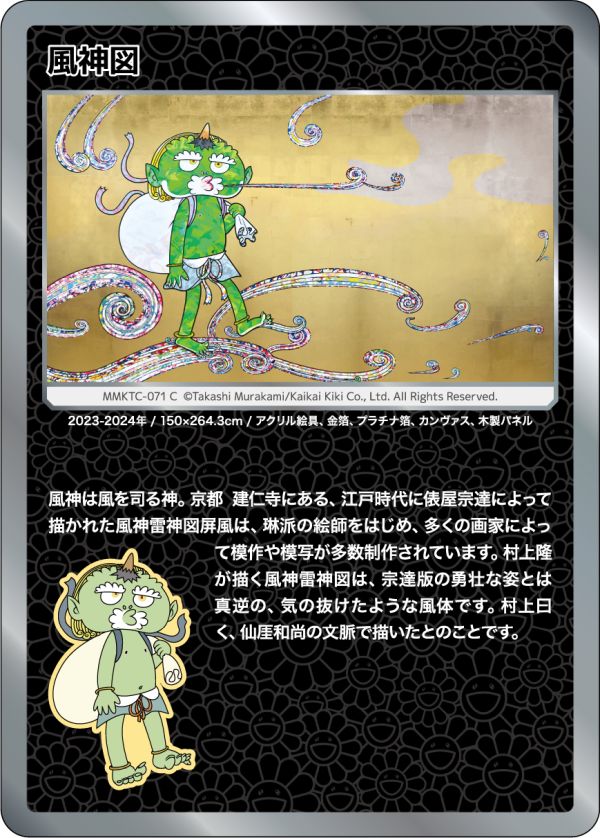

The Wind God is the god that governs wind. The Wind God and Thunder God folding screen painted by Tawaraya Sōtatsu in the Edo period at Kenninji temple in Kyoto has been copied and reproduced by many painters, including those of Rinpa school. Takashi Murakami's version of the Wind and Thunder Gods has a languid style that is the exact opposite from that of the heroic figures in Sōtatsu's version. According to Murakami, he painted his gods in the context of Zen monk Sengai Gibon’s practice.
2023-2024 / 150 x 264.3 cm /Acrylic, gold leaf, and platinum leaf on canvas mounted on wood panel
風神は風を司る神。京都 建仁寺にある、江戸時代に俵屋宗達によって描かれた風神雷神図屏風は、琳派の絵師をはじめ、多くの画家によって模作や模写が多数制作されています。村上隆が描く風神雷神図は、宗達版の勇壮な姿とは真逆の、気の抜けたような風体です。村上曰く、仙厓和尚の文脈で描いたとのことです。
2023-2024年 / 150×264.3cm / アクリル絵具、金箔、プラチナ箔、カンヴァス、木製パネル


The Thunder God is the god that governs thunder. The Wind God and Thunder God folding screen painted by Tawaraya Sōtatsu in the Edo period at Kenninji temple in Kyoto has been copied and reproduced by many painters, including those of Rinpa school. Takashi Murakami's version of the Wind and Thunder Gods has a languid style that is the exact opposite from that of the heroic figures in Sōtatsu's version. This kind of cuteness seems indispensable in order to provide solace against Japan’s sever natural disasters.
2024 / 150 × 264.3 cm / Acrylic, platinum leaf, and gold leaf on canvas mounted on wood panel
雷神は雷を司る神。京都 建仁寺にある、江戸時代に俵屋宗達によって描かれた風神雷神図屏風は、琳派の絵師をはじめ、多くの画家によって模作や模写が多数制作されています。村上隆が描く風神雷神図は、宗達版の勇壮な姿とは真逆の、気の抜けた風体です。しかし日本の厳しい自然災害を癒すにはこうした「かわいさ」は不可欠と思われます。
2024年 / 150×264.3cm / アクリル、カンヴァス、金箔、プラチナ箔、木製パネル
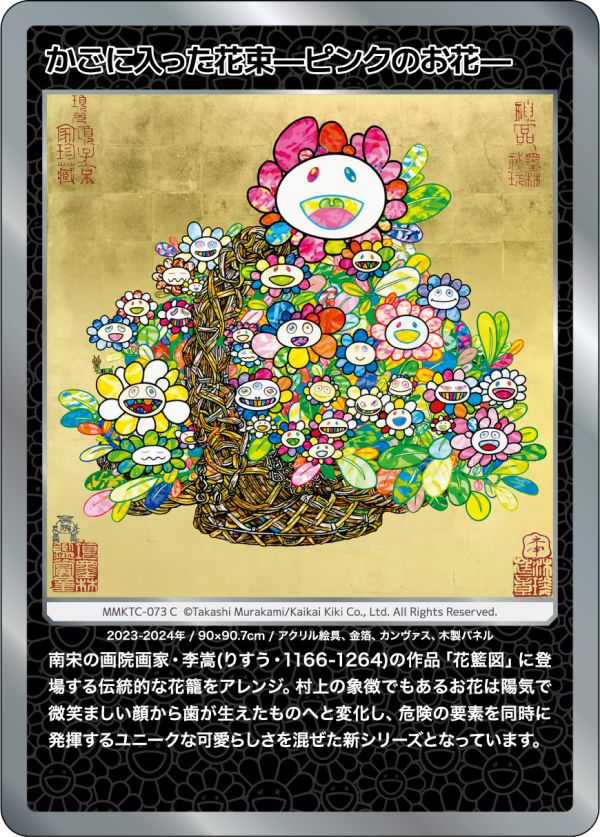

This is an arrangement of a traditional flower basket that appears in the work "Basket of Flowers" by the Southern Song dynasty painter Li Song (1166-1264). In this new series, the usual cheerful smiles on Murakami’s characteristic Flowers have transformed into to toothy ones, hinting at an element of danger mixed in with theirunique cuteness.
2024 / 90 x 90.7 cm / Acrylic and gold leaf on canvas mounted on wood panel
南宋の画院画家・李嵩(りすう・1166-1264)の作品「花籃図」に登場する伝統的な花籠をアレンジ。村上の象徴でもあるお花は陽気で微笑ましい顔から歯が生えたものへと変化し、危険の要素を同時に発揮するユニークな可愛らしさを混ぜた新シリーズとなっています。
2024年 / 90×90.7cm / アクリル、金箔、カンヴァス、木製パネル
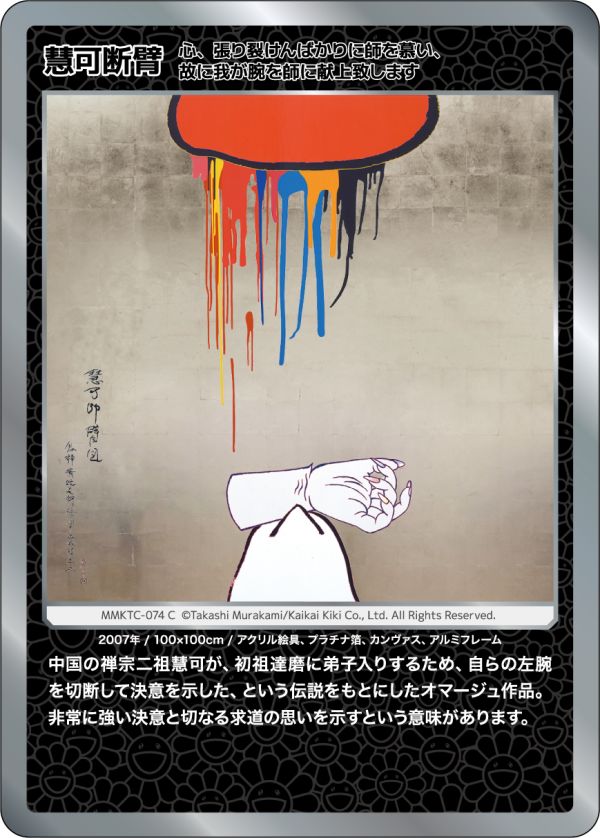

This work is a tribute to the legend that Huike, the second founder of the Zen sect in China, showed his determination to become a disciple of Daruma, the first founder of Zen Buddhism, by cutting off his own left arm. It is meant to show an extremely strong determination and earnest desire to seek enlightenment.
2007 / 100 x 100 cm / Acrylic and platinum leaf on canvas mounted on aluminum frame
中国の禅宗二祖慧可が、初祖達磨に弟子入りするため、自らの左腕を切断して決意を示した、という伝説をもとにしたオマージュ作品。非常に強い決意と切なる求道の思いを示すという意味があります。
2007 / 100 x 100 cm / アクリル絵具、プラチナ箔、カンヴァス、アルミフレーム
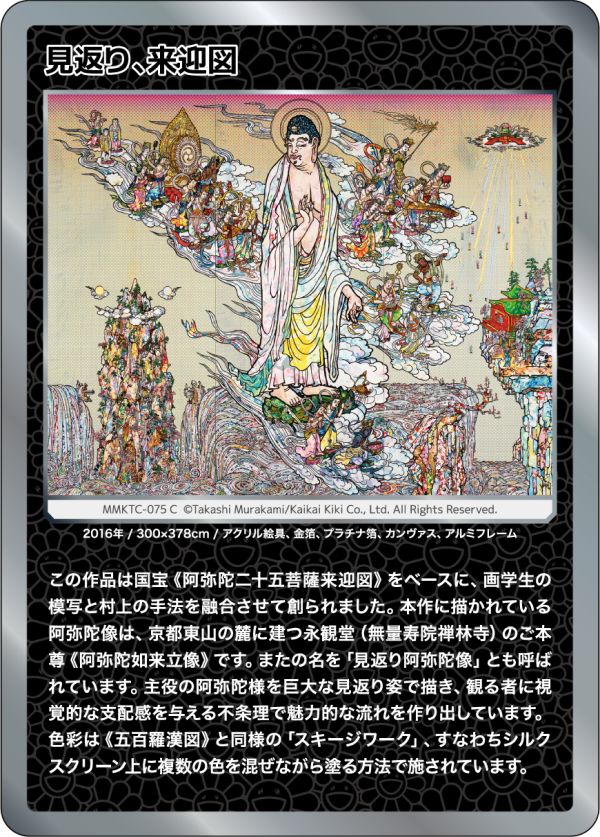

This work is based on the national treasure, "Descent of Amida and Twenty-Five Attendants", and is a fusion of a copy of the original by a staff art student and Murakami's techniques.
The Amitābha depicted in this work is the "Standing Amida Nyorai", the principal object of worship at Eikandō (Zenrin-ji Temple, Muryōju-in), which stands at the foot of Mount Higashiyama in Kyoto. It is also known as the "Amitābha Looking Back”.
The main character, Amitābha, is depicted enormously in the mikaeri (looking-back) pose, creating an absurd yet fascinating visual flow that asserts dominance over the viewer. The colors are applied using the same "squeegee work" technique used in "The 500 Arhats", where multiple colors are mixed on and applied through silk screens.
2016 / 300 x 378 cm /Acrylic, gold leaf, and platinum leaf on canvas mounted on aluminum frame
この作品は国宝《阿弥陀二十五菩薩来迎図》をベースに、画学生の模写と村上の手法を融合させて創られました。
本作に描かれている阿弥陀像は、京都東山の麓に建つ永観堂(無量寿院禅林寺)のご本尊《阿弥陀如来立像》です。またの名を「見返り阿弥陀像」とも呼ばれています。
主役の阿弥陀様を巨大な見返り姿で描き、観る者に視覚的な支配感を与える不条理で魅力的な流れを作り出しています。色彩は《五百羅漢図》と同様の「スキージワーク」、すなわちシルクスクリーン上に複数の色を混ぜながら塗る方法で施されています。
2016年 / 300×378cm / アクリル絵具、金箔、プラチナ箔、カンヴァス、アルミフレーム
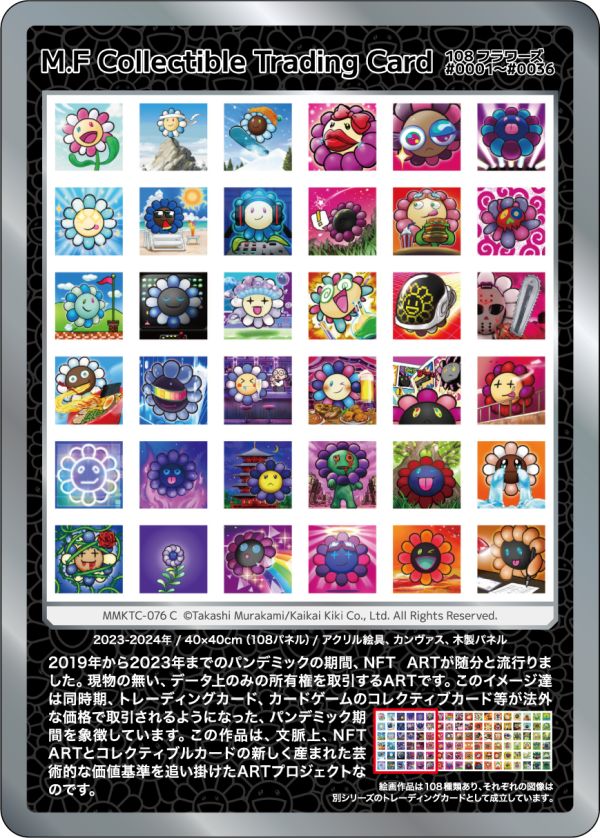

During the 2019 - 2023 pandemic, NFT art became quite popular. With NFT art, you trade ownership of digital data only, without any physical object.
These images symbolize the pandemic period during which trading cards, collectible cards from card games, etc. were traded at exorbitant prices.
Contextually, this is an art project that chases the newly emerged artistic values of NFT art and collectible cards.
2023-2024 / 40 x 40 cm (108 panels) / Acrylic on canvas mounted on wood panel
There are 108 paintings, each image of which exists as a trading card in a separate series from this one.
2019年から2023年までのパンデミックの期間、NFT ARTが随分と流行りました。現物の無い、データ上のみの所有権を取引するARTです。
このイメージ達は同時期、トレーディングカード、カードゲームのコレクティブ カード等が法外な価格で取引されるようになった、パンデミック期間を象徴しています。
この作品は、文脈上、NFT ARTとコレクティブ ルカードの新しく産まれた芸術的な価値基準を追い掛けたARTプロジェクトなのです。
絵画作品は108種類あり、それぞれの図像は別シリーズのトレーディングカードとして成立しています。
2023-2024年 / 40×40cm(108パネル) / アクリル絵具、カンヴァス、木製パネル
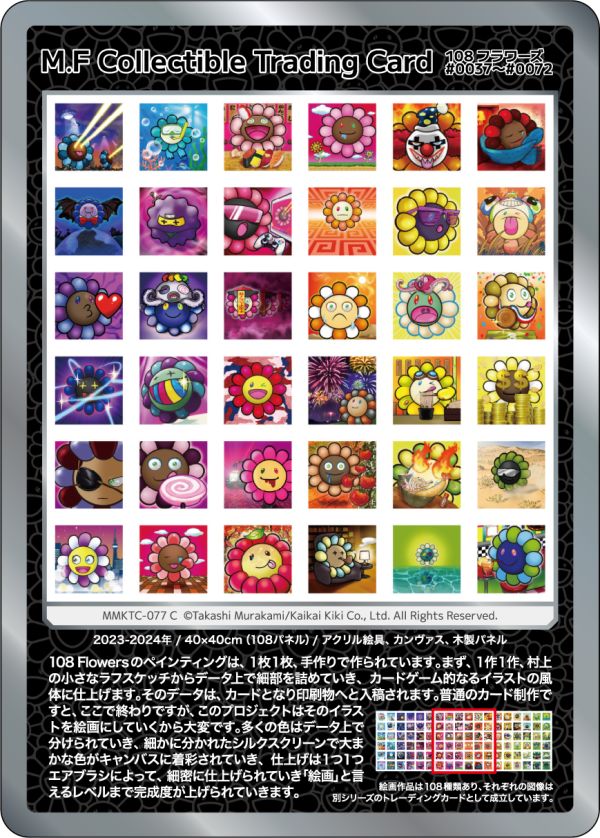

Each of the 108 Flowers paintings is produced by hand. First, each work starts with a small rough sketch by Murakami, the details of which are worked out in digital data to render them in a card-game-style illustration. The data is then submitted for printing and become a card. This is the end of the process for a normal card production, but the challenge of this project is that each illustration is then turned into a painting. The numerous colors are separated in the data, and the rough colors are applied to the canvas with silkscreens. The details are then finished off with airbrush, one by one, to a level of perfection that is worthy of a painting.
There are 108 paintings, each image of which exists as a trading card in a separate series from this one.
2023-2024 / 40 x 40 cm (108 panels) / Acrylic on canvas mounted on wood panel
108 Flowersのペインティングは、1枚1枚、手作りで作られています。まず、1作1作、村上の小さなラフスケッチからデータ上で細部を詰めていき、カードゲーム的なるイラストの風体に仕上げます。そのデータは、カードとなり印刷物へと入稿されます。普通のカード制作ですと、ここで終わりですが、このプロジェクトはそのイラストを絵画にしていくから大変です。多くの色はデータ上で分けられていき、細かに分かれたシルクスクリーンで大まかな色がキャンバスに着彩されていき、仕上げは1つ1つエアブラシによって、細密に仕上げられていき「絵画」と言えるレベルまで完成度が上げられていきます。
絵画作品は108種類あり、それぞれの図像は別シリーズのトレーディングカードとして成立しています。
2023-2024年 / 40×40cm(108パネル) / アクリル絵具、カンヴァス、木製パネル
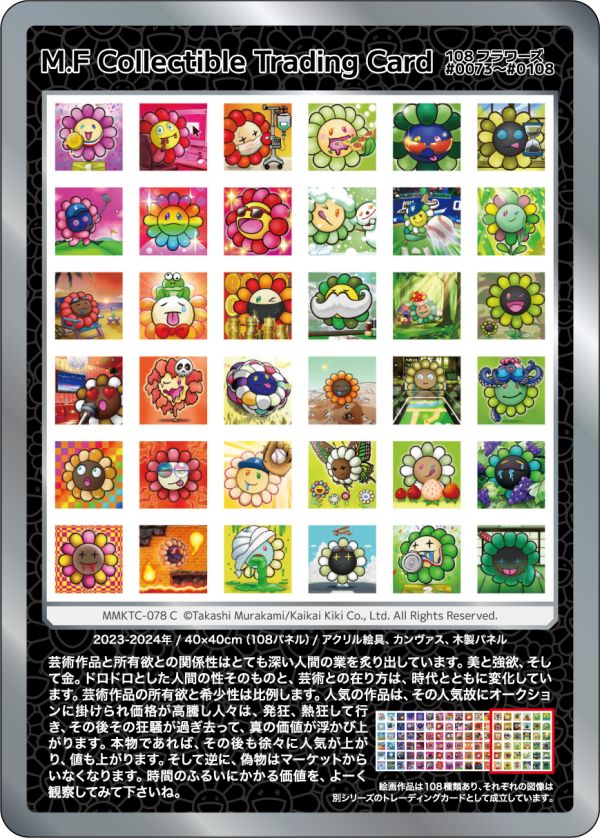

The relationship between works of art and the desire to possess them reveals a very deep human karma. Whether it pertains to beauty, greed, or money, the relationship between human nature and art has changed over time.
The desire to own a work of art is proportional to its rarity. Popular works of art are auctioned off and their prices soar because of their popularity, and people get galvanized and go into a frenzy. Once that madness subsides, the true value of the work comes into sharp relief. If the piece is authentic, its popularity will continue to gradually increase and its value will rise. Conversely, a sham will disappear from the market. Please carefully observe the values that survives the test of time.
There are 108 paintings, each image of which exists as a trading card in a separate series from this one.
2023-2024 / 40 x 40 cm (108 panels) / Acrylic on canvas mounted on wood panel
芸術作品と所有欲との関係性はとても深い人間の業を炙り出しています。美と強欲、そして金。ドロドロとした人間の性そのものと、芸術との在り方は、時代とともに変化しています。
芸術作品の所有欲と希少性は比例します。人気の作品は、その人気故にオークションに掛けられ価格が高騰し人々は、発狂、熱狂して行き、その後その狂騒が過ぎ去って、真の価値が浮かび上がります。本物であれば、その後も徐々に人気が上がり、値も上がります。そして逆に、偽物はマーケットからいなくなります。時間のふるいにかかる価値を、よーく観察してみて下さいね。
絵画作品は108種類あり、それぞれの図像は別シリーズのトレーディングカードとして成立しています。
2023-2024年 / 40×40cm(108パネル) / アクリル絵具、カンヴァス、木製パネル
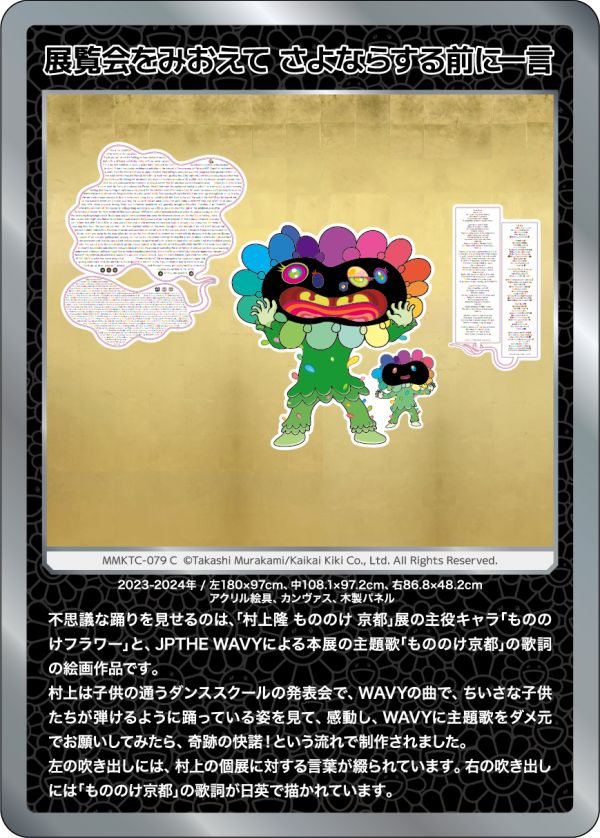

Performing the mysterious dance here is "Mononoke Flower", the lead character in the Takashi Murakami Mononoke Kyoto exhibition. This painting also includes JP THE WAVY's lyrics to the theme song for the exhibition, " Mononoke Kyoto”.
Murakami was so moved by the sight of children dancing to WAVY's music at his child’s dance school performance that he asked WAVY to write the theme song for his exhibition on the spur of the moment. The musician miraculously accepted the request, and that is how the song came to be.
The left speech bubble contains Murakami's words about the exhibition. The right speech bubble depicts the lyrics of "Mononoke Kyoto" in Japanese and English.
2023-2024 / Left: 180×97cm, Center: 108.1×97.2cm, Right: 86.8×48.2cm / Acrylic on canvas mounted on wood panel
不思議な踊りを見せるのは、「村上隆 もののけ 京都」展の主役キャラ「もののけフラワー」と、JP THE WAVYによる本展の主題歌「もののけ京都」の歌詞の絵画作品です。
村上は子供の通うダンススクールの発表会で、WAVYの曲で、ちいさな子供たちが弾けるように踊っている姿を見て、感動し、WAVYに主題歌をダメ元でお願いしてみたら、奇跡の快諾!という流れで制作されました。
左の吹き出しには、村上の個展に対する言葉が綴られています。右の吹き出しには「もののけ京都」の歌詞が日英で描かれています。
2023-2024年 / 左180×97cm,中108.1×97.2cm、右86.8×48.2cm_ アクリル絵具、カンヴァス、木製パネル
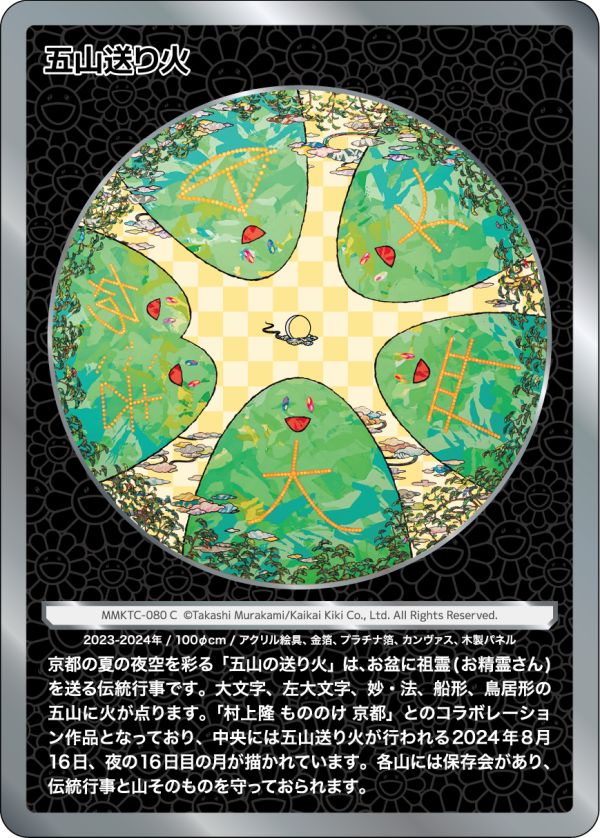

Gozan Okuribi (Bonfires on Five Mountains) is a traditional event to send off the ancestral spirits at the end of the Obon Festival. Bonfires are lit on the five mountains in the shapes of Daimonji, Left Daimonji, Myōhō, Funagata, and Torii. This painting is the event’s collaboration with Takashi Murakami Mononoke Kyoto, and the mountains depicted side by side in the tondo panel point to the location of the mountains in each direction, with the moon of the 16th night—August 16, 2024, when the Gozan Okuribi will be held—in the center. Each mountain has a preservation society that protects the traditional event and the mountain itself.
2023-2024 / φ 100cm / Acrylic, gold leaf, and platinum leaf on canvas mounted on wood panel
京都の夏の夜空を彩る「五山の送り火」は、お盆に祖霊(お精霊さん)を送る伝統行事です。大文字、左大文字、妙・法、船形、鳥居形の五山に火が点ります。「村上隆 もののけ 京都」とのコラボレーション作品となっており、中央には五山送り火が行われる2024年8月16日、夜の16日目の月が描かれています。各山には保存会があり、伝統行事と山そのものを守っておられます。
2023-2024年 / サイズ100φcm / アクリル絵具、金箔、プラチナ箔、カンヴァス、木製パネル
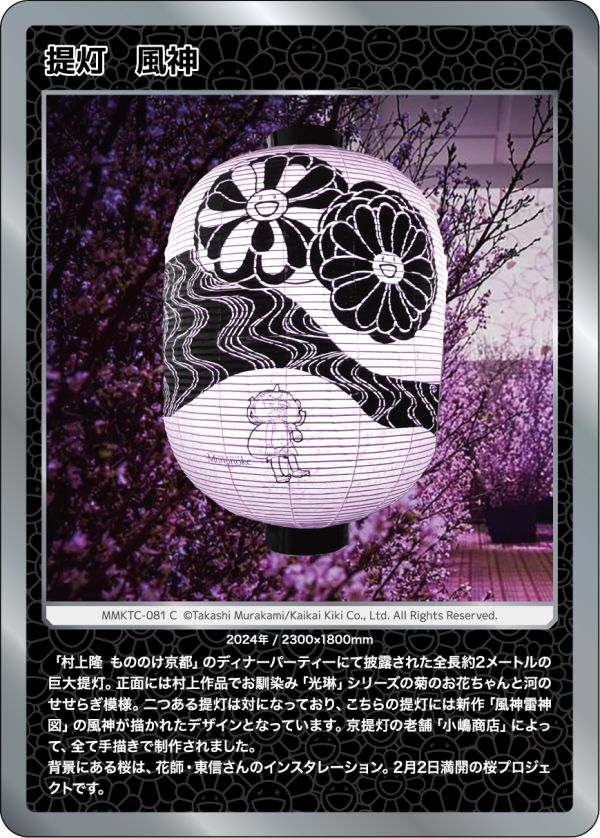

Giant lanterns about two meters in length were unveiled at the Takashi Murakami Mononoke Kyoto opening dinner party. On the front are chrysanthemum Flower characters and the flowing-river pattern from the now-familiar Murakami Kōrin series. There are two lanterns that are paired, and this one features the Wind God from Murakami’s new "Wind God” and “Thunder God" paintings. The design was entirely hand-painted by Kojima Shōten, a long-established Kyoto chōchin lantern maker.
The cherry blossoms in the background are an installation by floral artist Makoto Azuma; the cherry blossoms were in full bloom on February 2.
2024 / 2300 x 1800 mm
「村上隆 もののけ京都」のディナーパーティーにて披露された全長約2メートルの巨大提灯。正面には村上作品でお馴染み「光琳」シリーズの菊のお花ちゃんと河のせせらぎ模様。二つある提灯は対になっており、こちらの提灯には新作「風神雷神図」の風神が描かれたデザインとなっています。京提灯の老舗「小嶋商店」によって、全て手描きで制作されました。
背景にある桜は、花師・東信さんのインスタレーション。2月2日満開の桜プロジェクトです。
2024年 / 2300×1800mm
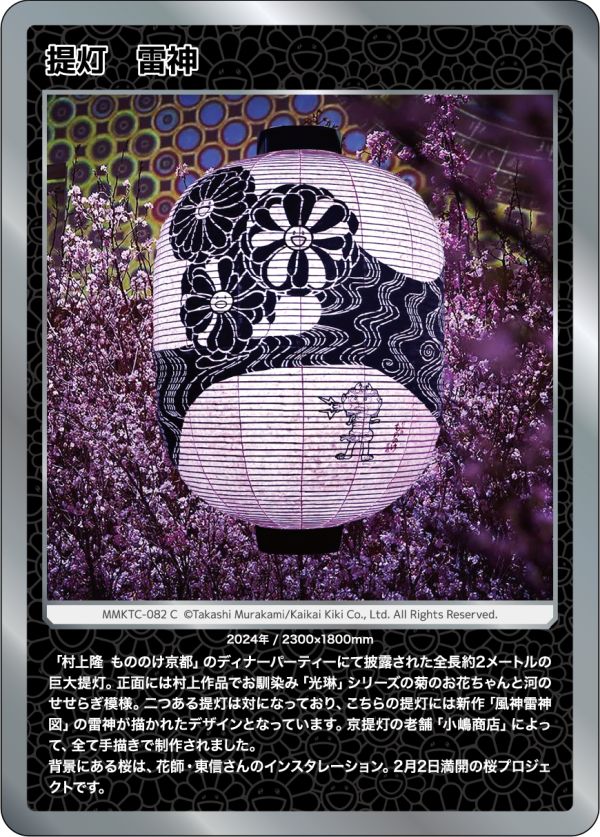

Giant lanterns about two meters in length were unveiled at the Takashi Murakami Mononoke Kyoto opening dinner party. On the front are chrysanthemum Flower characters and the flowing-river pattern from the now-familiar Murakami Kōrin series. There are two lanterns that are paired, and this one features the Thunder God from Murakami’s new "Wind God” and “Thunder God" paintings. The design was entirely hand-painted by Kojima Shōten, a long-established Kyoto chōchin lantern maker.
The cherry blossoms in the background are an installation by floral artist Makoto Azuma; the cherry blossoms were in full bloom on February 2.
2024 / 2300 x 1800 mm
「村上隆 もののけ京都」のディナーパー ティーにて披露された全長約2メートルの巨大提灯。正面には村上作品でお馴染み「光琳」シリーズの菊のお花ちゃんと河のせせらぎ模様。二つある提灯は対になっており、こちらの提灯には新作「風神雷神図」の雷神が描かれたデザインとなっています。京提灯の老舗「小嶋商店」によって、全て手描きで制作されました。
背景にある桜は、花師・東信さんのインスタレーション。2月2日満開の桜プロジェクトです。
2024年 / 2300×1800mm
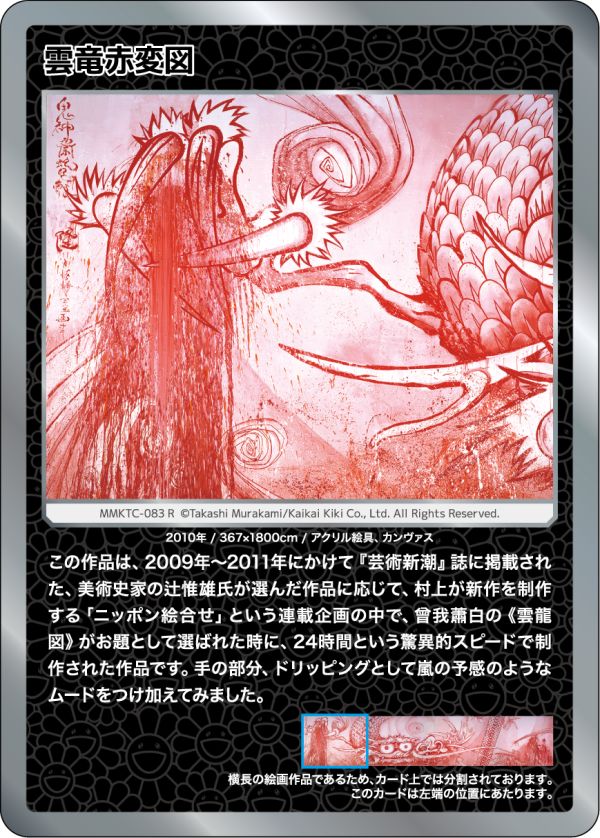

From 2009 to 2011, for each installment of a serial project in Geijutsu Shincho magazine titled "Nippon e-awase", Murakami created a new work in response to a historical artwork selected by the art historian Nobuo Tsuji. This work was completed at an astonishing speed, in 24 hours from start to finish, when Soga Shōhaku’s “Dragon and Clouds” was chosen as the theme. Murakami added a mood of a foreboding storm to the dragon’s hand in the form of dripping paint.
As this is a horizontally long painting, it is divided into sections on the cards. This card shows the left end of the painting.
2010 / 367×1800cm / Acrylic on canvas
この作品は、2009年〜2011年にかけて『芸術新潮』誌に掲載された、美術史家の辻惟雄氏が選んだ作品に応じて、村上が新作を制作する「ニッポン絵合せ」という連載企画の中で、曾我蕭白の《雲龍図》がお題として選ばれた時に、24時間という驚異的スピードで制作された作品です。手の部分、ドリッピングとして嵐の予感のようなムードをつけ加えてみました。
横長の絵画作品であるため、カード上では分割されております。このカードは左端の位置にあたります。
2010年 / 367×1800cm / アクリル絵具、カンヴァス
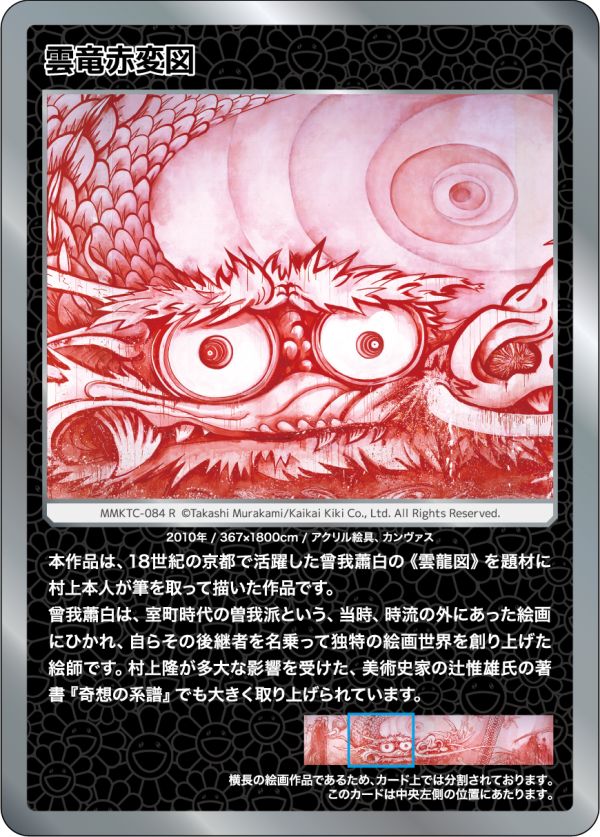

Murakami picked up the brush and painted this work himself, based on "Dragon and Clouds" by Soga Shōhaku, who was active in Kyoto in the 18th century.
Soga Shōhaku was a painter who was drawn to the Soga school of painting from the Muromachi period that was out of fashion in his time. Declaring himself its successor, he created his unique world of painting.
He is also featured prominently in the book Lineage of Eccentrics by art historian Nobuo Tsuji, who has been a major influence on Takashi Murakami.
As this is a horizontally long painting, it is divided into sections on the cards. This card shows the center-left area of the painting.
2010 / 367 x 1800 cm /Acrylic on canvas
本作品は、18世紀の京都で活躍した曾我蕭白の《雲龍図》を題材に村上本人が筆を取って描いた作品です。
曾我蕭白は、室町時代の曽我派という、当時、時流の外にあった絵画にひかれ、自らその後継者を名乗って独特の絵画世界を創り上げた絵師です。
村上隆が多大な影響を受けた、美術史家の辻惟雄氏の著書『奇想の系譜』でも大きく取り上げられています。
横長の絵画作品であるため、カード上では分割されております。このカードは中央左側の位置にあたります。
2010年 / 367×1800cm / アクリル絵具、カンヴァス
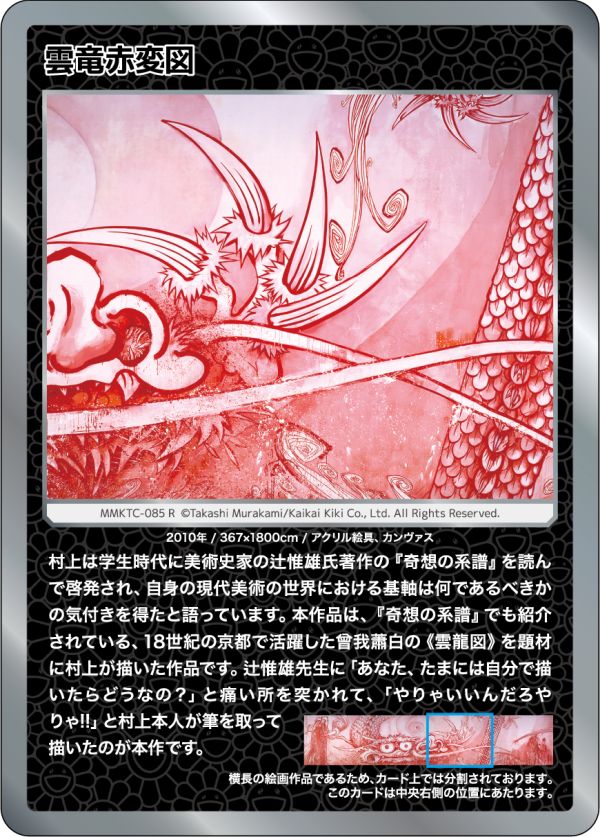

Murakami says that when he was a student, he felt enlightened after reading Lineage of Eccentrics by art historian Nobuo Tsuji, which made him realize what his own cornerstone in the contemporary art world should be.
This work is based on "Dragon and Clouds" by Soga Shōhaku, who was active in Kyoto in the 18th century and was also introduced in Lineage of Eccentrics.
Taunted by Nobuo Tsuji, “Why don't you try painting yourself for a change?” Murakami picked up the brush himself and painted this work, saying, “Fine, I’ll do it! Are you happy now?”
As this is a horizontally long painting, it is divided into sections on the cards. This card shows the center-right area of the painting.
2010 / 367cm×1800cm /Acrylic on canvas
村上は学生時代に美術史家の辻惟雄氏著作の『奇想の系譜』を読んで啓発され、自身の現代美術の世界における基軸は何であるべきかの気付きを得たと語っています。
本作品は、『奇想の系譜』でも紹介されている、18世紀の京都で活躍した曾我蕭白の《雲龍図》を題材に村上が描いた作品です。
辻惟雄先生に「あなた、たまには自分で描いたらどうなの?」と痛い所を突かれて、「やりゃいいんだろやりゃ‼︎」と村上本人が筆を取って描いたのが本作です。
横長の絵画作品であるため、カード上では分割されております。このカードは中央右側の位置にあたります。
2010年 / 367×1800cm / アクリル絵具、カンヴァス
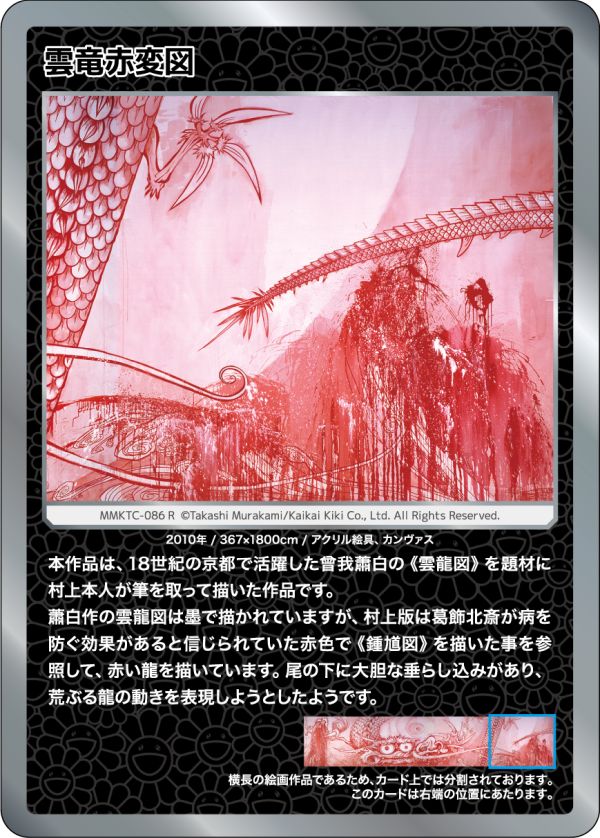

Murakami picked up the brush and painted this work himself, based on "Dragon and Clouds" by Soga Shōhaku, who was active in Kyoto in the 18th century.
While Shōhaku’s dragon is done in ink, Murakami’s version is painted in red, after Katsushika Hokusai's painting of “Zhong Kui (Shōki), the Demon Queller” also painted in red, the color believed to be effective in warding off illness. Boldly executing the tail with dripping paint, Murakami intended to express the movement of a raging dragon.
As this is a horizontally long painting, it is divided into sections on the cards. This card shows the right end of the painting.
2010 / 367 x 1800 cm /Acrylic on canvas
本作品は、18世紀の京都で活躍した曾我蕭白の《雲龍図》を題材に村上本人が筆を取って描いた作品です。
蕭白作の雲龍図は墨で描かれていますが、村上版は葛飾北斎が病を防ぐ効果があると信じられていた赤色で《鍾馗図》を描いた事を参照して、赤い龍を描いています。尾の下に大胆な垂らし込みがあり、荒ぶる龍の動きを表現しようとしたようです。
横長の絵画作品であるため、カード上では分割されております。このカードは右端の位置にあたります。
2010年 / 367×1800cm / アクリル絵具、カンヴァス
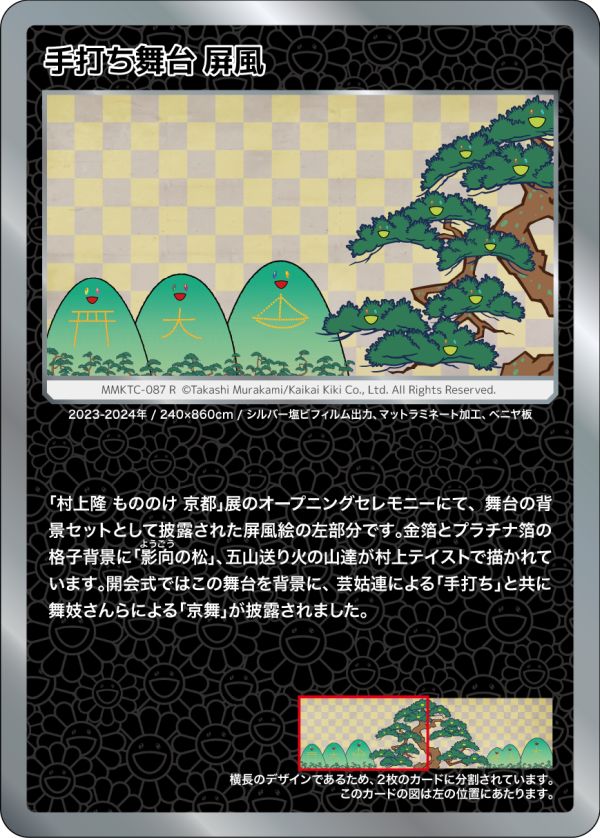

This is the left side of a folding screen that was unveiled as the backdrop for the stage at the opening ceremony of the Takashi Murakami Mononoke Kyoto exhibition. On the gold and platinum leaf checkered background, the ancient "Yōgō-no-Matsu" pine tree and the five mountains of the Gozan Okuribi are depicted in Murakami style. The opening ceremony featured a "Teuchi" performance by a group of geikos (Kyoto’s geisha), as well as Kyōmai (traditional Kyoto-style dance) by maikos on this stage.
2023-2024 / 240 x 860 cm / Silver vinyl chloride film printout, matte laminate, plywood
As this is a horizontally design, it is divided into two cards. This card shows the left side of the design.
「村上隆 もののけ 京都」展のオープニングセレモニーにて、舞台の背景セットとして披露された屏風絵の左部分です。金箔とプラチナ箔の格子背景に「影向(ようごう)の松」、五山送り火の山達が村上テイストで描かれています。開会式ではこの舞台を背景に、芸姑連による「手打ち」と共に舞妓さんらによる「京舞」が披露されました。
2023-2024年 / 240×860cm / シルバー塩ビフィルム出力、マットラミネート加工、ベニヤ板
横長のデザインであるため、2枚のカードに分割されています。
このカードの図は左の位置にあたります。
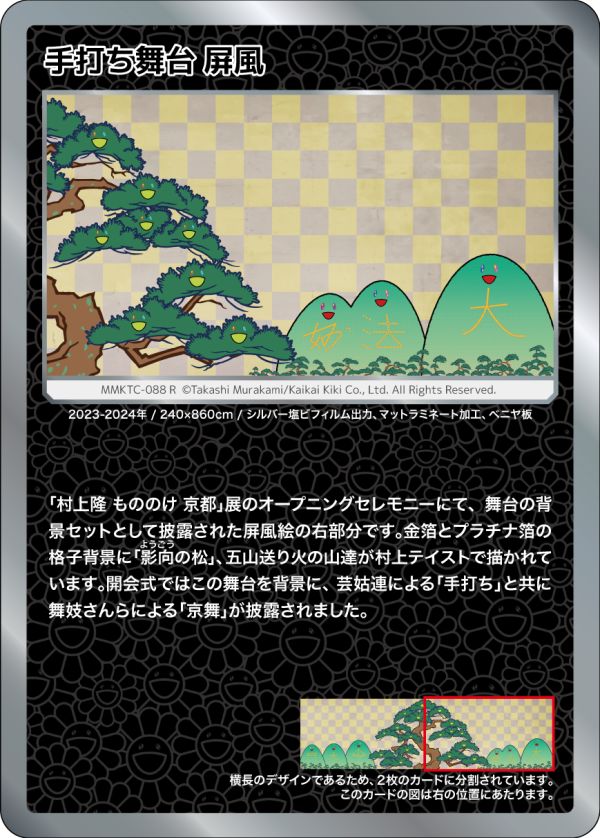

This is the right side of a folding screen that was unveiled as the backdrop for the stage at the opening ceremony of the Takashi Murakami Mononoke Kyoto exhibition. On the gold and platinum leaf checkered background, the ancient "Yōgō-no-Matsu" pine tree and the five mountains of the Gozan Okuribi are depicted in Murakami style. The opening ceremony featured a "Teuchi" performance by a group of geikos (Kyoto’s geisha), as well as Kyōmai (traditional Kyoto-style dance) by maikos on this stage.
2023-2024 / 240×860cm / Silver vinyl chloride film printout, matte laminate, plywood
As this is a horizontally long design, it is divided into two cards. This card shows the right side of the design.
「村上隆 もののけ 京都」展のオープニングセレモニーにて、舞台の背景セットとして披露された屏風絵の右部分です。金箔とプラチナ箔の格子背景に「影向(ようごう)の松」、五山送り火の山達が村上テイストで描かれています。開会式ではこの舞台を背景に、芸姑連による「手打ち」と共に舞妓さんらによる「京舞」が披露されました。
2023-2024年 / 240×860cm / シルバー塩ビフィルム出力、マットラミネート加工、ベニヤ板
横長のデザインであるため、2枚のカードに分割されています。
このカードの図は右の位置にあたります。
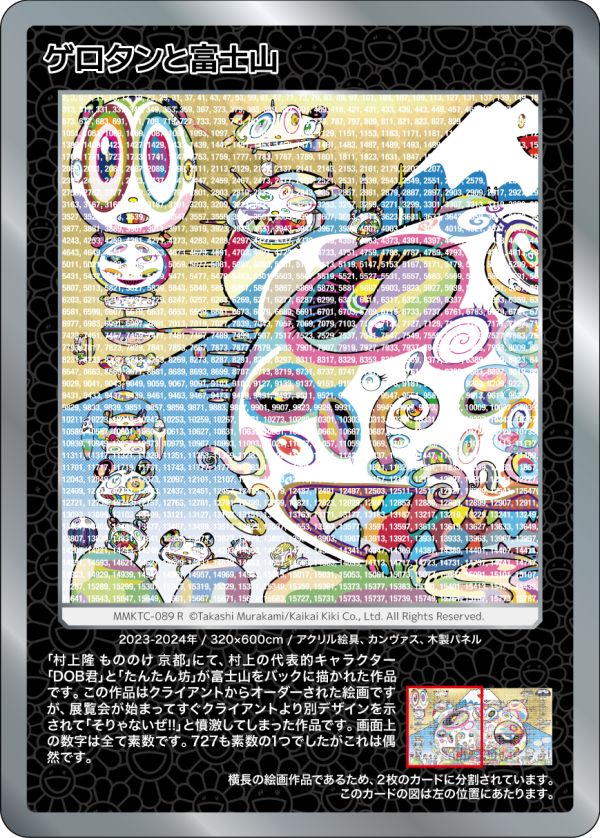

This is a painting from the exhibition Takashi Murakami Mononoke Kyoto in which Murakami's signature characters Mr. DOB and Tan Tan Bo are painted against the backdrop of Mt. Fuji. A client had ordered this work, but as soon as the exhibition opened, the client asked Murakami to go with a different design, making the artist furious at the unreasonable demand.
All the numbers on the surface of the painting are prime numbers. 727 is one of them, but by pure coincidence.
2023-2024 / 320 x 600 cm / Acrylic on canvas mounted on wood panel
As this is a horizontally long painting, it is divided into two cards. This card shows the left side of the painting.
「村上隆 もののけ 京都」にて、村上の代表的キャラクター「DOB君」と「たんたん坊」が富士山をバックに描かれた作品です。この作品はクライアントからオーダーされた絵画ですが、展覧会が始まってすぐクライアントより別デザインを示されて「そりゃないぜ!!」と憤激してしまった作品です。
画面上の数字は全て素数です。 727も素数の1つでしたがこれは偶然です。
2023-2024年 / 320×600cm / アクリル絵具、カンヴァス、木製パネル
横長の絵画作品であるため、カード上では分割されております。
このカードは左の位置にあたります。
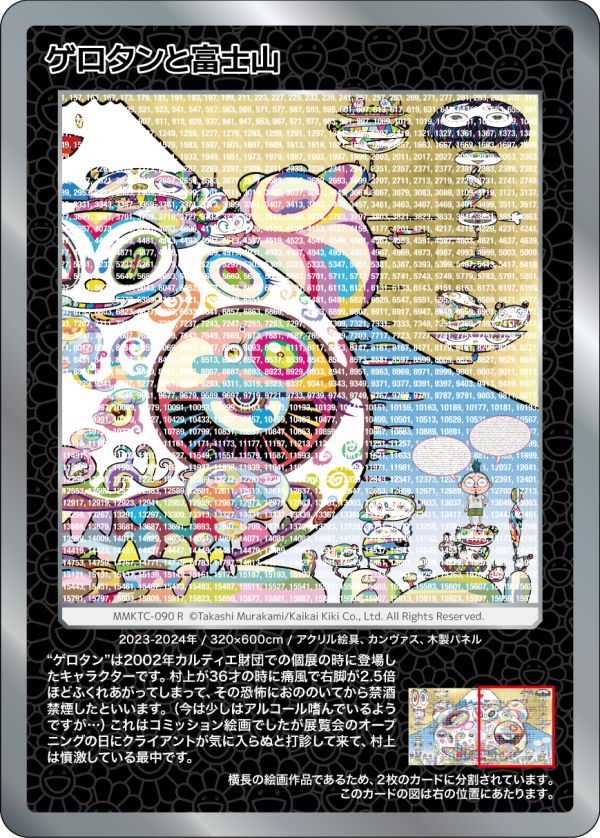

Gerotan is a character that was first introduced at Murakami’s solo exhibition at Fondation Cartier in 2002. When Murakami was 36 years old, his right leg swelled up to 2.5 times its normal size due to gout and, in horror, he gave up drinking and smoking (though he does seem to drink a little now…).
This one was a commissioned painting, but on the opening day of the Kyoto exhibition, the client reached out to say he was not pleased with it, and Murakami is now in the midst of infuriation.
2023-2024 / 320 x 600 cm / Acrylic on canvas mounted on wood panel
As this is a horizontally long painting, it is divided into two cards. This card shows the right side of the painting.
“ゲロタン”は2002年カルティエ財団での個展の時に登場したキャラクターです。村上が36才の時に痛風で右脚が2.5倍ほどふくれあがってしまって、その恐怖におののいてから禁酒禁煙したといいます。(今は少しはアルコール嗜んでいるようですが…)
これはコミッション絵画でしたが展覧会のオープニングの日にクライアントが気に入らぬと打診して来て、村上は憤激している最中です。
2023-2024年 / 320×600cm / アクリル絵具、カンヴァス、木製パネル
横長の絵画作品であるため、カード上では分割されております。
このカードは右の位置にあたります。
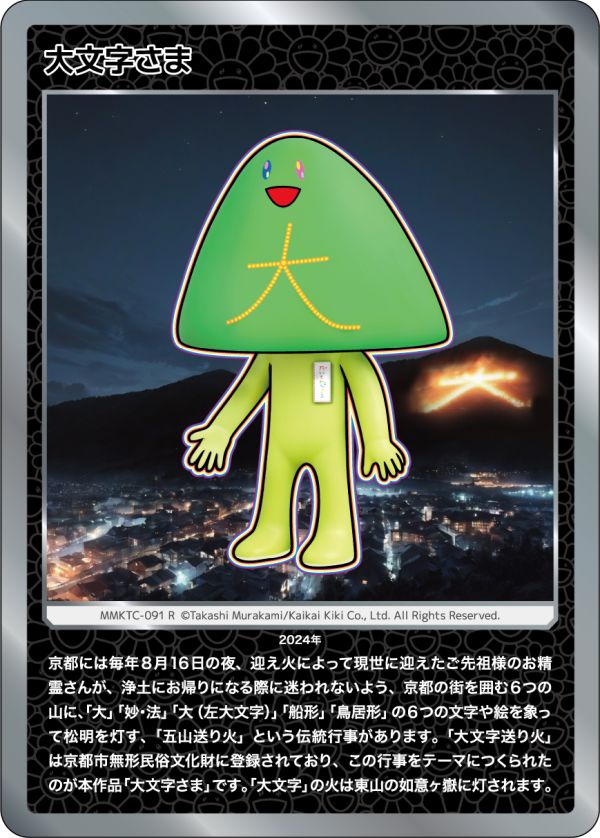

Every year on the night of August 16, a traditional event takes place in Kyoto called Gozan Okuribi. In order so that the spirits of the ancestors who had been welcomed back to this world with the welcome fire earlier in the month can return to the Pure Land without getting lost, torches are lit on the six mountains surrounding the city of Kyoto in the shapes of six Chinese characters or pictures: “Dai (great),” “Myō-Hō (Buddha’s remarkable teaching),” another “Dai” (or “Hidari Daimonji (Daimonji on the left)”), “Funagata (ship form),” and “Toriigata (shrine gate form).” The Daimonji bonfire (“Dai”) is registered as an Intangible Folk Cultural Property of Kyoto City, and this work, “Daimonji-sama”, was created with this event as its theme. The Daimonji fire is lit on Mt. Nyoigatake on the east.
2024
京都には毎年8月16日の夜、迎え火によって現世に迎えたご先祖様のお精霊さんが、浄土にお帰りになる際に迷われないよう、京都の街を囲む6つの山に、「大」「妙・法」「大(左大文字)」「船形」「鳥居形」の6つの文字や絵を象って松明を灯す、「五山送り火」という伝統行事があります。「大文字送り火」は京都市無形民俗文化財に登録されており、この行事をテーマにつくられたのが本作品「大文字さま」です。「大文字」の火は東山の如意ヶ嶽に灯されます。
2024年
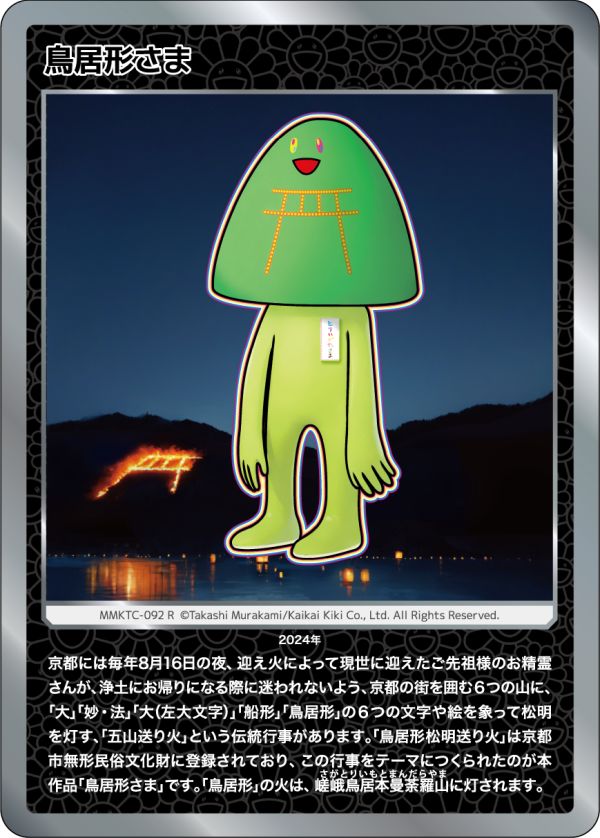

Every year on the night of August 16, a traditional event takes place in Kyoto called Gozan Okuribi. In order so that the spirits of the ancestors who had been welcomed back to this world with the welcome fire earlier in the month can return to the Pure Land without getting lost, torches are lit on the six mountains surrounding the city of Kyoto in the shapes of six Chinese characters or pictures: “Dai (great),” “Myō-Hō (Buddha’s remarkable teaching),” another “Dai” (or “Hidari Daimonji (Daimonji on the left)”), “Funagata (ship form),” and “Toriigata (shrine gate form).” The Toriigata Taimatsu bonfire is registered as an Intangible Folk Cultural Property of Kyoto City, and this work, “Toriigata-sama”, was created with this event as its theme. The Toriigata fire is lit on Mt. Mandara in Saga Toriimoto.
2024
京都には毎年8月16日の夜、迎え火によって現世に迎えたご先祖様のお精霊さんが、浄土にお帰りになる際に迷われないよう、京都の街を囲む6つの山に、「大」「妙・法」「大(左大文字)」「船形」「鳥居形」の6つの文字や絵を象って松明を灯す、「五山送り火」という伝統行事があります。「鳥居形松明送り火」は京都市無形民俗文化財に登録されており、この行事をテーマにつくられたのが本作品「鳥居形さま」です。「鳥居形」の火は、嵯峨鳥居本(さがとりいもと)曼荼羅山(まんだらやま)に灯されます。
2024年
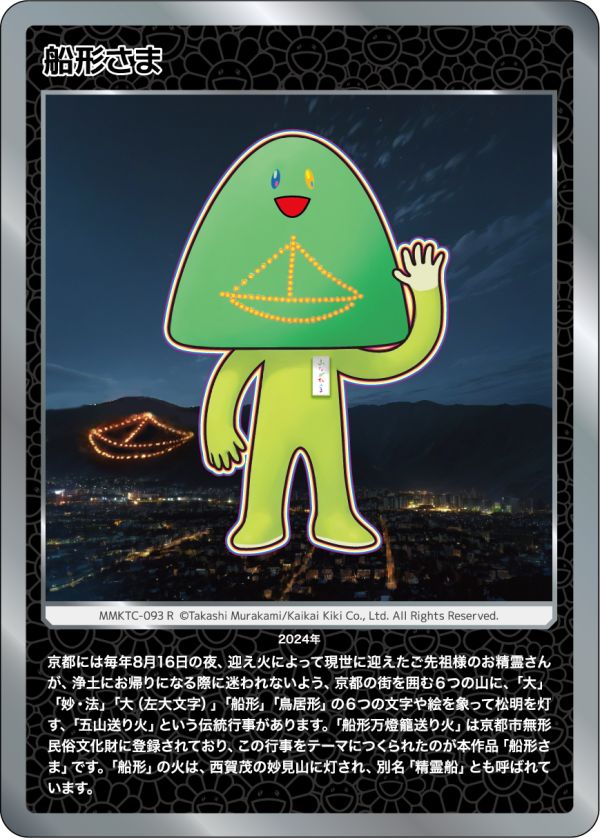

Every year on the night of August 16, a traditional event takes place in Kyoto called Gozan Okuribi. In order so that the spirits of the ancestors who had been welcomed back to this world with the welcome fire earlier in the month can return to the Pure Land without getting lost, torches are lit on the six mountains surrounding the city of Kyoto in the shapes of six Chinese characters or pictures: “Dai (great),” “Myō-Hō (Buddha’s remarkable teaching),” another “Dai” (or “Hidari Daimonji (Daimonji on the left)”), “Funagata (ship form),” and “Toriigata (shrine gate form).” The Funagata Mantōroō bonfire is registered as an Intangible Folk Cultural Property of Kyoto City, and this work, “Funagata-sama”, was created with this event as its theme.
The Funagata fire is lit on Funa-yama in Nishigamo and is also known as the “Spirit Boat”.
2024
京都には毎年8月16日の夜、迎え火によって現世に迎えたご先祖様のお精霊さんが、浄土にお帰りになる際に迷われないよう、京都の街を囲む6つの山に、「大」「妙・法」「大(左大文字)」「船形」「鳥居形」の6つの文字や絵を象って松明を灯す、「五山送り火」という伝統行事があります。「船形万燈籠送り火」は京都市無形民俗文化財に登録されており、この行事をテーマにつくられたのが本作品「船形さま」です。「船形」の火は、西賀茂の妙見山に灯され、別名「精霊船」とも呼ばれています。
2024年
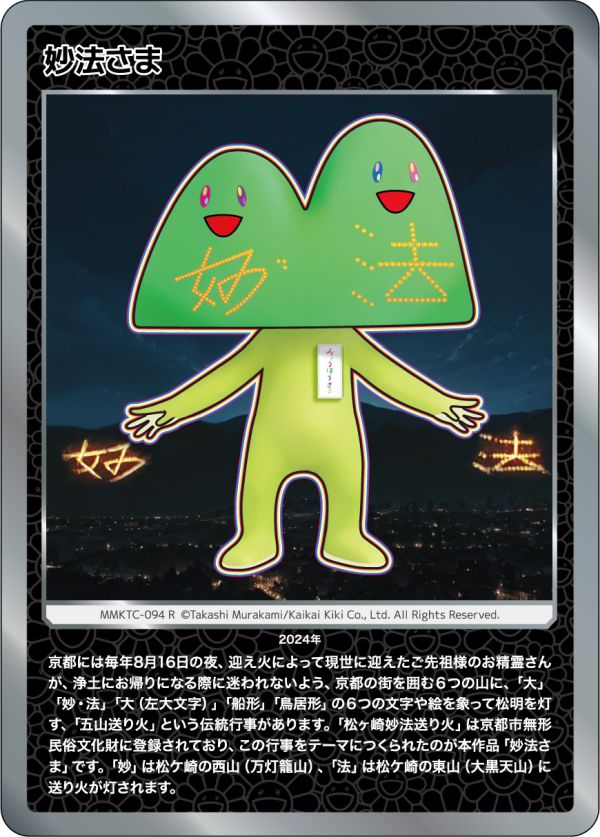

Every year on the night of August 16, a traditional event takes place in Kyoto called Gozan Okuribi. In order so that the spirits of the ancestors who had been welcomed back to this world with the welcome fire earlier in the month can return to the Pure Land without getting lost, torches are lit on the six mountains surrounding the city of Kyoto in the shapes of six Chinese characters or pictures: “Dai (great),” “Myō-Hō (Buddha’s remarkable teaching),” another “Dai” (or “Hidari Daimonji (Daimonji on the left)”), “Funagata (ship form),” and “Toriigata (shrine gate form).” The Matsugasaki Myoho bonfires are registered as an Intangible Folk Cultural Property of Kyoto City, and this work, “Myōhō-sama”, was created with this event as its theme.
The bonfires are lit on the west mountain of Matsugasaki (Mt. Mantōrō) for “Myō” and on the east mountain of Matsugasaki (Mt. Daikokuten) for “Hō”.
2024
京都には毎年8月16日の夜、迎え火によって現世に迎えたご先祖様のお精霊さんが、浄土にお帰りになる際に迷われないよう、京都の街を囲む6つの山に、「大」「妙・法」「大(左大文字)」「船形」「鳥居形」の6つの文字や絵を象って松明を灯す、「五山送り火」という伝統行事があります。「松ヶ崎妙法送り火」は京都市無形民俗文化財に登録されており、この行事をテーマにつくられたのが本作品「妙法さま」です。「妙」は松ケ崎の西山(万灯籠山)、「法」は松ケ崎の東山(大黒天山)に送り火が灯されます。
2024年
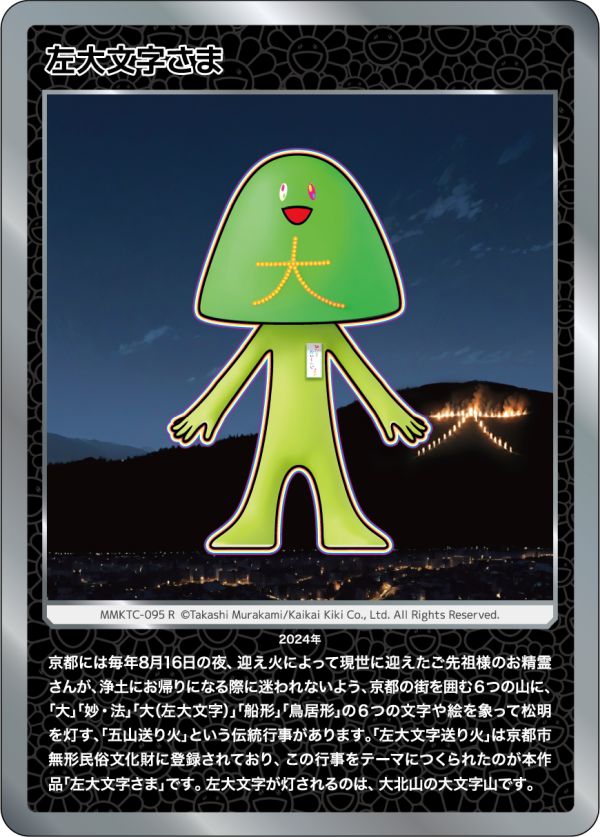

Every year on the night of August 16, a traditional event takes place in Kyoto called Gozan Okuribi. In order so that the spirits of the ancestors who had been welcomed back to this world with the welcome fire earlier in the month can return to the Pure Land without getting lost, torches are lit on the six mountains surrounding the city of Kyoto in the shapes of six Chinese characters or pictures: “Dai (great),” “Myō-Hō (Buddha’s remarkable teaching),” another “Dai” (or “Hidari Daimonji (Daimonji on the left)”), “Funagata (ship form),” and “Toriigata (shrine gate form).” The Hidari Daimonji bonfire is registered as an Intangible Folk Cultural Property of Kyoto City, and this work, “Hidari Daimonji-sama”, was created with this event as its theme. The Hidari Daimonji fire is lit on Ohkitayama.
2024
京都には毎年8月16日の夜、迎え火によって現世に迎えたご先祖様のお精霊さんが、浄土にお帰りになる際に迷われないよう、京都の街を囲む6つの山に、「大」「妙・法」「大(左大文字)」「船形」「鳥居形」の6つの文字や絵を象って松明を灯す、「五山送り火」という伝統行事があります。「左大文字送り火」は京都市無形民俗文化財に登録されており、この行事をテーマにつくられたのが本作品「左大文字さま」です。左大文字が灯されるのは、大北山の大文字山です。
2024年
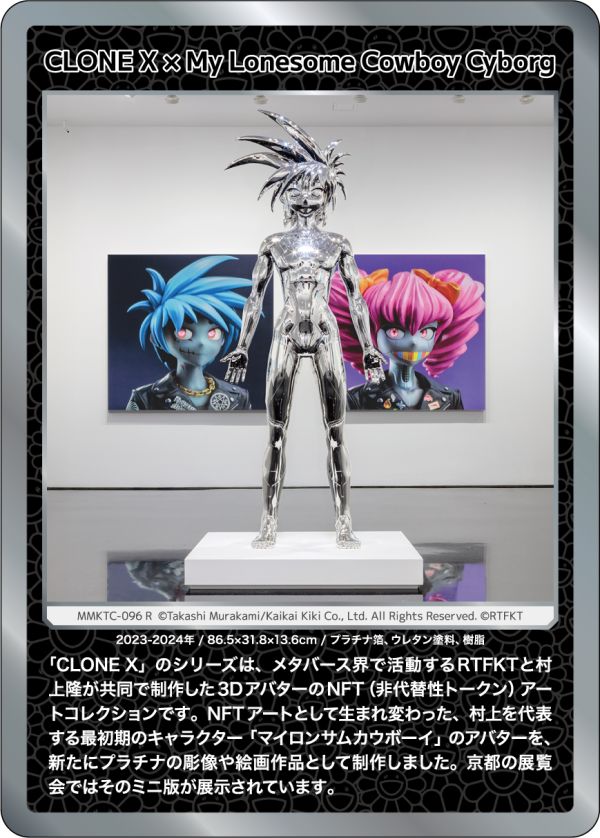

The Clone X series is a collection of NFT (non-fungible token) art of 3D avatars created by RTFKT and Takashi Murakami, both active in the metaverse, in collaboration. The avatar of one of Murakami's earliest and most iconic characters, My Lonesome Cowboy, reborn as NFT art, has now been created anew as a platinum statue and paintings. A miniature version of this work is on display at the exhibition in Kyoto.
2023-2024 / 86.5 x 31.8 x 13.6 cm /Platinum leaf, urethane paint, and resin
「CLONE X」のシリーズは、メタバース界で活動するRTFKTと村上隆が共同で制作した3DアバターのNFT(非代替性トークン)アートコレクションです。NFTアートとして生まれ変わった、村上を代表する最初期のキャラクター「マイロンサムカウボーイ」のアバターを、新たにプラチナの彫像や絵画作品として制作しました。京都の展覧会ではそのミニ版が展示されています。
2023-2024年 / 86.5×31.8×13.6cm / プラチナ箔、ウレタン塗料、樹脂
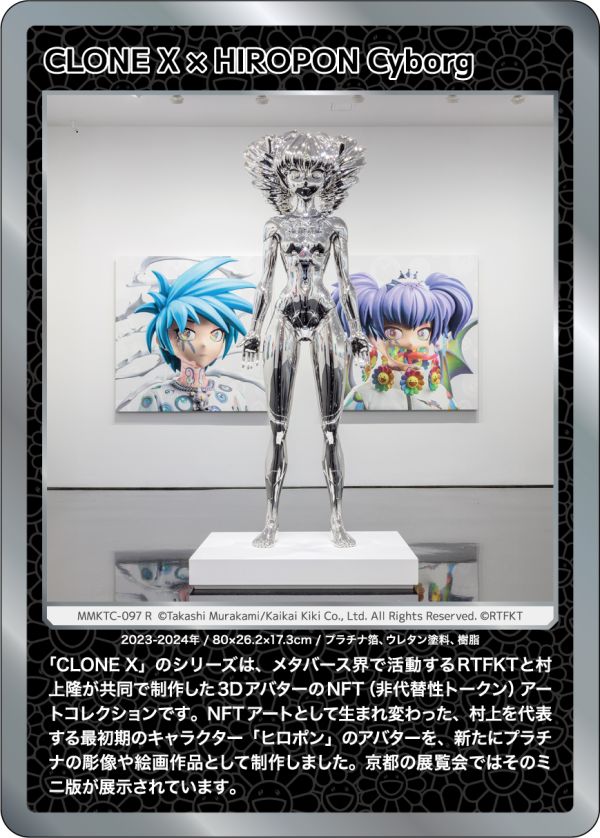

The Clone X series is a collection of NFT (non-fungible token) art of 3D avatars created by RTFKT and Takashi Murakami, both active in the metaverse, in collaboration. The avatar of one of Murakami's earliest and most iconic characters, Hiropon, reborn as NFT art, has now been created anew as a platinum statue and paintings. A miniature version of this work is on display at the exhibition in Kyoto.
2023-2024 / 80 x 26.2 x 17.3cm / Platinum leaf, urethane paint, and resin
「CLONE X」のシリーズは、メタバース界で活動するRTFKTと村上隆が共同で制作した3DアバターのNFT(非代替性トークン)アートコレクションです。NFTアートとして生まれ変わった、村上を代表する最初期のキャラクター「ヒロポン」のアバターを、新たにプラチナの彫像や絵画作品として制作しました。京都の展覧会ではそのミニ版が展示されています。
2023-2024年 / 80×26.2×17.3cm / プラチナ箔、ウレタン塗料、樹脂
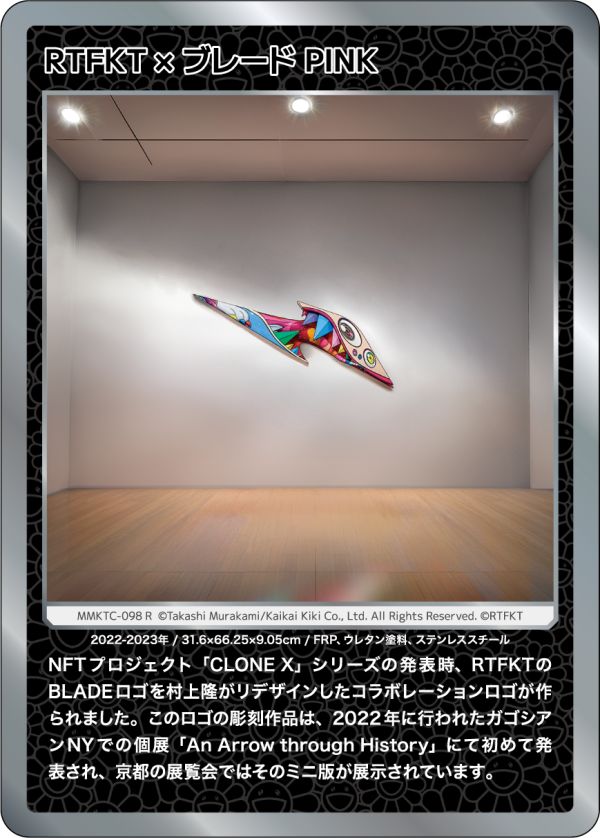

At the time of the launch of the NFT project, Clone X, Takashi Murakami redesigned RTFKT’s Blade logo and created a collaborative logo. A sculptural version of this logo was first presented at Gagosian NY in 2022 in Murakami’s solo exhibition, An Arrow through History, and a miniature version is exhibited at the Kyoto exhibition.
2022-2023 / 31.6 x 66.25 x 9.05 cm / FRP, urethane paint, and stainless steel
NFTプロジェクト「CLONE X」シリーズの発表時、RTFKTのBLADEロゴを村上隆がリデザインしたコラボレーションロゴが作られました。このロゴの彫刻作品は、2022年に行われたガゴシアンNYでの個展「An Arrow through History」にて初めて発表され、京都の展覧会ではそのミニ版が展示されています。
2022-2023年 / 31.6×66.25×9.05cm / FRP、ウレタン塗料、ステンレススチール


6HP is a majokko (magical girl)-genre animation project directed by Murakami with two heroines, Pink Princess and Black Princess. This character is Black Princess, whose name is Tamaki.
The work explores the possibilities of the Japanese majokko genre and aims to bridge the gap between otaku culture and Western art.
This painting is part of a pair with a corresponding painting.
2024 / 210 × 70.5 cm / Acrylic and glitter on canvas mounted on aluminum frame
「6HP」は村上が監督する魔女っ子アニメ企画で、ヒロインはピンク・プリンセスとブラック・プリンセスの2人です。このキャラクターはブラック・プリンセスです。“たまき”という名前です。
日本の魔女っ子ジャンルの可能性を探求し、オタク文化と西洋アートの橋渡しを目指す作品です。
この絵画は、ペアである絵画と対をなしている作品になります。
2024年 / 210×70.5cm / アクリル、グリッター、カンヴァス、アルミフレーム


6HP is a majokko (magical girl)-genre animation project directed by Murakami with two heroines, Pink Princess and Black Princess. This character is Pink Princess, whose name is Haruka.
Started in 2010, the 12-episode animation production is scheduled for completion in 2024. The project explores the possibilities of the Japanese majokko genre and aims to bridge the gap between otaku culture and Western art.
This painting is part of a pair with a corresponding painting.
2024 / 210 x 70.5 cm / Acrylic, gold leaf, and platinum leaf on canvas mounted on aluminum frame
「6HP」は村上が監督する魔女っ子アニメ企画で、ヒロインはピンク・プリンセスとブラック・プリンセスの2人です。そのピンク・プリンセスがこちら。“はるか”という名前です。
日本の魔女っ子ジャンルの可能性を深掘りして、オタク文化と西洋アートの橋渡しを目指すプロジェクトです。
この絵画は、ペアである絵画と対をなしている作品になります。
2024年 / 210×70.5cm / アクリル、金箔、プラチナ箔、カンヴァス、アルミフレーム
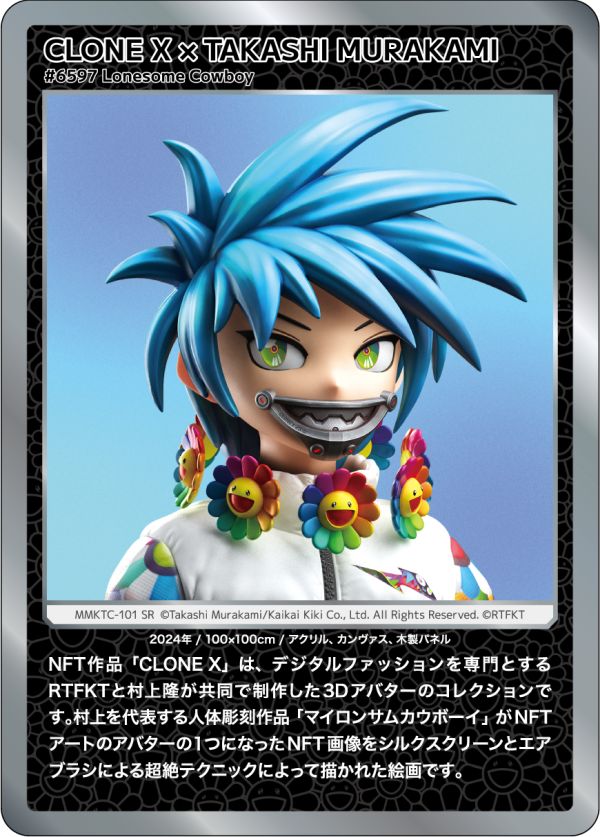

The CLONE X NFT is a collection of 3D avatars created by RTFKT, a digital fashion specialist, in collaboration with Takashi Murakami. My Lonesome Cowboy, Murakami's signature figure sculpture, has become one of the NFT avatars and, in this work, Murakami has depicted its NFT image as a painting utilizing superb silkscreen and airbrush techniques.
2024 / 100 × 100 cm / Acrylic on canvas mounted on wood panel
NFT作品「CLONE X」は、デジタルファッションを専門とするRTFKTと村上隆が共同で制作した3Dアバターのコレクションです。村上を代表する人体彫刻作品「マイロンサムカウボーイ」がNFTアートのアバターの1つになったNFT画像をシルクスクリーンとエアブラシによる超絶テクニックによって描かれた絵画です。
2024年 / 100×100cm / アクリル、カンヴァス、木製パネル
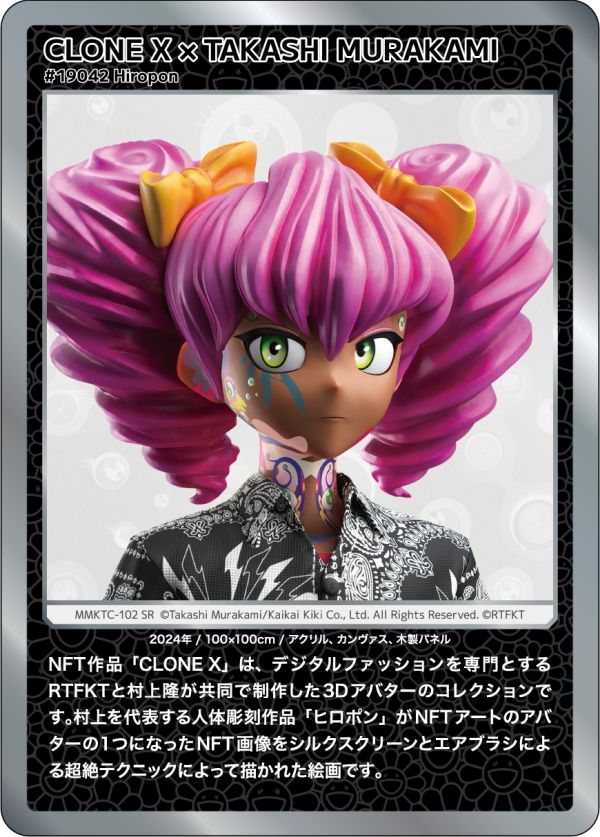

The CLONE X NFT is a collection of 3D avatars created by RTFKT, a digital fashion specialist, in collaboration with Takashi Murakami. Hiropon, Murakami's signature figure sculpture, has become one of the NFT avatars and, in this work, Murakami has depicted its NFT image as a painting utilizing superb silkscreen and airbrush techniques.
2024 / 100 × 100 cm / Acrylic on canvas mounted on wood panel
NFT作品「CLONE X」は、デジタルファッションを専門とするRTFKTと村上隆が共同で制作した3Dアバターのコレクションです。村上を代表する人体彫刻作品「ヒロポン」がNFTアートのアバターの1つになったNFT画像をシルクスクリーンとエアブラシによる超絶テクニックによって描かれた絵画です。
2024年 / 100×100cm / アクリル、カンヴァス、木製パネル
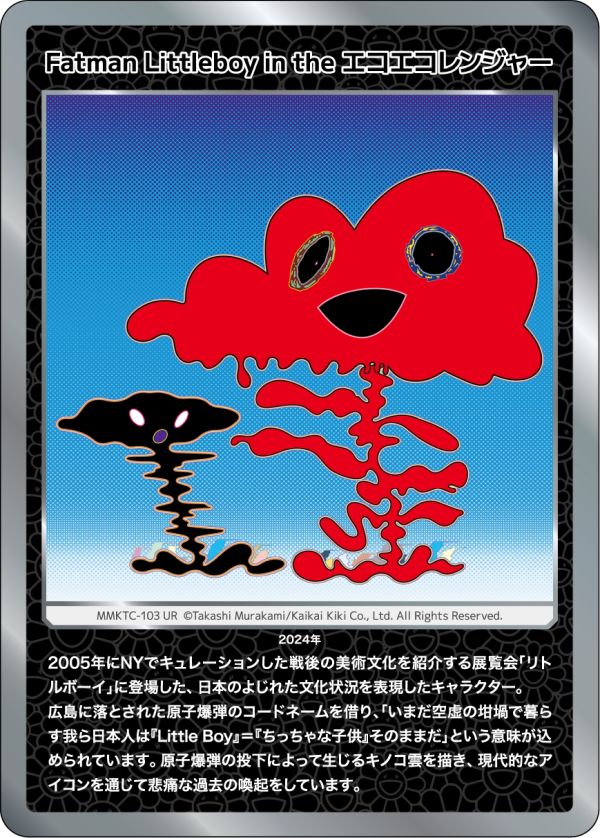

These characters were featured in Little Boy, an exhibition of Japanese postwar art and culture that Murakami curated in New York in 2005, and they embody the contorted state of Japanese culture. Borrowing the code name of the atomic bomb dropped on Hiroshima, the Little Boy character is imbued with the sense that "We Japanese, who still live in the crucible of emptiness, are just like a little child.” Through the depiction of the mushroom cloud created by the atomic bombing, Murakami evokes the tragic past through this contemporary icon.
2024
2005年にNYでキュレーションした戦後の美術文化を紹介する展覧会「リトルボーイ」に登場した、日本のよじれた文化状況を表現したキャラクター。広島に落とされた原子爆弾のコードネームを借り、「いまだ空虚の坩堝で暮らす我ら日本人は『Little Boy』=『ちっちゃな子供』そのままだ」という意味が込められています。原子爆弾の投下によって生じるキノコ雲を描き、現代的なアイコンを通じて悲痛な過去の喚起をしています。
2024年
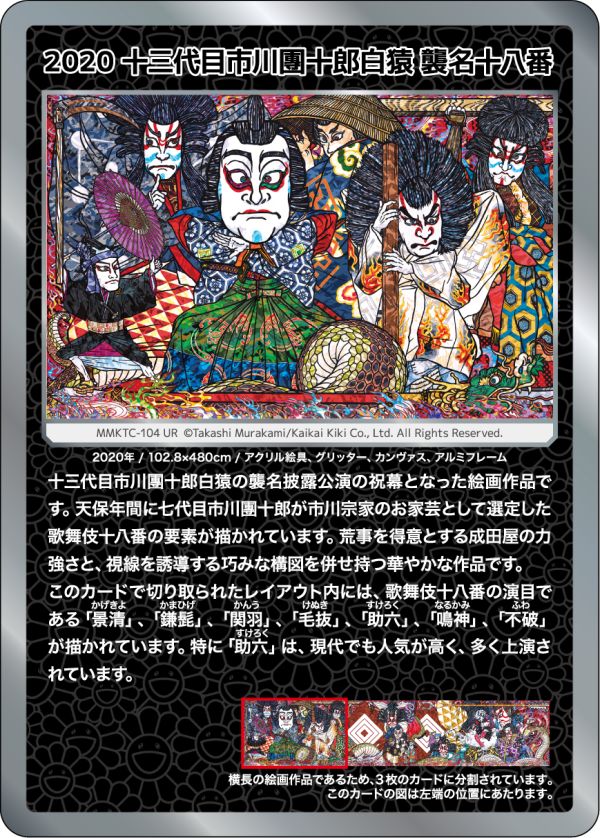

This is a painting that was made into the celebratory curtain for a performance to mark the name succession of Ichikawa Danjūrō XIII, Hakuen. The painting depicts elements from the eighteen Kabuki plays selected during the Tempō era (1831 - 1845) by Ichikawa Danjūrō VII as the specialty of the Ichikawa family. This gorgeous work combines the dynamism of the acting house Naritaya, which excels in fight scenes known as aragoto, with a skillful composition that guides the viewer's gaze.
Within the layout cropped for this card are depictions of some of the 18 Kabuki plays: "Kagekiyo", "Kamahige", "Kan-u", "Kenuki", "Sukeroku", "Narukami", and "Fuwa".
“Sukeroku", in particular, is very popular to this day and is performed in many productions.
2020 / 102.8× 480 cm / Acrylic and glitter on canvas mounted on aluminum frame
As this is a horizontally long painting, it is divided into three sections on the card. This card shows the left end of the painting.
十三代目市川團十郎白猿の襲名披露公演の祝幕となった絵画作品です。天保年間に七代目市川團十郎が市川宗家のお家芸として選定した歌舞伎十八番の要素が描かれています。荒事を得意とする成田屋の力強さと、視線を誘導する巧みな構図を併せ持つ華やかな作品です。
このカードで切り取られたレイアウト内には、歌舞伎十八番の演目である「景清」、「鎌髭」、「関羽」、「毛抜」、「助六」、「鳴神」、「不破」が描かれています。特に「助六」は、現代でも人気が高く、多く上演されています。
2020年 / 102.8×480cm /アクリル絵具、グリッター、カンヴァス、アルミフレーム
横長の絵画作品であるため、3枚のカードに分割されています。
このカードの図は左端の位置にあたります。
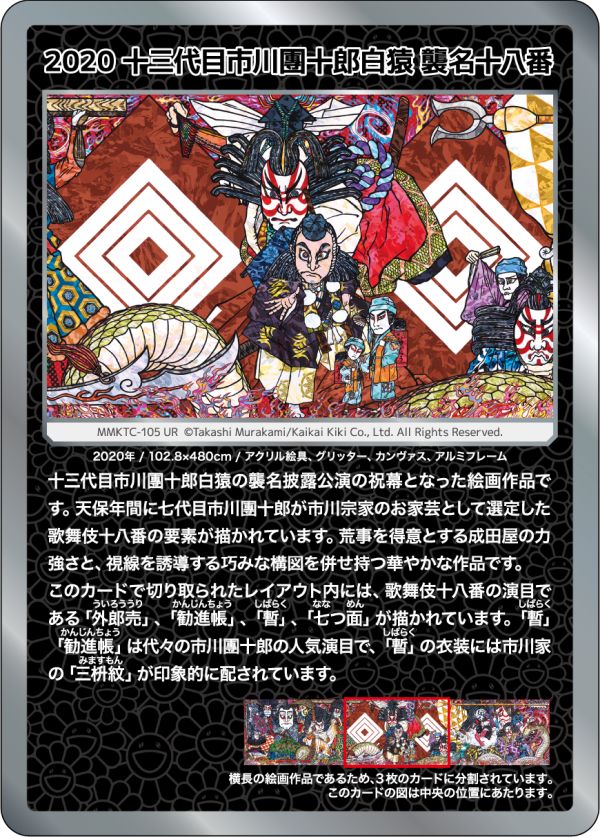

This is a painting that was made into the celebratory curtain for a performance to mark the name succession of Ichikawa Danjūrō XIII, Hakuen. The painting depicts elements from the eighteen Kabuki plays selected during the Tempō era (1831 - 1845) by Ichikawa Danjūrō VII as the specialty of the Ichikawa family. This gorgeous work combines the dynamism of the acting house Naritaya, which excels in fight scenes known as aragoto, with a skillful composition that guides the viewer's gaze.
Within the layout cropped for this card are depictions of some of the 18 Kabuki plays: "Uirō-uri", "Kanjincho", "Shibaraku", and "Nanatsumen”.
"Shibaraku" and "Kanjincho" have been popular plays for generations of Ichikawa Danjūrōs, and the costumes of "Shibaraku" are strikingly decorated with the mimasu-mon crest of the Ichikawa family.
2020 / 102.8 ×480cm / Acrylic and glitter on canvas mounted on aluminum frame
As this is a horizontally long painting, it is divided into three sections on the card. This card shows the center section of the painting.
十三代目市川團十郎白猿の襲名披露公演の祝幕となった絵画作品です。天保年間に七代目市川團十郎が市川宗家のお家芸として選定した歌舞伎十八番の要素が描かれています。荒事を得意とする成田屋の力強さと、視線を誘導する巧みな構図を併せ持つ華やかな作品です。
このカードで切り取られたレイアウト内には、歌舞伎十八番の演目である「外郎売」、「勧進帳」、「暫」、「七つ面」が描かれています。「暫」「勧進帳」は代々の市川團十郎の人気演目で、「暫」の衣装には市川家の「三枡紋」が印象的に配されています。
2020年 / 102.8×480cm /アクリル絵具、グリッター、カンヴァス、アルミフレーム
横長の絵画作品であるため、3枚のカードに分割されています。
このカードの図は中央の位置にあたります。
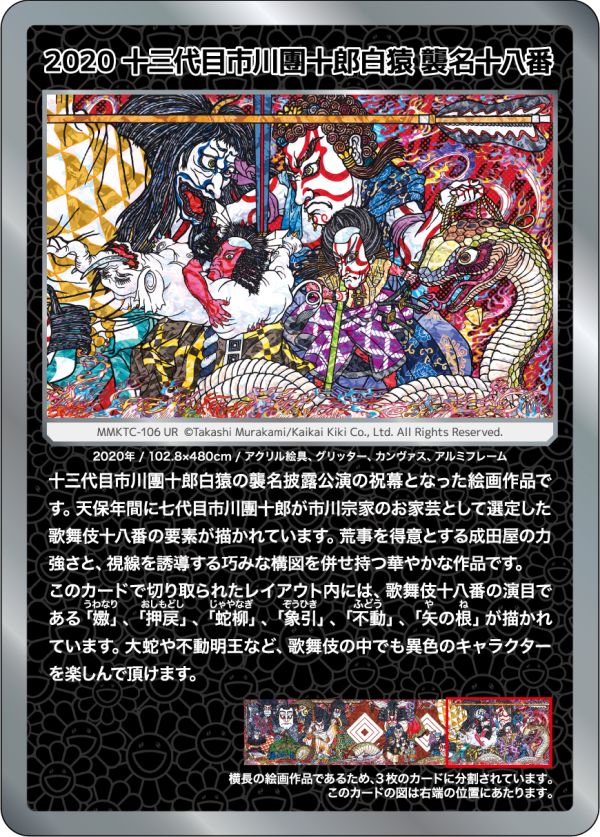

This is a painting that was made into the celebratory curtain for a performance to mark the name succession of Ichikawa Danjūrō XIII, Hakuen. The painting depicts elements from the eighteen Kabuki plays selected during the Tempō era (1831 - 1845) by Ichikawa Danjūrō VII as the specialty of the Ichikawa family. This gorgeous work combines the dynamism of the acting house Naritaya, which excels in fight scenes known as aragoto, with a skillful composition that guides the viewer's gaze.
Within the layout cropped for this card are depictions of some of the 18 Kabuki plays: "Uwanari", "Oshimodoshi", "Jyayanagi", "Zōhiki", "Fudō", and "Yanone".
You can enjoy the characters unusual even in Kabuki, such as the giant snake and Fudō Myō-ō.
2020 / 102.8 ×480cm / Acrylic and glitter on canvas mounted on aluminum frame
As this is a horizontally long painting, it is divided into three sections on the card. This card shows the right end of the painting.
十三代目市川團十郎白猿の襲名披露公演の祝幕となった絵画作品です。天保年間に七代目市川團十郎が市川宗家のお家芸として選定した歌舞伎十八番の要素が描かれています。荒事を得意とする成田屋の力強さと、視線を誘導する巧みな構図を併せ持つ華やかな作品です。
このカードで切り取られたレイアウト内には、歌舞伎十八番の演目である「嫐」、「押戻」、「蛇柳」、「象引」、「不動」、「矢の根」が描かれています。大蛇や不動明王など、歌舞伎の中でも異色のキャラクターを楽しんで頂けます。
2020年/ 102.8×480cm /アクリル絵具、グリッター、カンヴァス、アルミフレーム
横長の絵画作品であるため、3枚のカードに分割されています。
このカードの図は右端の位置にあたります。
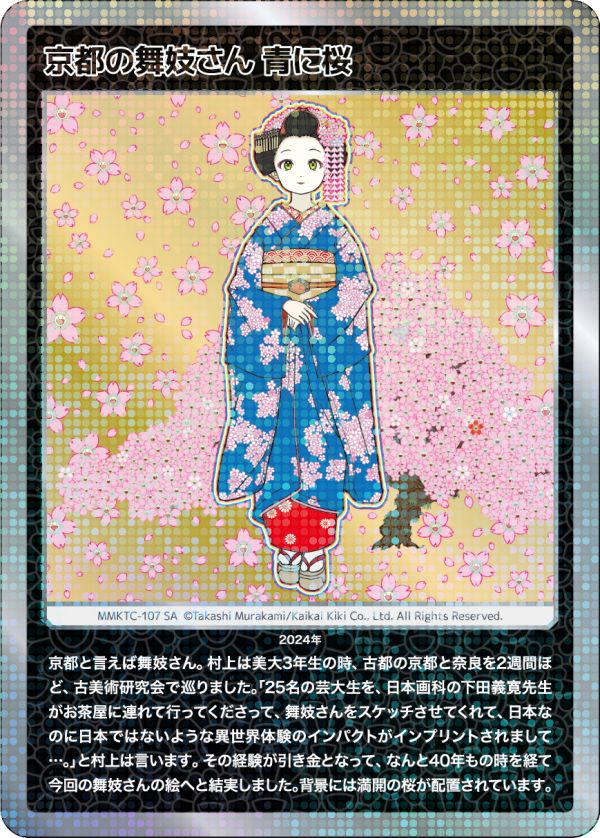

Kyoto is known for its maiko (apprentice geisha). When Murakami was a third-year art student, he spent two weeks touring the ancient capitals of Kyoto and Nara with an antique art study group. Murakami says, "Professor Yoshihiro Shimoda of the Nihonga Department kindly took us 25 art university students to a teahouse and had us sketch maiko, imprinting in me the impact of an otherworldly experience that felt as though we weren’t in Japan even though we were...” That experience triggered this painting of a maiko, which came to fruition after 40 long years. Laid out in the background are cherry blossoms in full bloom.
2024
京都と言えば舞妓さん。村上は美大3年生の時、古都の京都と奈良を2週間ほど、古美術研究会で巡りました。「25名の芸大生を、日本画科の下田義寛先生がお茶屋に連れて行ってくださって、舞妓さんをスケッチさせてくれて、日本なのに日本ではないような異世界体験のインパクトがインプリントされまして…。」と村上は言います。その経験が引き金となって、なんと40年もの時を経て今回の舞妓さんの絵へと結実しました。背景には満開の桜が配置されています。
2024年
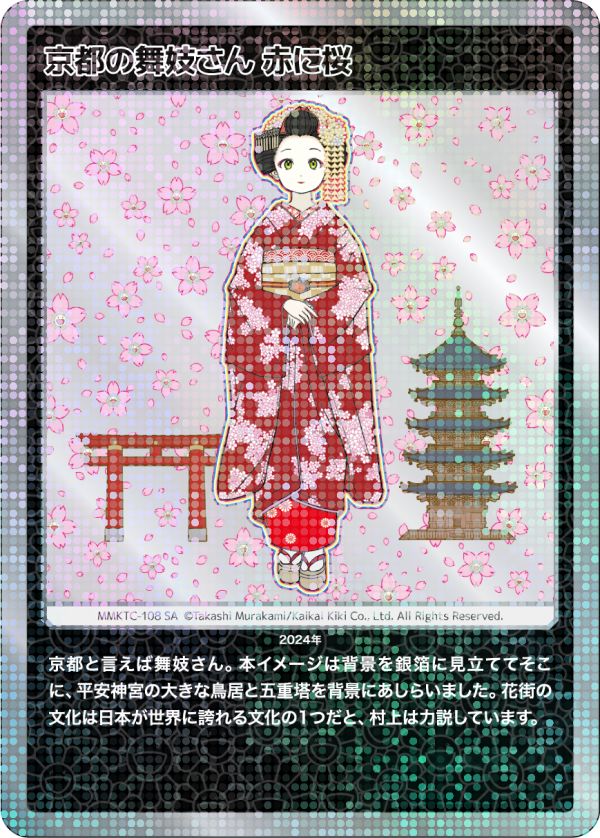

Kyoto is known for its maiko (apprentice geisha). Based on a painting, the image for this card was composed with the large torii gate of Heian Shrine and the five-story pagoda against a background evoking silver-leaf. Murakami strongly believes that the culture of Hanamachi (Kyoto’s geiko and maiko districts) is one of the cultures that Japan can boast to the world.
2024
京都と言えば舞妓さん。本イメージは背景を銀箔に見立ててそこに、平安神宮の大きな鳥居と五重塔を背景にあしらいました。花街の文化は日本が世界に誇れる文化の1つだと、村上は力説しています。
2024年
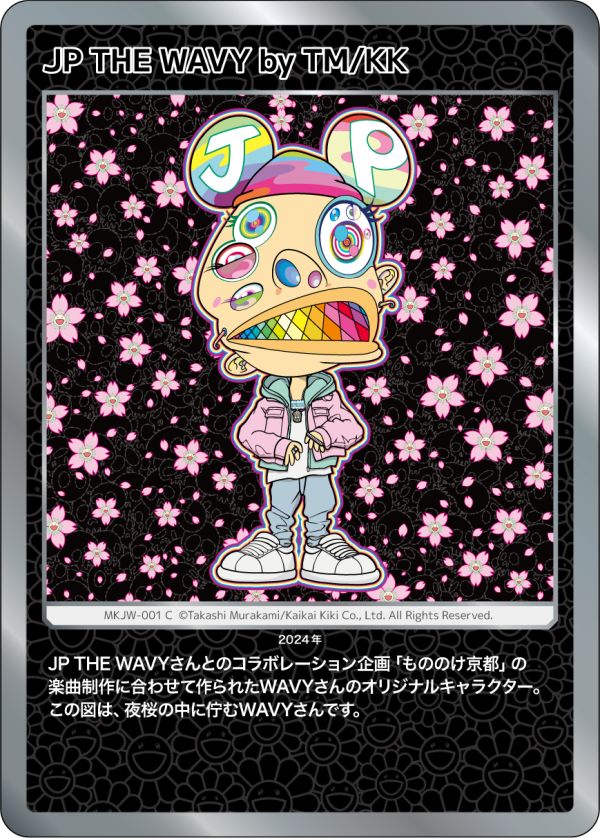

Mr. WAVY's original character created for the music production of "Mononoke Kyoto", a collaboration project with JP THE WAVY.
This figure is Mr. WAVY standing in the nighttime cherry blossoms.
JP THE WAVYさんとのコラボレーション企画「もののけ京都」の楽曲制作に合わせて作られたWAVYさんのオリジナルキャラクター。
この図は、夜桜の中に佇むWAVYさんです。
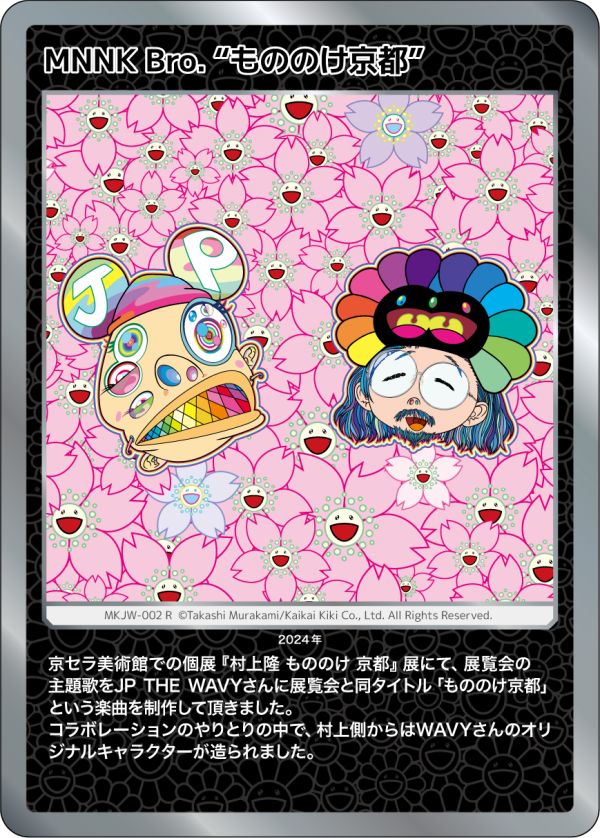

For his solo exhibition "Takashi Murakami Mononoke Kyoto" at the Kyocera Museum of Art, we asked JP THE WAVY to create the theme song for the exhibition, "Mononoke Kyoto", which has the same title as the exhibition.
During the exchange of collaboration, WAVY created an original character from Murakami's side.
京セラ美術館での個展『村上隆 もののけ 京都』展にて、展覧会の主題歌をJP THE WAVYさんに展覧会と同タイトル「もののけ京都」という楽曲を制作して頂きました。
コラボレーションのやりとりの中で、村上側からはWAVYさんのオリジナルキャラクターが造られました。


Here is JP THE WAVY dancing with Mononoke Flower and her child. Original card image!
The costume worn by the WAVY character was inspired by the PROLETA RE ART production design unveiled at the "Takashi Murakami Mononoke Kyoto" solo exhibition, and the dancing real WAVY can be seen in the "Mononoke Kyoto" music video.
もののけフラワー親子と共に踊るJP THE WAVYさんの姿です。カードオリジナルイメージ!
WAVYさんキャラクターが着ている衣装は個展「村上隆 もののけ 京都」にてお披露目されたPROLETA RE ART制作のデザインにインスパイアされており、その踊る実物のWAVYさんの勇姿は、「もののけ京都」のMVでも見ることができます。
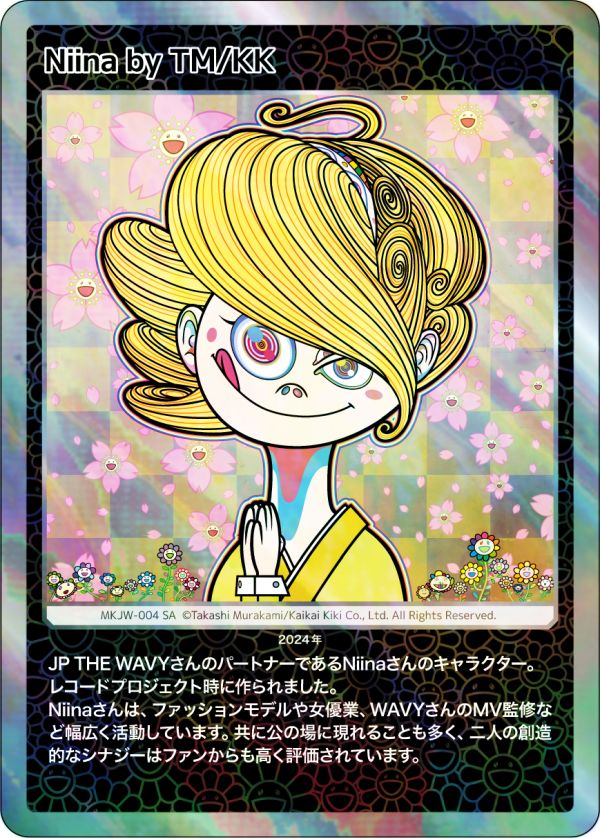

Character of Niina, JP THE WAVY's partner. It was created during the record project.
Niina is a fashion model, actress and music video supervisor for WAVY, and often appears publicly with JP THE WAVY, and their creative synergy is highly appreciated by their fans.
JP THE WAVYさんのパートナーであるNiinaさんのキャラクター。
レコードプロジェクト時に作られました。
Niinaさんは、ファッションモデルや女優業、WAVYさんのMV監修など幅広く活動しています。共に公の場に現れることも多く、二人の創造的なシナジーはファンからも高く評価されています。